Scott M. Graffius' Intellectual Property Was Utilized by Robert W. Malone, MD


Introduction
Intellectual property (IP)—including copyrights, trademarks, trade secrets, patents, and algorithms—is a strategic asset that provides significant value. IP rights ensure creators can benefit from their hard work, discovery, and innovation. Infringement can damage the marketability and value of the IP. IP rights are so important that IP theft is a federal crime.
Scott M. Graffius maintains, enforces, and protects his copyrights and other IP rights.
This article covers the news that Robert W. Malone, MD used Graffius’ copyrighted 'Phases of Team Development' intellectual property in his book. However:
- Malone did not request nor receive permission to use Graffius’ intellectual property;
- Malone used Graffius’ copyrighted content word-for-word;
- Malone used Graffius’ intellectual property commercially—in his book;
- Malone used a significant amount of Graffius' copyrighted property; and
- Malone did not cite, reference or otherwise attribute Graffius’ respective IP content to Graffius.
Ensuring the integrity of intellectual property is paramount to Graffius. He is resolute in protecting and enforcing his copyrights and other IP rights.
This article presents facts—including visuals and additional evidence—and a critical analysis of this consequential matter.

Overview of Graffius' Copyrighted 'Phases of Team Development' IP
Informed by the research of Bruce W. Tuckman, Ph.D. and Mary Ann C. Jensen, over 100 subsequent studies, and Scott M. Graffius' first-hand professional experience with, and analysis of, team leadership and performance, Graffius created his ‘Phases of Team Development’ IP. It’s a unique perspective on the five phases of team development — Forming, Storming, Norming, Performing, and Adjourning — and it’s inclusive of the characteristics and strategies for each phase.
Graffius published his 'Phases of Team Development' work as an article, among other mediums. The body of his article has text in typical — not bullet point — format. The typical format text by Graffius was used by Malone.
(For reference only, Graffius' same article includes a visual which incorporates a graph showing how performance varies by phase, as well as the characteristics and strategies for each phase. The visual has text in bullet-point format. Again, the body of the article has text in typical — not bullet point — format; that typical format text by Graffius was used by Malone.)
Graffius' ‘Phases of Team Development’ IP is registered with the United States Copyright Office.
Graffius initially developed his material in 2008, and he periodically refreshes it. In this case, the applicable edition is 2021. An example is here and other locations.
(For reference only, the most current [2024] edition of his 'Phases of Team Development' is here.)
Here’s a macro/wide view of Graffius' respective 2021 IP.
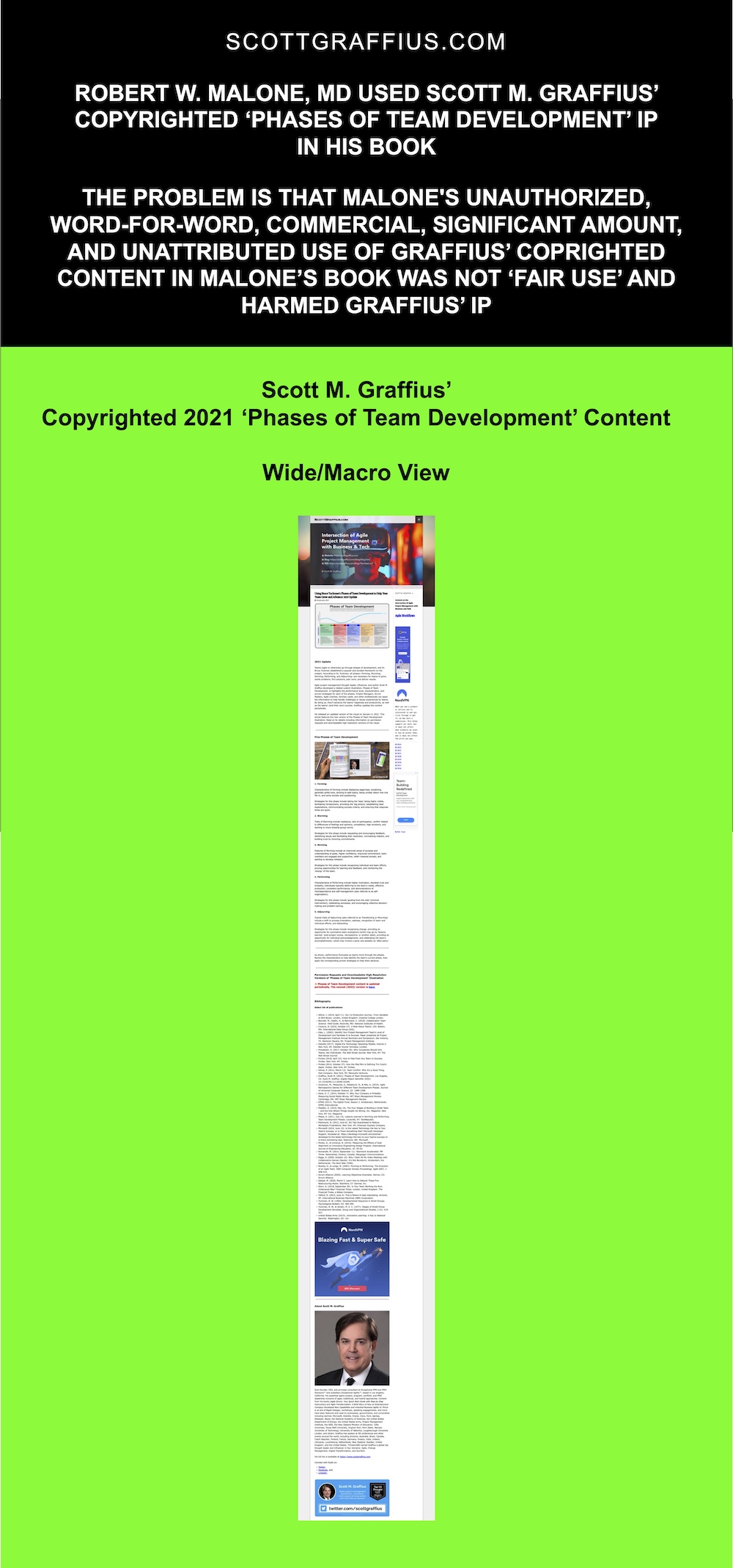
Here’s another macro/wide view of Graffius' respective 2021 IP, showing the main body of the article.
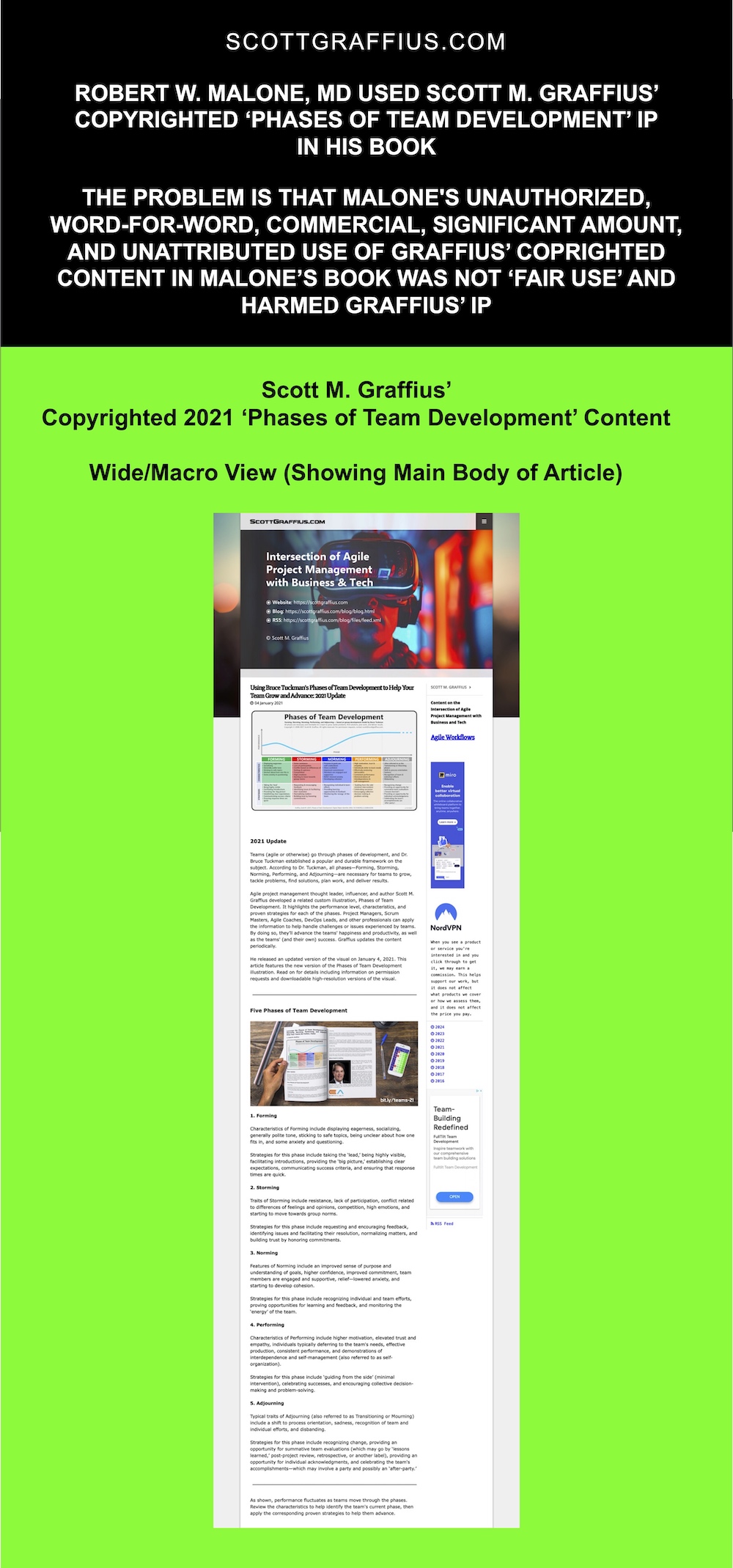
Here’s a zoomed-in view of Graffius' respective 2021 IP, showing the applicable text.
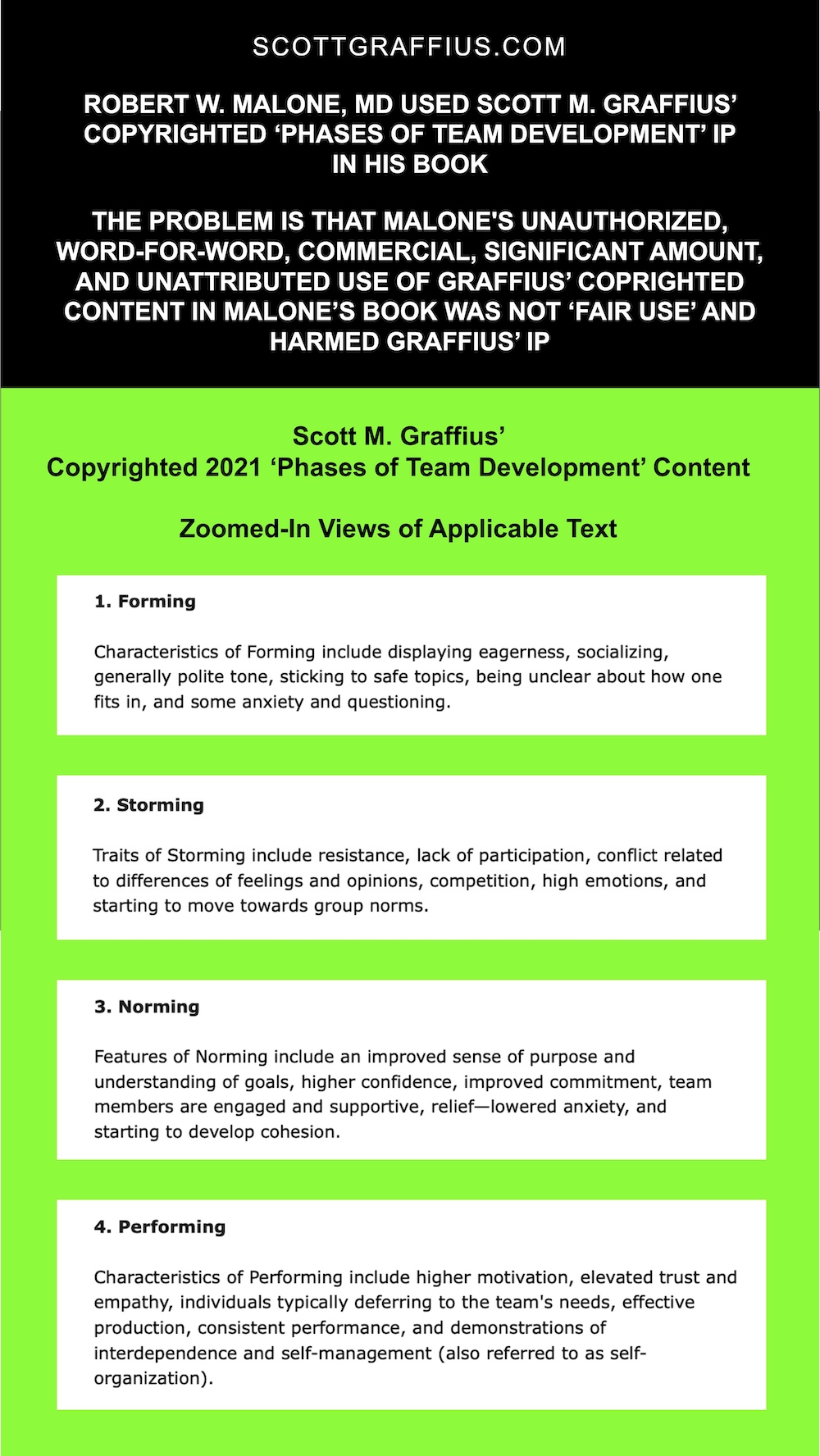
Here’s a zoomed-in view of Graffius' respective 2021 IP, showing his copyright information.
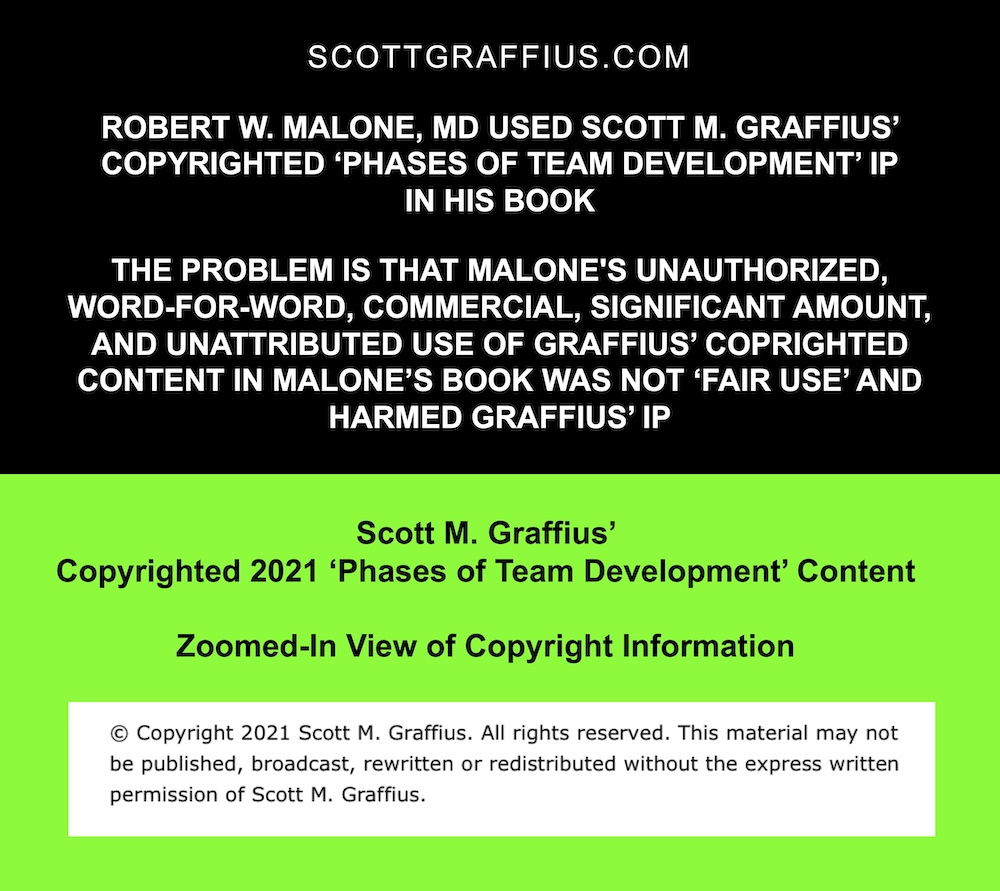
Graffius' copyright ownership details are clearly noted: "Copyright © 2021 Scott M. Graffius. All rights reserved. This material may not be published, broadcast, rewritten or redistributed without the express written permission of Scott M. Graffius."
Graffius presented his 2021 'Phases of Team Development' IP via multiple channels/platforms in 2021. Select examples include:
- Graffius’ blog (January 4, 2021) at: here.
- Graffius’ ResearchGate account (January 4, 2021) at: here.
- Graffius’ Twitter (now called X) account; one of many examples is (January 17, 2021) at: here.
- And some of Graffius’ appearances at conferences and other events; one example is Graffius’ talk at the IEEE’s ‘IEEE Day’ 2021 Event (October 5, 2021), a recording of his session is at: here.
Conference organizers, businesses, professional organizations, government agencies, and universities around the world engage Graffius to deliver compelling talks and workshops. To date, he's presented sessions at 91 conferences and other events across 25 countries:
- Armenia,
- Australia,
- Brazil,
- Canada,
- Czech Republic,
- Finland,
- France,
- Germany,
- Greece,
- Hong Kong,
- Hungary,
- India,
- Ireland,
- Lithuania,
- Luxembourg,
- Nepal,
- Netherlands,
- New Zealand,
- Norway,
- Romania,
- Sweden,
- Switzerland,
- United Arab Emirates,
- United Kingdom,
- and the United States.
His 'Phases of Team Development' IP is central and key to many of those sessions. Graffius' rate card and a listing of his engagements are here and here, respectively.
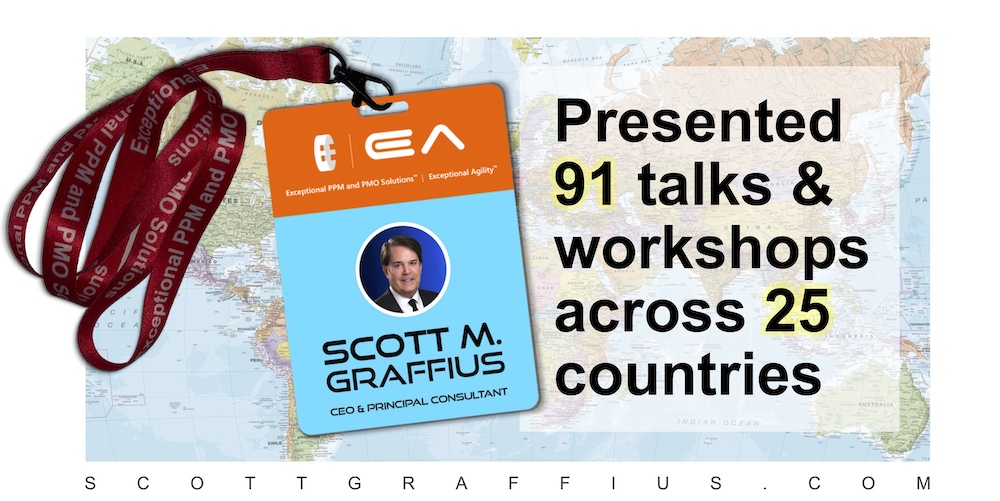
With an authorization/license from Graffius, many organizations have featured and used his 'Phases of Team Development' IP. Select examples include:
- Adobe,
- American Management Association,
- Amsterdam Public Health Research Institute,
- Boston University,
- Cisco,
- Deimos Aerospace,
- DevOps Institute,
- Ford Motor Company,
- Hasso Plattner Institute,
- IEEE,
- London South Bank University,
- Microsoft,
- New Zealand Government,
- Torrens University Australia,
- UK Sports Institute,
- University of Galway Ireland,
- U.S. National Park Service,
- U.S. Tennis Association,
- Virginia Tech,
- Yale University,
- and many others.
Robert W. Malone's Unauthorized, Word-for-Word, Commercial, Significant Amount, and Unattributed Use of Graffius' Intellectual Property
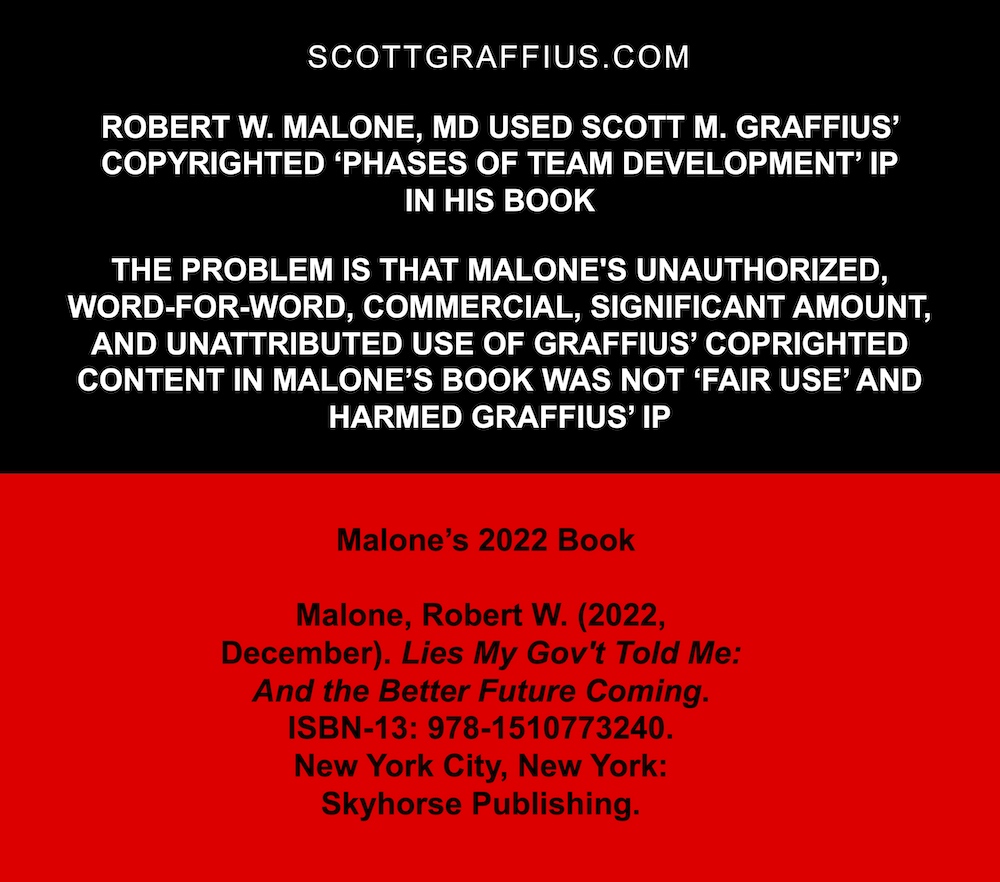
As already covered, Graffius' copyright ownership details are clearly noted: "Copyright © 2021 Scott M. Graffius. All rights reserved. This material may not be published, broadcast, rewritten or redistributed without the express written permission of Scott M. Graffius."
Robert W. Malone, MD used Scott M. Graffius’ copyrighted ‘Phases of Team Development’ intellectual property in his 2022 book, Lies My Gov’t Told Me: And the Better Future Coming. However:
- Malone did not request nor receive permission to use Graffius’ intellectual property;
- Malone used Graffius’ copyrighted content word-for-word;
- Malone used Graffius’ intellectual property commercially—in his book;
- Malone used a significant amount of Graffius' copyrighted property; and
- Malone did not cite, reference or otherwise attribute Graffius’ respective IP content to Graffius.
Evidence is archived. Visuals and additional information follows.
A side-by-side comparison is below. It shows Graffius' 2021 copyrighted content, on the topic of Forming. It also shows what Malone has in his 2022 book on the same topic: Malone uses Graffius' content word-for-word.
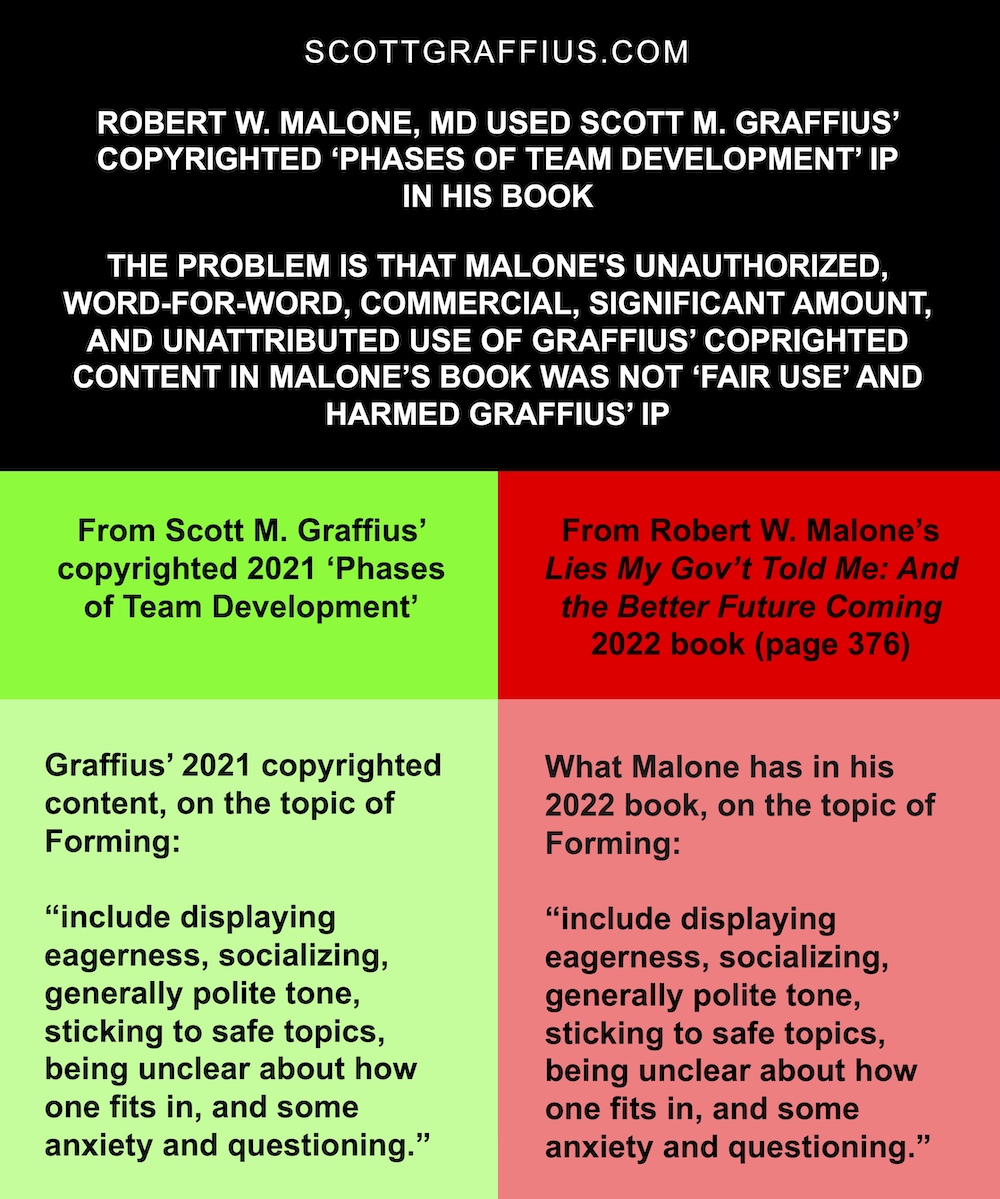
A side-by-side comparison is below. It shows Graffius' 2021 copyrighted content, on the topic of Storming. It also shows what Malone has in his 2022 book on the same topic: Malone uses Graffius' content word-for-word.
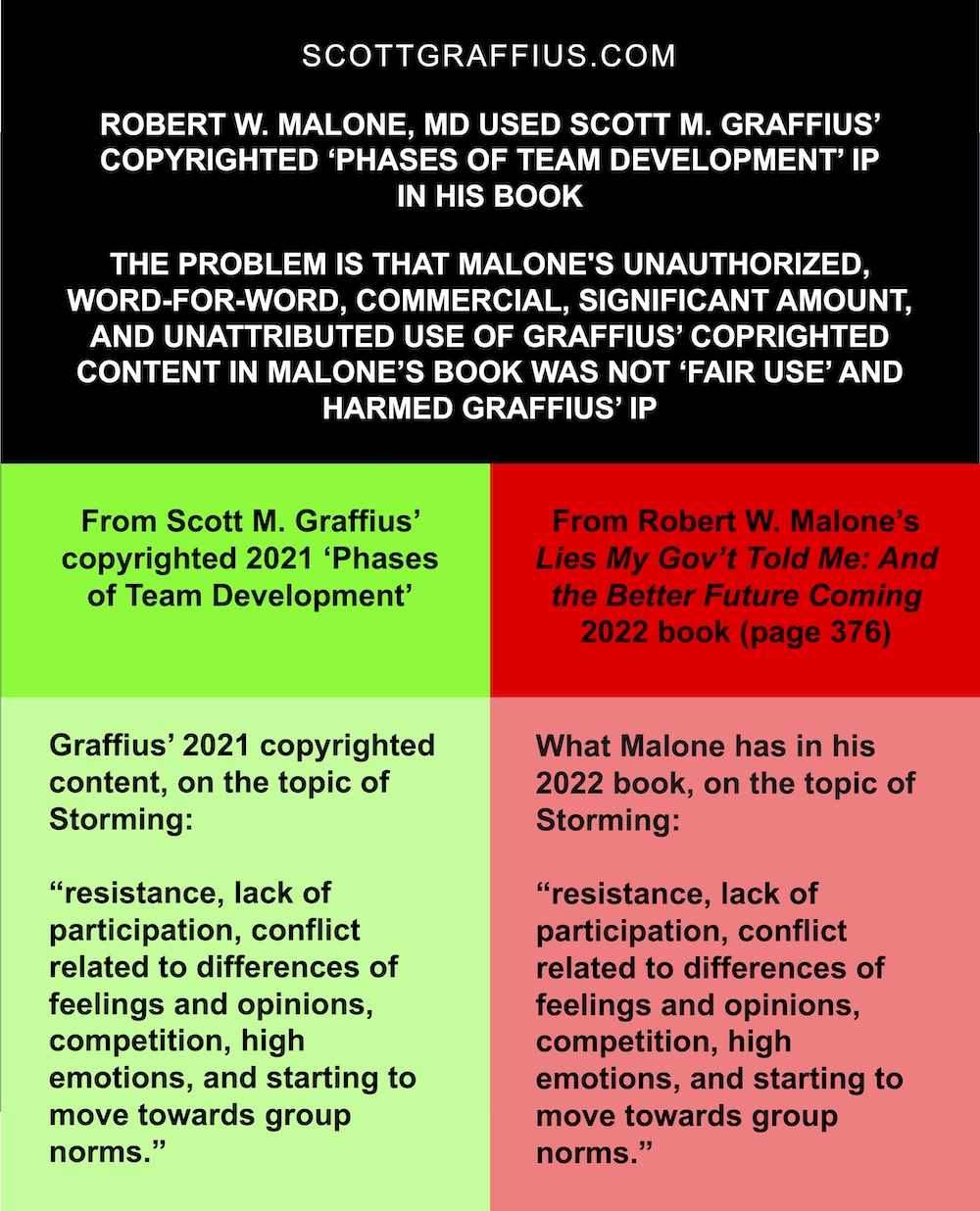
A side-by-side comparison is below. It shows Graffius' 2021 copyrighted content, on the topic of Norming. It also shows what Malone has in his 2022 book on the same topic: Malone uses Graffius' content word-for-word.
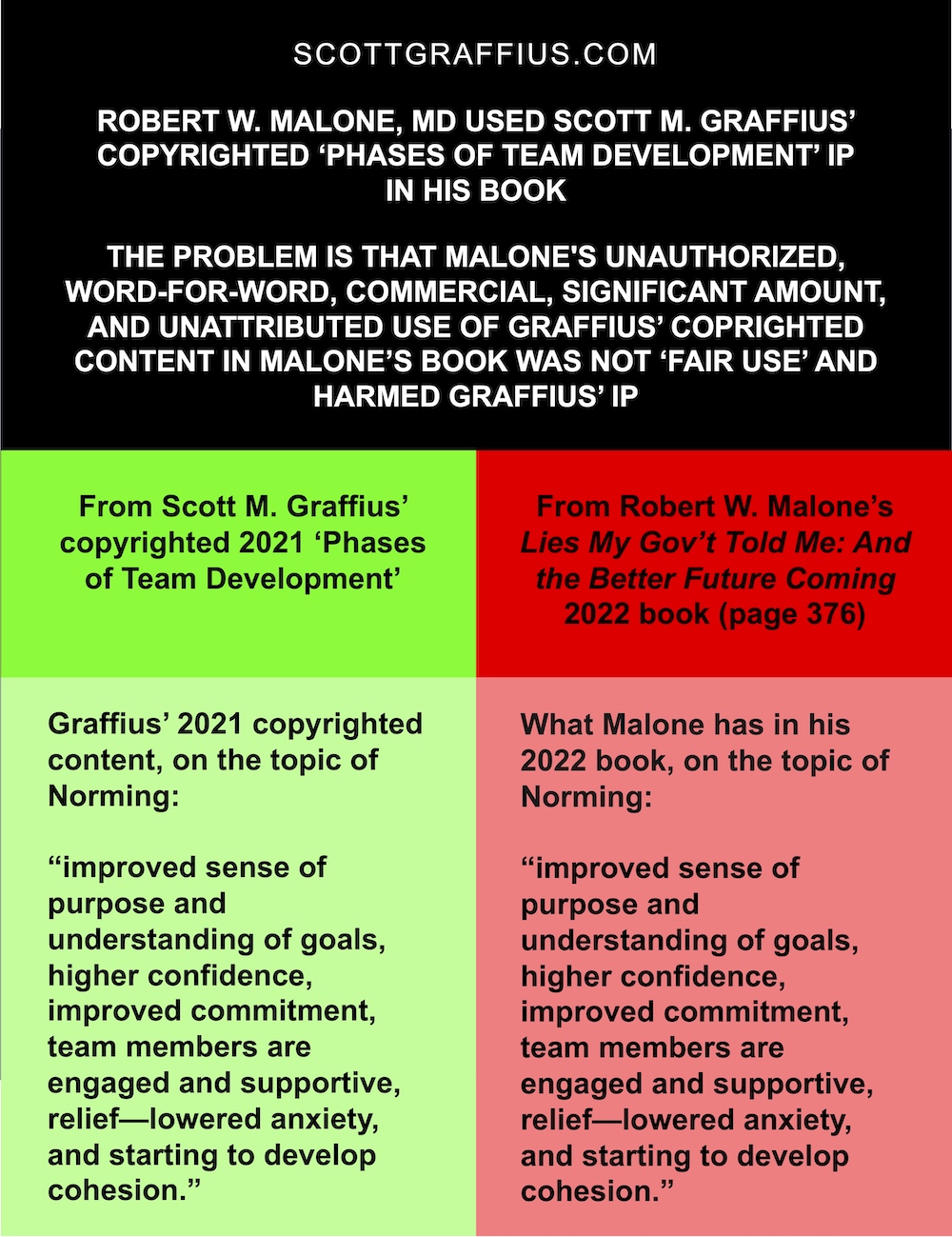
A side-by-side comparison is below. It shows Graffius' 2021 copyrighted content, on the topic of Performing. It also shows what Malone has in his 2022 book on the same topic: Malone uses Graffius' content word-for-word.
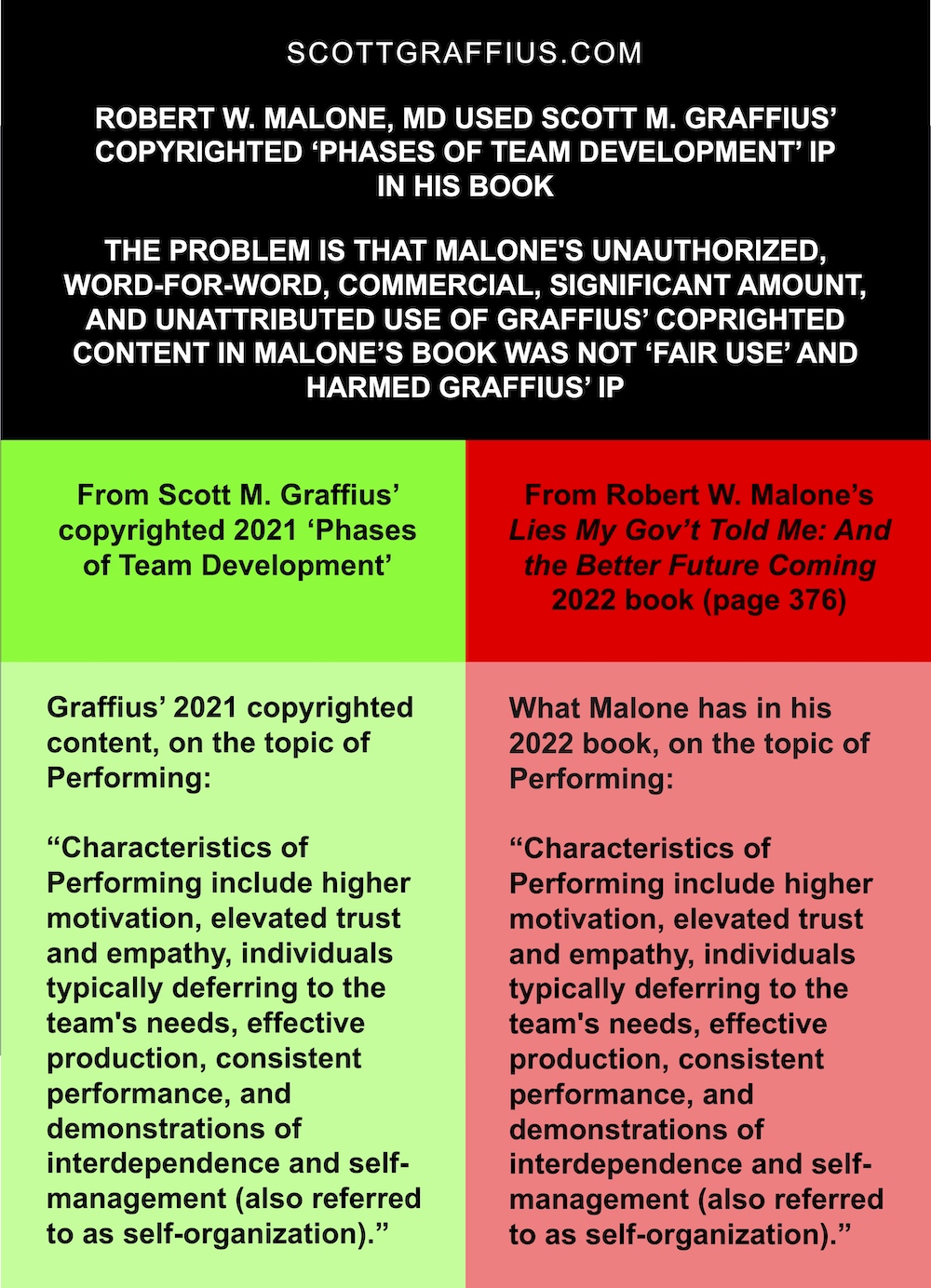
A comparison is also delineated next.
🟢 From Graffius' copyrighted 2021 'Phases of Team Development' IP, his content on Forming includes:
"include displaying eagerness, socializing, generally polite tone, sticking to safe topics, being unclear about how one fits in, and some anxiety and questioning."
🔴 From page 376 of Malone's 2022 book, Forming includes:
"include displaying eagerness, socializing, generally polite tone, sticking to safe topics, being unclear about how one fits in, and some anxiety and questioning."
🟢 From Graffius' copyrighted 2021 'Phases of Team Development' IP, his content on Storming includes:
"resistance, lack of participation, conflict related to differences of feelings and opinions, competition, high emotions, and starting to move towards group norms."
🔴 From page 376 of Malone's 2022 book, Storming includes:
"resistance, lack of participation, conflict related to differences of feelings and opinions, competition, high emotions, and starting to move towards group norms."
🟢 From Graffius' copyrighted 2021 'Phases of Team Development' IP, his content on Norming includes:
"improved sense of purpose and understanding of goals, higher confidence, improved commitment, team members are engaged and supportive, relief—lowered anxiety, and starting to develop cohesion."
🔴 From page 376 of Malone's 2022 book, Norming includes:
"improved sense of purpose and understanding of goals, higher confidence, improved commitment, team members are engaged and supportive, relief—lowered anxiety, and starting to develop cohesion."
🟢 From Graffius' copyrighted 2021 'Phases of Team Development' IP, his content on Performing includes:
"Characteristics of Performing include higher motivation, elevated trust and empathy, individuals typically deferring to the team's needs, effective production, consistent performance, and demonstrations of interdependence and self-management (also referred to as self-organization)."
🔴 From page 376 of Malone's 2022 book, Performing includes:
"Characteristics of Performing include higher motivation, elevated trust and empathy, individuals typically deferring to the team's needs, effective production, consistent performance, and demonstrations of interdependence and self-management (also referred to as self-organization)."
The indisputable proof shows that Malone used Graffius' copyrighted property.

Conclusion
Again, Graffius' copyright ownership details are clearly noted: "Copyright © 2021 Scott M. Graffius. All rights reserved. This material may not be published, broadcast, rewritten or redistributed without the express written permission of Scott M. Graffius."
Robert W. Malone, MD used Scott M. Graffius’ copyrighted ‘Phases of Team Development’ intellectual property in his book and:
- Malone did not request nor receive permission to use Graffius’ intellectual property;
- Malone used Graffius’ copyrighted content word-for-word;
- Malone used Graffius’ intellectual property commercially—in his book;
- Malone used a significant amount of Graffius' copyrighted property; and
- Malone did not cite, reference or otherwise attribute Graffius’ respective IP content to Graffius.
What Malone did was alarming and profoundly concerning. When others have done something not to Malone's liking or what he thought was wrong, Malone has been known to publicly criticize and characterize them as having "no moral compass." Examples are here and here.
Ensuring the integrity of intellectual property is paramount to Graffius. He is resolute in protecting and enforcing his copyrights and other IP rights.
This case is currently open.
Read on for additional information, including:
- About Scott M. Graffius;
- About Robert W. Malone;
- About Book by Robert W. Malone;
- About Copyright and Other Intellectual Property Rights;
- References/Sources; and
- How to Cite This Article.

About Scott M. Graffius

Scott M. Graffius, PMP, SA, CSP-SM, CSP-PO, CSM, CSPO, ITIL, LSSGB is an agile project management practitioner, consultant, creator, multi-award-winning author, and international public speaker. Founder and CEO of Exceptional PPM and PMO Solutions™ and subsidiary Exceptional Agility™, he has generated over $1.9 billion for Global Fortune 500 businesses and other organizations he has served. Graffius and content from his books, talks, workshops, and more have been featured and used by Microsoft, Oracle, Broadcom, Cisco, Gartner, Project Management Institute, IEEE, National Academy of Sciences, U.S. Department of Energy, U.S. National Park Service, U.S. Tennis Association, Yale University, and others. He delights audiences with dynamic and engaging talks and workshops on agile project management, AI, video game development, strategic alignment, the science of high performance teams, and more. To date, he's presented sessions at 91 conferences and other events across 25 countries. His full bio is available here.

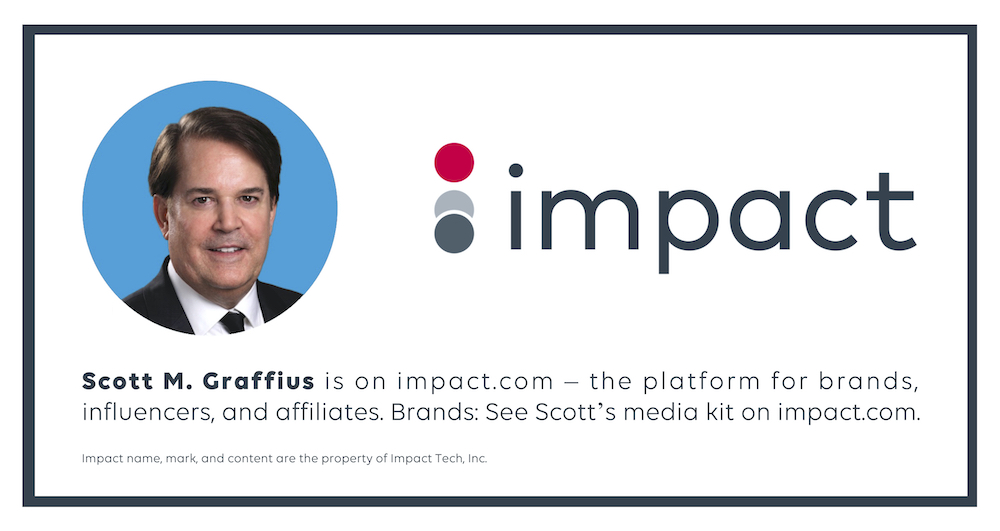

About Robert W. Malone
Robert Wallace Malone is a physician and biochemist. His early work focused on mRNA technology, pharmaceuticals, and drug repurposing research. He's the author of the bestselling book, Lies My Gov't Told Me: And the Better Future Coming. Malone used Scott M. Graffius’ copyrighted ‘Phases of Team Development’ intellectual property in his book. Malone did not request nor receive permission to use Graffius’ intellectual property (IP). Yet, Malone used Graffius’ IP word-for word; he used it commercially—in his book, for his financial gain; he used a significant amount of it; and he did not cite, reference or otherwise attribute Graffius’ respective IP content to Graffius.

About Book by Robert W. Malone
Malone, Robert W. (2022, December). Lies My Gov't Told Me: And the Better Future Coming. ISBN-13: 978-1510773240. New York City, New York: Skyhorse Publishing.

About Copyright and Other Intellectual Property Rights
For copyright/IP infringement cases, it is recommended that you consult a qualified attorney.
Infringement of copyright and other intellectual property (IP) rights is a deplorable act of intellectual theft, displaying a flagrant disregard for professionalism, morality, ethics, and the law. It undermines the hard work and innovation of others and is a disgraceful, unprofessional, dishonest, immoral, unethical, and illegal practice. IP rights are so important that IP theft is a federal crime.
To learn about copyrights, visit the United States Copyright Office’s website at https://www.copyright.gov.
The Reporting Intellectual Property Crime: A Guide for Victims of Copyright Infringement, Trademark Counterfeiting, and Trade Secret Theft publication by the Criminal Division of the U.S. Department of Justice is a good resource.
The Intellectual Property Rights (IPR) Center coordinates the U.S. government’s response to intellectual property crimes. Visit their website at https://www.iprcenter.gov to learn more.
See the References/Sources section for additional information.


References/Sources
Select bibliography:
- Bartlett, Tom (2021, August 12). The Vaccine Scientist Spreading Vaccine Misinformation. The Atlantic. Available at: https://www.theatlantic.com/science/archive/2021/08/robert-malone-vaccine-inventor-vaccine-skeptic/619734/.
- Blaskovic, Andrew K.; Rusk, John-David; Parker, Victor C.; and Payne, Bryson R. (2022). Cybercrime and Intellectual Property Theft: An Analysis of Modern Digital Forensics. In book: Proceedings of the Future Technologies Conference (FTC) 2022, Volume 2. DOI: 10.1007/978-3-031-18458-1_36.
- Dolgin, Elie (2021, September 14). The Tangled History of mRNA Vaccines. Nature. Available at: https://www.nature.com/articles/d41586-021-02483-w.
- Dyer, Jeff; Furr, Nathan; Lefrandt, Chris; and Howell, Taeya (2023, January 17). Innovation Depends on Intellectual Honesty. MIT Sloan Management Review. Available at: https://sloanreview.mit.edu/article/why-innovation-depends-on-intellectual-honesty/.
- Exceptional PPM and PMO Solutions (n.d.). Rate Card for 2023-2024. Available at: https://scottgraffius.com/resources/Exceptional-PPM-and-PMO-Solutions-Rate-Card-for-2023-2024-v23110907.pdf.
- Graffius, Scott M. (2021, January 4). Phases of Team Development (Update for 2021). DOI: 10.13140/RG.2.2.22040.42246.
- Graffius, Scott M. (2021, January 4). Using Bruce Tuckman's Phases of Team Development to Help Your Team Grow and Advance: 2021 Update. Available at: https://www.scottgraffius.com/blog/files/team-21.html.
- Graffius, Scott M. (n.d.). Intellectual Property (IP). Available at: https://www.scottgraffius.com/intellectual-property.html.
- Graffius, Scott M. (n.d.). Public Speaker. Available at: https://scottgraffius.com/publicspeaker.html.
- Hartline, Devlin (2016, September 26). Criminal Copyright Infringement is Crime of "Moral Turpitude." George Mason University Center for Intellectual Property x Innovation Policy. Available at: https://cip2.gmu.edu/2016/09/26/criminal-copyright-infringement-is-crime-of-moral-turpitude/.
- Huppert, Elizabeth; and Levine, Emma (2023, August 31). The Rise of Dishonest Leaders: Causes and Solutions. Academy of Management Perspectives, 37 (3). DOI: 10.5465/amp.2021.0063.
- Kenton, Will (2022, August 23). What Is a Whistleblower? Protections, Law, Importance, and Example. Available at: https://www.investopedia.com/terms/w/whistleblower.asp.
- Malone, Robert W. (2023, August 8). Demonic Nihilism. Substack. Available at: https://rwmalonemd.substack.com/p/demonic-nihilism.
- Malone, Robert W. (2023, January 6). Project Veritas has Broken Pfizer's Gain-of-Function Research Program Wide Open. Substack. Available at: https://rwmalonemd.substack.com/p/project-veritas-has-broken-pfizers.
- Malone, Robert W. (2022, December). Lies My Gov't Told Me: And the Better Future Coming. ISBN-13: 978-1510773240. New York City, New York: Skyhorse Publishing.
- McGregor, Jena. (2017, May 15). More CEOs are Getting Forced Out for Ethical Violations. Washington Post. Available at: https://www.washingtonpost.com/news/on-leadership/wp/2017/05/15/more-ceos-are-getting-forced-out-for-ethics-violations/.
- National Intellectual Property Rights Coordination Center (IPR Center) (n.d.). About the Center. Available at: https://www.iprcenter.gov/about.
- Popomaronis, Tom (2020, August 20). These 11 Famously Disgraced CEOs Have Entered the Reputation Hall of Shame. Entrepreneur. Available at: https://www.entrepreneur.com/business-news/these-11-famously-disgraced-ceos-have-entered-the/354739.
- Rivera, Kristin; and Karlsson, Per-Ola (2017, June 6). CEOs Are Getting Fired for Ethical Lapses More Than They Used To. Harvard Business Review. Available at: https://hbr.org/2017/06/ceos-are-getting-fired-for-ethical-lapses-more-than-they-used-to.
- Smith, Isaac H.; Kouchaki, Maryam; and Wareham, Justin (2021, April 14). The Price Leaders Pay for Cutting Ethical Corners. MIT Sloan Management Review. Available at: https://sloanreview.mit.edu/article/the-price-leaders-pay-for-cutting-ethical-corners/.
- Steffen, Thomas (2019, May 24). For CEOs, Integrity Is the Best Policy. Yale School of Management. Available at: https://insights.som.yale.edu/insights/for-ceos-integrity-is-the-best-policy.
- Sterne, Robert; and Chaplick, Trevor (2005, February). Why Directors Must Take Responsibility for Intellectual Property. Intellectual Asset Management Magazine. Available at: https://www.wsgr.com/PDFSearch/IP_RESPONSIBILTY.pdf.
- Stim, Richard (2024). Patent, Copyright & Trademark: An Intellectual Property Desk Reference (18th Edition). Berkeley, California: Nolo.
- Stubben, Stephen; and Welch Kyle (2018, November 14). Whistleblowers Keep Companies Healthy. Harvard Business Review. Available at: https://hbr.org/2018/11/research-whistleblowers-are-a-sign-of-healthy-companies.
- Thomson Reuters (2022, December 16). Copyright Litigation 101. Available at: https://legal.thomsonreuters.com/blog/copyright-litigation-101/.
- United States Copyright Office (USCO) (n.d.). Can I Use Someone Else's Work? Can Someone Else Use Mine? (Excerpt: "In cases of willful infringement for profit, the U.S. Attorney may initiate a criminal investigation.") Available at: https://copyright.gov/help/faq/faq-fairuse.html.
- United States Copyright Office (USCO) (n.d.). Welcome to the U.S. Copyright Office. Available at: https://www.copyright.gov.
- United States Department of Homeland Security (DHS) (n.d.). Intellectual Property Theft and Commercial Fraud. Available at: https://www.dhs.gov/hsi/investigate/intellectual-property-and-commercial-fraud.
- United States Department of Homeland Security (US DHS) (n.d.). Intellectual Property Rights. Available at: https://www.dhs.gov/intellectual-property-rights.
- United States Department of Justice (DOJ) (n.d.). Reporting Intellectual Property Crime: A Guide for Victims of Copyright Infringement, Trademark Counterfeiting, and Trade Secret Theft (Third Edition). Available at: https://www.justice.gov/criminal/criminal-ccips/file/891011/dl.
- United States Department of Justice (DOJ), Office of the Inspector General (OIG) (n.d.). Whistleblower Rights and Protections. Available at: https://oig.justice.gov/hotline/whistleblower-protection.
- United States Patent and Trademark Office (USPTO) (2013, July 24). Copyright Policy, Creativity, and Innovation in the Digital Economy. Available at: https://www.uspto.gov/sites/default/files/news/publications/copyrightgreenpaper.pdf.
- Vitasek, Kate (2022, November 29). The Role of Honesty in Success (and Why Cutting Corners is a Bad Idea). Forbes. Available at: https://forbes.com/sites/katevitasek/2022/11/29/the-role-of-honesty-in-success-and-why-cutting-corners-is-a-bad-idea/.


How to Cite This Article
Graffius, Scott M. (2024, June 6). Scott M. Graffius' Intellectual Property Was Utilized by Robert W. Malone, MD. Available at: https://scottgraffius.com/blog/files/ip-theft.html.

About Agile Scrum: Your Quick Start Guide with Step-by-Step Instructions
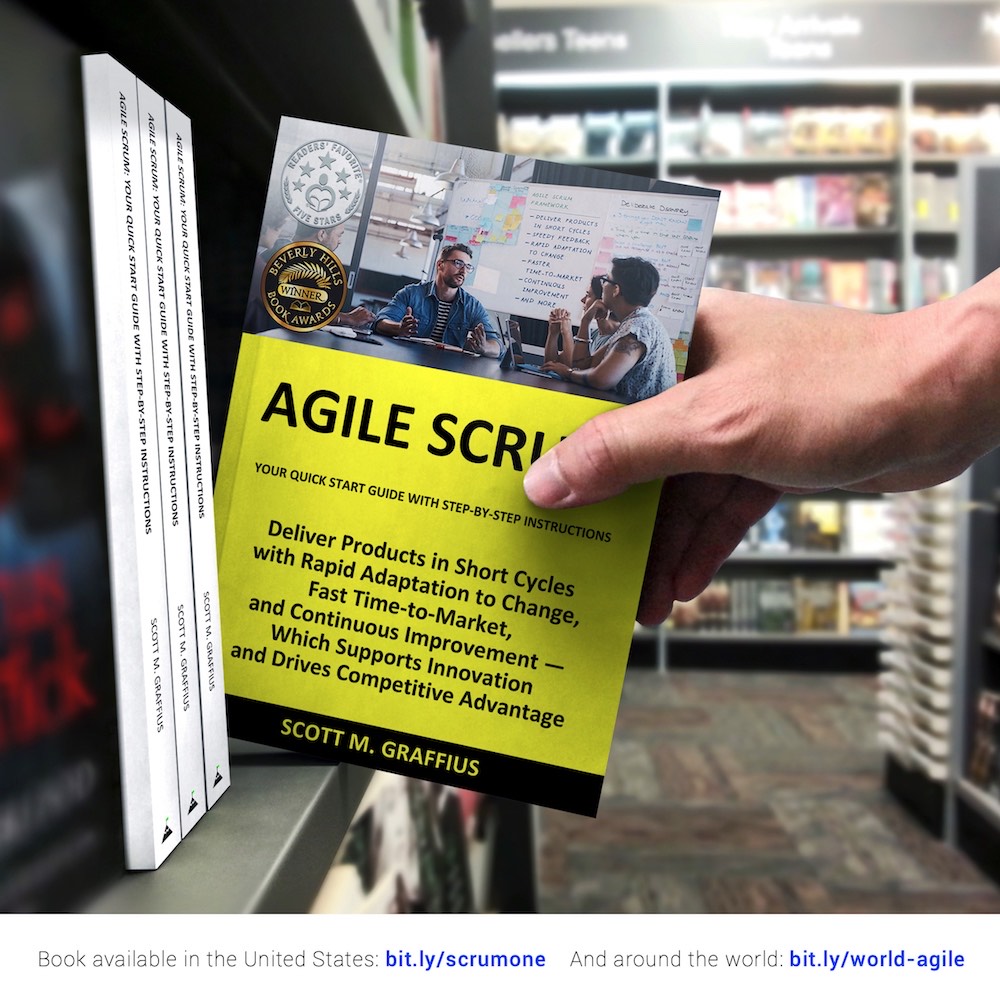
Shifting customer needs are common in today's marketplace. Businesses must be adaptive and responsive to change while delivering an exceptional customer experience to be competitive.
There are a variety of frameworks supporting the development of products and services, and most approaches fall into one of two broad categories: traditional or agile. Traditional practices such as waterfall engage sequential development, while agile involves iterative and incremental deliverables. Organizations are increasingly embracing agile to manage projects, and best meet their business needs of rapid response to change, fast delivery speed, and more.
With clear and easy to follow step-by-step instructions, Scott M. Graffius's award-winning Agile Scrum: Your Quick Start Guide with Step-by-Step Instructions helps the reader:
- Implement and use the most popular agile framework―Scrum;
- Deliver products in short cycles with rapid adaptation to change, fast time-to-market, and continuous improvement; and
- Support innovation and drive competitive advantage.
Hailed by Literary Titan as “the book highlights the versatility of Scrum beautifully.”
Winner of 17 first place awards.
Agile Scrum: Your Quick Start Guide with Step-by-Step Instructions is available in paperback and ebook/Kindle in the United States and around the world. Some links by country follow.
- 🇧🇷 Brazil
- 🇨🇦 Canada
- 🇨🇿 Czech Republic
- 🇩🇰 Denmark
- 🇫🇮 Finland
- 🇫🇷 France
- 🇩🇪 Germany
- 🇬🇷 Greece
- 🇭🇺 Hungary
- 🇮🇳 India
- 🇮🇪 Ireland
- 🇮🇱 Israel
- 🇮🇹 Italy
- 🇯🇵 Japan
- 🇱🇺 Luxembourg
- 🇲🇽 Mexico
- 🇳🇱 Netherlands
- 🇳🇿 New Zealand
- 🇳🇴 Norway
- 🇪🇸 Spain
- 🇸🇪 Sweden
- 🇨🇭 Switzerland
- 🇦🇪 UAE
- 🇬🇧 United Kingdom
- 🇺🇸 United States

About Agile Transformation: A Brief Story of How an Entertainment Company Developed New Capabilities and Unlocked Business Agility to Thrive in an Era of Rapid Change
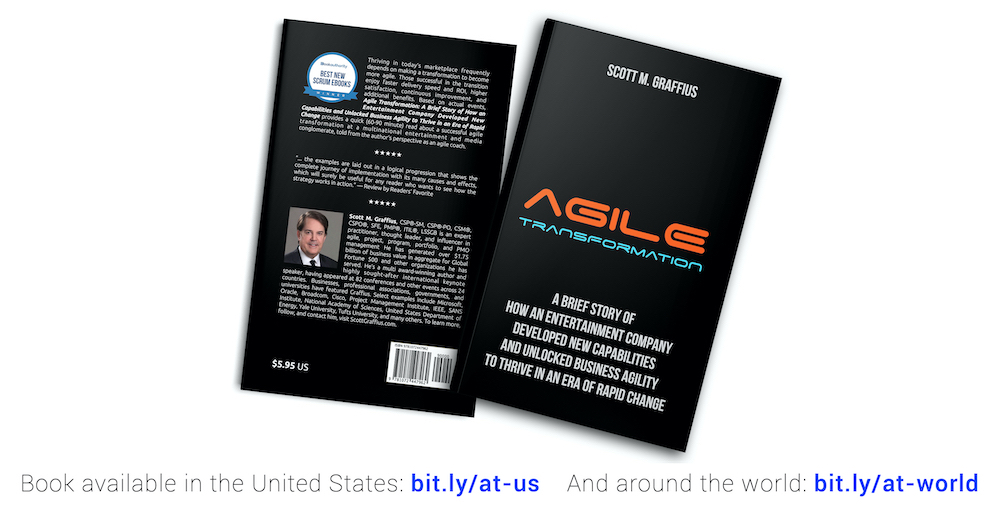
Thriving in today's marketplace frequently depends on making a transformation to become more agile. Those successful in the transition enjoy faster delivery speed and ROI, higher satisfaction, continuous improvement, and additional benefits.
Based on actual events, Agile Transformation: A Brief Story of How an Entertainment Company Developed New Capabilities and Unlocked Business Agility to Thrive in an Era of Rapid Change provides a quick (60-90 minute) read about a successful agile transformation at a multinational entertainment and media company, told from the author's perspective as an agile coach.
The award-winning book by Scott M. Graffius is available in paperback and ebook/Kindle in the United States and around the world. Some links by country follow.
- 🇦🇺 Australia
- 🇦🇹 Austria
- 🇧🇷 Brazil
- 🇨🇦 Canada
- 🇨🇿 Czech Republic
- 🇩🇰 Denmark
- 🇫🇮 Finland
- 🇫🇷 France
- 🇩🇪 Germany
- 🇬🇷 Greece
- 🇮🇳 India
- 🇮🇪 Ireland
- 🇯🇵 Japan
- 🇱🇺 Luxembourg
- 🇲🇽 Mexico
- 🇳🇱 Netherlands
- 🇳🇿 New Zealand
- 🇪🇸 Spain
- 🇸🇪 Sweden
- 🇨🇭 Switzerland
- 🇦🇪 United Arab Emirates
- 🇬🇧 United Kingdom
- 🇺🇸 United States

The short link for this article is https://bit.ly/theft-ip
© Copyright 2024 Scott M. Graffius. All rights reserved. This material may not be published, broadcast, rewritten or redistributed without the express written permission of Scott M. Graffius.

Use the Phases of Team Development (Based on Bruce W. Tuckman's Model of Forming, Storming, Norming, Performing, and Adjourning) to Help Teams Grow and Advance: 2023 Update
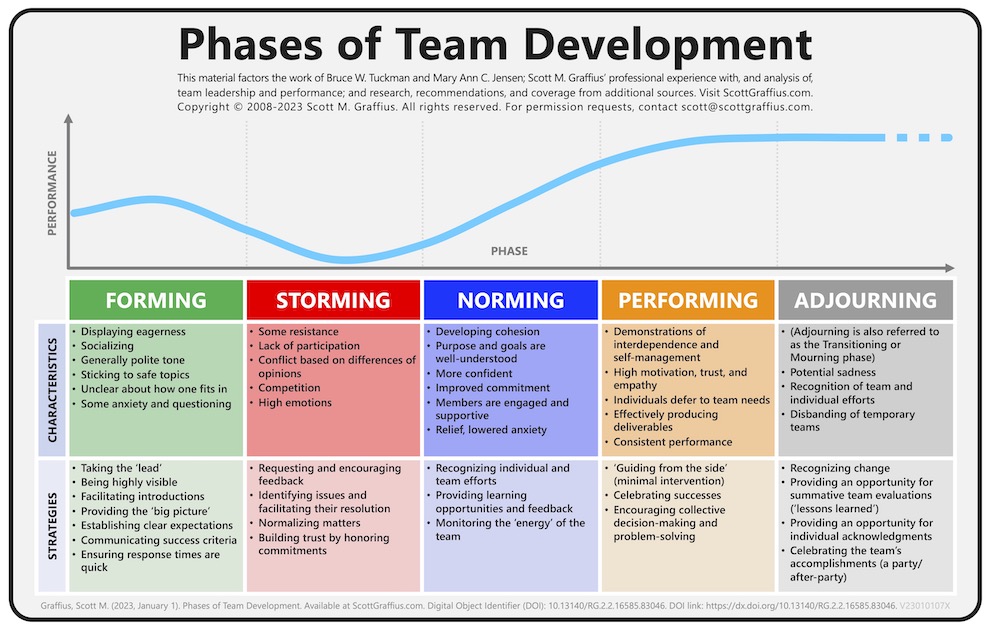
High Resolution Files of Visual: See Permission Request Information section

If there are any supplements or updates to this article after the date of publication, they will appear in the Post-Publication Notes section at the end of this article.

2023 Update
In 2008, Scott M. Graffius started developing material on advancing teams’ happiness, productivity, and success. His respective Phases of Team Development content factors the work of Dr. Bruce W. Tuckman and Mary Ann C. Jensen; Graffius's experience, observation, and analysis; and research, recommendations, and coverage from additional sources (examples are listed below).
The Phases of Team Development highlights the performance level, characteristics, and proven strategies for each of the five phases: Forming, Storming, Norming, Performing, and Adjourning. Project Managers, Scrum Masters, Agile Coaches, DevOps Leads, and other leaders can apply the information to help handle challenges or issues experienced by teams. By doing so, they’ll advance the teams' (and their own) happiness, productivity, and success.
This article and the accompanying visual provides the updated 2023 version of the Phases of Team Development.

Five Phases of Team Development
1. Forming
Characteristics of Forming include displaying eagerness, socializing, generally polite tone, sticking to safe topics, unclear about how one fits in, and some anxiety and questioning.
Strategies for this phase include taking the ‘lead,’ being highly visible, facilitating introductions, providing the ‘big picture,’ establishing clear expectations, communicating success criteria, and ensuring response times are quick.
2. Storming
Traits of Storming include some resistance, lack of participation, conflict based on differences of opinions, competition, and high emotions.
Strategies for this phase include requesting and encouraging feedback, identifying issues and facilitating their resolution, normalizing matters, and building trust by honoring commitments.
3. Norming
Features of Norming include purpose and goals are well-understood, more confident, improved commitment, members are engaged and supportive, relief (lowered anxiety), and developing cohesion.
Strategies for this phase include recognizing individual and team efforts, providing learning opportunities and feedback, and monitoring the ‘energy’ of the team.
4. Performing
Characteristics of Performing include high motivation, trust, and empathy; individuals defer to team needs; effectively producing deliverables; consistent performance; and demonstrations of interdependence and self-management.
Strategies for this phase include ‘guiding from the side’ (minimal intervention), celebrating successes, and encouraging collective decision-making and problem-solving.
5. Adjourning
Typical traits of Adjourning (also referred to as Transitioning or Mourning) include potential sadness, recognition of team and individual efforts, and disbanding.
Strategies for this phase include recognizing change, providing an opportunity for summative team evaluations ('lessons learned'), providing an opportunity for individual acknowledgments, and celebrating the team’s accomplishments — which may involve a party and possibly an after-party.


References / Sources
The Phases of Team Development by Scott M. Graffius factors the work of Dr. Bruce W. Tuckman and Mary Ann C. Jensen; Graffius's experience, observation, and analysis; and research, recommendations, and coverage from additional sources such as Google, Harvard Business Review, IEEE, MIT, Fast Company, NASA, Microsoft, TNW, Project Management Institute, Scrum Alliance, Scrum.org, Gartner, CIO, RAND Corporation, Software Engineering Institute, University of Edinburgh, Cisco, KPMG, Warsaw University of Technology, Software Engineering Institute, DevOps Institute, American Express, SANS Institute, Zurich University, SAP, ViacomCBS, Oxford University, American Management Association, AT&T, University of Southern California, IBM, and many others.
Select (partial) bibliography:
- Alford, J. (2019, April 11). Our Co-Production Journey: From Sandpits to Bird Boxes. London, United Kingdom: Imperial College London.
- Bennett, M., Gadlin, H., & Marchand, C. (2018). Collaboration Team Science: Field Guide. Rockville, MD: National Institutes of Health.
- Couture, N. (2016, October 27). A Note About Teams. CIO. Boston, MA: International Data Group (IDG).
- Daly, L. (2002). Identify Your Project Management Team’s Level of Development and Facilitate It to Success. Paper presented at Project Management Institute Annual Seminars and Symposium, San Antonio, TX. Newtown Square, PA: Project Management Institute.
- Deloitte (2017). Digital Era Technology Operating Models, Volume 2. New York, NY: Deloitte Touche Tohmatsu Limited.
- Finkelstein, S. (2017, October 29). Why Companies Should Hire Teams, Not Individuals. The Wall Street Journal. New York, NY: The Wall Street Journal.
- Forbes (2018, April 23). How to Fast-Track Any Team to Success. Forbes. New York, NY: Forbes.
- Forbes (2012, October 27). How the iPad Mini is Defining Tim Cook’s Apple. Forbes. New York, NY: Forbes.
- Glover, P. (2012, March 13). Team Conflict: Why It’s a Good Thing. Fast Company. New York, NY: Mansueto Ventures.
- Graffius, Scott M. (2021). Phases of Team Development. Los Angeles, CA: Scott M. Graffius. Digital Object Identifier (DOI): 10.13140/RG.2.2.22040.42246.
- Jovanovic, M., Mesquida, A., Radaković, N., & Mas, A. (2016). Agile Retrospective Games for Different Team Development Phases. Journal of Universal Computer Science, 22: 1489-1508.
- Kane, G. C. (2014, October 7). Why Your Company is Probably Measuring Social Media Wrong. MIT Sloan Management Review. Cambridge, MA: MIT Sloan Management Review.
- KPMG (2017). The Digital Fund, Season 2. Amstelveen, Netherlands: KPMG International.
- Madden, D. (2019, May 19). The Four Stages of Building a Great Team – and the One Where Things Usually Go Wrong. Inc. Magazine. New York, NY: Inc. Magazine.
- Makar, A. (2011, July 13). Lessons Learned in Norming and Performing Team Development Phases. Louisville, KY: TechRepublic.
- Martinuzzi, B. (2012, June 8). Six Tips Guaranteed to Reduce Workplace Frustrations. New York, NY: American Express Company.
- Microsoft (2019, June 15). Is the Latest Technology the Key to Your Team’s Success, or is There Something Else? Microsoft Developer Support. Accessed at: https://devblogs.microsoft.com/premier-developer/is-the-latest-technology-the-key-to-your-teams-success-or-is-there-something-else. Redmond, WA: Microsoft.
- Mocko, G., & Linnerud, B. (2016). Measuring the Effects of Goal Alignment on Innovative Engineering Design Projects. International Journal of Engineering Education, 32: 55-63.
- Romanelli, M. (2019, September 11). Teamwork Accelerated. PM Times. Newmarket, Ontario, Canada: Macgregor Communications.
- Riggs, A. (2020, October 15). Why I Start All My Video Meetings with Collaborative Games (Spoiler: It’s Not Boredom). Amsterdam, the Netherlands: The Next Web (TNW).
- Rowley, D., & Lange, M. (2007). Forming to Performing: The Evolution of an Agile Team. IEEE Computer Society Proceedings. Agile 2007, 1: 408-414.
- Scrum Alliance (2020). Learning Objectives Examples. Denver, CO: Scrum Alliance.
- Sakpal, M. (2020, March 3. Learn How to Debunk These Five Restructuring Myths. Stamford, CT: Gartner, Inc.
- Stern, S. (2018, September 26). Is Your Team Working the Rory Underwood Way? Financial Times. London, United Kingdom: The Financial Times, a Nikkei Company.
- Telford, R. (2013, June 4). This is Where It Gets Interesting. Armonk, NY: International Business Machines (IBM) Corporation.
- Tuckman, B. W. (1965). Developmental Sequence in Small Groups. Psychological Bulletin, 63: 384-399.
- Tuckman, B. W., & Jensen, M. A. C. (1977). Stages of Small-Group Development Revisited. Group and Organizational Studies, 2 (4): 419-427.
- United States Army (2015). Innovative Learning: A Key to National Security. Washington, DC: United States Army.


How to Cite This Article
Graffius, Scott M. (2023, January 9). Use the Phases of Team Development (Based on Bruce W. Tuckman's Model of Forming, Storming, Norming, Performing, and Adjourning) to Help Teams Grow and Advance: 2023 Update. Available at: https://scottgraffius.com. Digital Object Identifier (DOI): 10.13140/RG.2.2.10720.35846. DOI link: https://dx.doi.org/10.13140/RG.2.2.10720.35846.


Request Permission
This material is © copyright 2023 Scott M. Graffius. All rights reserved. It may not be published, broadcast, rewritten or redistributed without the express written permission of Scott M. Graffius.
To request permission to use the Phases of Team Development content, contact Scott M. Graffius.
If a request is approved, terms and conditions will be provided along with—if applicable—downloadable high resolution versions of the Phases of Team Development image in JPG and PNG formats.



About Scott M. Graffius

Scott M. Graffius, PMP, CSP-SM, CSP-PO, CSM, CSPO, SFE, ITIL, LSSGB is an agile project management practitioner, consultant, multi award-winning author, and highly sought-after international keynote speaker. He has generated over $1.75 billion of business value in aggregate for the organizations he has served. Graffius is the CEO and Principal Consultant at Exceptional PPM and PMO Solutions™ and subsidiary Exceptional Agility™. Content from his books, talks, workshops, and more have been featured and used by businesses, professional associations, governments, and universities. Select examples include Microsoft, Oracle, Broadcom, Cisco, Gartner, Project Management Institute, IEEE, U.S. Soccer Federation, Qantas, National Academy of Sciences, U.S. Department of Energy, U.S. National Park Service, New Zealand Ministry of Education, Yale University, Warsaw University of Technology, and others. Graffius has delighted audiences with dynamic and engaging talks and workshops on agile, project management, and technology leadership at 82 conferences and other events across 24 countries.
His full bio is available here.
Connect with Scott on:
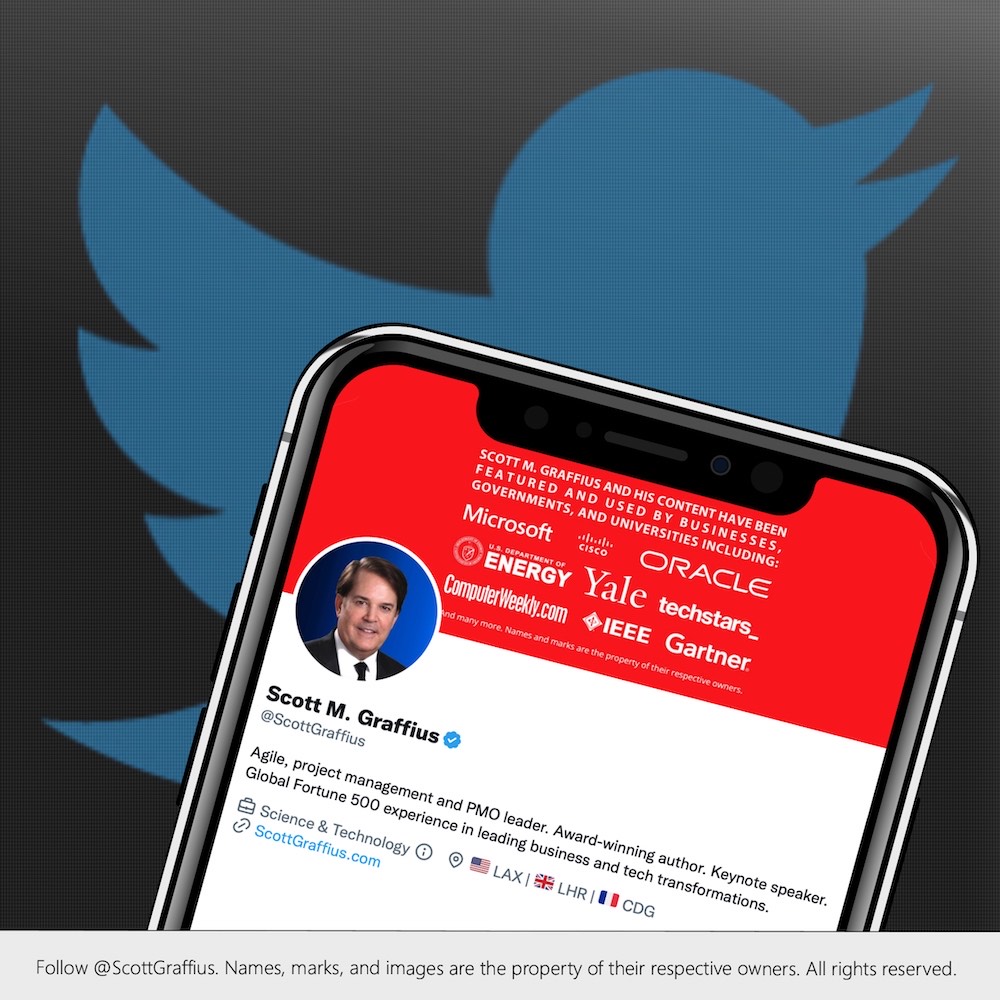

About Agile Scrum: Your Quick Start Guide with Step-by-Step Instructions

Shifting customer needs are common in today's marketplace. Businesses must be adaptive and responsive to change while delivering an exceptional customer experience to be competitive.
There are a variety of frameworks supporting the development of products and services, and most approaches fall into one of two broad categories: traditional or agile. Traditional practices such as waterfall engage sequential development, while agile involves iterative and incremental deliverables. Organizations are increasingly embracing agile to manage projects, and best meet their business needs of rapid response to change, fast delivery speed, and more.
With clear and easy to follow step-by-step instructions, Scott M. Graffius's award-winning Agile Scrum: Your Quick Start Guide with Step-by-Step Instructions helps the reader:
- Implement and use the most popular agile framework―Scrum;
- Deliver products in short cycles with rapid adaptation to change, fast time-to-market, and continuous improvement; and
- Support innovation and drive competitive advantage.
Hailed by Literary Titan as “the book highlights the versatility of Scrum beautifully.”
Winner of 17 first place awards.
Agile Scrum: Your Quick Start Guide with Step-by-Step Instructions is available in paperback and ebook/Kindle in the United States and around the world. Some links by country follow.
- 🇧🇷 Brazil
- 🇨🇦 Canada
- 🇨🇿 Czech Republic
- 🇩🇰 Denmark
- 🇫🇮 Finland
- 🇫🇷 France
- 🇩🇪 Germany
- 🇬🇷 Greece
- 🇭🇺 Hungary
- 🇮🇳 India
- 🇮🇪 Ireland
- 🇮🇱 Israel
- 🇮🇹 Italy
- 🇯🇵 Japan
- 🇱🇺 Luxembourg
- 🇲🇽 Mexico
- 🇳🇱 Netherlands
- 🇳🇿 New Zealand
- 🇳🇴 Norway
- 🇪🇸 Spain
- 🇸🇪 Sweden
- 🇨🇭 Switzerland
- 🇦🇪 UAE
- 🇬🇧 United Kingdom
- 🇺🇸 United States

About Agile Transformation: A Brief Story of How an Entertainment Company Developed New Capabilities and Unlocked Business Agility to Thrive in an Era of Rapid Change

Thriving in today's marketplace frequently depends on making a transformation to become more agile. Those successful in the transition enjoy faster delivery speed and ROI, higher satisfaction, continuous improvement, and additional benefits.
Based on actual events, Agile Transformation: A Brief Story of How an Entertainment Company Developed New Capabilities and Unlocked Business Agility to Thrive in an Era of Rapid Change provides a quick (60-90 minute) read about a successful agile transformation at a multinational entertainment and media company, told from the author's perspective as an agile coach.
The award-winning book by Scott M. Graffius is available in paperback and ebook/Kindle in the United States and around the world. Some links by country follow.
- 🇦🇺 Australia
- 🇦🇹 Austria
- 🇧🇷 Brazil
- 🇨🇦 Canada
- 🇨🇿 Czech Republic
- 🇩🇰 Denmark
- 🇫🇮 Finland
- 🇫🇷 France
- 🇩🇪 Germany
- 🇬🇷 Greece
- 🇮🇳 India
- 🇮🇪 Ireland
- 🇯🇵 Japan
- 🇱🇺 Luxembourg
- 🇲🇽 Mexico
- 🇳🇱 Netherlands
- 🇳🇿 New Zealand
- 🇪🇸 Spain
- 🇸🇪 Sweden
- 🇨🇭 Switzerland
- 🇦🇪 United Arab Emirates
- 🇬🇧 United Kingdom
- 🇺🇸 United States


Post-Publication Notes
Update on 7 January 2025
Scott M. Graffius periodically updates his 'Phases of Team Development' work. The most current edition is here.

© Copyright 2023 Scott M. Graffius. All rights reserved. This material may not be published, broadcast, rewritten or redistributed without the express written permission of Scott M. Graffius.

Zittau/Görlitz University of Applied Sciences Features Scott M. Graffius' Content
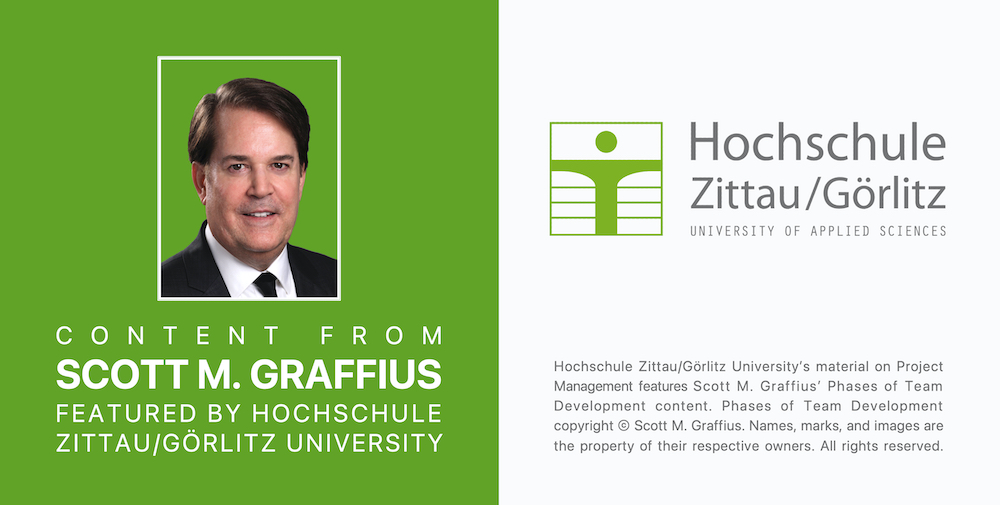
Select here to download this article as a PDF.
Businesses, professional associations, governments, and universities have used and featured Scott M. Graffius and content from his books, talks, workshops, and more. Examples of organizations include Microsoft, Oracle, Broadcom, Cisco, Gartner, Project Management Institute, IEEE, National Academy of Sciences, United States Department of Energy, New Zealand Ministry of Education, Yale University, Tufts University, and many others.
This month, Hochschule Zittau/Görlitz (Zittau/Görlitz University of Applied Sciences) was added to the list of organizations. Dr. Ingo Cassack, Professor at the university, incorporated Graffius' Phases of Team Development work into Dr. Cassack's material on project management. Two excerpts follow.
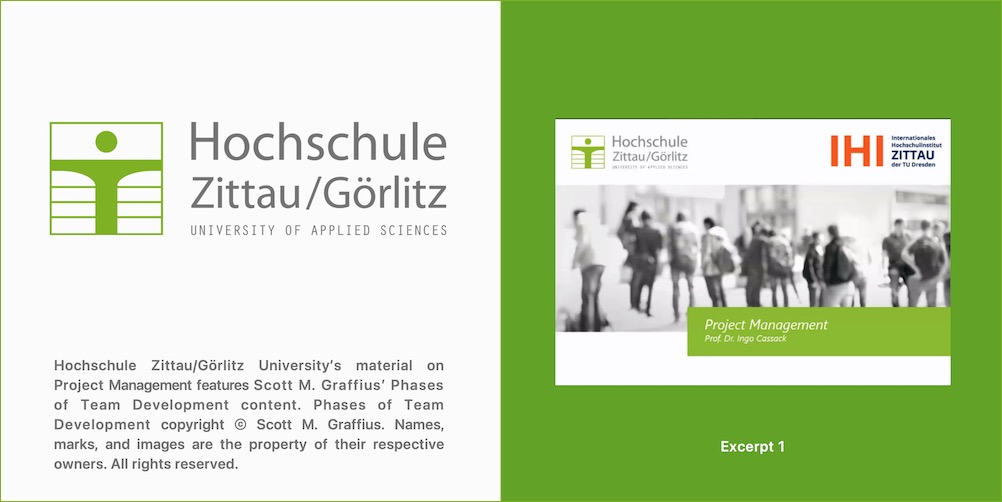
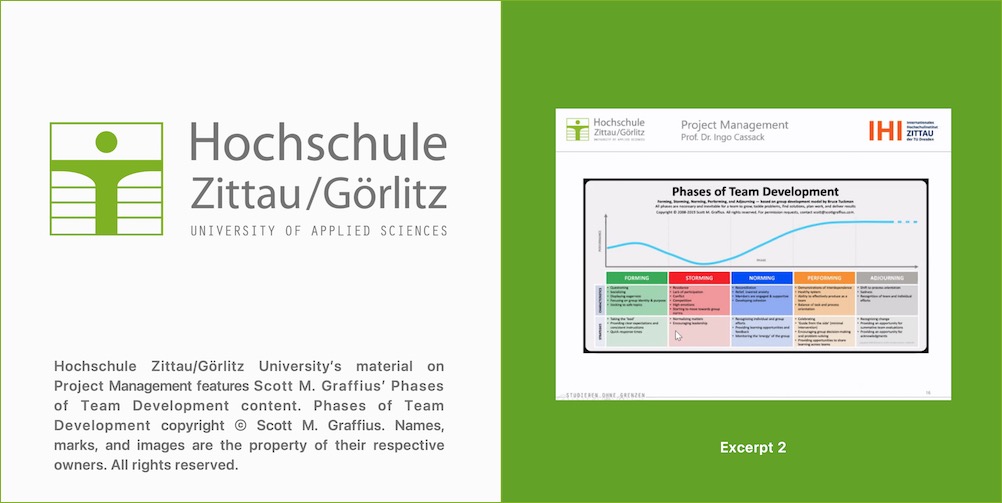
To learn more about Scott M. Graffius' Phases of Team Development, visit here.
Oksana Makovoz wrote about the presentation which included Graffius' work, among other details. She posted on:
About Hochschule Zittau/Görlitz
Hochschule Zittau/Görlitz (Zittau/Görlitz University of Applied Sciences) is a non-profit public higher-education institution located in Zittau — in the border triangle between Germany, the Czech Republic, and Poland . The institution also has a branch campus in Görlitz, Saxon, Germany. Officially recognized by the Sächsisches Staatsministerium für Wissenschaft und Kunst (Saxon State Ministry of Science and the Arts), Hochschule Zittau/Görlitz is a top tier coeducational German higher education institution with no tuition fees, state-of-the-art equipment, and intensive support. Visit https://www.hszg.de to learn more.



About Scott M. Graffius

Scott M. Graffius, PMP, SA, CSP-SM, CSP-PO, CSM, CSPO, SFE, ITIL, LSSGB is an agile project management practitioner, consultant, multi-award-winning author, and international keynote speaker. He is the Founder of Exceptional PPM and PMO Solutions™ and subsidiary Exceptional Agility™. He has generated over $1.9 billion of business value in aggregate for Global Fortune 500 businesses and other organizations he has served. Graffius and content from his books, talks, workshops, and more have been featured and used by businesses, professional associations, governments, and universities. Examples include Microsoft, Oracle, Broadcom, Cisco, Gartner, Project Management Institute, IEEE, Qantas, National Academy of Sciences, United States Department of Energy, New Zealand Ministry of Education, Yale University, Tufts University, and others. He has delighted audiences with dynamic and engaging talks and workshops on agile, project management, and technology leadership at 85 conferences and other events across 25 countries.
His full bio is available here.
Connect with Scott on:


About Agile Scrum: Your Quick Start Guide with Step-by-Step Instructions

Shifting customer needs are common in today's marketplace. Businesses must be adaptive and responsive to change while delivering an exceptional customer experience to be competitive.
There are a variety of frameworks supporting the development of products and services, and most approaches fall into one of two broad categories: traditional or agile. Traditional practices such as waterfall engage sequential development, while agile involves iterative and incremental deliverables. Organizations are increasingly embracing agile to manage projects, and best meet their business needs of rapid response to change, fast delivery speed, and more.
With clear and easy to follow instructions, the multi award-winning Agile Scrum: Your Quick Start Guide with Step-by-Step Instructions book by Scott M. Graffius (Chris Hare and Colin Giffen, Technical Editors) helps the reader:
- Implement and use the most popular agile framework―Scrum;
- Deliver products in short cycles with rapid adaptation to change, fast time-to-market, and continuous improvement; and
- Support innovation and drive competitive advantage.
Hailed by Literary Titan as “the book highlights the versatility of Scrum beautifully.”
Winner of 17 first place awards.
Agile Scrum: Your Quick Start Guide with Step-by-Step Instructions is available in paperback and ebook/Kindle in the United States and around the world. Some links by country follow.
- 🇧🇷 Brazil
- 🇨🇦 Canada
- 🇨🇿 Czech Republic
- 🇩🇰 Denmark
- 🇫🇮 Finland
- 🇫🇷 France
- 🇩🇪 Germany
- 🇬🇷 Greece
- 🇭🇺 Hungary
- 🇮🇳 India
- 🇮🇪 Ireland
- 🇮🇱 Israel
- 🇮🇹 Italy
- 🇯🇵 Japan
- 🇱🇺 Luxembourg
- 🇲🇽 Mexico
- 🇳🇱 Netherlands
- 🇳🇿 New Zealand
- 🇳🇴 Norway
- 🇪🇸 Spain
- 🇸🇪 Sweden
- 🇨🇭 Switzerland
- 🇦🇪 UAE
- 🇬🇧 United Kingdom
- 🇺🇸 United States

About Agile Transformation: A Brief Story of How an Entertainment Company Developed New Capabilities and Unlocked Business Agility to Thrive in an Era of Rapid Change

Thriving in today's marketplace frequently depends on making a transformation to become more agile. Those successful in the transition enjoy faster delivery speed and ROI, higher satisfaction, continuous improvement, and additional benefits.
Based on actual events, Agile Transformation: A Brief Story of How an Entertainment Company Developed New Capabilities and Unlocked Business Agility to Thrive in an Era of Rapid Change provides a quick (60-90 minute) read about a successful agile transformation at a multinational entertainment and media company, told from the author's perspective as an agile coach.
The award-winning book by Scott M. Graffius is available in paperback and ebook/Kindle in the United States and around the world. Some links by country follow.
- 🇦🇺 Australia
- 🇦🇹 Austria
- 🇧🇷 Brazil
- 🇨🇦 Canada
- 🇨🇿 Czech Republic
- 🇩🇰 Denmark
- 🇫🇮 Finland
- 🇫🇷 France
- 🇩🇪 Germany
- 🇬🇷 Greece
- 🇮🇳 India
- 🇮🇪 Ireland
- 🇯🇵 Japan
- 🇱🇺 Luxembourg
- 🇲🇽 Mexico
- 🇳🇱 Netherlands
- 🇳🇿 New Zealand
- 🇪🇸 Spain
- 🇸🇪 Sweden
- 🇨🇭 Switzerland
- 🇦🇪 United Arab Emirates
- 🇬🇧 United Kingdom
- 🇺🇸 United States

The short URL for this article is: https://bit.ly/hszg-2023
© Copyright 2023 Scott M. Graffius. All rights reserved. This material may not be published, broadcast, rewritten or redistributed without the express written permission of Scott M. Graffius.

AI is a Team Sport: A Confluence of Diverse Technical and Soft Skills are Crucial for Success

Select here to download this article as a PDF.
This article covers the significance of well-rounded AI teams, including how both soft and technical skills are critical and fuel success. It’s informed by Graffius' work on AI projects as well as research and coverage from DARPA, Exceptional Agility, IBM, IEEE, Intel, MIT, Microsoft, Nvidia, Samsung, Software Engineering Institute, Stanford University, United States Artificial Intelligence Institute, and others (all listed in the bibliography section of this article).

Introduction
Artificial Intelligence (AI) has emerged as a transformative force across a growing number of industries, revolutionizing how we live, work, and interact. From autonomous vehicles and virtual assistants to personalized recommendations and medical diagnoses, AI systems have become integral to our daily lives. Behind these cutting-edge, life-changing solutions are AI teams that possess a combination of soft skills—also known as core skills, interpersonal skills, people skills, power skills, transferable skills, or transversal skills—and technical expertise.
This article highlights the synergy between soft skills and technical skills in the world of AI. While technical skills provide the general foundation for AI development, it’s the soft skills that elevate AI projects to new heights. From effective communication and critical thinking to leadership and teamwork, soft skills play a pivotal role in translating technical knowledge and capabilities into real-world applications.
The thesis of this article is that the successful development and application of AI requires a combination of soft skills and technical expertise. Technical competencies alone are not enough. Rather, it’s the combination and integration of soft and technical skills that truly unlocks the power of AI.
Next, this article focuses on the importance of soft skills in the AI landscape, highlighting how they complement and enhance technical abilities. The collaboration between these skill sets drives AI innovation.

Understanding Soft Skills in AI Teams
In the realm of AI, technical expertise often takes center stage. However, soft skills advance the successful outcomes of AI projects, as they facilitate effective communication, foster collaboration, and promote critical thinking. Soft skills are powerful facilitators of success.
Soft skills encompass a range of interpersonal and cognitive abilities that enable teams to work harmoniously, adapt to evolving challenges, and solve complex problems. In the AI landscape, where multidisciplinary teams come together to create innovative solutions, these soft skills are essential.
Effective communication stands at the forefront of soft skills in AI. AI teams must articulate complex technical concepts in a manner that is understandable to diverse stakeholders, including non-technical staff and internal or external customers/users. Clear communication promotes collaboration and ensures alignment of purpose and objectives throughout the AI development lifecycle.
Soft skills such as problem-solving and critical thinking are vital as well. AI teams frequently encounter multifaceted challenges, and it is through these soft skills that teams can identify potential bottlenecks, navigate complexities, and devise innovative solutions. By leveraging critical thinking, AI team members can evaluate different approaches, consider ethical implications, and make informed decisions that shape the development and application of AI systems.
Leadership and teamwork skills are also paramount. AI projects involve team members from diverse backgrounds, including data scientists, engineers, domain experts, designers, and others. Effective leadership enables the coordination of efforts and guides the project towards success. Similarly, teamwork skills foster an environment of trust and respect, promoting synergy among team members and enhancing overall productivity.
Recognizing the importance of soft skills in AI is crucial for fostering a balanced and effective team dynamic. It ensures that AI teams possess the interpersonal and cognitive abilities necessary to bring AI projects to fruition. The integration of soft skills alongside technical expertise sets the stage for a cohesive team capable of tackling complex AI challenges with agility and innovation.
The role of technical skills—including how they intersect with soft skills to create a powerful combination that drives success—are covered next.
The Role of Technical Skills in AI Teams
Technical skills provide the tools and knowledge required to design, build, and implement AI systems. This section explores the role that technical skills play in AI and their specific applications in various stages of AI projects.
- Programming Languages and Algorithms: Proficiency in programming languages such as Python, Java, or R is essential. These languages enable team members to write efficient code, manipulate and analyze data, and implement machine learning algorithms. Understanding algorithms, from classic ones like linear regression to cutting-edge deep learning models, empowers AI professionals to leverage mathematical principles and statistical techniques to train and optimize AI systems.
- Data Analysis and Management: AI relies on data, making data analysis and management skills crucial. AI team members need to be adept at collecting, cleaning, and preprocessing data, ensuring its quality and relevance. They must possess the knowledge of statistical methods, data visualization techniques, and data engineering practices to extract insights from complex datasets and prepare them for AI model training.
- Machine Learning and Neural Networks: Technical skills in machine learning are at the heart of AI systems. Understanding machine learning algorithms, such as decision trees, support vector machines, or convolutional neural networks, enables AI team members to create models that can learn from data and make intelligent predictions or decisions. Expertise in neural networks and deep learning architectures equips professionals with the ability to develop complex models capable of handling tasks like image recognition, natural language processing, and reinforcement learning.
- AI Frameworks and Tools: Proficiency in AI frameworks and tools (such as TensorFlow, Keras, PyTorch, Caffe, Scikit-learn, and others) are essential for building AI systems efficiently. These frameworks provide pre-built modules, libraries, and APIs that simplify the implementation of AI algorithms and models. Technical skills in utilizing these tools effectively enable AI team members to accelerate the development process, streamline model training, and optimize system performance.
- Domain Knowledge and Application-Specific Skills: Technical skills also encompass domain knowledge and application-specific expertise. Understanding the nuances of the industry or problem domain in which AI is being applied allows professionals to tailor AI solutions to meet specific requirements. For example, healthcare-focused AI projects may require knowledge of medical terminologies and regulatory considerations, while AI solutions for financial services may demand expertise in risk assessment and fraud detection.
Technical skills are essential for AI projects. They enable team members to translate concepts, theories, and algorithms into practical applications. However, technical skills alone are not sufficient for success. The collaborative nature of AI development and the need for a well-rounded AI team—including the synergy between technical skills and soft skills—is covered next.
The Power of Synergy: Soft Skills and Technical Skills in AI Teams
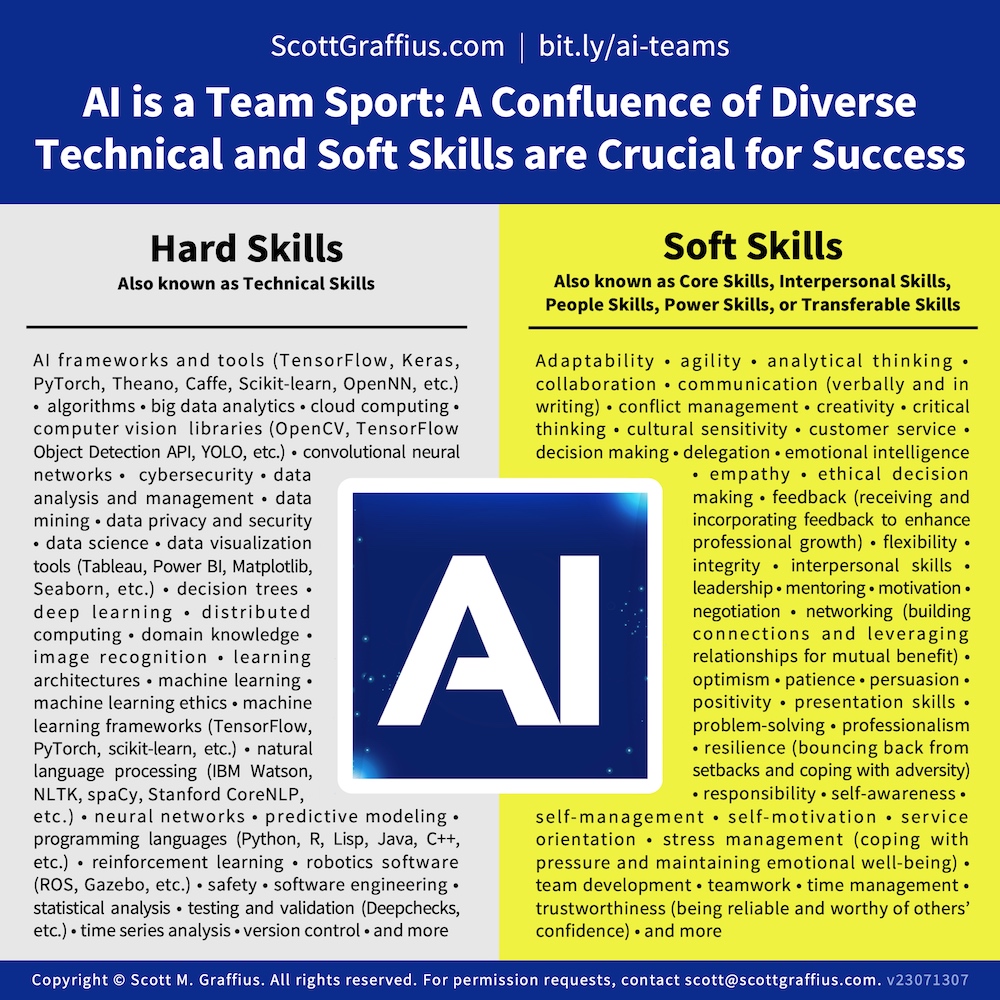
The convergence of technical and soft skills is where true innovation and breakthroughs occur. The successful development and application of AI systems rely not only on technical expertise but also on the harmonious integration of soft skills. Here’s some examples of the power of synergy between these skill sets, including how they work together to drive AI advancement:
- Effective Communication and Technical Expertise: Communication bridges the gap between AI professionals and others who may not possess technical backgrounds. AI experts with strong communication skills can articulate complex technical concepts in plain English, ensuring that everyone involved understands the goals, challenges, and progress of the project. By effectively conveying ideas, AI professionals foster collaboration, gather valuable insights, and create a shared vision for AI initiatives.
- Collaboration and Problem-Solving: Collaboration is at the core of AI development, and soft skills such as teamwork, empathy, and active listening facilitate effective collaboration among diverse team members. AI teams with strong collaboration skills can effectively pool their technical expertise, brainstorm ideas, and solve complex problems together. By leveraging their collective intelligence and diverse perspectives, AI teams can overcome challenges, refine AI models, and optimize the performance of AI solutions.
- Critical Thinking and Technical Innovation: Critical thinking, coupled with technical expertise, leads to innovative AI solutions. AI professionals with strong critical thinking skills can evaluate different approaches, challenge assumptions, and identify potential shortcomings or biases in AI models. They can think creatively to address issues such as data biases or fairness concerns, ensuring that AI systems are developed responsibly and ethically.
- Leadership and Team Empowerment: Effective leadership in AI projects involves establishing and maintaining a collaborative and inclusive environment, empowering team members, and harnessing their full potential. AI leaders with exceptional interpersonal abilities can inspire and motivate their team, foster a culture of continuous learning, and provide guidance in navigating complex technical challenges. They encourage interdisciplinary collaboration, respect diverse perspectives, and drive the team towards achieving AI objectives.
The synergy between soft skills and technical skills is the catalyst that drives AI projects towards success. It enables AI teams to go beyond technical expertise and develop AI systems that address real-world problems effectively. By embracing a holistic approach that values both soft skills and technical skills, organizations can foster an environment where AI thrives, resulting in innovative solutions that have a positive impact on society.
Strategies for developing and nurturing soft skills are covered next.
Developing and Advancing Soft Skills in AI Teams
AI teams need soft skills to be successful. Organizations and teams should prioritize the development and advancement of these skills. Here are some strategies to enhance soft skills and foster a well-rounded AI workforce:
- Training Programs and Workshops: Implement specialized training programs and workshops focused on enhancing soft skills. Offer courses in effective communication, leadership (including how to navigate the phases of team development), problem-solving, critical thinking, and collaboration. These programs can provide AI professionals with the necessary tools and techniques to effectively apply soft skills in their work.
- Interdisciplinary Collaboration and Knowledge Sharing: Encourage interdisciplinary collaboration by creating opportunities for AI team members to work alongside experts from diverse fields such as psychology, design, ethics, and business. This collaboration allows for cross-pollination of ideas, encourages different perspectives, and broadens the skill set of AI teams. Foster a culture of knowledge sharing, where professionals can learn from each other and leverage their collective experiences and expertise.
- Real-World Project Engagement: Provide AI team members with opportunities to work on (other) real-world projects, allowing them to apply their soft skills in practical scenarios. Engaging in projects that involve interaction with clients, end-users, and stakeholders helps AI team members develop effective communication, problem-solving, and teamwork skills.
- Continuous Learning and Professional Development: Encourage AI team members to engage in continuous learning and professional development activities. This can include attending conferences, participating in webinars, reading industry publications, and pursuing certifications in relevant areas. Promote a growth mindset among AI team members, emphasizing the importance of lifelong learning and staying current with the latest developments in both technical and soft skills domains.
- Mentorship and Coaching: Establish mentorship and coaching programs where experienced AI professionals guide and support individuals with less experience. Mentors can provide valuable insights, share their experiences, and offer guidance on developing skills. Regular feedback and coaching sessions help AI professionals identify areas for improvement and provide targeted development opportunities.
By implementing these strategies, organizations can cultivate a workforce that excels not only in technical skills but also in the essential soft skills required for AI success. Nurturing well-rounded AI professionals creates a collaborative and adaptive environment, where AI teams can effectively address complex challenges, drive innovation, and deliver impactful solutions.
The next section wraps up this exploration.


Conclusion
The successful development and application of AI systems rely on the synergy between soft skills and technical skills. While technical expertise forms the foundation, it's the integration of soft skills that elevates AI projects to new heights. Effective communication, collaboration, critical thinking, and leadership are among the key soft skills that enable AI teams to excel.
This article explored the significance of soft skills in AI, emphasizing their role in fostering effective teamwork, problem-solving, and innovation. It also acknowledged the indispensable role of technical skills in AI development, including programming languages, algorithms, data analysis, domain knowledge, and more.
Organizations can create well-rounded AI teams with a holistic set of abilities by embracing the power of synergy between soft skills and technical skills. AI team members with strong soft skills can effectively communicate their ideas, collaborate seamlessly, think critically, and provide leadership that empowers their teams.
To advance soft skills among AI professionals, organizations should invest in training programs, promote interdisciplinary collaboration, encourage continuous learning, and foster mentorship and coaching relationships. These efforts will help AI professionals develop the interpersonal and cognitive abilities necessary to thrive in the dynamic and collaborative AI landscape.
AI is a team sport that thrives on the confluence of soft skills and technical skills. By recognizing and embracing this synergy, organizations can unlock the full potential of AI, delivering innovative solutions that address real-world challenges and have a positive impact on the world.

References/Sources
All of the supplied links were functional when this article was published.
- Accenture (2023, March 30). Accenture Technology Vision 2023: Generative AI to Usher in a Bold New Future for Business, Merging Physical and Digital Worlds. Available at: https://newsroom.accenture.com/news/accenture-technology-vision-2023-generative-ai-to-usher-in-a-bold-new-future-for-business-merging-physical-and-digital-worlds.htm.
- Alsever, Jennifer (2020, January 20). Medicine by Machine: Is A.I. the Cure for the World’s Ailing Drug Industry? Fortune. Available at: https://fortune.com/longform/ai-artificial-intelligence-medicine-healthcare-pharmaceutical-industry.
- Anthropic (2023, March 14). Introducing Claude. Available at: https://www.anthropic.com/news/introducing-claude.
- Berlin School of Business and Innovation (2022, September 22). How Do Technical Abilities Combined with Leadership Skills Fuel Career Growth? Available at: https://www.berlinsbi.com/blog/career-advice/how-do-technical-abilities-combined-with-leadership-skills-fuel-career-growth.
- Bhatti, Shawaiz, Demir, Mustafa, Cooke, Nancy J., & Johnson, Craig J. (2021). Assessing Communication and Trust in an AI Teammate in a Dynamic Task Environment. In: 2021 IEEE 2nd International Conference on Human-Machine Systems (ICHMS): 1–6. DOI: 10.1109/ICHMS53169.2021.9582626.
- Brooks, David (2023, February 2). In the Age of A.I., Major in Being Human. The New York Times. Available at: https://www.nytimes.com/2023/02/02/opinion/ai-human-education.html.
- C3.ai (n.d.). Best Practices in Prototyping: Cross-Functional Teams. Available at: https://c3.ai/introduction-what-is-machine-learning/cross-functional-teams/.
- Crampton, Natasha (2021, January 19). The Building Blocks of Microsoft’s Responsible AI Program. Microsoft. Available at: https://blogs.microsoft.com/on-the-issues/2021/01/19/microsoft-responsible-ai-program.
- Dolev, Niva, & Itzkovich, Yariv (2020). In the AI Era, Soft Skills are the New Hard Skills. In: Artificial Intelligence and Its Impact on Business, pp. 55-77. Charlotte, NC: Information Age Publishing.
- Dzombak, Rachel, & Palat, Jay (2021, August 30). 5 Ways to Start Growing an AI-Ready Workforce. Pittsburgh, PA: Software Engineering Institute, Carnegie Mellon University.
- Elliott, Joshua (n.d.). Artificial Social Intelligence for Successful Teams (ASIST). Arlington, VA: Defense Advanced Research Projects Agency (DARPA).
- Exceptional Agility (2023, April 10). What's the Future of Agile? Available at: https://exceptionalagility.com/blog/files/the-future.html.
- Fountaine, Tim, McCarthy, Brian, & Saleh, Tamim (2019). Building the AI-Powered Organization. Harvard Business Review, 97 (4): 62–73.
- Gartner (2020, December 15). How to Staff Your AI Team. Available at: https://www.gartner.com/smarterwithgartner/how-to-staff-your-ai-team.
- Gong, Michelle; and Zhernov, Anton (2019, November 18). Advanced Machine Learning Helps Play Store Users Discover Personalised Apps. Google DeepMind. Available at: https://deepmind.google/discover/blog/advanced-machine-learning-helps-play-store-users-discover-personalised-apps/.
- Gorman, Austin (2023, April 27). How to Strengthen Your Soft Skills for AI and the Future of Work. Fast Company. Available at: https://www.fastcompany.com/90887540/how-to-strengthen-your-soft-skills-for-ai-and-the-future-of-work.
- GovExec Events (2020, July 1). Human Machine Team: The Intersection of Diverse Skill Sets [Video]. Defense One. Available at: https://www.youtube.com/watch?v=93wbNLKpbxg&t=1s.
- Graffius, Scott M. (2023, May 1). Fueling the Development of Innovative and Life-Changing AI Solutions [Presentation]. Talk delivered to an audience of Technology professionals (including Data Scientists, Machine Learning Engineers, Data Engineers, AI Researchers, Project Managers, Business Analysts, UX Designers, Software Developers, Cloud Architects, Data Privacy and Security Specialists, and others involved or interested in AI) at a private event in Mountain View, California, United States. Digital Object Identifier (DOI): 10.13140/RG.2.2.27956.73601. DOI link: https://dx.doi.org/10.13140/RG.2.2.27956.73601.
- Graffius, Scott M. (2023, April 26). The Science of High-Performance Teams [Presentation]. Talk delivered at the DevOps Institute’s SKILup Day 2023 Conference. Digital Object Identifier (DOI): 10.13140/RG.2.2.15888.28169. DOI link: https://dx.doi.org/10.13140/RG.2.2.15888.28169.
- Graffius, Scott M. (2023, January 9). Use the Phases of Team Development (Based on Bruce W. Tuckman's Model of Forming, Storming, Norming, Performing, and Adjourning) to Help Teams Grow and Advance: 2023 Update. Available at: https://scottgraffius.com. Digital Object Identifier (DOI): 10.13140/RG.2.2.10720.35846. DOI link: https://dx.doi.org/10.13140/RG.2.2.10720.35846.
- Graffius, Scott M. (2022, May 13). Want Happier and More Productive DevOps Teams? [Presentation]. Talk delivered at DevOpsDays Geneva, Switzerland 2022 Conference. Digital Object Identifier (DOI): 10.13140/RG.2.2.22252.85127. DOI link: https://dx.doi.org/10.13140/RG.2.2.22252.85127.
- Graffius, Scott M. (2021, October 5). Navigate the Phases of Team Development with Speed and Agility for Happier and More Productive Teams [Presentation]. Talk delivered at the Institute of Electrical and Electronics Engineers IEEE Day 2021 Conference. Digital Object Identifier (DOI): 10.13140/RG.2.2.20055.19365. DOI link: https://dx.doi.org/10.13140/RG.2.2.20055.19365.
- Graffius, Scott M. (2021, February 20). But First, the Team! [Presentation]. Talk delivered at the Brno, Czech Republic DevConf.CZ 2021 Conference. Digital Object Identifier (DOI): 10.13140/RG.2.2.29016.72964. DOI link: https://dx.doi.org/10.13140/RG.2.2.29016.72964.
- Gupta, Arun (2022). Non-Technical Skills Eat Technical Skills for Breakfast [Video]. Recording of Arun Gupta, VP and GM of the Open Ecosystem at Intel, speaking at the All Things Open Conference. Available at: https://www.youtube.com/watch?v=WNPxRBhYNU4.
- Humpton, Barbara (n.d.). The Future of Jobs. Siemens. Available at: https://www.siemens.com/us/en/company/press/siemens-stories/ceo-perspective/the-future-of-jobs.html.
- IBM (2019, September 26). Assemble the Team to Support a Data-Driven Project. Available at: https://www.ibm.com/garage/method/practices/culture/assemble-team-for-data-driven-project.
- IBM (2019). Everyday Ethics for Artificial Intelligence. Available at: https://www.ibm.com/watson/assets/duo/pdf/everydayethics.pdf.
- Institute of Electrical and Electronics Engineers (IEEE) (2021, November 8). The IEEE Global Initiative on Ethics of Autonomous and Intelligent Systems. Available at: https://standards.ieee.org/industry-connections/ec/autonomous-systems.html.
- Kenan Institute (2023, February 20). The Must-Have Skills in the Era of Artificial Intelligence: How AI’s Democratization Will Impact Workers. Available at: https://kenaninstitute.unc.edu/commentary/the-must-have-skills-in-the-era-of-artificial-intelligence-how-ais-democratization-will-impact-workers.
- Lindzon, Jared (2017, February 28). How AI is Changing the Way Companies are Organized. Fast Company. Available at: https://www.fastcompany.com/3068492/how-ai-is-changing-the-way-companies-are-organized.
- Marr, Bernard (2023, March 20). Beyond The Hype: What You Really Need to Know About AI In 2023. Forbes. Available at: https://www.forbes.com/sites/bernardmarr/2023/03/20/beyond-the-hype-what-you-really-need-to-know-about-ai-in-2023.
- Massachusetts Institute of Technology (MIT) Lincoln Laboratory (2023, January 17). Human-AI Performance Incubator. Available at: https://www.ll.mit.edu/r-d/projects/human-ai-performance-incubator.
- Massachusetts Institute of Technology (MIT) (2021, January). Cognitive Science as a New People Science for the Future of Work. Available at: https://workofthefuture.mit.edu/wp-content/uploads/2021/01/2021-Research-Brief-Polli-Kassir-Dolphin-Baker-Gabrieli.pdf.
- Massachusetts Institute of Technology (MIT) Sloan (2019, October 15). Winning With AI. MIT Sloan Management Review and Boston Consulting Group. Available at: https://sloanreview.mit.edu/projects/winning-with-ai.
- McNeese, Nathan J., Demir, Mustafa, Chiou, Erin K., & Cooke, Nancy J. (2021). Trust and Team Performance in Human–Autonomy Teaming. International Journal of Electronic Commerce, 25 (1): 51–72. DOI: 10.1080/10864415.2021.1846854.
- Mearian, Lucas (2023, February 24). Skills-Based Hiring Continues to Rise as Degree Requirements Fade. Computerworld. Available at: https://www.computerworld.com/article/3689170/skills-based-hiring-continues-to-rise-as-degree-requirements-fade.html.
- Meta (2017, October 11). Inventing the Future. Available at: https://www.meta.com/blog/quest/inventing-the-future/.
- Microsoft (2019, June 15). Is the Latest Technology the Key to Your Team’s Success, or is There Something Else? Available at: https://devblogs.microsoft.com/premier-developer/is-the-latest-technology-the-key-to-your-teams-success-or-is-there-something-else.
- New South Wales Technical and Further Education Commission (TAFE NSW) (2019). Soft vs. Hard Skills: Why Successful Australian Businesses Need Both. Ultimo, New South Wales: TAFE NSW.
- Nvidia (n.d.). Partner Innovation. Available at: https://www.nvidia.com/en-ph/self-driving-cars/partners/.
- O’Dea, Blathnaid (2023, February 17). These are the Top Skills AI and Analytics Professionals Need. Silicon Republic. Available at: https://www.siliconrepublic.com/advice/top-skills-ai-data-analytics-professionals-need.
- Olmstead, Brett (2023, February 15). Driving AI Success by Engaging a Cross-Functional Team. Available at: https://www.datarobot.com/blog/driving-ai-success-by-engaging-a-cross-functional-team/.
- Organization for Economic Cooperation and Development (OECD) (n.d.). OECD Programme on AI in Work, Innovation, Productivity and Skills. Available at: https://oecd.ai/en/work-innovation-productivity-skills/key-themes/skills.
- Oswald, Andrew. J., Proto, Eugenio, & Sgroi, Daniel (2015). Happiness and Productivity. Journal of Labor Economics, 33 (4): 789-822.
- Project Management Institute (2020, March 10). Tomorrow's Teams Today: The Future of Teaming: Creative, Collaborative and Agile. Pulse of the Profession. Available at: https://www.pmi.org/learning/library/pulse-indepth-tomorrows-teams-today-11941.
- PwC (2017). Sizing the Prize: What’s the Real Value of AI for Your Business and How Can You Capitalise? PwC’s Global Artificial Intelligence Study: Exploiting the AI Revolution. Available at: https://www.pwc.com/gx/en/issues/data-and-analytics/publications/artificial-intelligence-study.html.
- Rayside, Derek (Ed.) (2023, March 29). Software Engineering Capstone Design Project Handbook (2023 Edition). Waterloo, Ontario, Canada: University of Waterloo.
- Romsey, Joseph (2020, November 30). 5 Tips to Help Workers Upskill and Adapt to Artificial Intelligence. Society for Human Resource Management (SHRM). Available at: https://www.shrm.org/resourcesandtools/hr-topics/technology/pages/how-hr-can-help-workers-upskill-and-adapt-to-artificial-intelligence-5-tips.aspx.
- Samsung (2017, May 4). Artificial Intelligence and the Role of Workers. Available at: https://insights.samsung.com/2017/05/04/artificial-intelligence-and-the-role-of-workers/.
- Stanford University (2019, September). Gathering Strength, Gathering Storms. Stanford, CA: Stanford University.
- Tredinnick, Luke (2017). Artificial Intelligence and Professional Roles. Business Information Review, 34 (1): 37–41.
- Ungerleider, Neal (2023, January 1). AI and Jobs: The Human Angle. Available at: https://www.sap.com/denmark/insights/viewpoints/ai-jobs-human-angle.html.
- United Nations Educational, Scientific and Cultural Organization (UNESCO) (2021, July 2). AI Ethics: Another Step Closer to the Adoption of UNESCO’s Recommendation. Available at: https://en.unesco.org/news/ai-ethics-another-step-closer-adoption-unescos-recommendation-0.
- United States Artificial Intelligence Institute (USAII) (2022). Factsheet: Fast-Track Your Artificial Intelligence Career in 2023. Stamford, CT: USAII.
- United States Congress Committee on Science, Space, and Technology (2019, September 24). Artificial Intelligence and the Future of Work. Report for the One Hundred Sixteenth Congress. Available at: https://www.congress.gov/116/chrg/CHRG-116hhrg37740/CHRG-116hhrg37740.pdf.
- University of Leeds (2023, March 2). The Top 5 AI Skills You Need to Land a Job in Artificial Intelligence. Available at: https://pg-online.leeds.ac.uk/blogs/5-skills-needed-for-ai.
- World Manufacturing Foundation (2020). 2020 World Manufacturing Report: Manufacturing in the Age of Artificial Intelligence. Available at: https://worldmanufacturing.org/wp-content/uploads/WorldManufacturingForum2020_Report.pdf.

How to Cite This Article
Graffius, Scott M. (2023, May 1). AI is a Team Sport: A Confluence of Diverse Technical and Soft Skills are Crucial for Success. Available at: https://scottgraffius.com/blog/files/successful-ai-teams.html. DOI: 10.13140/RG.2.2.20321.79200.



About Scott M. Graffius

Scott M. Graffius, PMP, SA, CSP-SM, CSP-PO, CSM, CSPO, SFE, ITIL, LSSGB is an agile project management practitioner, consultant, multi-award-winning author, and international keynote speaker. He is the Founder of Exceptional PPM and PMO Solutions™ and subsidiary Exceptional Agility™. He has generated over $1.9 billion of business value in aggregate for Global Fortune 500 businesses and other organizations he has served. Graffius and content from his books, talks, workshops, and more have been featured and used by businesses, professional associations, governments, and universities. Examples include Microsoft, Oracle, Broadcom, Cisco, Gartner, Project Management Institute, IEEE, Qantas, National Academy of Sciences, United States Department of Energy, New Zealand Ministry of Education, Yale University, Tufts University, and others. He has delighted audiences with dynamic and engaging talks and workshops on agile, project management, and technology leadership at 85 conferences and other events across 25 countries.
His full bio is available here.
Connect with Scott on:


About Agile Scrum: Your Quick Start Guide with Step-by-Step Instructions

Shifting customer needs are common in today's marketplace. Businesses must be adaptive and responsive to change while delivering an exceptional customer experience to be competitive.
There are a variety of frameworks supporting the development of products and services, and most approaches fall into one of two broad categories: traditional or agile. Traditional practices such as waterfall engage sequential development, while agile involves iterative and incremental deliverables. Organizations are increasingly embracing agile to manage projects, and best meet their business needs of rapid response to change, fast delivery speed, and more.
With clear and easy to follow instructions, the multi award-winning Agile Scrum: Your Quick Start Guide with Step-by-Step Instructions book by Scott M. Graffius (Chris Hare and Colin Giffen, Technical Editors) helps the reader:
- Implement and use the most popular agile framework―Scrum;
- Deliver products in short cycles with rapid adaptation to change, fast time-to-market, and continuous improvement; and
- Support innovation and drive competitive advantage.
Hailed by Literary Titan as “the book highlights the versatility of Scrum beautifully.”
Winner of 17 first place awards.
Agile Scrum: Your Quick Start Guide with Step-by-Step Instructions is available in paperback and ebook/Kindle in the United States and around the world. Some links by country follow.
- 🇧🇷 Brazil
- 🇨🇦 Canada
- 🇨🇿 Czech Republic
- 🇩🇰 Denmark
- 🇫🇮 Finland
- 🇫🇷 France
- 🇩🇪 Germany
- 🇬🇷 Greece
- 🇭🇺 Hungary
- 🇮🇳 India
- 🇮🇪 Ireland
- 🇮🇱 Israel
- 🇮🇹 Italy
- 🇯🇵 Japan
- 🇱🇺 Luxembourg
- 🇲🇽 Mexico
- 🇳🇱 Netherlands
- 🇳🇿 New Zealand
- 🇳🇴 Norway
- 🇪🇸 Spain
- 🇸🇪 Sweden
- 🇨🇭 Switzerland
- 🇦🇪 UAE
- 🇬🇧 United Kingdom
- 🇺🇸 United States

About Agile Transformation: A Brief Story of How an Entertainment Company Developed New Capabilities and Unlocked Business Agility to Thrive in an Era of Rapid Change

Thriving in today's marketplace frequently depends on making a transformation to become more agile. Those successful in the transition enjoy faster delivery speed and ROI, higher satisfaction, continuous improvement, and additional benefits.
Based on actual events, Agile Transformation: A Brief Story of How an Entertainment Company Developed New Capabilities and Unlocked Business Agility to Thrive in an Era of Rapid Change provides a quick (60-90 minute) read about a successful agile transformation at a multinational entertainment and media company, told from the author's perspective as an agile coach.
The award-winning book by Scott M. Graffius is available in paperback and ebook/Kindle in the United States and around the world. Some links by country follow.
- 🇦🇺 Australia
- 🇦🇹 Austria
- 🇧🇷 Brazil
- 🇨🇦 Canada
- 🇨🇿 Czech Republic
- 🇩🇰 Denmark
- 🇫🇮 Finland
- 🇫🇷 France
- 🇩🇪 Germany
- 🇬🇷 Greece
- 🇮🇳 India
- 🇮🇪 Ireland
- 🇯🇵 Japan
- 🇱🇺 Luxembourg
- 🇲🇽 Mexico
- 🇳🇱 Netherlands
- 🇳🇿 New Zealand
- 🇪🇸 Spain
- 🇸🇪 Sweden
- 🇨🇭 Switzerland
- 🇦🇪 United Arab Emirates
- 🇬🇧 United Kingdom
- 🇺🇸 United States

The short URL for this article is: https://bit.ly/ai-teams
© Copyright 2023 Scott M. Graffius. All rights reserved. This material may not be published, broadcast, rewritten or redistributed without the express written permission of Scott M. Graffius.

Scott M. Graffius' Content Featured by Erste Bank
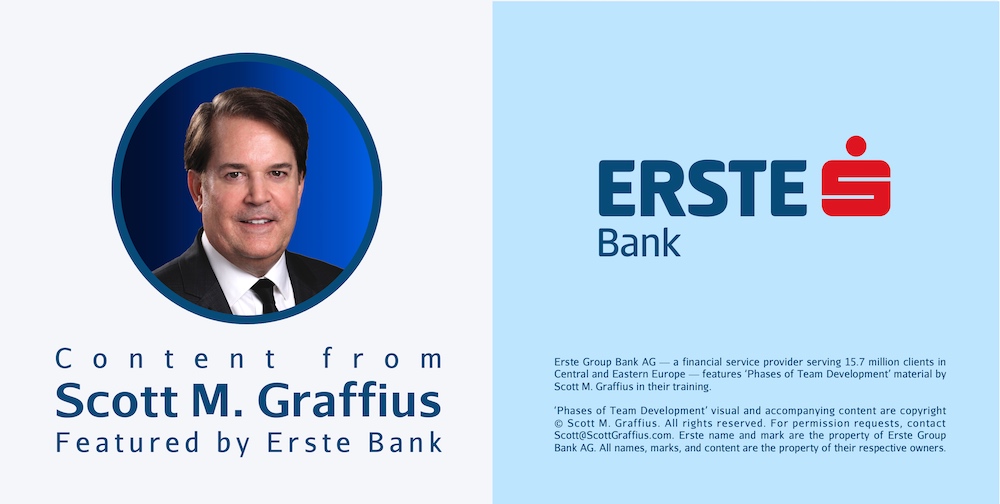
Select here to download a PDF of this article.
Erste Group Bank AG — a financial service provider serving 15.7 million clients in Central and Eastern Europe — featured Scott M. Graffius' Phases of Team Development material in their training.
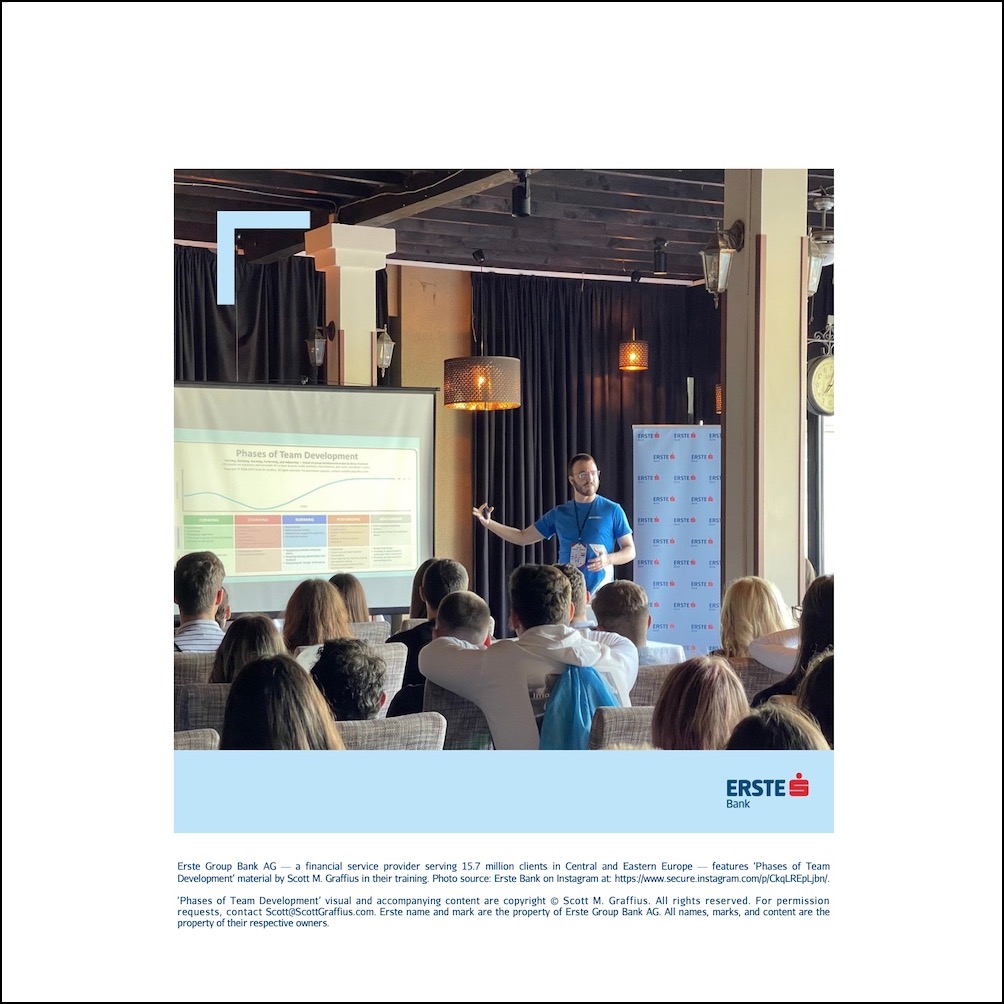
The picture above shows Erste Bank using Graffius' Phases of Team Development material at their training session.
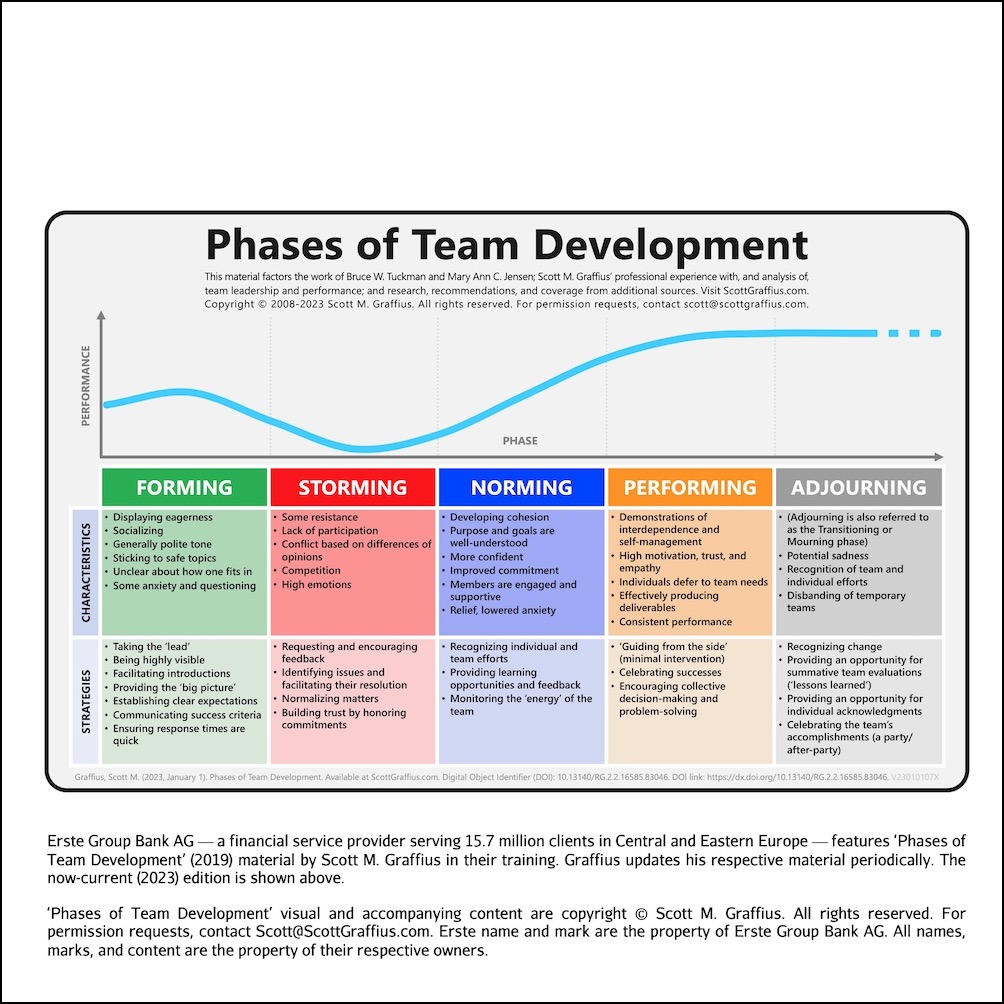
Erste Bank used the 2019 edition of the Phases of Team Development visual at their session. Graffius periodically updates this respective material. The image above shows the now-current (2023) edition of the Phases of Team Development visual.



About Scott M. Graffius

Scott M. Graffius, PMP, SA, CSP-SM, CSP-PO, CSM, CSPO, SFE, ITIL, LSSGB is an agile project management practitioner, consultant, multi-award-winning author, and international keynote speaker. He is the Founder of Exceptional PPM and PMO Solutions™ and subsidiary Exceptional Agility™. He has generated over $1.9 billion of business value in aggregate for Global Fortune 500 businesses and other organizations he has served. Graffius and content from his books, talks, workshops, and more have been featured and used by businesses, professional associations, governments, and universities. Examples include Microsoft, Oracle, Broadcom, Cisco, Gartner, Project Management Institute, IEEE, Qantas, National Academy of Sciences, United States Department of Energy, New Zealand Ministry of Education, Yale University, Tufts University, and others. He has delighted audiences with dynamic and engaging talks and workshops on agile, project management, and technology (including AI) leadership at 87 conferences and other events across 25 countries.
His full bio is available here.
Connect with Scott on:


About Agile Scrum: Your Quick Start Guide with Step-by-Step Instructions

Shifting customer needs are common in today's marketplace. Businesses must be adaptive and responsive to change while delivering an exceptional customer experience to be competitive.
There are a variety of frameworks supporting the development of products and services, and most approaches fall into one of two broad categories: traditional or agile. Traditional practices such as waterfall engage sequential development, while agile involves iterative and incremental deliverables. Organizations are increasingly embracing agile to manage projects, and best meet their business needs of rapid response to change, fast delivery speed, and more.
With clear and easy to follow instructions, the multi award-winning Agile Scrum: Your Quick Start Guide with Step-by-Step Instructions book by Scott M. Graffius (Chris Hare and Colin Giffen, Technical Editors) helps the reader:
- Implement and use the most popular agile framework―Scrum;
- Deliver products in short cycles with rapid adaptation to change, fast time-to-market, and continuous improvement; and
- Support innovation and drive competitive advantage.
Hailed by Literary Titan as “the book highlights the versatility of Scrum beautifully.”
Winner of 17 first place awards.
Agile Scrum: Your Quick Start Guide with Step-by-Step Instructions is available in paperback and ebook/Kindle in the United States and around the world. Some links by country follow.
- 🇧🇷 Brazil
- 🇨🇦 Canada
- 🇨🇿 Czech Republic
- 🇩🇰 Denmark
- 🇫🇮 Finland
- 🇫🇷 France
- 🇩🇪 Germany
- 🇬🇷 Greece
- 🇭🇺 Hungary
- 🇮🇳 India
- 🇮🇪 Ireland
- 🇮🇱 Israel
- 🇮🇹 Italy
- 🇯🇵 Japan
- 🇱🇺 Luxembourg
- 🇲🇽 Mexico
- 🇳🇱 Netherlands
- 🇳🇿 New Zealand
- 🇳🇴 Norway
- 🇪🇸 Spain
- 🇸🇪 Sweden
- 🇨🇭 Switzerland
- 🇦🇪 UAE
- 🇬🇧 United Kingdom
- 🇺🇸 United States

About Agile Transformation: A Brief Story of How an Entertainment Company Developed New Capabilities and Unlocked Business Agility to Thrive in an Era of Rapid Change

Thriving in today's marketplace frequently depends on making a transformation to become more agile. Those successful in the transition enjoy faster delivery speed and ROI, higher satisfaction, continuous improvement, and additional benefits.
Based on actual events, Agile Transformation: A Brief Story of How an Entertainment Company Developed New Capabilities and Unlocked Business Agility to Thrive in an Era of Rapid Change provides a quick (60-90 minute) read about a successful agile transformation at a multinational entertainment and media company, told from the author's perspective as an agile coach.
The award-winning book by Scott M. Graffius is available in paperback and ebook/Kindle in the United States and around the world. Some links by country follow.
- 🇦🇺 Australia
- 🇦🇹 Austria
- 🇧🇷 Brazil
- 🇨🇦 Canada
- 🇨🇿 Czech Republic
- 🇩🇰 Denmark
- 🇫🇮 Finland
- 🇫🇷 France
- 🇩🇪 Germany
- 🇬🇷 Greece
- 🇮🇳 India
- 🇮🇪 Ireland
- 🇯🇵 Japan
- 🇱🇺 Luxembourg
- 🇲🇽 Mexico
- 🇳🇱 Netherlands
- 🇳🇿 New Zealand
- 🇪🇸 Spain
- 🇸🇪 Sweden
- 🇨🇭 Switzerland
- 🇦🇪 United Arab Emirates
- 🇬🇧 United Kingdom
- 🇺🇸 United States

The short URL for this article is: https://bit.ly/erste-2023
© Copyright 2023 Scott M. Graffius. All rights reserved. This material may not be published, broadcast, rewritten or redistributed without the express written permission of Scott M. Graffius.

Successful Video Game Development Teams Leverage an Extensive Range of Hard Skills and Soft Skills
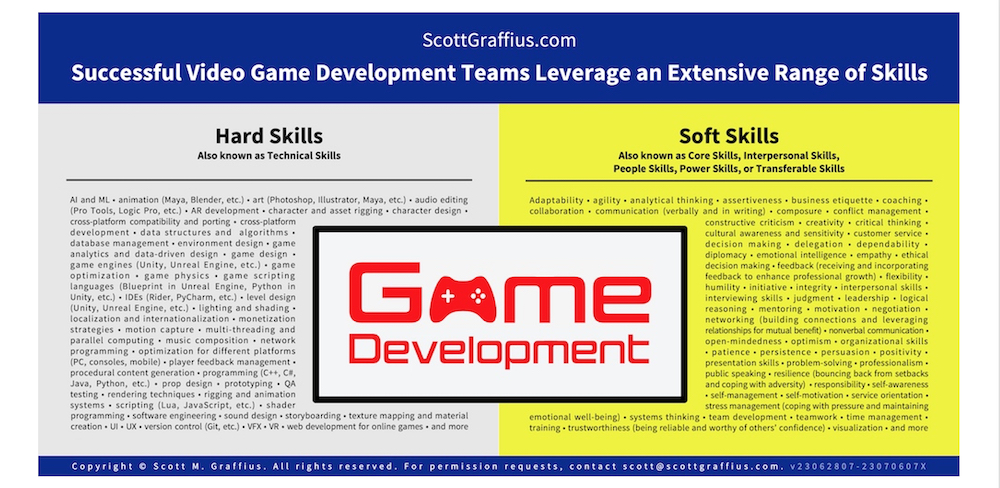
Select here to download a PDF of this article.
Behind every great video game is a team of creative and technical wizards. Creators, storytellers, designers, artists, developers, testers, and others collaborate and leverage a diverse range of hard skills (also known as technical skills) and soft skills (also known as interpersonal skills) to craft an exceptional end-product.
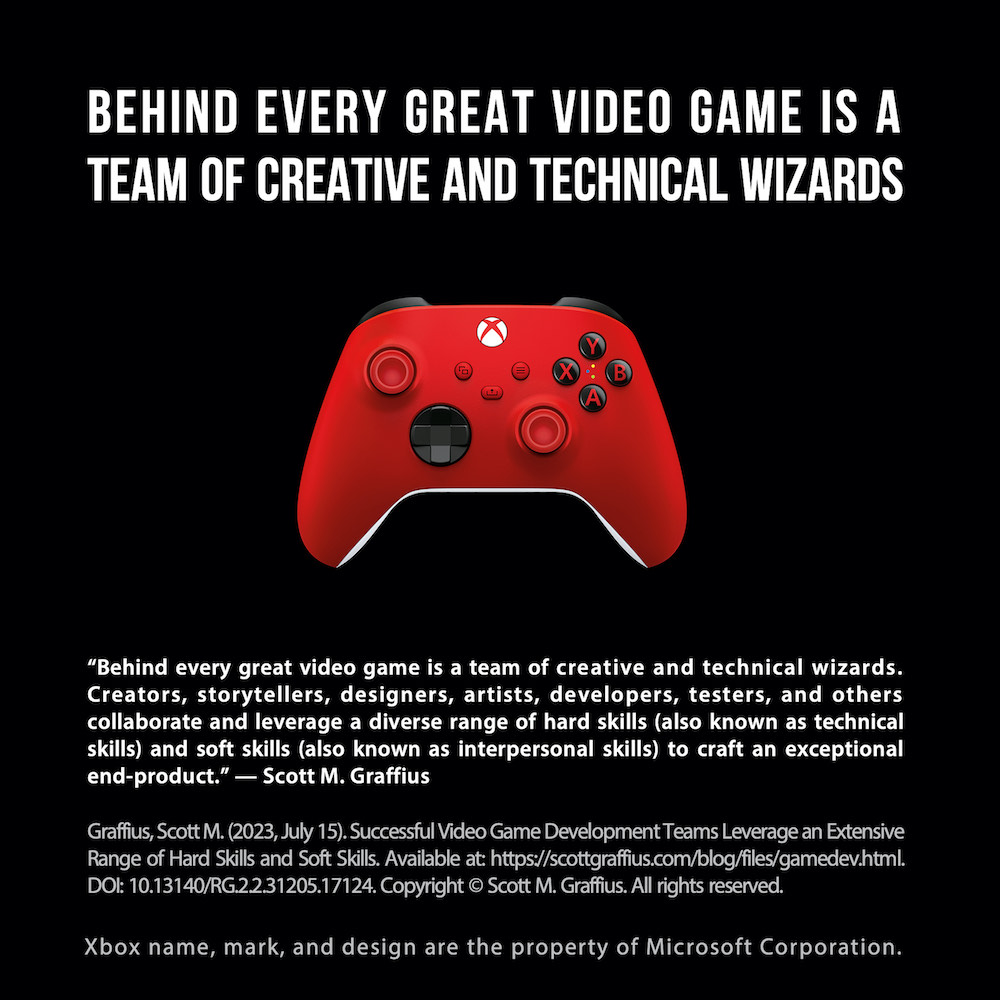
Here's a select listing of hard skills for video game development teams:
- Artificial intelligence (AI) and machine learning (ML)
- Animation (Maya, Blender, etc.)
- Art (Photoshop, Illustrator, Maya, etc.)
- Audio editing (Pro Tools, Logic Pro, etc.)
- Augmented Reality (AR) development
- Character and asset rigging
- Character design
- Cross-platform compatibility and porting
- Cross-platform development
- Data structures and algorithms
- Database management
- Environment design
- Game analytics and data-driven design
- Game design
- Game engines (Unity, Unreal Engine, etc.)
- Game optimization
- Game physics
- Game scripting languages (Blueprint in Unreal Engine, Python in Unity, etc.)
- Integrated development environment (IDE) (Rider, PyCharm, etc.)
- Level design (Unity, Unreal Engine, etc.)
- Lighting and shading
- Localization and internationalization
- Monetization strategies
- Motion capture
- Multi-threading and parallel computing
- Music composition
- Network programming
- Optimization for different platforms (consoles, PCs, mobile, AR, VR, smart TVs, streaming devices)
- Player feedback management
- Procedural content generation
- Programming (C++, C#, Java, Python, etc.)
- Prop design
- Prototyping
- Quality assurance (QA) testing
- Rendering techniques
- Rigging and animation systems
- Scripting (Lua, JavaScript, etc.)
- Shader programming
- Software engineering
- Sound design
- Storyboarding
- Texture mapping and material creation
- User interface (UI)
- User experience (UX)
- Version control (Git, etc.)
- Visual effects (VFX)
- Virtual reality (VR)
- Web development for online games
- and more
And here's a select listing of soft skills for video game development teams:
- Adaptability
- Agility
- Analytical thinking
- Assertiveness
- Business etiquette
- Coaching
- Collaboration
- Communication (verbally and in writing)
- Composure
- Conflict management
- Constructive criticism
- Creativity
- Critical thinking
- Cultural awareness and sensitivity
- Customer service
- Decision making
- Delegation
- Dependability
- Diplomacy
- Emotional intelligence
- Empathy
- Ethical decision making
- Feedback (receiving and incorporating feedback to enhance professional growth)
- Flexibility
- Humility
- Initiative
- Integrity
- Interpersonal skills
- Interviewing skills
- Judgment
- Leadership
- Logical reasoning
- Mentoring
- Motivation
- Negotiation
- Networking (building connections and leveraging relationships for mutual benefit)
- Nonverbal communication
- Open-mindedness
- Optimism
- Organizational skills
- Patience
- Persistence
- Persuasion
- Positivity
- Presentation skills
- Problem-solving
- Professionalism
- Public speaking
- Resilience (bouncing back from setbacks and coping with adversity)
- Responsibility
- Self-awareness
- Self-management
- Self-motivation
- Service orientation
- Stress management (coping with pressure and maintaining emotional well-being)
- Systems thinking
- Team development
- Teamwork
- Time management
- Training
- Trustworthiness (being reliable and worthy of others’ confidence)
- Visualization
- and more
Of the many skills, one — a soft skill — is paramount. Activision Blizzard and other premiere developers and publishers of entertainment experiences identify teamwork as critical for the successful development of video games.
Informed by Scott M. Graffius’s first-hand work with game development teams as well as research and coverage from Activision Blizzard, Gameloft, International Game Developers Association, Microsoft, Rockstar Games, Sony Interactive Entertainment, and others, Graffius delivers a deep-dive on the essential teamwork skill based on the science of high-performing teams to audiences at game development conferences and other events. The information can provide attendees, their teams, and their organization with a competitive advantage!
Invited by conferences, businesses, professional organizations, governments, and universities, Graffius delivers talks and workshops on Agile, project management, and technology leadership — inclusive of AI, GameDev, TeamDev, and more. To date, he's delivered 87 sessions across 25 countries. Visit here for details on his upcoming and prior sessions.

How to Cite This Article
Graffius, Scott M. (2023, July 15). Successful Video Game Development Teams Leverage an Extensive Range of Hard Skills and Soft Skills. Available at: https://scottgraffius.com/blog/files/gamedev.html. DOI: 10.13140/RG.2.2.31205.17124.

Permission Request Information
To request permission to use material from this article, email Scott M. Graffius.



About Scott M. Graffius
Scott M. Graffius, PMP, SA, CSP-SM, CSP-PO, CSM, CSPO, SFE, ITIL, LSSGB is an agile project management practitioner, consultant, multi-award-winning author, and international keynote speaker. He is the Founder of Exceptional PPM and PMO Solutions™ and subsidiary Exceptional Agility™. He has generated over $1.9 billion of business value in aggregate for Global Fortune 500 businesses and other organizations he has served. Graffius and content from his books, talks, workshops, and more have been featured and used by businesses, professional associations, governments, and universities. Examples include Microsoft, Oracle, Broadcom, Cisco, Gartner, Project Management Institute, IEEE, Qantas, National Academy of Sciences, United States Department of Energy, New Zealand Ministry of Education, Yale University, Tufts University, and others. He has delighted audiences with dynamic and engaging talks and workshops on agile, project management, and technology (including AI, GameDev, and more) leadership at 87 conferences and other events across 25 countries.
His full bio is available here.
Connect with Scott on:


About Agile Scrum: Your Quick Start Guide with Step-by-Step Instructions

Shifting customer needs are common in today's marketplace. Businesses must be adaptive and responsive to change while delivering an exceptional customer experience to be competitive.
There are a variety of frameworks supporting the development of products and services, and most approaches fall into one of two broad categories: traditional or agile. Traditional practices such as waterfall engage sequential development, while agile involves iterative and incremental deliverables. Organizations are increasingly embracing agile to manage projects, and best meet their business needs of rapid response to change, fast delivery speed, and more.
With clear and easy to follow instructions, the multi award-winning Agile Scrum: Your Quick Start Guide with Step-by-Step Instructions book by Scott M. Graffius (Chris Hare and Colin Giffen, Technical Editors) helps the reader:
- Implement and use the most popular agile framework―Scrum;
- Deliver products in short cycles with rapid adaptation to change, fast time-to-market, and continuous improvement; and
- Support innovation and drive competitive advantage.
Hailed by Literary Titan as “the book highlights the versatility of Scrum beautifully.”
Winner of 17 first place awards.
Agile Scrum: Your Quick Start Guide with Step-by-Step Instructions is available in paperback and ebook/Kindle in the United States and around the world. Some links by country follow.
- 🇧🇷 Brazil
- 🇨🇦 Canada
- 🇨🇿 Czech Republic
- 🇩🇰 Denmark
- 🇫🇮 Finland
- 🇫🇷 France
- 🇩🇪 Germany
- 🇬🇷 Greece
- 🇭🇺 Hungary
- 🇮🇳 India
- 🇮🇪 Ireland
- 🇮🇱 Israel
- 🇮🇹 Italy
- 🇯🇵 Japan
- 🇱🇺 Luxembourg
- 🇲🇽 Mexico
- 🇳🇱 Netherlands
- 🇳🇿 New Zealand
- 🇳🇴 Norway
- 🇪🇸 Spain
- 🇸🇪 Sweden
- 🇨🇭 Switzerland
- 🇦🇪 UAE
- 🇬🇧 United Kingdom
- 🇺🇸 United States

About Agile Transformation: A Brief Story of How an Entertainment Company Developed New Capabilities and Unlocked Business Agility to Thrive in an Era of Rapid Change

Thriving in today's marketplace frequently depends on making a transformation to become more agile. Those successful in the transition enjoy faster delivery speed and ROI, higher satisfaction, continuous improvement, and additional benefits.
Based on actual events, Agile Transformation: A Brief Story of How an Entertainment Company Developed New Capabilities and Unlocked Business Agility to Thrive in an Era of Rapid Change provides a quick (60-90 minute) read about a successful agile transformation at a multinational entertainment and media company, told from the author's perspective as an agile coach.
The award-winning book by Scott M. Graffius is available in paperback and ebook/Kindle in the United States and around the world. Some links by country follow.
- 🇦🇺 Australia
- 🇦🇹 Austria
- 🇧🇷 Brazil
- 🇨🇦 Canada
- 🇨🇿 Czech Republic
- 🇩🇰 Denmark
- 🇫🇮 Finland
- 🇫🇷 France
- 🇩🇪 Germany
- 🇬🇷 Greece
- 🇮🇳 India
- 🇮🇪 Ireland
- 🇯🇵 Japan
- 🇱🇺 Luxembourg
- 🇲🇽 Mexico
- 🇳🇱 Netherlands
- 🇳🇿 New Zealand
- 🇪🇸 Spain
- 🇸🇪 Sweden
- 🇨🇭 Switzerland
- 🇦🇪 United Arab Emirates
- 🇬🇧 United Kingdom
- 🇺🇸 United States

The short link for this article is: https://bit.ly/gamedev7
© Copyright 2023 Scott M. Graffius. All rights reserved. This material may not be published, broadcast, rewritten or redistributed without the express written permission of Scott M. Graffius.

Scott M. Graffius Speaking at Helsinki, Finland W Love Games 2023 Video Game Development Conference

Agile project management practitioner, consultant, multi-award-winning author, and international speaker Scott M. Graffius has delivered 87 talks and workshops at conferences and other events across 25 countries. His newest engagement will be at the W Love Games 2023 Conference in Helsinki, where he'll present “The Science of High-Performance Game Development Teams.”
Graffius’ talk is informed by his first-hand work with video game development teams as well as research and coverage from Activision Blizzard, Gameloft, International Game Developers Association, Microsoft, Rockstar Games, Sony Interactive Entertainment, and others. The information can provide attendees, their teams, and their organizations with a competitive advantage!
About the W Love Games 2023 International Game Development Conference
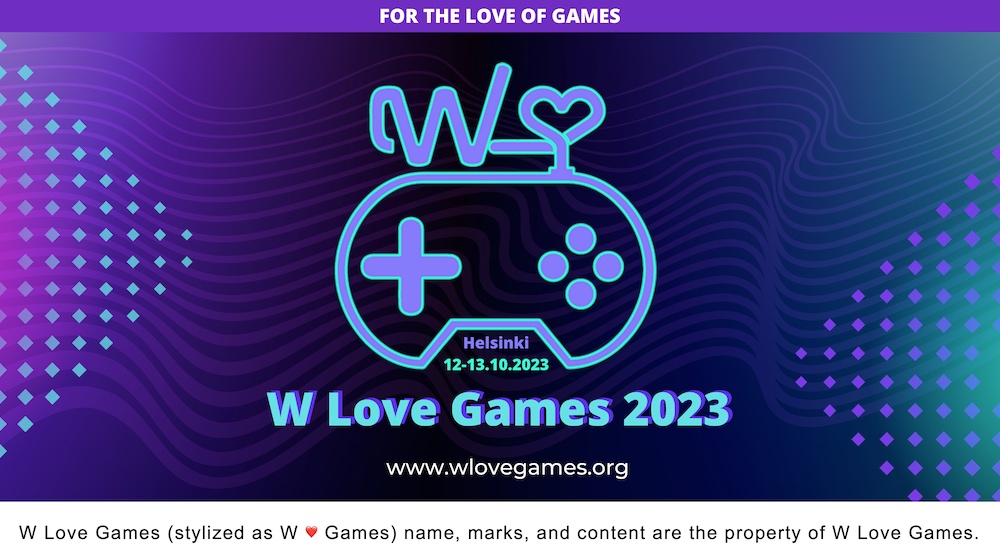
W Love Games 2023 includes:
💜 30+ speakers
🧡 6 workshops
💛 Showroom
💚 IGDA Finland Mentor Cafe
💙 Networking for all
The conference will run from October 12-13, 2023 at the Helsinki Public Library Oodi (in Finnish: Helsingin Keskustakirjasto Oodi) at Töölönlahdenkatu 4, 00100 Helsinki, Finland.
Secure your tickets for the conference at: https://www.wlovegames.org.



About Scott M. Graffius
Scott M. Graffius, PMP, SA, CSP-SM, CSP-PO, CSM, CSPO, SFE, ITIL, LSSGB is an agile project management practitioner, consultant, multi-award-winning author, and international keynote speaker. He is the Founder of Exceptional PPM and PMO Solutions™ and subsidiary Exceptional Agility™. He has generated over $1.9 billion of business value in aggregate for Global Fortune 500 businesses and other organizations he has served. Graffius and content from his books, talks, workshops, and more have been featured and used by businesses, professional associations, governments, and universities. Examples include Microsoft, Oracle, Broadcom, Cisco, Gartner, Project Management Institute, IEEE, Qantas, National Academy of Sciences, United States Department of Energy, New Zealand Ministry of Education, Yale University, Tufts University, and others. He has delighted audiences with dynamic and engaging talks and workshops on agile, project management, and technology (including AI, GameDev, and more) leadership at 87 conferences and other events across 25 countries.
His full bio is available here.
Connect with Scott on:


About Agile Scrum: Your Quick Start Guide with Step-by-Step Instructions

Shifting customer needs are common in today's marketplace. Businesses must be adaptive and responsive to change while delivering an exceptional customer experience to be competitive.
There are a variety of frameworks supporting the development of products and services, and most approaches fall into one of two broad categories: traditional or agile. Traditional practices such as waterfall engage sequential development, while agile involves iterative and incremental deliverables. Organizations are increasingly embracing agile to manage projects, and best meet their business needs of rapid response to change, fast delivery speed, and more.
With clear and easy to follow instructions, the multi award-winning Agile Scrum: Your Quick Start Guide with Step-by-Step Instructions book by Scott M. Graffius (Chris Hare and Colin Giffen, Technical Editors) helps the reader:
- Implement and use the most popular agile framework―Scrum;
- Deliver products in short cycles with rapid adaptation to change, fast time-to-market, and continuous improvement; and
- Support innovation and drive competitive advantage.
Hailed by Literary Titan as “the book highlights the versatility of Scrum beautifully.”
Winner of 17 first place awards.
Agile Scrum: Your Quick Start Guide with Step-by-Step Instructions is available in paperback and ebook/Kindle in the United States and around the world. Some links by country follow.
- 🇧🇷 Brazil
- 🇨🇦 Canada
- 🇨🇿 Czech Republic
- 🇩🇰 Denmark
- 🇫🇮 Finland
- 🇫🇷 France
- 🇩🇪 Germany
- 🇬🇷 Greece
- 🇭🇺 Hungary
- 🇮🇳 India
- 🇮🇪 Ireland
- 🇮🇱 Israel
- 🇮🇹 Italy
- 🇯🇵 Japan
- 🇱🇺 Luxembourg
- 🇲🇽 Mexico
- 🇳🇱 Netherlands
- 🇳🇿 New Zealand
- 🇳🇴 Norway
- 🇪🇸 Spain
- 🇸🇪 Sweden
- 🇨🇭 Switzerland
- 🇦🇪 UAE
- 🇬🇧 United Kingdom
- 🇺🇸 United States

About Agile Transformation: A Brief Story of How an Entertainment Company Developed New Capabilities and Unlocked Business Agility to Thrive in an Era of Rapid Change

Thriving in today's marketplace frequently depends on making a transformation to become more agile. Those successful in the transition enjoy faster delivery speed and ROI, higher satisfaction, continuous improvement, and additional benefits.
Based on actual events, Agile Transformation: A Brief Story of How an Entertainment Company Developed New Capabilities and Unlocked Business Agility to Thrive in an Era of Rapid Change provides a quick (60-90 minute) read about a successful agile transformation at a multinational entertainment and media company, told from the author's perspective as an agile coach.
The award-winning book by Scott M. Graffius is available in paperback and ebook/Kindle in the United States and around the world. Some links by country follow.
- 🇦🇺 Australia
- 🇦🇹 Austria
- 🇧🇷 Brazil
- 🇨🇦 Canada
- 🇨🇿 Czech Republic
- 🇩🇰 Denmark
- 🇫🇮 Finland
- 🇫🇷 France
- 🇩🇪 Germany
- 🇬🇷 Greece
- 🇮🇳 India
- 🇮🇪 Ireland
- 🇯🇵 Japan
- 🇱🇺 Luxembourg
- 🇲🇽 Mexico
- 🇳🇱 Netherlands
- 🇳🇿 New Zealand
- 🇪🇸 Spain
- 🇸🇪 Sweden
- 🇨🇭 Switzerland
- 🇦🇪 United Arab Emirates
- 🇬🇧 United Kingdom
- 🇺🇸 United States

The short link for this article is: https://bit.ly/wlg-23
© Copyright 2023 Scott M. Graffius. All rights reserved. This material may not be published, broadcast, rewritten or redistributed without the express written permission of Scott M. Graffius.

National Park Service Features Scott M. Graffius' 'Phases of Team Development'
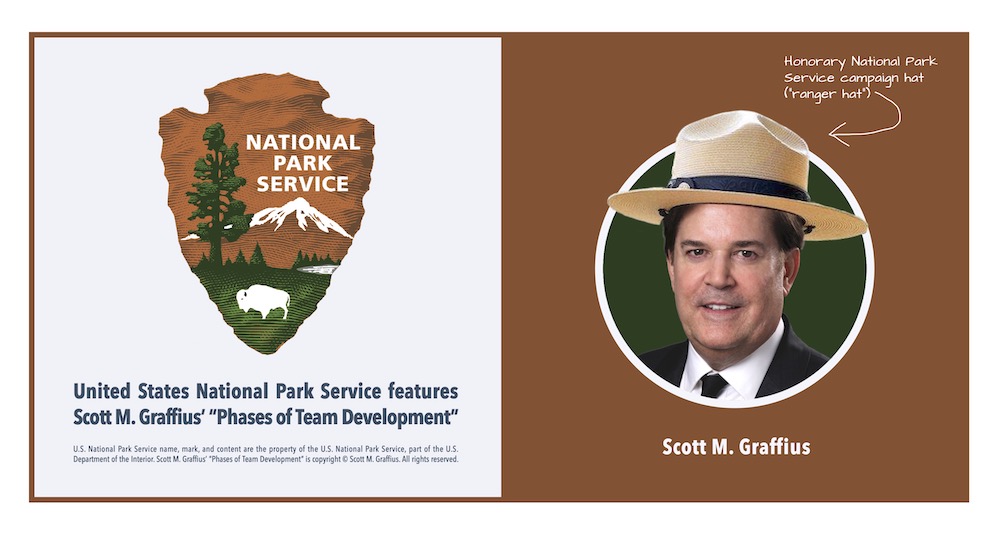
Select here to download a PDF of this article.
The National Park Service (NPS), part of the United States Department of the Interior, included Scott M. Graffius' ‘Phases of Team Development’ work in their newsletter. Highlights follow.
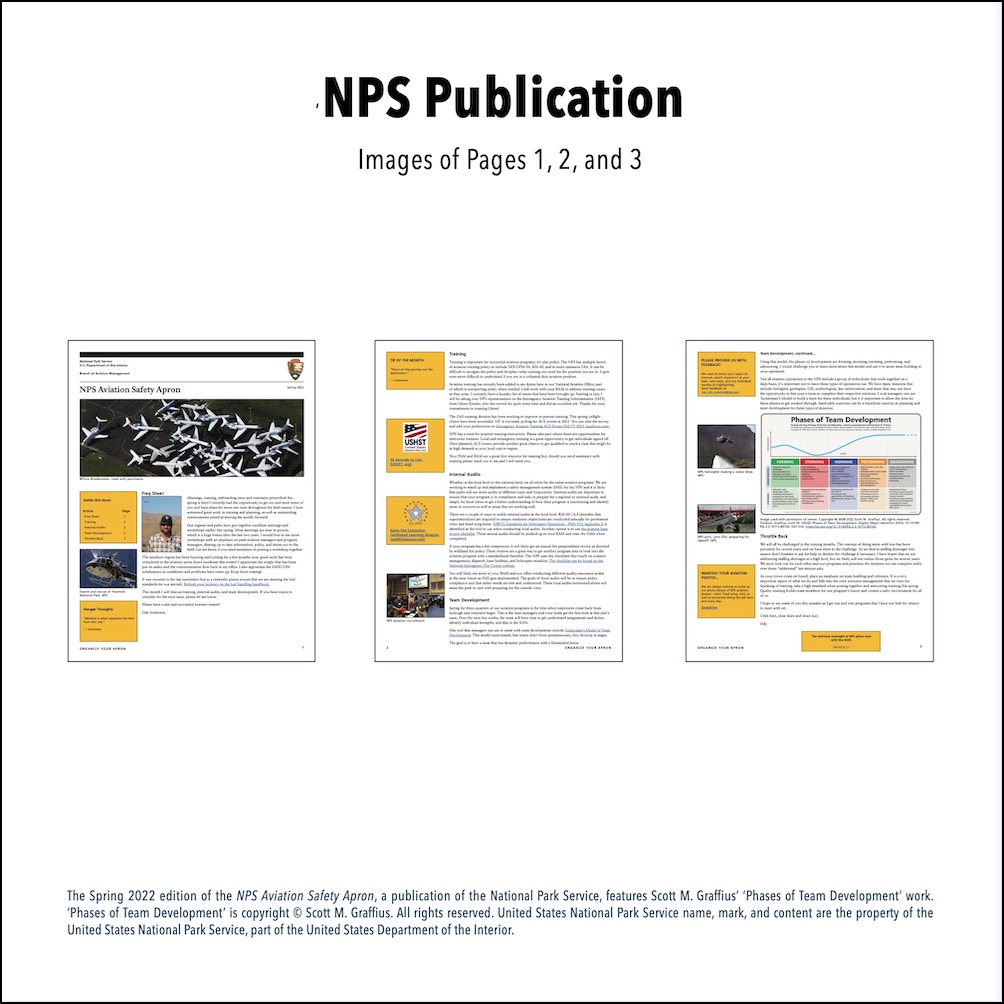
The above visual provides an overview of pages 1, 2, and 3 of the NPS publication.
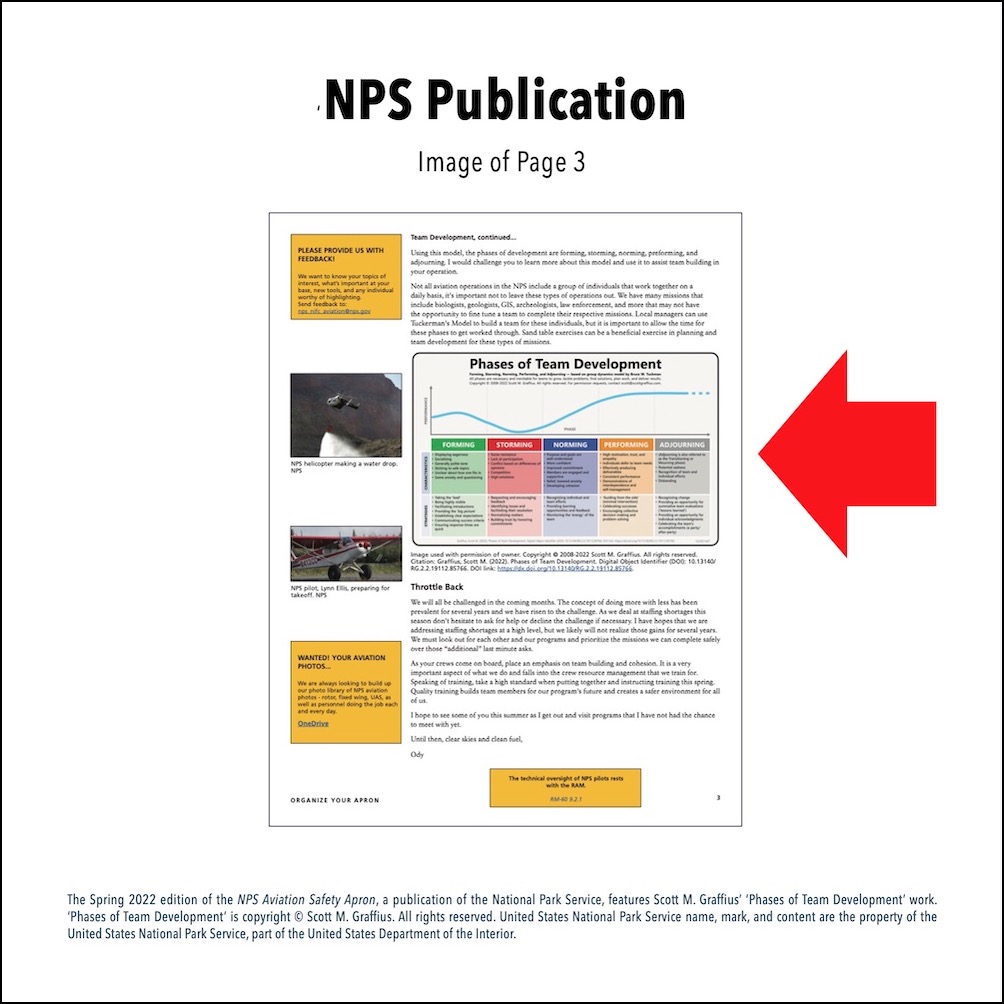
The above visual provides a singular view of page 3 of the NPS publication. The red arrow points to Graffius' 'Phases of Team Development.'
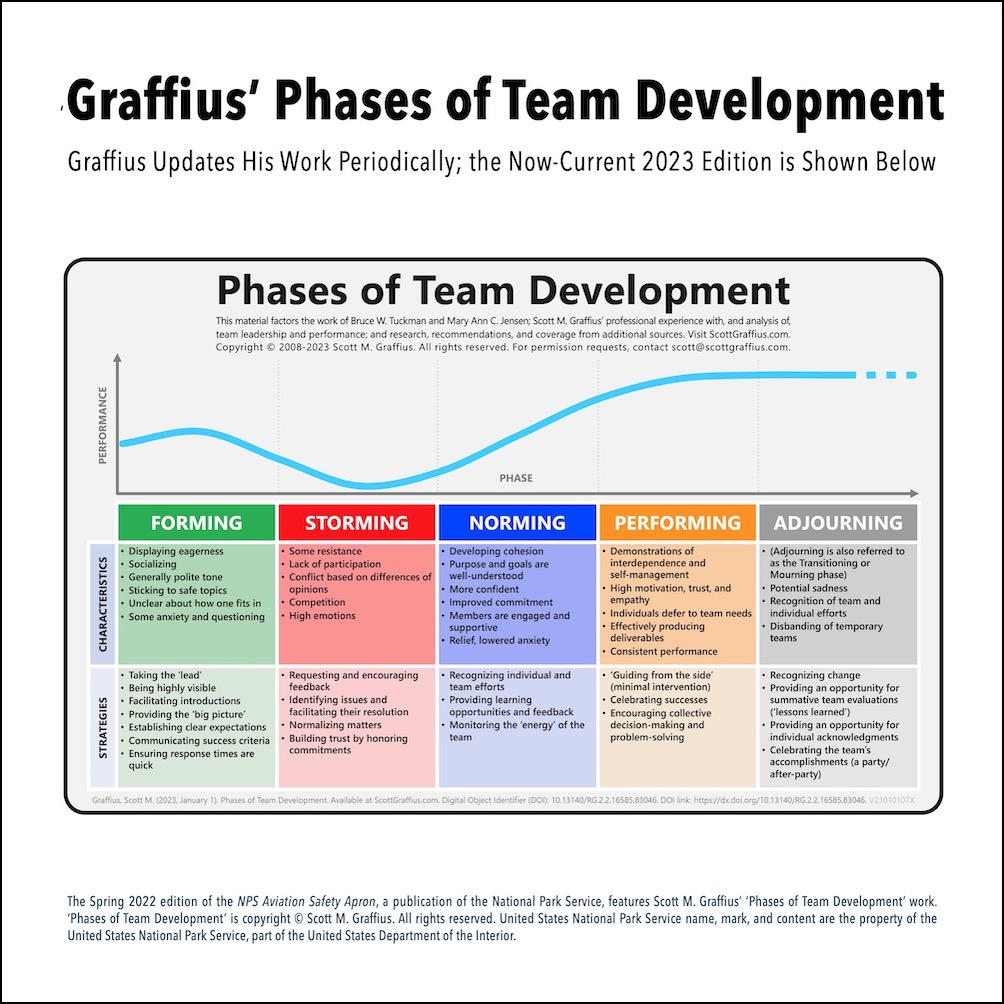
Graffius periodically updates his 'Phases of Team Development' work. The visual above shows the now-current (2023) edition of his work.
About Scott M. Graffius' 'Phases of Team Development'
Informed by the research of Bruce W. Tuckman and Mary Ann C. Jensen, over 100 subsequent studies, and Scott M. Graffius' first-hand professional experience with, and analysis of, team leadership and performance, Graffius created his ‘Phases of Team Development’ as a unique perspective and visual conveying the five phases of team development — Forming, Storming, Norming, Performing, and Adjourning — inclusive of a graph showing how performance varies by phase, as well as the characteristics and strategies for each phase.
With permission/a license from Graffius, his 'Phases of Team Development' work is used by businesses, professional associations, governments, and universities around the world. For more on my ‘Phases of Team Development,’ visit https://bit.ly/teams-2023.
About the National Park Service
The National Park Service (NPS) is an agency of the United States federal government within the U.S. Department of the Interior that manages all national parks, most national monuments, and other natural, historical, and recreational properties with various title designations. The U.S. Congress created the agency on August 25, 1916, through the National Park Service Organic Act. The NPS is headquartered in Washington, D.C., within the main headquarters of the Department of the Interior.
The NPS employs approximately 20,000 people in 425 individual units covering over 85 million acres in all 50 states, the District of Columbia, and U.S. territories. As of 2019, they had more than 279,000 volunteers. The agency is charged with a dual role of preserving the ecological and historical integrity of the places entrusted to its management while also making them available and accessible for public use and enjoyment.
Its mission statement is: “The National Park Service preserves unimpaired the natural and cultural resources and values of the National Park System for the enjoyment, education, and inspiration of this and future generations. The National Park Service cooperates with partners to extend the benefits of natural and cultural resource conservation and outdoor recreation throughout this country and the world.” Source: https://www.nps.gov/aboutus/index.htm.



About Scott M. Graffius

Scott M. Graffius, PMP, SA, CSP-SM, CSP-PO, CSM, CSPO, SFE, ITIL, LSSGB is an agile project management practitioner, consultant, multi-award-winning author, and international keynote speaker. He is the Founder of Exceptional PPM and PMO Solutions™ and subsidiary Exceptional Agility™. He has generated over $1.9 billion of business value in aggregate for Global Fortune 500 businesses and other organizations he has served. Graffius and content from his books, talks, workshops, and more have been featured and used by businesses, professional associations, governments, and universities. Examples include Microsoft, Oracle, Broadcom, Cisco, Gartner, Project Management Institute, IEEE, Qantas, National Academy of Sciences, United States Department of Energy, New Zealand Ministry of Education, Yale University, Tufts University, and others. He has delighted audiences with dynamic and engaging talks and workshops on agile, project management, and technology (including AI) leadership at 87 conferences and other events across 25 countries.
His full bio is available here.
Connect with Scott on:


About Agile Scrum: Your Quick Start Guide with Step-by-Step Instructions

Shifting customer needs are common in today's marketplace. Businesses must be adaptive and responsive to change while delivering an exceptional customer experience to be competitive.
There are a variety of frameworks supporting the development of products and services, and most approaches fall into one of two broad categories: traditional or agile. Traditional practices such as waterfall engage sequential development, while agile involves iterative and incremental deliverables. Organizations are increasingly embracing agile to manage projects, and best meet their business needs of rapid response to change, fast delivery speed, and more.
With clear and easy to follow instructions, the multi award-winning Agile Scrum: Your Quick Start Guide with Step-by-Step Instructions book by Scott M. Graffius (Chris Hare and Colin Giffen, Technical Editors) helps the reader:
- Implement and use the most popular agile framework―Scrum;
- Deliver products in short cycles with rapid adaptation to change, fast time-to-market, and continuous improvement; and
- Support innovation and drive competitive advantage.
Hailed by Literary Titan as “the book highlights the versatility of Scrum beautifully.”
Winner of 17 first place awards.
Agile Scrum: Your Quick Start Guide with Step-by-Step Instructions is available in paperback and ebook/Kindle in the United States and around the world. Some links by country follow.
- 🇧🇷 Brazil
- 🇨🇦 Canada
- 🇨🇿 Czech Republic
- 🇩🇰 Denmark
- 🇫🇮 Finland
- 🇫🇷 France
- 🇩🇪 Germany
- 🇬🇷 Greece
- 🇭🇺 Hungary
- 🇮🇳 India
- 🇮🇪 Ireland
- 🇮🇱 Israel
- 🇮🇹 Italy
- 🇯🇵 Japan
- 🇱🇺 Luxembourg
- 🇲🇽 Mexico
- 🇳🇱 Netherlands
- 🇳🇿 New Zealand
- 🇳🇴 Norway
- 🇪🇸 Spain
- 🇸🇪 Sweden
- 🇨🇭 Switzerland
- 🇦🇪 UAE
- 🇬🇧 United Kingdom
- 🇺🇸 United States

About Agile Transformation: A Brief Story of How an Entertainment Company Developed New Capabilities and Unlocked Business Agility to Thrive in an Era of Rapid Change

Thriving in today's marketplace frequently depends on making a transformation to become more agile. Those successful in the transition enjoy faster delivery speed and ROI, higher satisfaction, continuous improvement, and additional benefits.
Based on actual events, Agile Transformation: A Brief Story of How an Entertainment Company Developed New Capabilities and Unlocked Business Agility to Thrive in an Era of Rapid Change provides a quick (60-90 minute) read about a successful agile transformation at a multinational entertainment and media company, told from the author's perspective as an agile coach.
The award-winning book by Scott M. Graffius is available in paperback and ebook/Kindle in the United States and around the world. Some links by country follow.
- 🇦🇺 Australia
- 🇦🇹 Austria
- 🇧🇷 Brazil
- 🇨🇦 Canada
- 🇨🇿 Czech Republic
- 🇩🇰 Denmark
- 🇫🇮 Finland
- 🇫🇷 France
- 🇩🇪 Germany
- 🇬🇷 Greece
- 🇮🇳 India
- 🇮🇪 Ireland
- 🇯🇵 Japan
- 🇱🇺 Luxembourg
- 🇲🇽 Mexico
- 🇳🇱 Netherlands
- 🇳🇿 New Zealand
- 🇪🇸 Spain
- 🇸🇪 Sweden
- 🇨🇭 Switzerland
- 🇦🇪 United Arab Emirates
- 🇬🇧 United Kingdom
- 🇺🇸 United States

The short URL for this article is: https://bit.ly/nps-23.
© Copyright 2023 Scott M. Graffius. All rights reserved. This material may not be published, broadcast, rewritten or redistributed without the express written permission of Scott M. Graffius.

Aerospace Company Deimos Space Featured Scott M. Graffius' 'Phases of Team Development' Work

Informed by the research of Bruce W. Tuckman and Mary Ann C. Jensen, over 100 subsequent studies, and Scott M. Graffius' first-hand professional experience with, and analysis of, team leadership and performance, Graffius created his ‘Phases of Team Development’ as a unique perspective and visual conveying the five phases of team development — Forming, Storming, Norming, Performing, and Adjourning — inclusive of a graph showing how performance varies by phase, as well as the characteristics and strategies for each phase.
With permission/a license from Graffius, his ‘Phases of Team Development’ work is used by businesses, professional associations, governments, and universities around the world. Examples include Yale University, IEEE, Torrens University Australia, UK Sports Institute, Adobe, Amsterdam Public Health Research Institute, Academic Cooperation Association, Boston University, U.S. National Park Service, Bayer, Hasso Plattner Institute (Hasso-Plattner-Institut für Digital Engineering GmbH), Singapore University of Social Sciences, New Zealand Government, University of Galway Ireland, and many more.
Deimos Space, a leading Aerospace company, was added to the list.
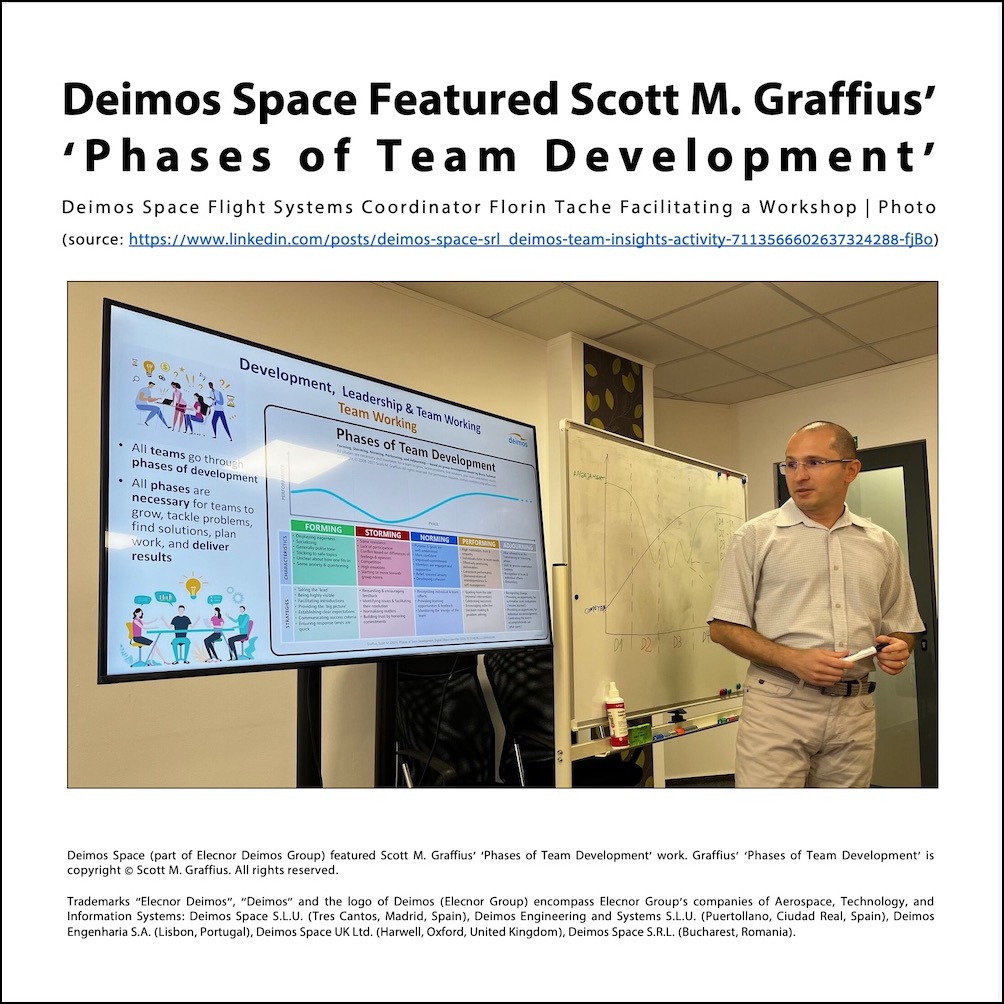
As shown above, Deimos Space featured Scott M. Graffius' 'Phases of Team Development' work during a training.
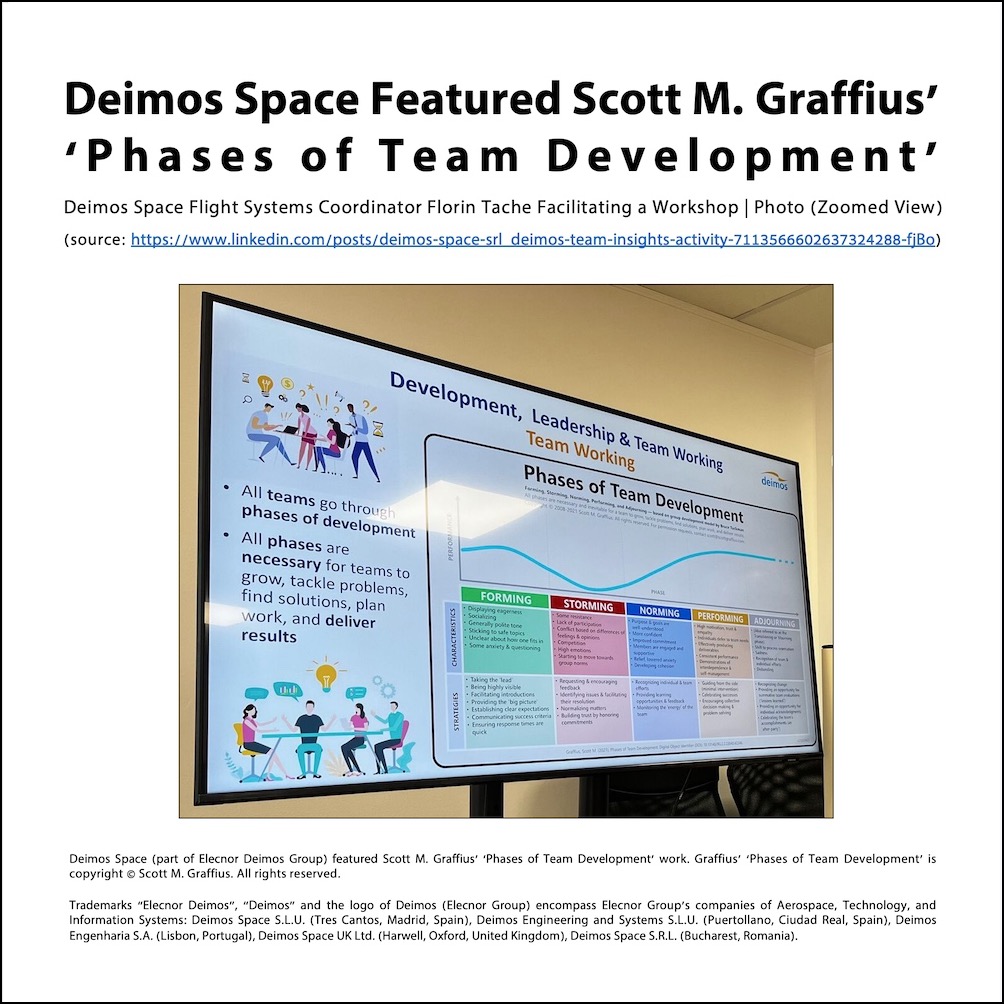
A zoomed-in version of the photo is shown above.

Graffius periodically updates his work. The most current (2023) edition of his 'Phases of Team Development' visual is shown above. Select here for details.
About Deimos Space
Deimos Space (part of Elecnor Deimos Group) is a leading company in the European Aerospace sector with an extensive portfolio of projects and solutions employed at the European Space Agency (ESA) and other organizations. Its expertise includes Satellite Navigation Systems, Space Situational Awareness, Mission Analysis and Design, Guidance Navigation and Control, Ground Segment Systems, and more. Visit their website — here — to learn more.




About Scott M. Graffius

Scott M. Graffius, PMP, SA, CSP-SM, CSP-PO, CSM, CSPO, SFE, ITIL, LSSGB is an agile project management practitioner, consultant, multi-award-winning author, and international keynote speaker. He is the Founder of Exceptional PPM and PMO Solutions™ and subsidiary Exceptional Agility™. He has generated over $1.9 billion of business value in aggregate for Global Fortune 500 businesses and other organizations he has served. Graffius and content from his books, talks, workshops, and more have been featured and used by businesses, professional associations, governments, and universities. Examples include Microsoft, Oracle, Broadcom, Cisco, Gartner, Project Management Institute, IEEE, Qantas, National Academy of Sciences, United States Department of Energy, New Zealand Ministry of Education, Yale University, Tufts University, and others. He has delighted audiences with dynamic and engaging talks and workshops on agile, project management, and technology (including AI) leadership at 87 conferences and other events across 25 countries.
His full bio is available here.
Connect with Scott on:


About Agile Scrum: Your Quick Start Guide with Step-by-Step Instructions

Shifting customer needs are common in today's marketplace. Businesses must be adaptive and responsive to change while delivering an exceptional customer experience to be competitive.
There are a variety of frameworks supporting the development of products and services, and most approaches fall into one of two broad categories: traditional or agile. Traditional practices such as waterfall engage sequential development, while agile involves iterative and incremental deliverables. Organizations are increasingly embracing agile to manage projects, and best meet their business needs of rapid response to change, fast delivery speed, and more.
With clear and easy to follow instructions, the multi award-winning Agile Scrum: Your Quick Start Guide with Step-by-Step Instructions book by Scott M. Graffius (Chris Hare and Colin Giffen, Technical Editors) helps the reader:
- Implement and use the most popular agile framework―Scrum;
- Deliver products in short cycles with rapid adaptation to change, fast time-to-market, and continuous improvement; and
- Support innovation and drive competitive advantage.
Hailed by Literary Titan as “the book highlights the versatility of Scrum beautifully.”
Winner of 17 first place awards.
Agile Scrum: Your Quick Start Guide with Step-by-Step Instructions is available in paperback and ebook/Kindle in the United States and around the world. Some links by country follow.
- 🇧🇷 Brazil
- 🇨🇦 Canada
- 🇨🇿 Czech Republic
- 🇩🇰 Denmark
- 🇫🇮 Finland
- 🇫🇷 France
- 🇩🇪 Germany
- 🇬🇷 Greece
- 🇭🇺 Hungary
- 🇮🇳 India
- 🇮🇪 Ireland
- 🇮🇱 Israel
- 🇮🇹 Italy
- 🇯🇵 Japan
- 🇱🇺 Luxembourg
- 🇲🇽 Mexico
- 🇳🇱 Netherlands
- 🇳🇿 New Zealand
- 🇳🇴 Norway
- 🇪🇸 Spain
- 🇸🇪 Sweden
- 🇨🇭 Switzerland
- 🇦🇪 UAE
- 🇬🇧 United Kingdom
- 🇺🇸 United States

About Agile Transformation: A Brief Story of How an Entertainment Company Developed New Capabilities and Unlocked Business Agility to Thrive in an Era of Rapid Change

Thriving in today's marketplace frequently depends on making a transformation to become more agile. Those successful in the transition enjoy faster delivery speed and ROI, higher satisfaction, continuous improvement, and additional benefits.
Based on actual events, Agile Transformation: A Brief Story of How an Entertainment Company Developed New Capabilities and Unlocked Business Agility to Thrive in an Era of Rapid Change provides a quick (60-90 minute) read about a successful agile transformation at a multinational entertainment and media company, told from the author's perspective as an agile coach.
The award-winning book by Scott M. Graffius is available in paperback and ebook/Kindle in the United States and around the world. Some links by country follow.
- 🇦🇺 Australia
- 🇦🇹 Austria
- 🇧🇷 Brazil
- 🇨🇦 Canada
- 🇨🇿 Czech Republic
- 🇩🇰 Denmark
- 🇫🇮 Finland
- 🇫🇷 France
- 🇩🇪 Germany
- 🇬🇷 Greece
- 🇮🇳 India
- 🇮🇪 Ireland
- 🇯🇵 Japan
- 🇱🇺 Luxembourg
- 🇲🇽 Mexico
- 🇳🇱 Netherlands
- 🇳🇿 New Zealand
- 🇪🇸 Spain
- 🇸🇪 Sweden
- 🇨🇭 Switzerland
- 🇦🇪 United Arab Emirates
- 🇬🇧 United Kingdom
- 🇺🇸 United States

The short URL for this article is: https://bit.ly/space-23.
© Copyright 2023 Scott M. Graffius. All rights reserved. This material may not be published, broadcast, rewritten or redistributed without the express written permission of Scott M. Graffius.

Top 5 Roles on AI Teams
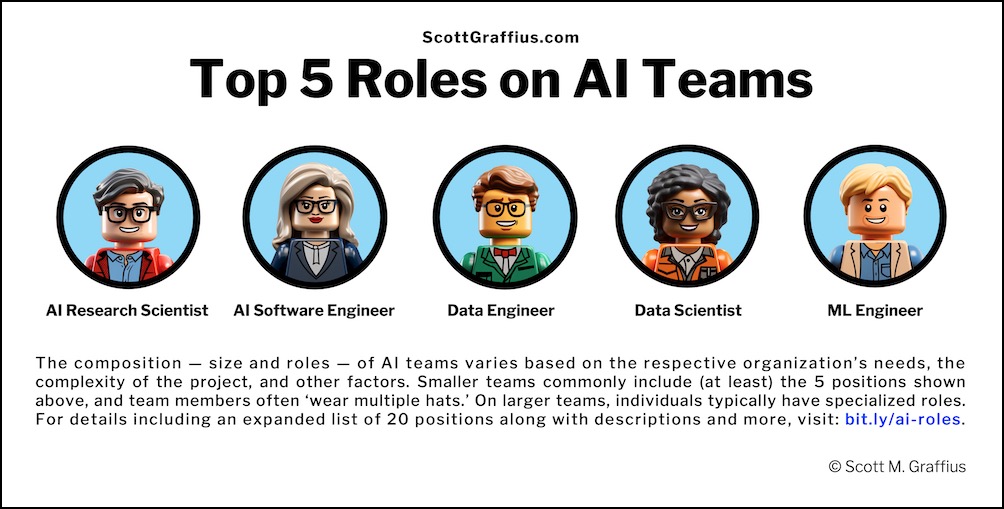
Select here to download a PDF of this article.

Effective Artificial Intelligence (AI) teams leverage critical hard skills and soft skills to develop and deliver successful AI products, including innovative solutions that address real-world challenges and have a positive impact on the world. (If you’d like to learn about the critical skills leveraged by effective AI teams, select here for our popular article on the topic.) This article focuses on the roles on AI teams.

The composition (size and roles) of AI teams varies by organization based on the respective company’s needs, the nature of the AI endeavor including complexity, and other factors. However, AI teams commonly include (at least these) five positions. Here are the five along with brief descriptions, listed in alphabetical order:
- AI Research Scientist: AI research scientists are responsible for conducting research and developing cutting-edge AI algorithms and models.
- AI Software Engineer: AI software engineers are responsible for integrating AI components into software applications. They bridge the gap between AI research and practical implementation, making AI systems usable by end-users.
- Data Engineer: Data engineers are responsible for building and managing the data pipelines that feed AI models. They ensure that data is collected, cleaned, and prepared in a format suitable for analysis and model training.
- Data Scientist: Data scientists are experts in data analysis and interpretation. They preprocess, analyze, and extract valuable insights from data, which is vital for training and improving AI models.
- Machine Learning Engineer: Machine learning engineers focus on implementing and deploying machine learning models into practical applications. They work to ensure that AI models are integrated into software systems effectively.
The above five roles collectively cover key aspects of AI development — from research and model creation to data management and software integration. Depending on requirements and characteristics (such as degree of complexity), additional positions may be needed.
An expanded list of 20 roles common to AI teams follow. Here are the aforementioned 5 and 15 additional positions, listed in alphabetical order:
- AI DevOps Engineer: Combines development and operations skills to streamline AI model deployment. They automate tasks.
- AI Ethicist: Ensures that AI systems are developed and used responsibly and ethically.
- AI Infrastructure Engineer: Builds and maintains the infrastructure required for AI model deployment and scalability.
- AI Legal and Compliance Specialist: Ensures AI projects comply with legal and regulatory requirements.
- AI Marketing Specialist: Promotes and markets AI products and solutions to customers and stakeholders.
- AI Operations (AIOps) Specialist: Focuses on the operational aspects of AI, including monitoring, maintenance, and troubleshooting.
- AI Product Manager: Oversees the development and deployment of AI products.
- AI Project Manager: Leverages general and specialized hard skills and soft skills, and applies their understanding of many aspects of artificial intelligence (such as machine learning, deep learning, automation, robotics, and natural language processing) to manage the planning, execution, and delivery of AI projects. Note: Titles vary by organization; the position may be called an AI Project Manager, AI Program Manager, Agile Project Manager, Technical Project Manager, Scrum Master, or another related designation.
- AI QA Engineer: Ensures the quality and reliability of AI models through testing and validation.
- AI Research Scientist: Conducts research to develop new AI algorithms and models.
- AI Software Engineer: Builds and maintains software systems that incorporate AI components.
- AI Trainer/Annotator: Prepares and labels data for training AI models, especially for supervised learning.
- AI UX/UI Designer: Designs user interfaces and experiences for AI-powered applications.
- Computer Vision Engineer: Specializes in developing AI models for image and video analysis.
- Data Analyst: Examines data to uncover trends and insights that can guide AI projects.
- Data Engineer: Manages data pipelines and prepares data for analysis and model training.
- Data Scientist: Analyzes and interprets data to extract insights and inform AI models.
- Deep Learning Engineer: Focuses on deep neural networks and architectures.
- Machine Learning Engineer: Focuses on implementing and deploying machine learning models.
- Natural Language Processing (NLP) Engineer: Specializes in working with text and language-related AI tasks.
The composition (size and roles) of AI teams varies, based on the complexity of the AI project and other factors. On smaller teams, individuals often ‘wear multiple hats.’ On larger teams, individuals typically have more specialized roles.

This article covered the roles common to AI teams. Listings are not exhaustive of all potential positions. Additionally, as the field of AI continues to evolve and advance, new roles may materialize to address emerging challenges and opportunities.
(If you’d like to learn about the critical skills leveraged by successful AI teams, select here for our popular article on the topic.)

References/Sources
All of the supplied links were functional when this article was published.
- Apple (n.d.). Careers at Apple: Machine Learning and AI. Available at: https://www.apple.com/careers/us/machine-learning-and-ai.html.
- C3.ai (n.d.). Best Practices in Prototyping: Cross-Functional Teams. Available at: https://c3.ai/introduction-what-is-machine-learning/cross-functional-teams/.
- Deloitte AI Institute (2021). Building Successful AI Teams. Available at: https://www2.deloitte.com/content/dam/Deloitte/us/Documents/deloitte-analytics/us-ai-institute-building-successful-AI-teams.pdf.
- Gartner (2020, December 15). Staff AI Teams with Various Roles and Skills for Success. Available at: https://www.gartner.com/smarterwithgartner/how-to-staff-your-ai-team.
- General Services Administration (GSA) Centers of Excellence (CoE) (n.d.). AI Guide for Government. Available at: https://coe.gsa.gov/coe/ai-guide-for-government/understanding-ai-job-roles-career-path/.
- Google Quantum AI (n.d.). Careers. Available at: https://quantumai.google/team/careers.
- Graffius, Scott M. (2023, May 1). AI is a Team Sport: A Confluence of Diverse Technical and Soft Skills are Crucial for Success. Available at: https://www.scottgraffius.com/blog/files/successful-ai-teams.html.
- Graffius, Scott M. (2023). What Successful AI Teams Have in Common [Video]. Graffius’ talk at the 2023 Conf42 Quantum Computer Conference. Available at: https://www.youtube.com/watch?v=u2qRKFbSKYE.
- IBM (n.d.). Assemble the Team to Support a Data-Driven Project. Available at: https://www.ibm.com/garage/method/practices/culture/assemble-team-for-data-driven-project/.
- Intel (n.d.). Artificial Intelligence Teams: Careers. Available at: https://jobs.intel.com/en/search-jobs/artificial+intelligence/599/1.
- Intuit (2020, December 8). How to avoid conflicts and delays in the AI development process (Part I). Available at: https://blogs.intuit.com/2020/12/08/how-to-avoid-conflicts-and-delays-in-the-ai-development-process-part-i/.

How to Cite This Article
Graffius, Scott M. (2023, October 9). Top 5 Roles on AI Teams. Available at: https://scottgraffius.com/blog/files/ai-team-roles.html. DOI: 10.13140/RG.2.2.34857.57449.



About Scott M. Graffius

Scott M. Graffius, PMP, SA, CSP-SM, CSP-PO, CSM, CSPO, SFE, ITIL, LSSGB is an agile project management practitioner, consultant, multi-award-winning author, and international keynote speaker. He is the Founder of Exceptional PPM and PMO Solutions™ and subsidiary Exceptional Agility™. He has generated over $1.9 billion of business value in aggregate for Global Fortune 500 businesses and other organizations he has served. Graffius and content from his books, talks, workshops, and more have been featured and used by businesses, professional associations, governments, and universities. Examples include Microsoft, Oracle, Broadcom, Cisco, Gartner, Project Management Institute, IEEE, Qantas, National Academy of Sciences, United States Department of Energy, New Zealand Ministry of Education, Yale University, Tufts University, and others. He has delighted audiences with dynamic and engaging talks and workshops on agile, project management, and technology (including AI, GameDev, and more) leadership at 87 conferences and other events across 25 countries.
His full bio is available here.
Connect with Scott on:


About Agile Scrum: Your Quick Start Guide with Step-by-Step Instructions

Shifting customer needs are common in today's marketplace. Businesses must be adaptive and responsive to change while delivering an exceptional customer experience to be competitive.
There are a variety of frameworks supporting the development of products and services, and most approaches fall into one of two broad categories: traditional or agile. Traditional practices such as waterfall engage sequential development, while agile involves iterative and incremental deliverables. Organizations are increasingly embracing agile to manage projects, and best meet their business needs of rapid response to change, fast delivery speed, and more.
With clear and easy to follow instructions, the multi award-winning Agile Scrum: Your Quick Start Guide with Step-by-Step Instructions book by Scott M. Graffius (Chris Hare and Colin Giffen, Technical Editors) helps the reader:
- Implement and use the most popular agile framework―Scrum;
- Deliver products in short cycles with rapid adaptation to change, fast time-to-market, and continuous improvement; and
- Support innovation and drive competitive advantage.
Hailed by Literary Titan as “the book highlights the versatility of Scrum beautifully.”
Winner of 17 first place awards.
Agile Scrum: Your Quick Start Guide with Step-by-Step Instructions is available in paperback and ebook/Kindle in the United States and around the world. Some links by country follow.
- 🇧🇷 Brazil
- 🇨🇦 Canada
- 🇨🇿 Czech Republic
- 🇩🇰 Denmark
- 🇫🇮 Finland
- 🇫🇷 France
- 🇩🇪 Germany
- 🇬🇷 Greece
- 🇭🇺 Hungary
- 🇮🇳 India
- 🇮🇪 Ireland
- 🇮🇱 Israel
- 🇮🇹 Italy
- 🇯🇵 Japan
- 🇱🇺 Luxembourg
- 🇲🇽 Mexico
- 🇳🇱 Netherlands
- 🇳🇿 New Zealand
- 🇳🇴 Norway
- 🇪🇸 Spain
- 🇸🇪 Sweden
- 🇨🇭 Switzerland
- 🇦🇪 UAE
- 🇬🇧 United Kingdom
- 🇺🇸 United States

About Agile Transformation: A Brief Story of How an Entertainment Company Developed New Capabilities and Unlocked Business Agility to Thrive in an Era of Rapid Change

Thriving in today's marketplace frequently depends on making a transformation to become more agile. Those successful in the transition enjoy faster delivery speed and ROI, higher satisfaction, continuous improvement, and additional benefits.
Based on actual events, Agile Transformation: A Brief Story of How an Entertainment Company Developed New Capabilities and Unlocked Business Agility to Thrive in an Era of Rapid Change provides a quick (60-90 minute) read about a successful agile transformation at a multinational entertainment and media company, told from the author's perspective as an agile coach.
The award-winning book by Scott M. Graffius is available in paperback and ebook/Kindle in the United States and around the world. Some links by country follow.
- 🇦🇺 Australia
- 🇦🇹 Austria
- 🇧🇷 Brazil
- 🇨🇦 Canada
- 🇨🇿 Czech Republic
- 🇩🇰 Denmark
- 🇫🇮 Finland
- 🇫🇷 France
- 🇩🇪 Germany
- 🇬🇷 Greece
- 🇮🇳 India
- 🇮🇪 Ireland
- 🇯🇵 Japan
- 🇱🇺 Luxembourg
- 🇲🇽 Mexico
- 🇳🇱 Netherlands
- 🇳🇿 New Zealand
- 🇪🇸 Spain
- 🇸🇪 Sweden
- 🇨🇭 Switzerland
- 🇦🇪 United Arab Emirates
- 🇬🇧 United Kingdom
- 🇺🇸 United States

The short link for this article is: https://bit.ly/ai-roles.
© Copyright 2023 Scott M. Graffius. All rights reserved. This material may not be published, broadcast, rewritten or redistributed without the express written permission of Scott M. Graffius.

LTEN Featured Scott M. Graffius' 'Phases of Team Development'
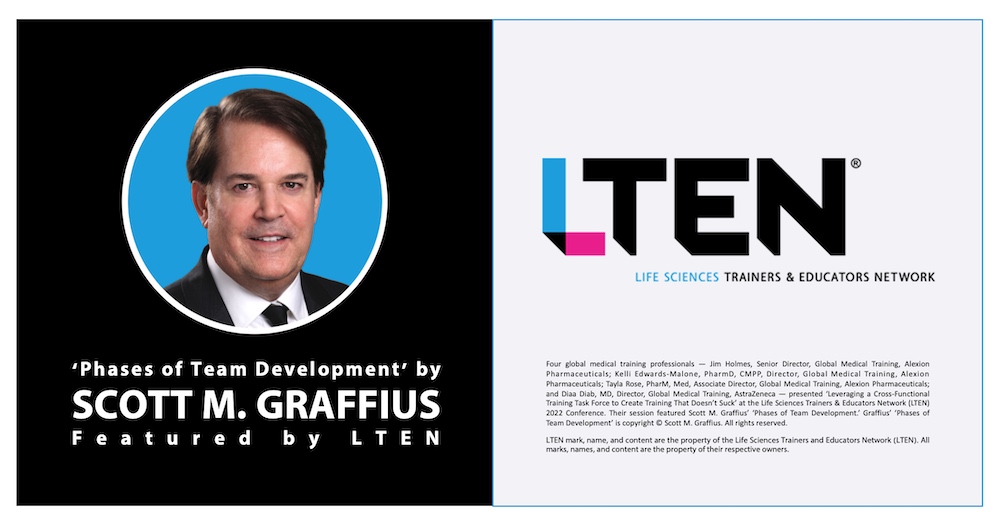
Informed by the research of Bruce W. Tuckman and Mary Ann C. Jensen, over 100 subsequent studies, and Scott M. Graffius' first-hand professional experience with, and analysis of, team leadership and performance, Graffius created his ‘Phases of Team Development’ as a unique perspective and visual conveying the five phases of team development — Forming, Storming, Norming, Performing, and Adjourning — inclusive of a graph showing how performance varies by phase, as well as the characteristics and strategies for each phase.
With permission/a license from Graffius, his ‘Phases of Team Development’ work is used by businesses, professional associations, governments, and universities around the world. Examples include Yale University, IEEE, Torrens University Australia, UK Sports Institute, Adobe, Amsterdam Public Health Research Institute, Academic Cooperation Association, Boston University, U.S. National Park Service, Bayer, Hasso Plattner Institute (Hasso-Plattner-Institut für Digital Engineering GmbH), Singapore University of Social Sciences, New Zealand Government, University of Galway Ireland, and many more.
Life Sciences Trainers & Educators Network (LTEN) used Graffius' 'Phases of Team Development' copyrighted property.
Four global medical training professionals — Jim Holmes, Senior Director, Global Medical Training, Alexion Pharmaceuticals; Kelli Edwards-Malone, PharmD, CMPP, Director, Global Medical Training, Alexion Pharmaceuticals; Tayla Rose, PharM, Med, Associate Director, Global Medical Training, Alexion Pharmaceuticals; and Diaa Diab, MD, Director, Global Medical Training, AstraZeneca — presented ‘Leveraging a Cross-Functional Training Task Force to Create Training That Doesn’t Suck’ at the Life Sciences Trainers & Educators Network (LTEN) 2022 Conference. Their session featured Graffius' ‘Phases of Team Development’ copyrighted property.
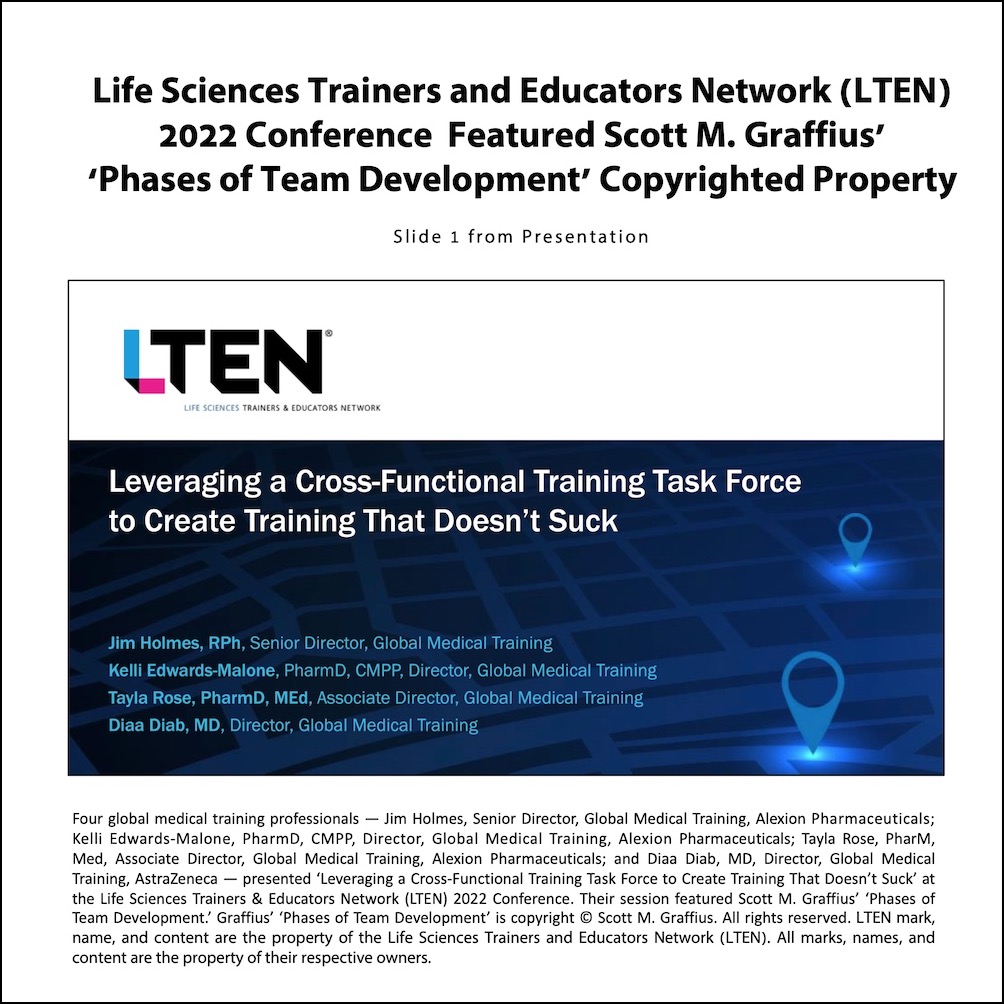
Slide 1 from the session is above.
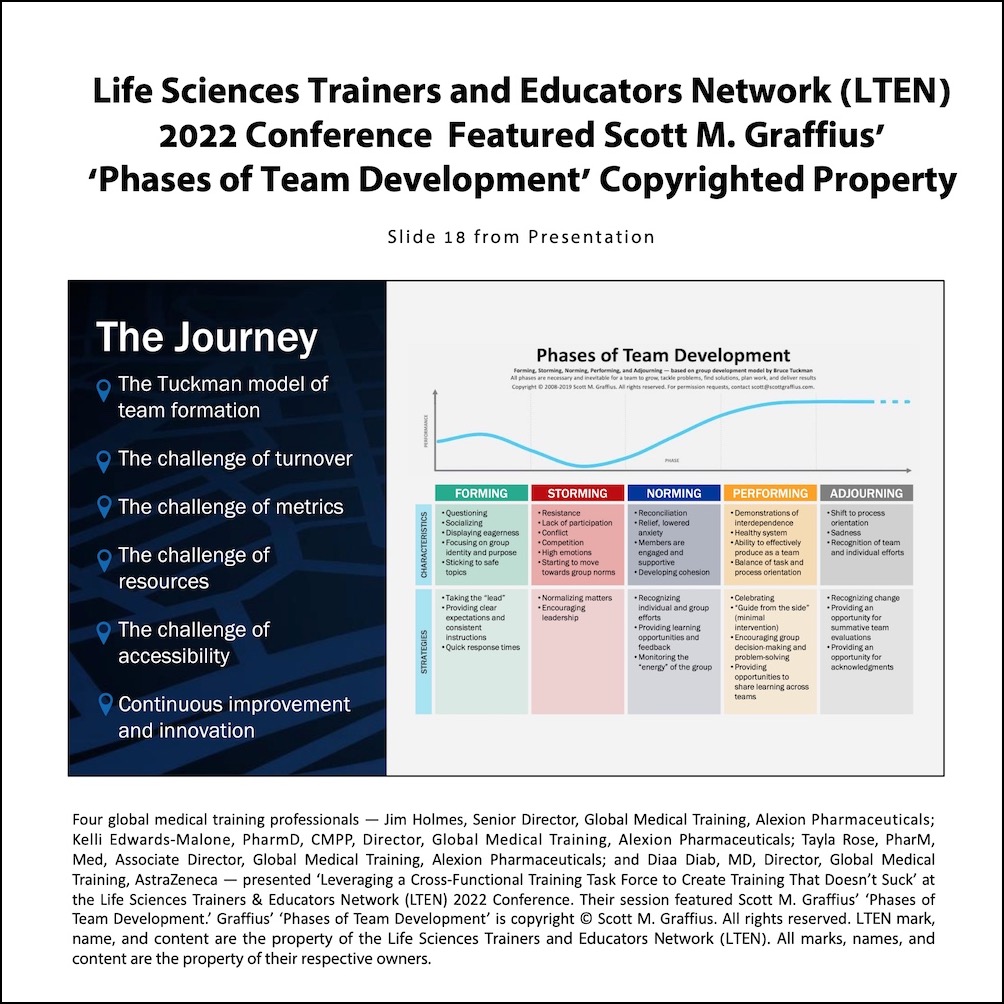
Slide 18 from the session is above.
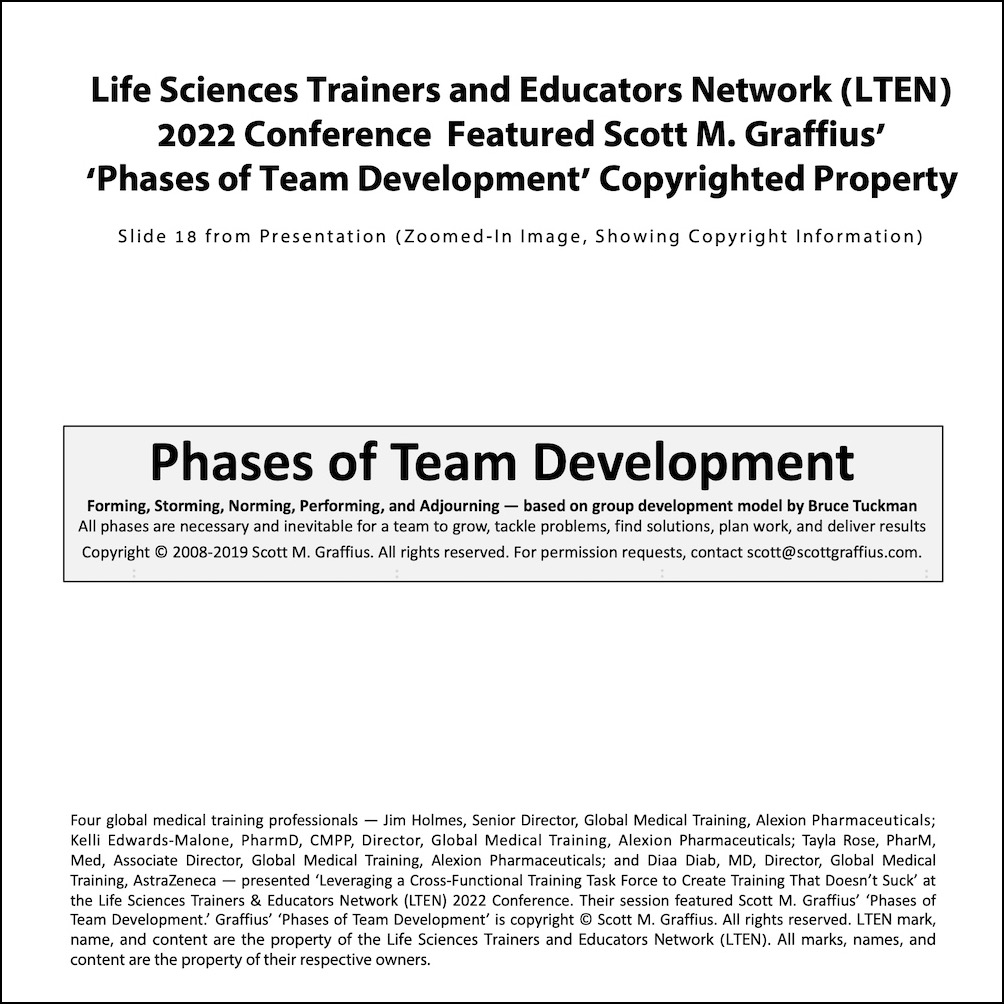
Slide 18 — zoomed-in, to best show the copyright information — is above.
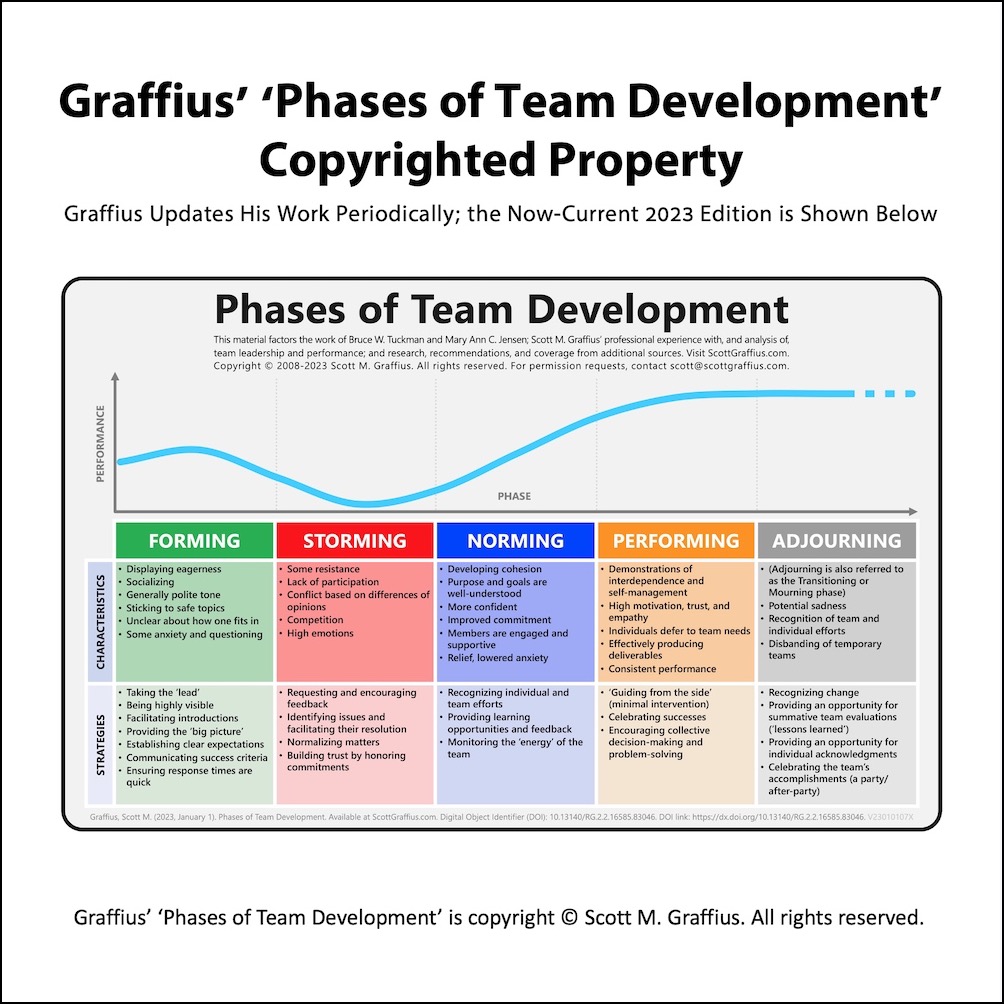
Graffius periodically updates his work. The most current (2023) edition of his 'Phases of Team Development' visual is shown above. Select here for details.
About the Life Sciences Trainers & Educators Network (LTEN)
LTEN's mission statement: "LTEN is the essential resource for life sciences trainer education and networking; enabling members to harness their collective knowledge, apply leading-edge technology, and deliver world-class learning."
Visit their website — here — to learn more.



About Scott M. Graffius

Scott M. Graffius, PMP, SA, CSP-SM, CSP-PO, CSM, CSPO, SFE, ITIL, LSSGB is an agile project management practitioner, consultant, multi-award-winning author, and international keynote speaker. He is the Founder of Exceptional PPM and PMO Solutions™ and subsidiary Exceptional Agility™. He has generated over $1.9 billion of business value in aggregate for Global Fortune 500 businesses and other organizations he has served. Graffius and content from his books, talks, workshops, and more have been featured and used by businesses, professional associations, governments, and universities. Examples include Microsoft, Oracle, Broadcom, Cisco, Gartner, Project Management Institute, IEEE, Qantas, National Academy of Sciences, United States Department of Energy, New Zealand Ministry of Education, Yale University, Tufts University, and others. He has delighted audiences with dynamic and engaging talks and workshops at 88 conferences and other events across 25 countries.
His full bio is available here.
Connect with Scott on:


About Agile Scrum: Your Quick Start Guide with Step-by-Step Instructions

Shifting customer needs are common in today's marketplace. Businesses must be adaptive and responsive to change while delivering an exceptional customer experience to be competitive.
There are a variety of frameworks supporting the development of products and services, and most approaches fall into one of two broad categories: traditional or agile. Traditional practices such as waterfall engage sequential development, while agile involves iterative and incremental deliverables. Organizations are increasingly embracing agile to manage projects, and best meet their business needs of rapid response to change, fast delivery speed, and more.
With clear and easy to follow instructions, the multi award-winning Agile Scrum: Your Quick Start Guide with Step-by-Step Instructions book by Scott M. Graffius (Chris Hare and Colin Giffen, Technical Editors) helps the reader:
- Implement and use the most popular agile framework―Scrum;
- Deliver products in short cycles with rapid adaptation to change, fast time-to-market, and continuous improvement; and
- Support innovation and drive competitive advantage.
Hailed by Literary Titan as “the book highlights the versatility of Scrum beautifully.”
Winner of 17 first place awards.
Agile Scrum: Your Quick Start Guide with Step-by-Step Instructions is available in paperback and ebook/Kindle in the United States and around the world. Some links by country follow.
- 🇧🇷 Brazil
- 🇨🇦 Canada
- 🇨🇿 Czech Republic
- 🇩🇰 Denmark
- 🇫🇮 Finland
- 🇫🇷 France
- 🇩🇪 Germany
- 🇬🇷 Greece
- 🇭🇺 Hungary
- 🇮🇳 India
- 🇮🇪 Ireland
- 🇮🇱 Israel
- 🇮🇹 Italy
- 🇯🇵 Japan
- 🇱🇺 Luxembourg
- 🇲🇽 Mexico
- 🇳🇱 Netherlands
- 🇳🇿 New Zealand
- 🇳🇴 Norway
- 🇪🇸 Spain
- 🇸🇪 Sweden
- 🇨🇭 Switzerland
- 🇦🇪 UAE
- 🇬🇧 United Kingdom
- 🇺🇸 United States

About Agile Transformation: A Brief Story of How an Entertainment Company Developed New Capabilities and Unlocked Business Agility to Thrive in an Era of Rapid Change

Thriving in today's marketplace frequently depends on making a transformation to become more agile. Those successful in the transition enjoy faster delivery speed and ROI, higher satisfaction, continuous improvement, and additional benefits.
Based on actual events, Agile Transformation: A Brief Story of How an Entertainment Company Developed New Capabilities and Unlocked Business Agility to Thrive in an Era of Rapid Change provides a quick (60-90 minute) read about a successful agile transformation at a multinational entertainment and media company, told from the author's perspective as an agile coach.
The award-winning book by Scott M. Graffius is available in paperback and ebook/Kindle in the United States and around the world. Some links by country follow.
- 🇦🇺 Australia
- 🇦🇹 Austria
- 🇧🇷 Brazil
- 🇨🇦 Canada
- 🇨🇿 Czech Republic
- 🇩🇰 Denmark
- 🇫🇮 Finland
- 🇫🇷 France
- 🇩🇪 Germany
- 🇬🇷 Greece
- 🇮🇳 India
- 🇮🇪 Ireland
- 🇯🇵 Japan
- 🇱🇺 Luxembourg
- 🇲🇽 Mexico
- 🇳🇱 Netherlands
- 🇳🇿 New Zealand
- 🇪🇸 Spain
- 🇸🇪 Sweden
- 🇨🇭 Switzerland
- 🇦🇪 United Arab Emirates
- 🇬🇧 United Kingdom
- 🇺🇸 United States

© Copyright 2023 Scott M. Graffius. All rights reserved. This material may not be published, broadcast, rewritten or redistributed without the express written permission of Scott M. Graffius.

IEEE Xplore Publication Featured Scott M. Graffius' 'Phases of Team Development' Work

The scientific paper, “Exploring the Dynamics of Team Formation in Human-Artificial Intelligence Collaboration,” referenced and discussed Scott M. Graffius’ ‘Phases of Team Development’ work.
“Exploring the Dynamics of Team Formation in Human-Artificial Intelligence Collaboration” — a scientific paper and presentation at the 2023 International Conference on Decision Aid Sciences and Applications — referenced and discussed Graffius’ ‘Phases of Team Development.’ Here’s an excerpt: “This is evident in Graffius’ work which shows Graffius’ modifications on the phases of team development, highlighting the characteristics of Tuckman’s stages and presenting strategies to overcome their challenges.”
IEEE Xplore published the paper (here). Here’s the citation information:
Alfateh, Maryam Ali Abu; Messaadia, Mourad; and Ali, Mazen (2023, September). Exploring the Dynamics of Team Formation in Human-Artificial Intelligence Collaboration. In 2023 International Conference on Decision Aid Sciences and Applications (DASA), pp. 384-388. DOI: 10.1109/DASA59624.2023.10286788.
About Scott M. Graffius’ ‘Phases of Team Development’

Informed by the research of Bruce W. Tuckman and Mary Ann C. Jensen, over 100 subsequent studies, and Graffius’ first-hand professional experience with, and analysis of, team leadership and performance, Graffius created his ‘Phases of Team Development’ as a unique perspective and visual conveying the five phases of team development — Forming, Storming, Norming, Performing, and Adjourning — inclusive of a graph showing how performance varies by phase, as well as the characteristics and strategies for each phase.
With permission/a license from Graffius, his ‘Phases of Team Development’ work is used by businesses, professional associations, governments, and universities around the world. Examples include Yale University, IEEE, Torrens University Australia, UK Sports Institute, Adobe, Amsterdam Public Health Research Institute, Academic Cooperation Association, Boston University, U.S. National Park Service, Bayer, Hasso Plattner Institute (Hasso-Plattner-Institut für Digital Engineering GmbH), Singapore University of Social Sciences, New Zealand Government, University of Galway Ireland, and many more.
Visit https://bit.ly/teams-23 for details, including permission request information and more.
Graffius’ ‘Phases of Team Development’ (visual and text) is copyright © Scott M. Graffius. All rights reserved.
About the IEEE
The Institute of Electrical and Electronics Engineers (IEEE) is the world’s largest professional organization advancing innovation and technological excellence for the benefit of humanity. IEEE and its members (which includes Graffius) inspire a global community to innovate for a better tomorrow through its highly cited publications, conferences, technology standards, and professional and educational activities. IEEE is the trusted “voice” for engineering, computing, and technology information around the globe. Visit https://ieee.org to learn more.
IEEE name, mark, and content are the property of the IEEE.
About IEEE Xplore
IEEE Xplore is the flagship digital platform for discovery and access to scientific and technical content published by the IEEE and its publishing partners. Visit https://innovate.ieee.org to learn more.
IEEE Xplore name, mark, and content are the property of the IEEE.



About Scott M. Graffius

Scott M. Graffius, PMP, SA, CSP-SM, CSP-PO, CSM, CSPO, SFE, ITIL, LSSGB is an agile project management practitioner, consultant, multi-award-winning author, and international keynote speaker. He is the Founder of Exceptional PPM and PMO Solutions™ and subsidiary Exceptional Agility™. He has generated over $1.9 billion of business value in aggregate for Global Fortune 500 businesses and other organizations he has served. Graffius and content from his books, talks, workshops, and more have been featured and used by businesses, professional associations, governments, and universities. Examples include Microsoft, Oracle, Broadcom, Cisco, Gartner, Project Management Institute, IEEE, Qantas, National Academy of Sciences, United States Department of Energy, New Zealand Ministry of Education, Yale University, Tufts University, and others. He has delighted audiences with dynamic and engaging talks and workshops at 88 conferences and other events across 25 countries.
His full bio is available here.
Connect with Scott on:


About Agile Scrum: Your Quick Start Guide with Step-by-Step Instructions

Shifting customer needs are common in today's marketplace. Businesses must be adaptive and responsive to change while delivering an exceptional customer experience to be competitive.
There are a variety of frameworks supporting the development of products and services, and most approaches fall into one of two broad categories: traditional or agile. Traditional practices such as waterfall engage sequential development, while agile involves iterative and incremental deliverables. Organizations are increasingly embracing agile to manage projects, and best meet their business needs of rapid response to change, fast delivery speed, and more.
With clear and easy to follow instructions, the multi award-winning Agile Scrum: Your Quick Start Guide with Step-by-Step Instructions book by Scott M. Graffius (Chris Hare and Colin Giffen, Technical Editors) helps the reader:
- Implement and use the most popular agile framework―Scrum;
- Deliver products in short cycles with rapid adaptation to change, fast time-to-market, and continuous improvement; and
- Support innovation and drive competitive advantage.
Hailed by Literary Titan as “the book highlights the versatility of Scrum beautifully.”
Winner of 17 first place awards.
Agile Scrum: Your Quick Start Guide with Step-by-Step Instructions is available in paperback and ebook/Kindle in the United States and around the world. Some links by country follow.
- 🇧🇷 Brazil
- 🇨🇦 Canada
- 🇨🇿 Czech Republic
- 🇩🇰 Denmark
- 🇫🇮 Finland
- 🇫🇷 France
- 🇩🇪 Germany
- 🇬🇷 Greece
- 🇭🇺 Hungary
- 🇮🇳 India
- 🇮🇪 Ireland
- 🇮🇱 Israel
- 🇮🇹 Italy
- 🇯🇵 Japan
- 🇱🇺 Luxembourg
- 🇲🇽 Mexico
- 🇳🇱 Netherlands
- 🇳🇿 New Zealand
- 🇳🇴 Norway
- 🇪🇸 Spain
- 🇸🇪 Sweden
- 🇨🇭 Switzerland
- 🇦🇪 UAE
- 🇬🇧 United Kingdom
- 🇺🇸 United States

About Agile Transformation: A Brief Story of How an Entertainment Company Developed New Capabilities and Unlocked Business Agility to Thrive in an Era of Rapid Change

Thriving in today's marketplace frequently depends on making a transformation to become more agile. Those successful in the transition enjoy faster delivery speed and ROI, higher satisfaction, continuous improvement, and additional benefits.
Based on actual events, Agile Transformation: A Brief Story of How an Entertainment Company Developed New Capabilities and Unlocked Business Agility to Thrive in an Era of Rapid Change provides a quick (60-90 minute) read about a successful agile transformation at a multinational entertainment and media company, told from the author's perspective as an agile coach.
The award-winning book by Scott M. Graffius is available in paperback and ebook/Kindle in the United States and around the world. Some links by country follow.
- 🇦🇺 Australia
- 🇦🇹 Austria
- 🇧🇷 Brazil
- 🇨🇦 Canada
- 🇨🇿 Czech Republic
- 🇩🇰 Denmark
- 🇫🇮 Finland
- 🇫🇷 France
- 🇩🇪 Germany
- 🇬🇷 Greece
- 🇮🇳 India
- 🇮🇪 Ireland
- 🇯🇵 Japan
- 🇱🇺 Luxembourg
- 🇲🇽 Mexico
- 🇳🇱 Netherlands
- 🇳🇿 New Zealand
- 🇪🇸 Spain
- 🇸🇪 Sweden
- 🇨🇭 Switzerland
- 🇦🇪 United Arab Emirates
- 🇬🇧 United Kingdom
- 🇺🇸 United States

© Copyright 2023 Scott M. Graffius. All rights reserved. This material may not be published, broadcast, rewritten or redistributed without the express written permission of Scott M. Graffius.

Scott M. Graffius’ Phases of Team Development: 2024 Update
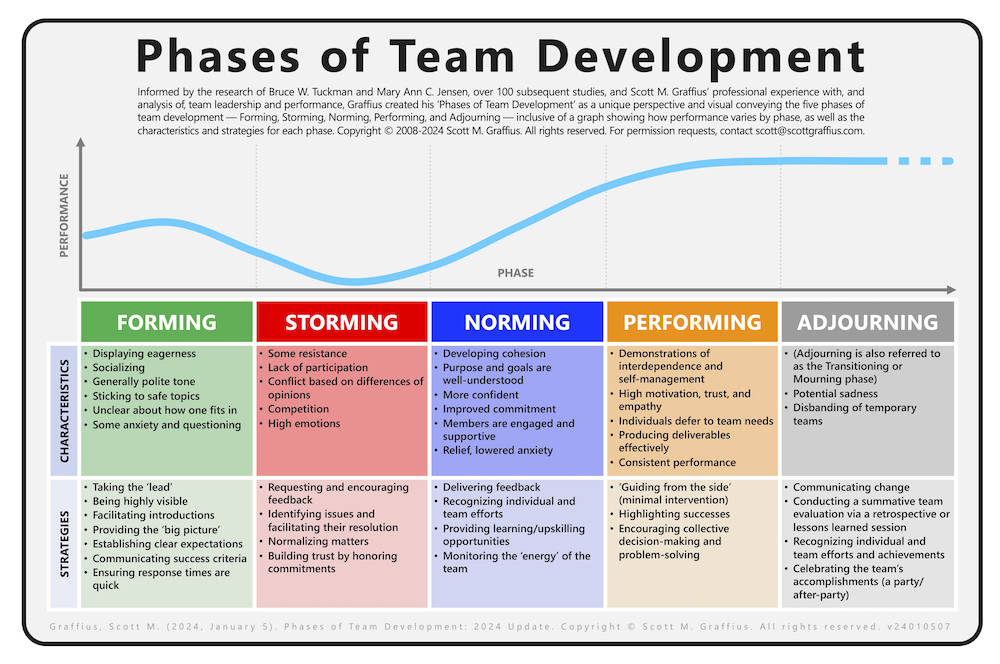
High Resolution Files of Visual: See Permission Request Information section

If there are any supplements or updates to this article after the date of publication, they will appear in the Post-Publication Notes section at the end of this article.


Introduction
Informed by the research of Bruce W. Tuckman and Mary Ann C. Jensen, over 100 subsequent studies, and Scott M. Graffius’ first-hand professional experience with, and analysis of, team leadership and performance, Graffius created his ‘Phases of Team Development’ as a unique perspective and visual conveying the five phases of team development — Forming, Storming, Norming, Performing, and Adjourning — inclusive of a graph showing how performance varies by phase, as well as the characteristics and strategies for each phase.
Project Managers, Scrum Masters, Agile Coaches, DevOps Leads, and other leaders can apply the information to help handle challenges or issues experienced by teams. By doing so, they’ll advance the teams’ (and their own) happiness, productivity, and success.
Graffius initially developed his unique material in 2008, and he periodically refreshes it. This article (including the accompanying visual) provides the 2024 update to his ‘Phases of Team Development’ work.
Graffius’ work has “team development” in the title. Alternative terms — which may be interchangeable in the context of this article — include group development, group dynamics, team agility, team building, team coaching, team collaboration, teamcraft, team dynamics, team leadership, team optimization, team performance, team tradecraft, and teamwork.

Five Phases of Team Development
1. Forming
Characteristics of the Forming phase include displaying eagerness, socializing, generally polite tone, sticking to safe topics, unclear about how one fits in, and some anxiety and questioning.
Strategies for Forming include taking the ‘lead,’ being highly visible, facilitating introductions, providing the ‘big picture,’ establishing clear expectations, communicating success criteria, and ensuring response times are quick.
2. Storming
Traits of the Storming phase include some resistance, lack of participation, conflict based on differences of opinions, competition, and high emotions.
Strategies for Storming include requesting and encouraging feedback, identifying issues and facilitating their resolution, normalizing matters, and building trust by honoring commitments.
3. Norming
Features of the Norming phase include developing cohesion; purpose and goals are well-understood; more confident; improved commitment; members are engaged and supportive; and relief, lowered anxiety.
Strategies for Norming include delivering feedback, recognizing individual and team efforts, providing learning/upskilling opportunities, and monitoring the ‘energy’ of the team.
4. Performing
Characteristics of the Performing phase include demonstrations of interdependence and self-management; high motivation, trust, and empathy; individuals defer to team needs; producing deliverables effectively; and consistent performance.
Strategies for Performing include ‘guiding from the side’ (minimal intervention), highlighting successes, and encouraging collective decision-making and problem-solving.
5. Adjourning
Typical traits of the Adjourning phase (also referred to as the Transitioning or Mourning phase) include potential sadness, and disbanding of temporary teams.
Strategies for Adjourning include communicating change, conducting a summative team evaluation via a retrospective or lessons learned session, recognizing individual and team efforts and achievements, and celebrating the team's accomplishments (a party/after-party).

Conclusion
Project Managers, Scrum Masters, Agile Coaches, DevOps Leads, and other leaders can apply the information in this article and the accompanying visual to help handle challenges or issues experienced by teams. By doing so, they’ll advance the teams’ (and their own) happiness, productivity, and success.
This article provided a brief overview of the five phases of team development. Scott M. Graffius presents dynamic and engaging talks and workshops on this topic and more at conferences and other events (public and private/corporate) around the world. To learn more, visit here. For booking information, please complete a speaker engagement request form or email Scott M. Graffius.
If you're looking for additional information on this article (such as references/sources, citation details, or permission request information), read on.

Graffius’ Research is Widely Cited, Featured, and Used
Businesses, scientists, journalists, professional associations, government agencies, universities, and others around the world have featured and used prior — 2023 and earlier — editions of Scott M. Graffius’ ‘Phases of Team Development’ material. Here are a few examples:
- Academic Cooperation Association
- Adobe
- American Management Association
- Amsterdam Public Health Research Institute
- Bayer
- Boston University
- CodeMonk
- Dagen
- Deimos Aerospace
- Erste Bank
- FSU College of Medicine
- Hasso Plattner Institute (Hasso-Plattner-Institut für Digital Engineering GmbH)
- IEEE
- Innovify
- Life Sciences Trainers & Educators Network (LTEN)
- London South Bank University
- New Zealand Government
- Prima Resource
- Singapore University of Social Sciences
- Technical University of Munich
- Torrens University Australia
- UK Sports Institute
- University of Galway Ireland
- University of Graz Austria
- University of Waterloo
- US National Park Service
- Virginia Tech
- Warsaw University of Technology
- Yale University
- Zittau/Gorlitz University of Applied Sciences
- And many more

References/Sources
Select (partial) bibliography:
- Activision Blizzard (2022, September 9). Tackling the Talent Shortage: Identifying the Skills Critical for Game Development. Available at: https://www.activisionblizzard.com/content/atvi/activisionblizzard/ab-touchui/ab/web/en/newsroom/2022/09/tackling-the-talent-shortage.html.
- Alfateh, Maryam Ali Abu; Messaadia, Mourad; and Ali, Mazen (2023, September). Exploring the Dynamics of Team Formation in Human-Artificial Intelligence Collaboration. In 2023 International Conference on Decision Aid Sciences and Applications (DASA), pp. 384-388, DOI: 10.1109/DASA59624.2023.10286788.
- Alford, J. (2019, April 11). Our Co-Production Journey: From Sandpits to Bird Boxes. London, United Kingdom: Imperial College London.
- Ali, A. J., Fuenzalida, J., Gómez, M., & Williams, M. J. (2021, June). Four Lenses on People Management in the Public Sector: An Evidence Review and Synthesis. Oxford Review of Economic Policy, 37 (2): 335-366.
- Amsterdam Public Health Research Institute (2021). APH Quality Handbook. Amsterdam: Amsterdam Public Health Research Institute.
- Bandai Namco (n.d.). Teamwork Makes the Dream Work. Available at: https://bandainamcomobile.com/news/power-up-your-teamwork-how-bandai-namco-mobile-builds-stronger-teams.
- Bellet, C., De Neve, J., & Ward, G. (2019 October 14). Does Employee Happiness Have an Impact on Productivity? Saïd Business School WP 2019-13. Oxford, UK: Oxford University.
- Bennett, M., Gadlin, H., & Marchand, C. (2018). Collaboration Team Science: Field Guide. Rockville, MD: National Institutes of Health.
- Berlin School of Business and Innovation (2022, September 22). How Do Technical Abilities Combined with Leadership Skills Fuel Career Growth? Available at: https://www.berlinsbi.com/blog/career-advice/how-do-technical-abilities-combined-with-leadership-skills-fuel-career-growth.
- Brief, A. P. & Weiss, H. M. (2022, February). Organizational Behavior: Affect in the Workplace. Annual Review of Psychology, 53 (1): 279-307.
- Cisco (2019). Next-Generation IT Talent Strategies: How CIOs Can Close the Skills Gap and Drive True Business Transformation. Available at: https://www.cisco.com/c/dam/global/en_uk/solutions/executive-perspectives/pdf/ITTalent.pdf.
- Couture, N. (2016, October 27). A Note About Teams. CIO. Boston, MA: International Data Group (IDG).
- Daly, L. (2002). Identify Your Project Management Team’s Level of Development and Facilitate It to Success. Paper presented at Project Management Institute Annual Seminars and Symposium, San Antonio, TX. Newtown Square, PA: Project Management Institute.
- Dechurch, Leslie; & Mesmer-Magnus, Jessica. (2010). The Cognitive Underpinnings of Effective Teamwork: A Meta-Analysis. The Journal of Applied Psychology, 95: 32-53.
- Defense Advanced Research Projects Agency (DARPA) (2023, February 23). Episode 65: A Sprint to Tomorrow, Powered by Teamwork [Podcast]. Available at: https://www.darpa.mil/news-events/2023-02-23a.
- Deloitte (2017). Digital Era Technology Operating Models, Volume 2. New York, NY: Deloitte Touche Tohmatsu Limited.
- DevOps Institute (2021). 2021 Upskilling Enterprise DevOps Skills Report. Boca Raton, FL: DevOps Institute.
- Dickinson, A.; & Stoneman, K. (1989). Individual Performance as a Function of Group Contingencies and Group Size. Journal of Organizational Behavior Management, 10: 131-150.
- Dolev, Niva, & Itzkovich, Yariv (2020). In the AI Era, Soft Skills are the New Hard Skills. In: Artificial Intelligence and Its Impact on Business, pp. 55-77. Charlotte, NC: Information Age Publishing.
- Dzombak, Rachel, & Palat, Jay (2021, August 30). 5 Ways to Start Growing an AI-Ready Workforce. Pittsburgh, PA: Software Engineering Institute, Carnegie Mellon University.
- Elliott, Joshua (n.d.). Artificial Social Intelligence for Successful Teams (ASIST). Arlington, VA: Defense Advanced Research Projects Agency (DARPA).
- Exceptional Agility (2023, January 1). Making Teams More Agile: Strategies and Benefits. Available at: https://exceptionalagility.com/blog/files/teams.html.
- Finkelstein, S. (2017, October 29). Why Companies Should Hire Teams, Not Individuals. The Wall Street Journal. New York, NY: The Wall Street Journal.
- Forbes (2018, April 23). How to Fast-Track Any Team to Success. Forbes. New York, NY: Forbes.
- Forbes (2012, October 27). How the iPad Mini is Defining Tim Cook’s Apple. Forbes. New York, NY: Forbes.
- Gartner (2020, December 15). How to Staff Your AI Team. Available at: https://www.gartner.com/smarterwithgartner/how-to-staff-your-ai-team.
- Glover, P. (2012, March 13). Team Conflict: Why It’s a Good Thing. Fast Company. New York, NY: Mansueto Ventures.
- Gorman, Austin (2023, April 27). How to Strengthen Your Soft Skills for AI and the Future of Work. Fast Company. Available at: https://www.fastcompany.com/90887540/how-to-strengthen-your-soft-skills-for-ai-and-the-future-of-work.
- Graffius, Scott M. (2023, October 13). The Science of High-Performance Game Development Teams [Presentation]. Talk delivered at the W Love Games International Video Game Development Conference 2023 - Helsinki, Finland. Digital Object Identifier (DOI): 10.13140/RG.2.2.28602.16326. DOI link: https://dx.doi.org/10.13140/RG.2.2.28602.16326.
- Graffius, Scott M. (2023, July 15). Successful Video Game Development Teams Leverage an Extensive Range of Hard Skills and Soft Skills. Available at: https://scottgraffius.com/blog/files/gamedev.html. DOI: 10.13140/RG.2.2.31205.17124.
- Graffius, Scott M. (2023, April 26). The Science of High-Performance Teams [Presentation]. Talk delivered at the DevOps Institute’s SKILup Day 2023 Conference. Digital Object Identifier (DOI): 10.13140/RG.2.2.15888.28169. DOI link: https://dx.doi.org/10.13140/RG.2.2.15888.28169.
- Graffius, Scott M. (2023, January 9). Use the Phases of Team Development (Based on Bruce W. Tuckman's Model of Forming, Storming, Norming, Performing, and Adjourning) to Help Teams Grow and Advance: 2023 Update. Available at: https://scottgraffius.com. Digital Object Identifier (DOI): 10.13140/RG.2.2.10720.35846. DOI link: https://dx.doi.org/10.13140/RG.2.2.10720.35846.
- Graffius, Scott M. (2023, June 29). What Successful AI Teams Have in Common [Presentation]. Talk delivered at Conf42 Quantum Computing 2023 Conference. Digital Object Identifier (DOI): 10.13140/RG.2.2.29382.45120. DOI link: https://dx.doi.org/10.13140/RG.2.2.29382.45120.
- Graffius, Scott M. (2023, May 1). Fueling the Development of Innovative and Life-Changing AI Solutions [Presentation]. Talk delivered to an audience of Technology professionals (including Data Scientists, Machine Learning Engineers, Data Engineers, AI Researchers, Project Managers, Business Analysts, UX Designers, Software Developers, Cloud Architects, Data Privacy and Security Specialists, and others involved or interested in AI) at a private event in Mountain View, California, United States. Digital Object Identifier (DOI): 10.13140/RG.2.2.27956.73601. DOI link: https://dx.doi.org/10.13140/RG.2.2.27956.73601.
- Graffius, Scott M. (2022, February 4). Team Development Tradecraft: A Source of Competitive Advantage [Workshop]. Session at private event in Adelaide, Australia. DOI: 10.13140/RG.2.2.14092.80002.
- Graffius, Scott M. (2022, May 13). Want Happier and More Productive DevOps Teams? [Presentation]. Talk delivered at DevOpsDays Geneva, Switzerland 2022 Conference. Digital Object Identifier (DOI): 10.13140/RG.2.2.22252.85127. DOI link: https://dx.doi.org/10.13140/RG.2.2.22252.85127.
- Graffius, Scott M. (2021, February 20). But First, the Team! [Presentation]. Talk delivered at the Brno, Czech Republic DevConf.CZ 2021 Conference. Digital Object Identifier (DOI): 10.13140/RG.2.2.29016.72964. DOI link: https://dx.doi.org/10.13140/RG.2.2.29016.72964.
- Graffius, Scott M. (2021, June 21). DevOps and Team Leadership [Workshop]. Session at private event in Las Vegas, NV. DOI: 10.13140/RG.2.2.15380.22401.
- Graffius, Scott M. (2021, May 13). But First, the Team! [Presentation]. Lecture delivered at DevOps Pro Europe 2021 Conference. Based and simulcast live from Vilnius, Lithuania. DOI: 10.13140/RG.2.2.30524.36481.
- Graffius, Scott M. (2021, November 10). An Error Was Introduced Into the Seventh Edition of 'A Guide to the Project Management Body of Knowledge (PMBOK).’ Los Angeles, CA: Scott M. Graffius.
- Graffius, Scott M. (2021, November 8). Bruce Tuckman’s Model (Forming, Storming, Norming, Performing, and Adjourning) is Highly Relevant and Beneficial, But It Doesn’t Please Everyone. Los Angeles, CA: Scott M. Graffius.
- Graffius, Scott M. (2021, October 5). Navigate the Phases of Team Development with Speed and Agility for Happier and More Productive Teams [Presentation]. Talk delivered at the Institute of Electrical and Electronics Engineers IEEE Day 2021 Conference. Digital Object Identifier (DOI): 10.13140/RG.2.2.20055.19365. DOI link: https://dx.doi.org/10.13140/RG.2.2.20055.19365.
- Graffius, Scott M. (2021). Phases of Team Development. Los Angeles, CA: Scott M. Graffius. Digital Object Identifier (DOI): 10.13140/RG.2.2.22040.42246.
- Graffius, Scott M. (2018, October 18). Agile Scrum Helps Innovators, Disruptors, and Entrepreneurs Develop and Deliver Products at Astounding Speed Which Drives Competitive Advantage [Presentation]. Talk delivered at Techstars Startup Week Conference. DOI: 10.13140/RG.2.2.25009.12647.
- Himmelstein, D. (2018, January 26). Team Cycles and Culture Development. San Jose, CA: Acer, Inc.
- Humphrey, W. S., Chick, T. A., Nichols, W., and Pomeroy-Huff, M. (2010). Software Engineering Institute’s Team Software Process Body of Knowledge. Pittsburgh, PA: Carnegie Mellon University.
- Infinity Ward (n.d.). Infinity Ward. Available at: https://www.infinityward.com.
- International Game Developers Association (IGDA) (n.d.). IGDA Foundation. Available at: https://igda.org/igda-foundation/.
- Jovanovic, M., Mesquida, A., Radaković, N., & Mas, A. (2016). Agile Retrospective Games for Different Team Development Phases. Journal of Universal Computer Science, 22: 1489-1508.
- KPMG (2017). The Digital Fund, Season 2. Amstelveen, Netherlands: KPMG International.
- Leswing, Kif (2023, June 5). Apple’s Practical Approach to A.I.: No Bragging, Just Features. CNBC. Available at: https://www.cnbc.com/2023/06/05/apple-practical-approach-to-ai-no-bragging-just-features.html.
- Life Sciences Trainers and Educators Network (LTEN) (2022). Leveraging a Cross-Functional Training Task Force to Create Training that Doesn’t Suck. LTEN 2022 Conference.
- Madden, D. (2019, May 19). The Four Stages of Building a Great Team – and the One Where Things Usually Go Wrong. Inc. Magazine. New York, NY: Inc. Magazine.
- Makar, A. (2011, July 13). Lessons Learned in Norming and Performing Team Development Phases. Louisville, KY: Tech Republic.
- Martinuzzi, B. (2012, June 8). Six Tips Guaranteed to Reduce Workplace Frustrations. New York, NY: American Express Company.
- Massachusetts Institute of Technology (MIT) (2021, January). Cognitive Science as a New People Science for the Future of Work. Available at: https://workofthefuture.mit.edu/wp-content/uploads/2021/01/2021-Research-Brief-Polli-Kassir-Dolphin-Baker-Gabrieli.pdf.
- Microsoft (2019, June 15). Is the Latest Technology the Key to Your Team’s Success, or is There Something Else? Microsoft Developer Support. Accessed at: https://devblogs.microsoft.com/premier-developer/is-the-latest-technology-the-key-to-your-teams-success-or-is-there-something-else. Redmond, WA: Microsoft.
- Mocko, G., & Linnerud, B. (2016). Measuring the Effects of Goal Alignment on Innovative Engineering Design Projects. International Journal of Engineering Education, 32: 55-63.
- Negrón, A.P.P., Carranza, D.B., Muñoz, M. (2023). Video Game Development Process for Soft Skills Analysis. In: Mejia, J., Muñoz, M., Rocha, Á., Hernández-Nava, V. (eds), New Perspectives in Software Engineering. Proceedings of the 11th International Conference on Software Process Improvement (CIMPS 2022). Lecture Notes in Networks and Systems, vol. 576. New York, NY: Springer.
- Riggs, A. (2020, October 15). Why I Start All My Video Meetings with Collaborative Games (Spoiler: It’s Not Boredom). Amsterdam, the Netherlands: The Next Web (TNW).
- Romanelli, M. (2019, September 11). Teamwork Accelerated. PM Times. Newmarket, Ontario, Canada: Macgregor Communications.
- Rowley, D., & Lange, M. (2007). Forming to Performing: The Evolution of an Agile Team. IEEE Computer Society Proceedings. Agile 2007, 1: 408-414.
- Sakpal, M. (2020, March 3. Learn How to Debunk These Five Restructuring Myths. Stamford, CT: Gartner, Inc.
- Sazali, A. R. B.; Khamarudin, F. B.; & Abdul Alahdad, S. N. B. (2022). Maximising the Zone of Proximal Development Benefits in Group Online Learning. International Journal of Academic Research in Business and Social Sciences, 12 (6): 1476-1496.
- Scaled Agile, Inc. (2023, March 14). Working Successfully in Agile with Remote Team Members. Available at: https://scaledagileframework.com/working-successfully-in-agile-with-remote-team-members/.
- Scrum Alliance (2020). Learning Objectives Examples. Denver, CO: Scrum Alliance.
- Stanford University (2019, September). Gathering Strength, Gathering Storms. Stanford, CA: Stanford University.
- Steiner, Ivan D. (1972). Group Process and Productivity. New York, New York: Academic Press.
- Stern, S. (2018, September 26). Is Your Team Working the Rory Underwood Way? Financial Times. London, United Kingdom: The Financial Times, a Nikkei Company.
- Tamiru, Natasha (2023, June). Team Dynamics: Five Keys to Building Effective Teams. Google. Available at: https://www.thinkwithgoogle.com/intl/en-emea/consumer-insights/consumer-trends/five-dynamics-effective-team.
- Tannenbaum, Robert, & Schmidt, Warren H. (1958). How to Choose a Leadership Pattern. Harvard Business Review, 36: 95- 101.
- Telford, R. (2013, June 4). This is Where It Gets Interesting. Armonk, NY: International Business Machines (IBM) Corporation.
- Thier, Jane (2021, December 8). 'Form, Storm, Norm, Perform’: Twitter’s New CEO Faces a Critical Few Months as He Seeks to Differentiate Himself from Jack Dorsey, Leadership Experts Say. Fortune. Available at: https://fortune.com/2021/12/08/form-storm-norm-perform-twitters-new-ceo-faces-a-critical-few-months-as-he-seeks-to-differentiate-himself-from-jack-dorsey-leadership-experts-say/.
- Tuckman, B. W. (1965). Developmental Sequence in Small Groups. Psychological Bulletin, 63: 384-399.
- Tuckman, B. W., & Jensen, M. A. C. (1977). Stages of Small-Group Development Revisited. Group and Organizational Studies, 2 (4): 419-427.
- United States Army (2015). Innovative Learning: A Key to National Security. Washington, DC: United States Army.
- United States National Park Service (NPS) (2022, Spring). NPS Aviation Safety.
- Wheelan, S. A. (2009). Group Size, Group Development, and Group Productivity. Small-Group Research, 40 (2): 247-262.

How to Cite This Article
Graffius, Scott M. (2024, January 5). Scott M. Graffius’ Phases of Team Development: 2024 Update. Available at: https://scottgraffius.com/blog/files/teams-2024.html. DOI: 10.13140/RG.2.2.28629.40168.

Permission Request Information
To request permission to use the ‘Phases of Team Development’ visual shown at the top of this article or any other material from this publication, email Scott M. Graffius. If your request is approved, Graffius will give you an authorization/license and, if applicable, high-resolution files of the visual.

About Scott M. Graffius

Scott M. Graffius, PMP, SA, CSP-SM, CSP-PO, CSM, CSPO, SFE, ITIL, LSSGB is an agile project management practitioner, consultant, thinker, creator, multi-award-winning author, and international public speaker. Founder and CEO of Exceptional PPM and PMO Solutions™ and subsidiary Exceptional Agility™, he has generated over $1.9 billion for Global Fortune 500 businesses and other organizations he has served. Graffius and content from his books, talks, workshops, and more have been featured and used by Microsoft, Oracle, Broadcom, Cisco, Gartner, Project Management Institute, IEEE, National Academy of Sciences, United States Department of Energy, Yale University, Tufts University, and others. He delights audiences with dynamic and engaging talks and workshops on agile project management, AI, Tech leadership, video game development, strategic alignment, the science of high performance teams, and more. To date, he's presented sessions at 89 conferences and other events across 25 countries.
His full bio is available here.
Connect with Scott on:



About Agile Scrum: Your Quick Start Guide with Step-by-Step Instructions

Shifting customer needs are common in today's marketplace. Businesses must be adaptive and responsive to change while delivering an exceptional customer experience to be competitive.
There are a variety of frameworks supporting the development of products and services, and most approaches fall into one of two broad categories: traditional or agile. Traditional practices such as waterfall engage sequential development, while agile involves iterative and incremental deliverables. Organizations are increasingly embracing agile to manage projects, and best meet their business needs of rapid response to change, fast delivery speed, and more.
With clear and easy to follow step-by-step instructions, Scott M. Graffius's award-winning Agile Scrum: Your Quick Start Guide with Step-by-Step Instructions helps the reader:
- Implement and use the most popular agile framework―Scrum;
- Deliver products in short cycles with rapid adaptation to change, fast time-to-market, and continuous improvement; and
- Support innovation and drive competitive advantage.
Hailed by Literary Titan as “the book highlights the versatility of Scrum beautifully.”
Winner of 17 first place awards.
Agile Scrum: Your Quick Start Guide with Step-by-Step Instructions is available in paperback and ebook/Kindle in the United States and around the world. Some links by country follow.
- 🇧🇷 Brazil
- 🇨🇦 Canada
- 🇨🇿 Czech Republic
- 🇩🇰 Denmark
- 🇫🇮 Finland
- 🇫🇷 France
- 🇩🇪 Germany
- 🇬🇷 Greece
- 🇭🇺 Hungary
- 🇮🇳 India
- 🇮🇪 Ireland
- 🇮🇱 Israel
- 🇮🇹 Italy
- 🇯🇵 Japan
- 🇱🇺 Luxembourg
- 🇲🇽 Mexico
- 🇳🇱 Netherlands
- 🇳🇿 New Zealand
- 🇳🇴 Norway
- 🇪🇸 Spain
- 🇸🇪 Sweden
- 🇨🇭 Switzerland
- 🇦🇪 UAE
- 🇬🇧 United Kingdom
- 🇺🇸 United States

About Agile Transformation: A Brief Story of How an Entertainment Company Developed New Capabilities and Unlocked Business Agility to Thrive in an Era of Rapid Change

Thriving in today's marketplace frequently depends on making a transformation to become more agile. Those successful in the transition enjoy faster delivery speed and ROI, higher satisfaction, continuous improvement, and additional benefits.
Based on actual events, Agile Transformation: A Brief Story of How an Entertainment Company Developed New Capabilities and Unlocked Business Agility to Thrive in an Era of Rapid Change provides a quick (60-90 minute) read about a successful agile transformation at a multinational entertainment and media company, told from the author's perspective as an agile coach.
The award-winning book by Scott M. Graffius is available in paperback and ebook/Kindle in the United States and around the world. Some links by country follow.
- 🇦🇺 Australia
- 🇦🇹 Austria
- 🇧🇷 Brazil
- 🇨🇦 Canada
- 🇨🇿 Czech Republic
- 🇩🇰 Denmark
- 🇫🇮 Finland
- 🇫🇷 France
- 🇩🇪 Germany
- 🇬🇷 Greece
- 🇮🇳 India
- 🇮🇪 Ireland
- 🇯🇵 Japan
- 🇱🇺 Luxembourg
- 🇲🇽 Mexico
- 🇳🇱 Netherlands
- 🇳🇿 New Zealand
- 🇪🇸 Spain
- 🇸🇪 Sweden
- 🇨🇭 Switzerland
- 🇦🇪 United Arab Emirates
- 🇬🇧 United Kingdom
- 🇺🇸 United States


Post-Publication Notes
Update on 7 January 2025
Scott M. Graffius periodically updates his 'Phases of Team Development' work. The most current edition is here.

© Copyright 2024 Scott M. Graffius. All rights reserved. This material may not be published, broadcast, rewritten or redistributed without the express written permission of Scott M. Graffius.

Scott M. Graffius’ ‘Phases of Team Development’ Featured by The Manufacturers’ Alliance
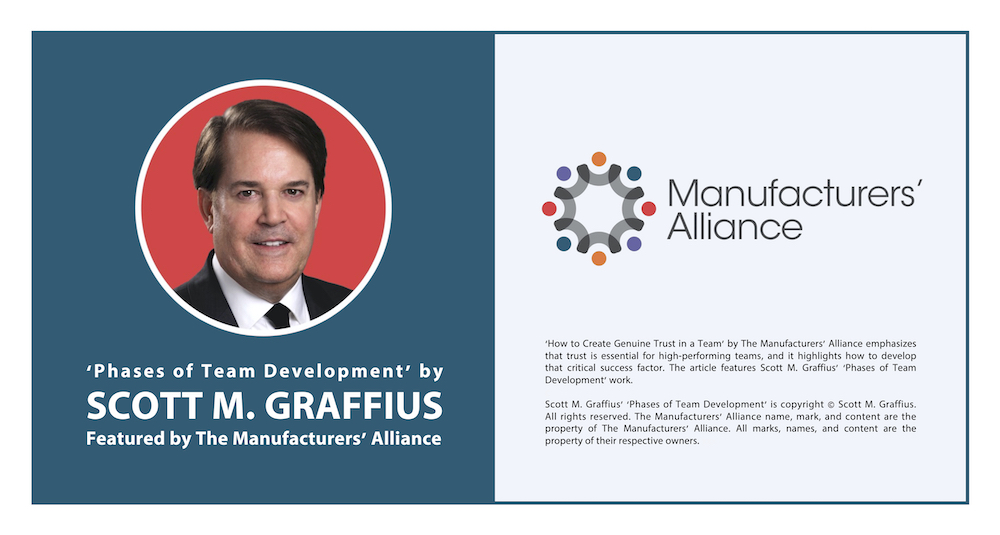
‘How to Create Genuine Trust in a Team’ by The Manufacturers’ Alliance emphasizes that trust is essential for high-performing teams, and it highlights how to develop that critical success factor. The article features Scott M. Graffius' ‘Phases of Team Development’ work.
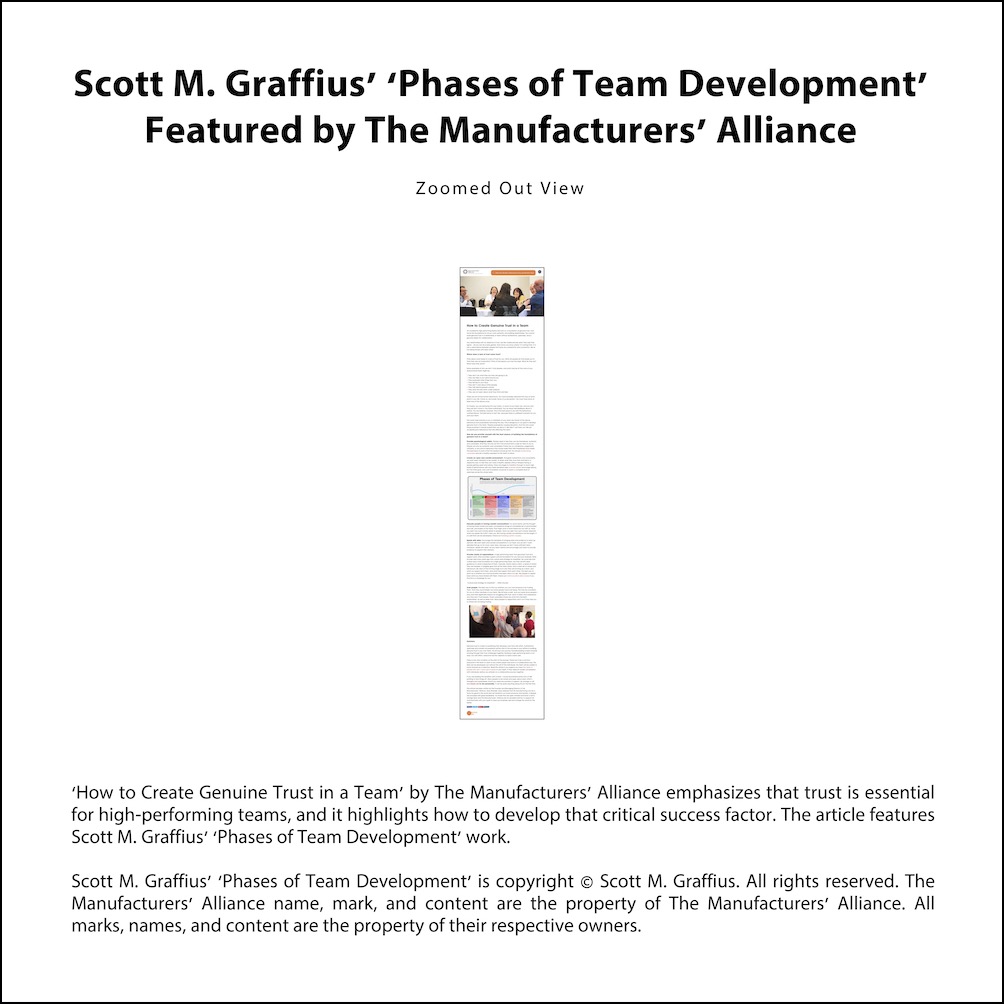
A zoomed out image is shown above.
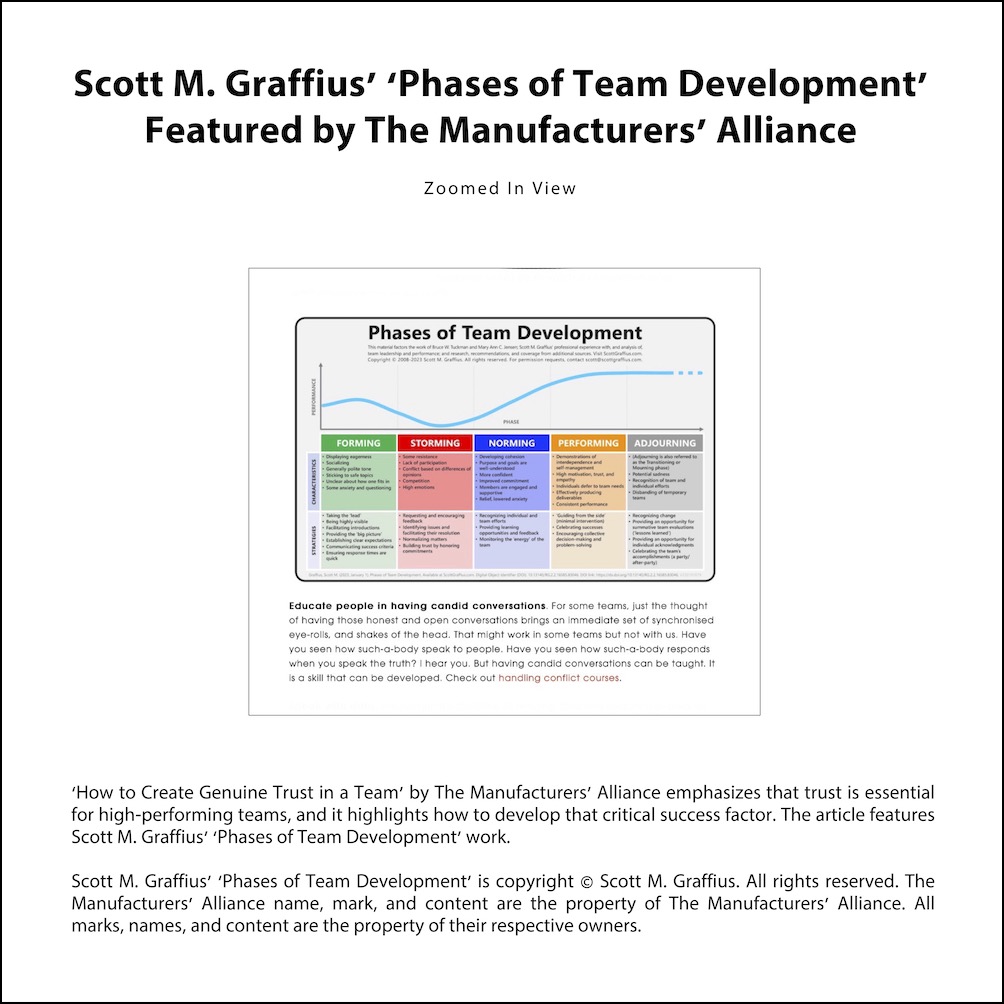
And a zoomed in visual is above.
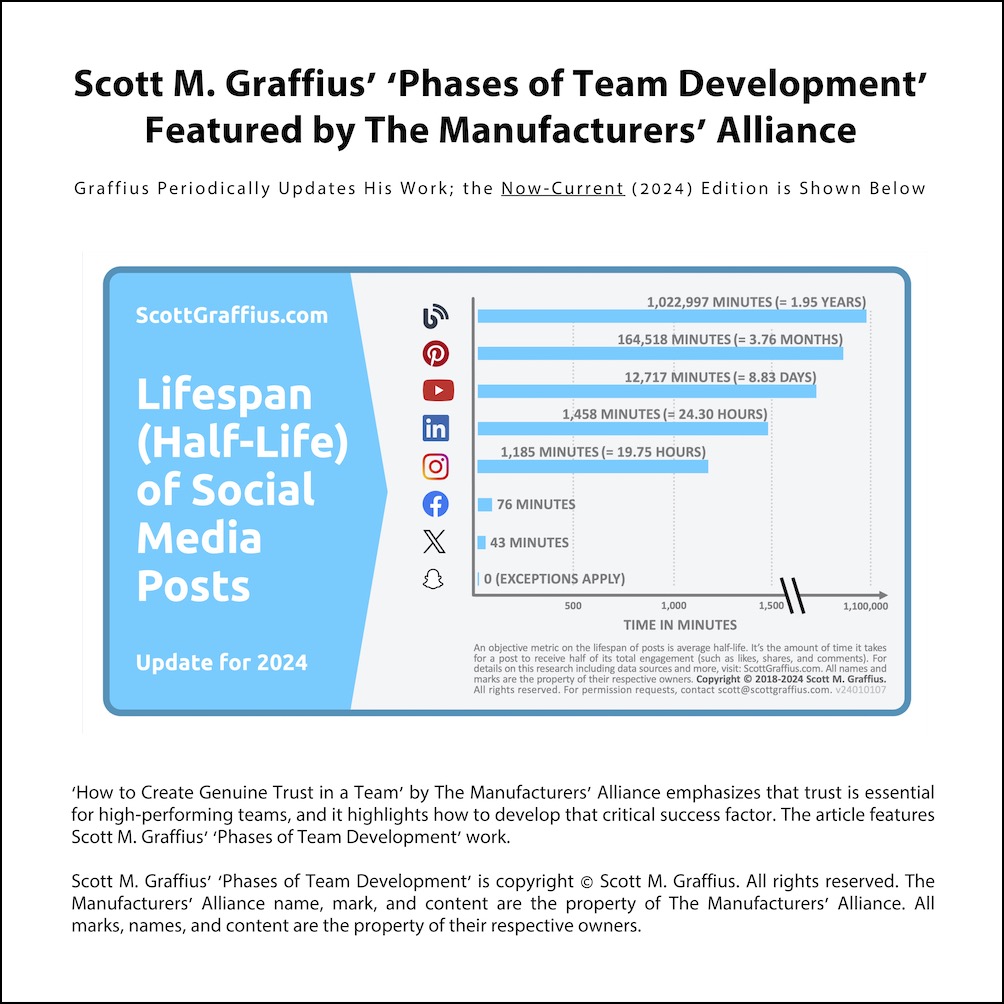
Graffius periodically updates his work. The most current (2024) edition of his 'Phases of Team Development' visual is shown above. Select here for details.
About The Manufacturers’ Alliance
The Manufacturers’ Alliance is a purpose and values-led organization that inspires manufacturing leaders to break through the boundaries of possibility. Its services are aligned with the following four distinct pillars.
- Thought Leadership Events: Its online and in-person events help ambitious manufacturing owners and leaders understand what it takes to run a great business, providing inspiration with a constant stream of new ideas.
- Peer Groups: It fosters meeting and networking with peers from the manufacturing sector.
- The Academy: This resource supports the development of leadership and management skills needed for the future of manufacturing.
- Hands-on Support: It offers help from a team of experienced business leaders with wide-ranging skills gained from decades of experience in the manufacturing sector.
Visit https://www.manufacturersalliance.co.uk to learn more.




About Scott M. Graffius

Scott M. Graffius, PMP, SA, CSP-SM, CSP-PO, CSM, CSPO, SFE, ITIL, LSSGB is an agile project management practitioner, consultant, thinker, creator, multi-award-winning author, and international public speaker. Founder and CEO of Exceptional PPM and PMO Solutions™ and subsidiary Exceptional Agility™, he has generated over $1.9 billion for Global Fortune 500 businesses and other organizations he has served. Graffius and content from his books, talks, workshops, and more have been featured and used by Microsoft, Oracle, Broadcom, Cisco, Gartner, Project Management Institute, IEEE, National Academy of Sciences, United States Department of Energy, Yale University, Tufts University, and others. He delights audiences with dynamic and engaging talks and workshops on agile project management, AI, Tech leadership, video game development, strategic alignment, the science of high performance teams, and more. To date, he's presented sessions at 89 conferences and other events across 25 countries.
His full bio is available here.
Connect with Scott on:



About Agile Scrum: Your Quick Start Guide with Step-by-Step Instructions

Shifting customer needs are common in today's marketplace. Businesses must be adaptive and responsive to change while delivering an exceptional customer experience to be competitive.
There are a variety of frameworks supporting the development of products and services, and most approaches fall into one of two broad categories: traditional or agile. Traditional practices such as waterfall engage sequential development, while agile involves iterative and incremental deliverables. Organizations are increasingly embracing agile to manage projects, and best meet their business needs of rapid response to change, fast delivery speed, and more.
With clear and easy to follow step-by-step instructions, Scott M. Graffius's award-winning Agile Scrum: Your Quick Start Guide with Step-by-Step Instructions helps the reader:
- Implement and use the most popular agile framework―Scrum;
- Deliver products in short cycles with rapid adaptation to change, fast time-to-market, and continuous improvement; and
- Support innovation and drive competitive advantage.
Hailed by Literary Titan as “the book highlights the versatility of Scrum beautifully.”
Winner of 17 first place awards.
Agile Scrum: Your Quick Start Guide with Step-by-Step Instructions is available in paperback and ebook/Kindle in the United States and around the world. Some links by country follow.
- 🇧🇷 Brazil
- 🇨🇦 Canada
- 🇨🇿 Czech Republic
- 🇩🇰 Denmark
- 🇫🇮 Finland
- 🇫🇷 France
- 🇩🇪 Germany
- 🇬🇷 Greece
- 🇭🇺 Hungary
- 🇮🇳 India
- 🇮🇪 Ireland
- 🇮🇱 Israel
- 🇮🇹 Italy
- 🇯🇵 Japan
- 🇱🇺 Luxembourg
- 🇲🇽 Mexico
- 🇳🇱 Netherlands
- 🇳🇿 New Zealand
- 🇳🇴 Norway
- 🇪🇸 Spain
- 🇸🇪 Sweden
- 🇨🇭 Switzerland
- 🇦🇪 UAE
- 🇬🇧 United Kingdom
- 🇺🇸 United States

About Agile Transformation: A Brief Story of How an Entertainment Company Developed New Capabilities and Unlocked Business Agility to Thrive in an Era of Rapid Change

Thriving in today's marketplace frequently depends on making a transformation to become more agile. Those successful in the transition enjoy faster delivery speed and ROI, higher satisfaction, continuous improvement, and additional benefits.
Based on actual events, Agile Transformation: A Brief Story of How an Entertainment Company Developed New Capabilities and Unlocked Business Agility to Thrive in an Era of Rapid Change provides a quick (60-90 minute) read about a successful agile transformation at a multinational entertainment and media company, told from the author's perspective as an agile coach.
The award-winning book by Scott M. Graffius is available in paperback and ebook/Kindle in the United States and around the world. Some links by country follow.
- 🇦🇺 Australia
- 🇦🇹 Austria
- 🇧🇷 Brazil
- 🇨🇦 Canada
- 🇨🇿 Czech Republic
- 🇩🇰 Denmark
- 🇫🇮 Finland
- 🇫🇷 France
- 🇩🇪 Germany
- 🇬🇷 Greece
- 🇮🇳 India
- 🇮🇪 Ireland
- 🇯🇵 Japan
- 🇱🇺 Luxembourg
- 🇲🇽 Mexico
- 🇳🇱 Netherlands
- 🇳🇿 New Zealand
- 🇪🇸 Spain
- 🇸🇪 Sweden
- 🇨🇭 Switzerland
- 🇦🇪 United Arab Emirates
- 🇬🇧 United Kingdom
- 🇺🇸 United States

The short link for this article is: https://bit.ly/trust-sg
© Copyright 2024 Scott M. Graffius. All rights reserved. This material may not be published, broadcast, rewritten or redistributed without the express written permission of Scott M. Graffius.

The Five Most Popular Talks and Workshops
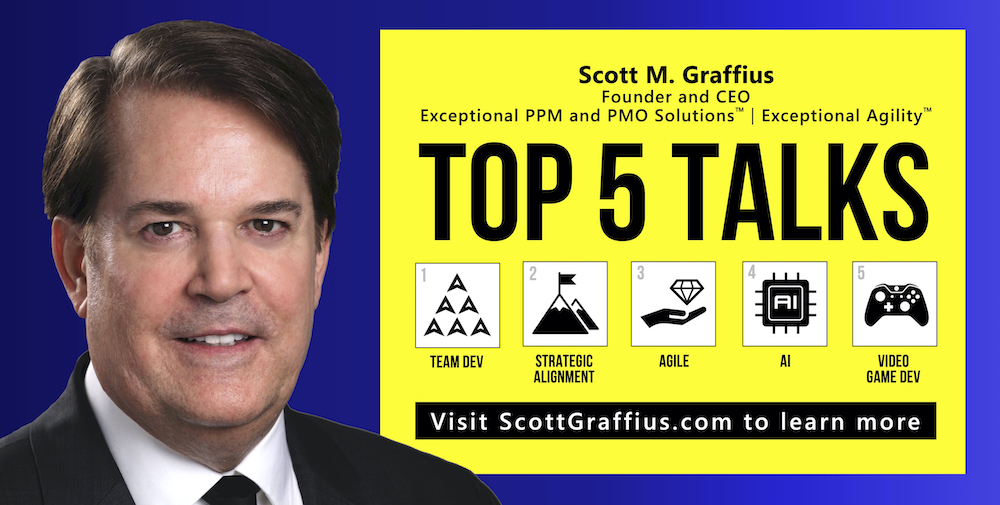
Scott M. Graffius is an Agile project management practitioner, consultant, thinker, creator, award-winning author, and international public speaker. Content from his books, talks, and more have been featured and used by Microsoft, Oracle, Cisco, Project Management Institute, IEEE, National Academy of Sciences, Yale University, Adobe, Torrens University Australia, UK Sports Institute, Amsterdam Public Health Research Institute, Boston University, Bayer, Hasso Plattner Institute, University of Galway Ireland, United States National Park Service, and others.
Conference organizers, businesses, professional associations, government agencies, and universities invite him to speak on topics at the intersection of Agile Project Management, Business, and Technology. To date, Graffius has presented talks and workshops at 89 conferences and other events across 25 countries. He uses everyday language and vibrant custom content to make complex topics clear and understandable, and he provides audiences with practical information they can use. His sessions are highly rated by attendees and organizers alike.
The top five talks and workshop topics are highlighted next.

High Performance Teams
High Performance Teams is first on the list. Scott customizes each session to the audience and other factors, so each one is unique. The following provides a general overview.
- Title: Talks or workshops on High Performance Teams may be called “Navigate the Phases of Team Development with Speed and Agility” or “Want Happier and More Productive Teams?” or another title.
- Description: Help your teams go farther, faster! Perhaps you’re heard about the phases of team development: Forming, Storming, Norming, Performing, and Adjourning. But are you aware of the unique behaviors specific to each phase? What exactly should you do during each phase to help the team (Agile or otherwise) tackle challenges, make progress, and become successful? If you are a leader (or aspire to be one), a member of a team (or may be in one in the future), or are just looking to develop your skills, this talk (with a fresh angle: 0% theory, 100% real-world-based) will give you a practical framework with actionable tips for working in and leading teams successfully. You'll learn about the five phases—Forming, Storming, Norming, Performing, and Adjourning—including detailed descriptions of each along with proven strategies for addressing challenges or issues which may occur along the way. You'll understand how to use the model to your advantage by effectively navigating all of the phases with speed and agility, from team set-up to the after-party! The presentation draws on the speaker’s first-hand, real-world experience, with his guidance supported by additional research, recommendations, and coverage from the Project Management Institute, IEEE, Google, NASA, and others.
- Key learning benefits: This talk will help you develop and enhance the contributions you make to your organization by being able to: (1) Understand the five stages of team development: Forming, Storming, Norming, Performing, and Adjourning. (2) Learn the characteristics of each phase. (3) Apply proven strategies to help handle challenges or issues experienced by the team. By doing so, you'll advance the team's happiness, productivity, and success.
- Information sheet: https://scottgraffius.com/resources/Scott-M-Graffius---Public-Speaker---Example-Session---Team-Development---v24012907.pdf.

Strategic Alignment
Strategic Alignment is second on the list of the top five topics. Scott customizes each session to the audience and other factors, so each one is unique. A general overview follows.
- Title: Talks or workshops on Strategic Alignment may be called “10 Ways to Score and Prioritize Project Proposals Based on Multiple Factors, Including Strategic Alignment” or “10 Ways to Achieve and Sustain Strategic Alignment” or another title.
- Description: How does your organization assess proposals for new projects? Is there a well-defined scoring and prioritization process—based on alignment with the business’ strategic objectives and other key factors—to quickly and easily identify the objective value of each proposal (including how important it is relative to other initiatives)? If the answer is “no,” keep reading. If the answer is “yes,” you are likely to find practical information and examples in this talk to adapt and adopt to improve the process at your organization.
- Key learning benefits: This talk will help you develop and enhance the contributions you make to your organization by being able to: (1) Understand the benefits of scoring and prioritizing project proposals based on strategic alignment and other key factors. (2) Identify selection and prioritization criteria appropriate for your unique organization, leveraging the flexible framework and some or all of the 10 factors presented during the talk. (3) Put the practical, actionable information presented to use. During the session, we will run an example project proposal through the process, step-by-step. And you will receive a summary "cheat sheet" digital download that you can reference as a guide to help implement or improve this process at your organization.
- Information sheet: https://scottgraffius.com/resources/Scott-M-Graffius---Public-Speaker---Example-Session---10-Ways-Strategic-Alignment---v24012907.pdf.

Agile
Agile is third on the list of the top five topics. Scott customizes each session to the audience and other factors, so each one is unique. A general overview follows.
- Title: Talks or workshops on Agile may be called “Are You Realizing All the Benefits from Agile?” or “Agile Scrum Helps Innovators, Disruptors, and Entrepreneurs Develop and Deliver Products at Astounding Speed Which Drives Competitive Advantage” or another title.
- Description: Organizations are increasingly embracing Agile to best meet their shifting business needs and successfully manage projects. Potential business benefits from Agile include faster delivery and ROI, rapid response to change, higher satisfaction, and continuous improvement. All of which supports innovation and helps drive competitive advantage. Are you realizing all of the benefits? This session will cover the full lifecycle of the most popular Agile approach, Scrum. You will be presented with practical information including top factors from successful implementations—based on the speaker's first-hand experience and 116 sources, including the PMI, IEEE, Google, Agile Alliance, and others—you can use to gain more benefits from Agile.
- Key learning benefits: How you will benefit: (1) Gain a high-level understanding of the Scrum framework-from vision through release. (2) Learn the roles, responsibilities, tools, and techniques unique to Scrum. (3) All of which are inclusive of top factors from successful implementations, which you can put to use to help you get more benefits from Agile.
- Information sheet: https://scottgraffius.com/resources/Scott-M-Graffius---Public-Speaker---Example-Session---Agile-Benefits---v24012907.pdf.

AI Development
Successful AI Development is fourth on the list of the top five topics. Scott customizes each session to the audience and other factors, so each one is unique. A general overview follows.
- Title: Talks or workshops on Successful AI Development may be called “What Successful AI Development Teams Have in Common” or “Fueling the Development of Innovative and Life-Changing AI Solutions” or another title.
- Description: Artificial Intelligence has emerged as a transformative force across a growing number of industries, revolutionizing how we live, work, and interact. From improved medical diagnoses to self-driving cars, and more, AI systems have become integral to our daily lives. Behind these cutting-edge, life-changing solutions are AI teams with a combination of skills. This session reveals exactly how the fusion of technical skills and soft skills within AI teams fuels the successful development of innovative and effective solutions. Informed by “In the AI era, soft skills are the new hard skills” (from Artificial Intelligence and Its Impact on Business), “Soft skills are becoming a key focus” (from Computerworld), “Don’t underestimate the power of a team dynamic – your product becomes the result of it” (from Microsoft), and “Competencies like teamwork are crucial” (from MIT), this talk also delivers a deep-dive on essential team development skills based on the science of high-performing teams. Scott’s talk draws from his work with AI development teams as well as research and coverage from the Association for the Advancement of Artificial Intelligence, Google, IBM, IEEE, Microsoft, Software Engineering Institute, and many others. The usable information can provide you, your teams, and your organization with a competitive advantage.
- Key learning benefits: How you will benefit: (1) Understand technical skills and soft skills leveraged by successful AI teams to develop innovative and effective solutions. (2) Understand the essential team development skills based on the science of high-performing teams. (3) Understand specific techniques including how to apply them to advance the happiness, productivity, and success of teams.
- Information sheet: https://scottgraffius.com/resources/Scott-M-Graffius---Public-Speaker---Example-Session---AI---v24012907.pdf.

Video Game Development
Successful Video Game Development is fifth on the list of the top five topics. Scott customizes each session to the audience and other factors, so each one is unique. A general overview follows.
- Title: Talks or workshops on Successful Video Game Development may be called “The Science of High-Performance Video Game Development Teams” or “Level-Up Your Team: Science-Backed Strategies for High-Performance Video Game Development” or another title.
- Description: Behind every great video game is a team of creative and technical wizards. Creators, storytellers, designers, artists, developers, testers, and others collaborate and leverage a diverse range of hard skills (also known as technical skills) and soft skills (also known as interpersonal skills) to craft an exceptional end-product. Of the many skills, one — a soft skill — is paramount. Activision Blizzard and other premiere developers and publishers of entertainment experiences identify teamwork as critical for the successful development of video games. Informed by Scott’s first-hand work with video game development teams as well as research and coverage from Activision Blizzard, Gameloft, International Game Developers Association, Microsoft, Rockstar Games, Sony Interactive Entertainment, Ubisoft, and others, this talk delivers a deep-dive on the essential teamwork skill based on the science of high- performing teams. The information can provide you, your teams, and your organization with a competitive advantage!
- Key learning benefits: How you will benefit: (1) Understand that a confluence of both hard skills and soft skills (notably, teamwork) are crucial. (2) Learn the five phases of team development and recognize the identifiable characteristics of each phase. (3) Learn how to apply strategies to improve teams' efficacy, happiness, and success.
- Information sheet: https://scottgraffius.com/resources/Scott-M-Graffius---Public-Speaker---Example-Session---Video-Game-Development---v24012907.pdf.
Those are the top five topics for talks and workshops.

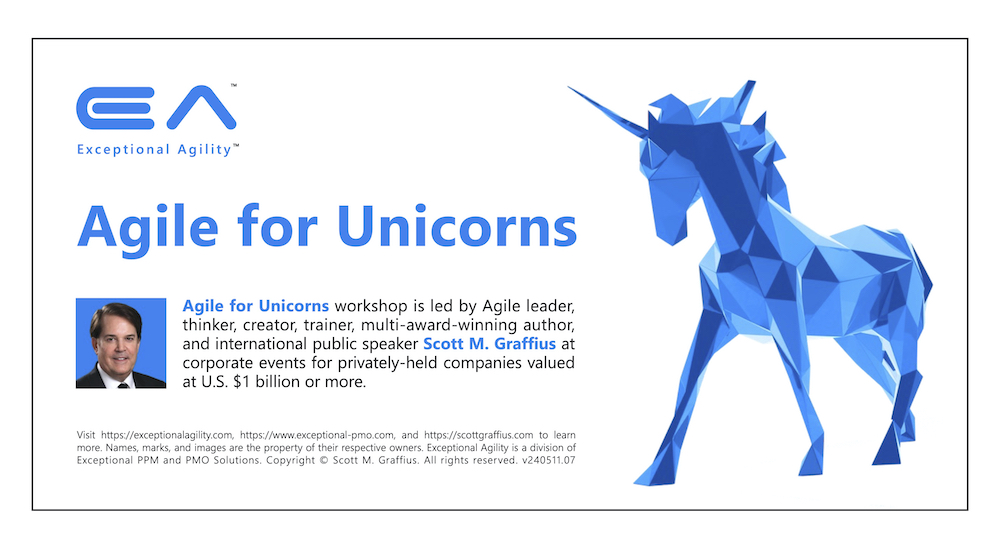
Before concluding this article, we’ll also point out a new topic which is becoming increasingly popular. It’s “Agile for Unicorns.” This session is limited to corporate events for privately-held companies valued at US $1 billion or more. To learn more, check out the information sheet: https://scottgraffius.com/resources/Scott-M-Graffius---Public-Speaker---Example-Session---Agile-for-Unicorns---v24012907.pdf.
Visit Scott’s Public Speaker page for a detailed listing of events, testimonials, and more.
Scott speaks around the world. To book him for your conference or other event, complete a speaker engagement request form or email him.




About Scott M. Graffius

Scott M. Graffius, PMP, SA, CSP-SM, CSP-PO, CSM, CSPO, SFE, ITIL, LSSGB is an agile project management practitioner, consultant, thinker, creator, multi-award-winning author, and international public speaker. Founder and CEO of Exceptional PPM and PMO Solutions™ and subsidiary Exceptional Agility™, he has generated over $1.9 billion for Global Fortune 500 businesses and other organizations he has served. Graffius and content from his books, talks, workshops, and more have been featured and used by Microsoft, Oracle, Broadcom, Cisco, Gartner, Project Management Institute, IEEE, National Academy of Sciences, United States Department of Energy, Yale University, Tufts University, and others. He delights audiences with dynamic and engaging talks and workshops on agile project management, AI, Tech leadership, video game development, strategic alignment, the science of high performance teams, and more. To date, he's presented sessions at 89 conferences and other events across 25 countries.
His full bio is available here.
Connect with Scott on:



About Agile Scrum: Your Quick Start Guide with Step-by-Step Instructions

Shifting customer needs are common in today's marketplace. Businesses must be adaptive and responsive to change while delivering an exceptional customer experience to be competitive.
There are a variety of frameworks supporting the development of products and services, and most approaches fall into one of two broad categories: traditional or agile. Traditional practices such as waterfall engage sequential development, while agile involves iterative and incremental deliverables. Organizations are increasingly embracing agile to manage projects, and best meet their business needs of rapid response to change, fast delivery speed, and more.
With clear and easy to follow step-by-step instructions, Scott M. Graffius's award-winning Agile Scrum: Your Quick Start Guide with Step-by-Step Instructions helps the reader:
- Implement and use the most popular agile framework―Scrum;
- Deliver products in short cycles with rapid adaptation to change, fast time-to-market, and continuous improvement; and
- Support innovation and drive competitive advantage.
Hailed by Literary Titan as “the book highlights the versatility of Scrum beautifully.”
Winner of 17 first place awards.
Agile Scrum: Your Quick Start Guide with Step-by-Step Instructions is available in paperback and ebook/Kindle in the United States and around the world. Some links by country follow.
- 🇧🇷 Brazil
- 🇨🇦 Canada
- 🇨🇿 Czech Republic
- 🇩🇰 Denmark
- 🇫🇮 Finland
- 🇫🇷 France
- 🇩🇪 Germany
- 🇬🇷 Greece
- 🇭🇺 Hungary
- 🇮🇳 India
- 🇮🇪 Ireland
- 🇮🇱 Israel
- 🇮🇹 Italy
- 🇯🇵 Japan
- 🇱🇺 Luxembourg
- 🇲🇽 Mexico
- 🇳🇱 Netherlands
- 🇳🇿 New Zealand
- 🇳🇴 Norway
- 🇪🇸 Spain
- 🇸🇪 Sweden
- 🇨🇭 Switzerland
- 🇦🇪 UAE
- 🇬🇧 United Kingdom
- 🇺🇸 United States

About Agile Transformation: A Brief Story of How an Entertainment Company Developed New Capabilities and Unlocked Business Agility to Thrive in an Era of Rapid Change

Thriving in today's marketplace frequently depends on making a transformation to become more agile. Those successful in the transition enjoy faster delivery speed and ROI, higher satisfaction, continuous improvement, and additional benefits.
Based on actual events, Agile Transformation: A Brief Story of How an Entertainment Company Developed New Capabilities and Unlocked Business Agility to Thrive in an Era of Rapid Change provides a quick (60-90 minute) read about a successful agile transformation at a multinational entertainment and media company, told from the author's perspective as an agile coach.
The award-winning book by Scott M. Graffius is available in paperback and ebook/Kindle in the United States and around the world. Some links by country follow.
- 🇦🇺 Australia
- 🇦🇹 Austria
- 🇧🇷 Brazil
- 🇨🇦 Canada
- 🇨🇿 Czech Republic
- 🇩🇰 Denmark
- 🇫🇮 Finland
- 🇫🇷 France
- 🇩🇪 Germany
- 🇬🇷 Greece
- 🇮🇳 India
- 🇮🇪 Ireland
- 🇯🇵 Japan
- 🇱🇺 Luxembourg
- 🇲🇽 Mexico
- 🇳🇱 Netherlands
- 🇳🇿 New Zealand
- 🇪🇸 Spain
- 🇸🇪 Sweden
- 🇨🇭 Switzerland
- 🇦🇪 United Arab Emirates
- 🇬🇧 United Kingdom
- 🇺🇸 United States

© Copyright 2024 Scott M. Graffius. All rights reserved. This material may not be published, broadcast, rewritten or redistributed without the express written permission of Scott M. Graffius.

University of California, San Diego Features Scott M. Graffius’ ‘Phases of Team Development’ Work

The University of California, San Diego (UCSD) Rady School of Management features Scott M. Graffius’ ‘Phases of Team Development’ work in MGT 173 Project Management.
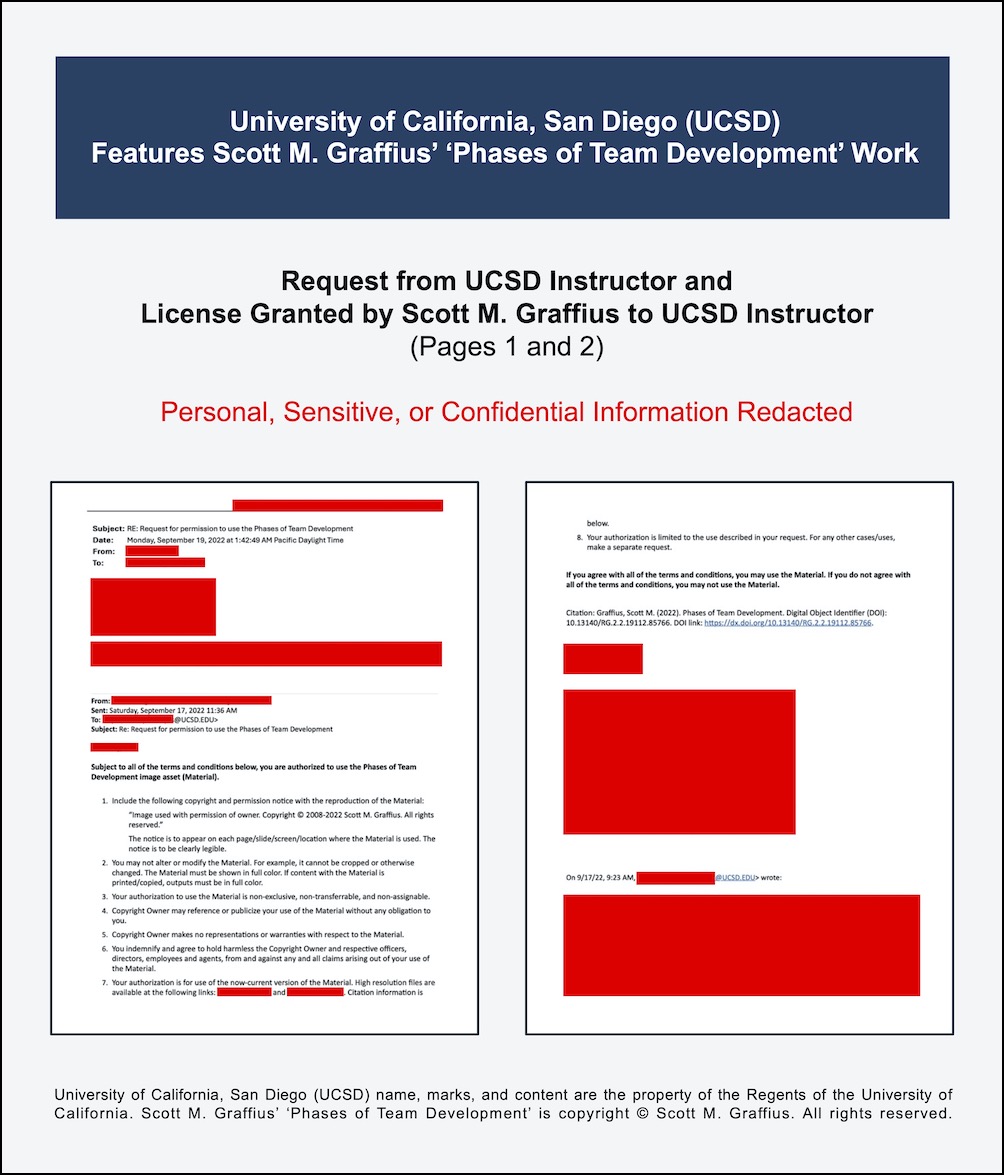
The request for, and the granting of, a license for Graffius’ copyrighted ‘Phases of Team Development’ is shown above.
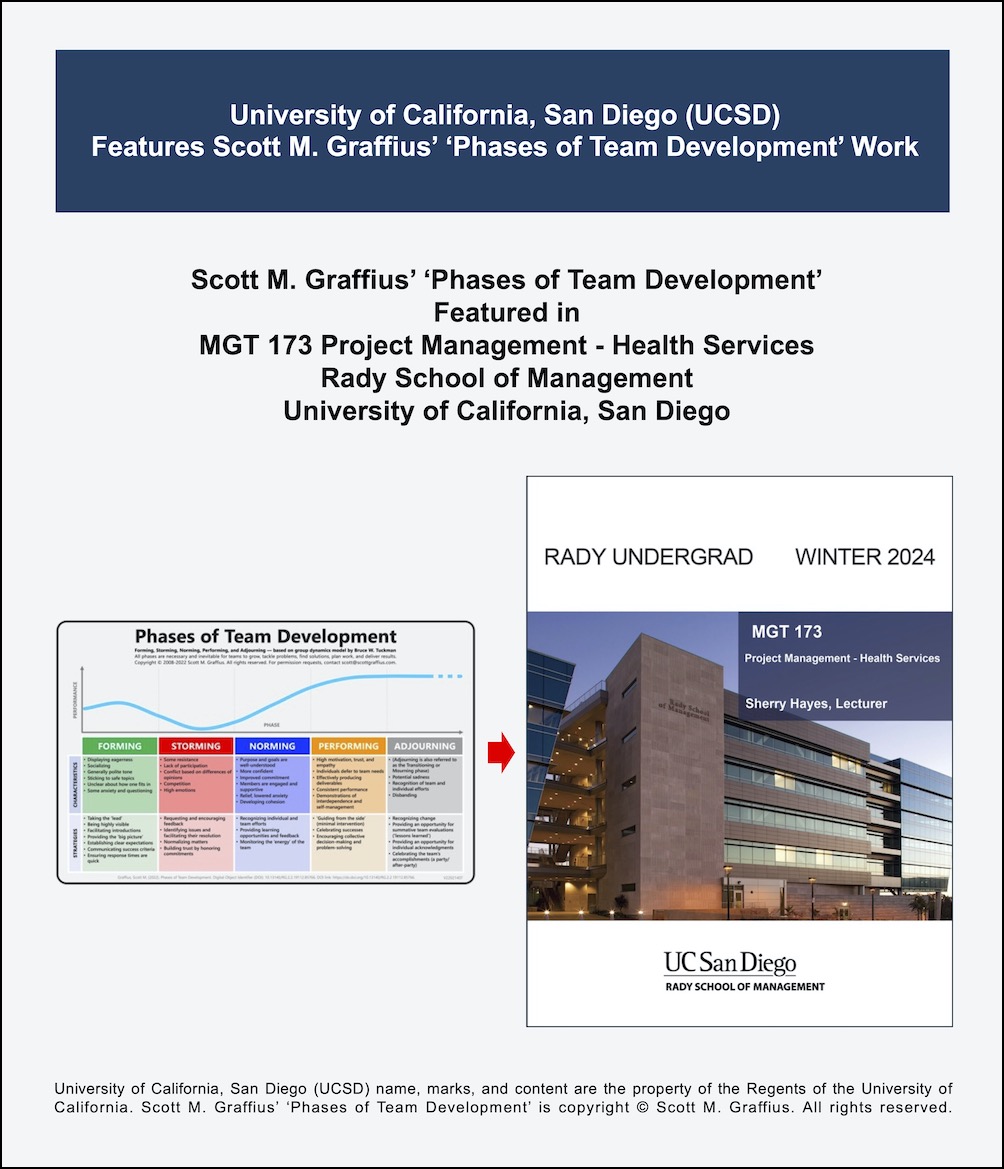
Graffius’ ‘Phases of Team Development’ work and the respective UCSD course are shown above.
About Graffius’ ‘Phases of Team Development’
Informed by the research of Bruce W. Tuckman and Mary Ann C. Jensen, over 100 subsequent studies, and Scott M. Graffius’ first-hand professional experience with, and analysis of, team leadership and performance, Graffius created his ‘Phases of Team Development’ as a unique perspective and visual conveying the five phases of team development — Forming, Storming, Norming, Performing, and Adjourning — inclusive of a graph showing how performance varies by phase, as well as the characteristics and strategies for each phase.
Project Managers, Scrum Masters, Agile Coaches, DevOps Leads, and other leaders can apply the information to help handle challenges or issues experienced by teams. By doing so, they’ll advance the teams’ (and their own) happiness, productivity, and success.
With permission/a license from Graffius, his ‘Phases of Team Development’ work is used by businesses, professional associations, government agencies, and universities around the world. Examples include Yale University, IEEE, Torrens University Australia, UK Sports Institute, Adobe, Amsterdam Public Health Research Institute, Academic Cooperation Association, Boston University, U.S. National Park Service, Bayer, Hasso Plattner Institute, New Zealand Government, University of Galway Ireland, and many more.
Graffius initially developed his unique material in 2008, and he periodically refreshes it. The most current (2024) edition of his work is here.
Graffius has presented talks and workshops at 89 conferences and other events across 25 countries. While each session is unique, the top topic is high performance teams. In those sessions, he leverages and expands upon on his ‘Phases of Team Development’ work. Sessions are dynamic, engaging, and packed with fresh insights and usable information. They’re highly rated by attendees and organizers alike. To book him for your conference or other event, complete a speaker engagement request form or email him.
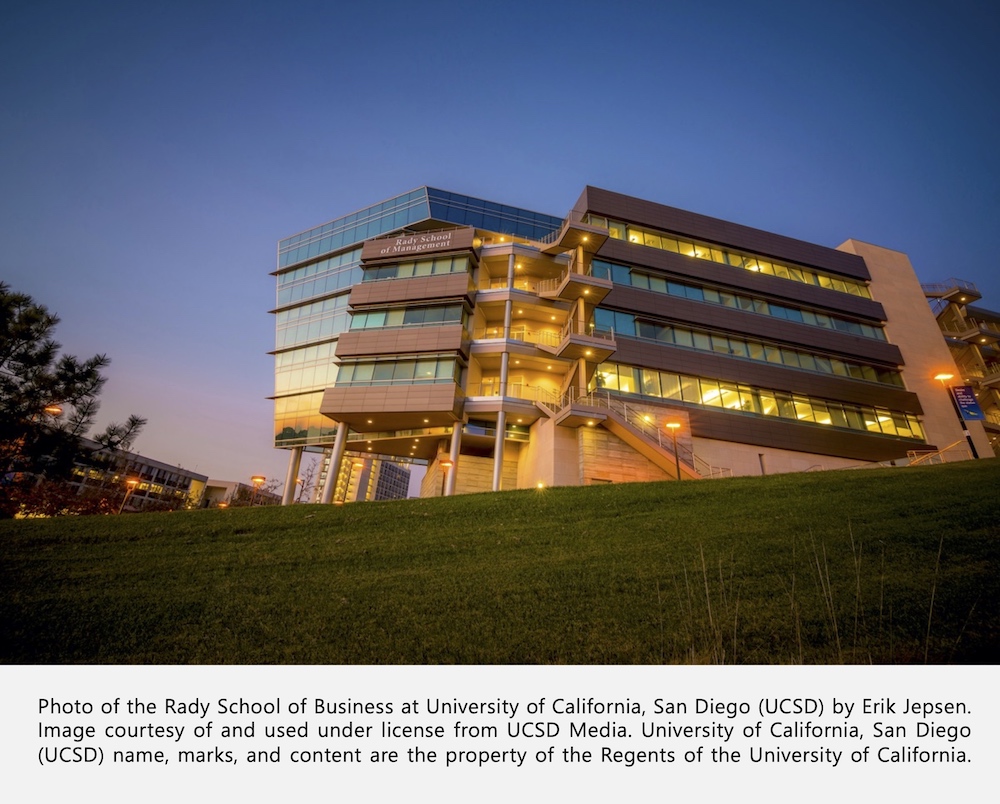
About UCSD Rady School of Management Course - MGT 173 Project Management
UCSD describes MGT 173 Project Management at https://catalog.ucsd.edu/courses/MGT.html as: "This course covers efficient techniques for managing health services projects, including both the technical aspects of project management as well as the human-capital management issues associated with blending administrative and technical staff with health-care professionals. Topics include scheduling methods, milestone setting, governmental regulations, resource allocation, interpersonal skills, and performing research and development projects—all with a health services focus."
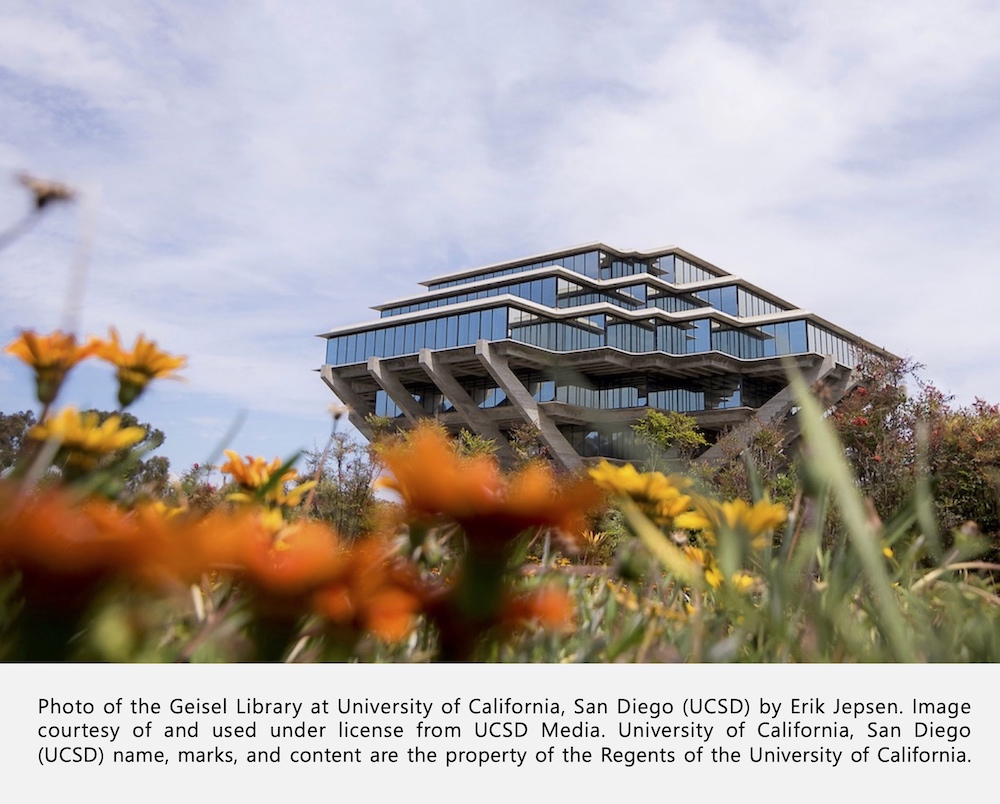
About UCSD
Recognized as one of the top 20 research universities worldwide, the University of California, San Diego (UCSD) culture of collaboration sparks discoveries that advance society and drive economic impact. UCSD is considered a Public Ivy—a public university perceived to provide a collegiate experience on the level of Ivy League universities. Its faculty, researchers, and alumni have won 27 Nobel Prizes as well as 3 Fields Medals, 8 National Medals of Science, 8 MacArthur Fellowships, and 3 Pulitzer Prizes. Additionally, of the current faculty, 29 have been elected to the National Academy of Engineering, 70 to the National Academy of Sciences, 45 to the Institute of Medicine, and 110 to the American Academy of Arts and Sciences. Visit https://ucsd.edu to learn more.




About Scott M. Graffius

Scott M. Graffius, PMP, SA, CSP-SM, CSP-PO, CSM, CSPO, ITIL, LSSGB is an agile project management practitioner, consultant, thinker, creator, multi-award-winning author, and international public speaker. Founder and CEO of Exceptional PPM and PMO Solutions™ and subsidiary Exceptional Agility™, he has generated over $1.9 billion for Global Fortune 500 businesses and other organizations he has served. Graffius and content from his books, talks, workshops, and more have been featured and used by Microsoft, Oracle, Broadcom, Cisco, Gartner, Project Management Institute, IEEE, National Academy of Sciences, United States Department of Energy, Yale University, Tufts University, and others. He delights audiences with dynamic and engaging talks and workshops on agile project management, AI, Tech leadership, video game development, strategic alignment, the science of high performance teams, and more. To date, he's presented sessions at 89 conferences and other events across 25 countries.
His full bio is available here.
Connect with Scott on:



About Agile Scrum: Your Quick Start Guide with Step-by-Step Instructions

Shifting customer needs are common in today's marketplace. Businesses must be adaptive and responsive to change while delivering an exceptional customer experience to be competitive.
There are a variety of frameworks supporting the development of products and services, and most approaches fall into one of two broad categories: traditional or agile. Traditional practices such as waterfall engage sequential development, while agile involves iterative and incremental deliverables. Organizations are increasingly embracing agile to manage projects, and best meet their business needs of rapid response to change, fast delivery speed, and more.
With clear and easy to follow step-by-step instructions, Scott M. Graffius's award-winning Agile Scrum: Your Quick Start Guide with Step-by-Step Instructions helps the reader:
- Implement and use the most popular agile framework―Scrum;
- Deliver products in short cycles with rapid adaptation to change, fast time-to-market, and continuous improvement; and
- Support innovation and drive competitive advantage.
Hailed by Literary Titan as “the book highlights the versatility of Scrum beautifully.”
Winner of 17 first place awards.
Agile Scrum: Your Quick Start Guide with Step-by-Step Instructions is available in paperback and ebook/Kindle in the United States and around the world. Some links by country follow.
- 🇧🇷 Brazil
- 🇨🇦 Canada
- 🇨🇿 Czech Republic
- 🇩🇰 Denmark
- 🇫🇮 Finland
- 🇫🇷 France
- 🇩🇪 Germany
- 🇬🇷 Greece
- 🇭🇺 Hungary
- 🇮🇳 India
- 🇮🇪 Ireland
- 🇮🇱 Israel
- 🇮🇹 Italy
- 🇯🇵 Japan
- 🇱🇺 Luxembourg
- 🇲🇽 Mexico
- 🇳🇱 Netherlands
- 🇳🇿 New Zealand
- 🇳🇴 Norway
- 🇪🇸 Spain
- 🇸🇪 Sweden
- 🇨🇭 Switzerland
- 🇦🇪 UAE
- 🇬🇧 United Kingdom
- 🇺🇸 United States

About Agile Transformation: A Brief Story of How an Entertainment Company Developed New Capabilities and Unlocked Business Agility to Thrive in an Era of Rapid Change

Thriving in today's marketplace frequently depends on making a transformation to become more agile. Those successful in the transition enjoy faster delivery speed and ROI, higher satisfaction, continuous improvement, and additional benefits.
Based on actual events, Agile Transformation: A Brief Story of How an Entertainment Company Developed New Capabilities and Unlocked Business Agility to Thrive in an Era of Rapid Change provides a quick (60-90 minute) read about a successful agile transformation at a multinational entertainment and media company, told from the author's perspective as an agile coach.
The award-winning book by Scott M. Graffius is available in paperback and ebook/Kindle in the United States and around the world. Some links by country follow.
- 🇦🇺 Australia
- 🇦🇹 Austria
- 🇧🇷 Brazil
- 🇨🇦 Canada
- 🇨🇿 Czech Republic
- 🇩🇰 Denmark
- 🇫🇮 Finland
- 🇫🇷 France
- 🇩🇪 Germany
- 🇬🇷 Greece
- 🇮🇳 India
- 🇮🇪 Ireland
- 🇯🇵 Japan
- 🇱🇺 Luxembourg
- 🇲🇽 Mexico
- 🇳🇱 Netherlands
- 🇳🇿 New Zealand
- 🇪🇸 Spain
- 🇸🇪 Sweden
- 🇨🇭 Switzerland
- 🇦🇪 United Arab Emirates
- 🇬🇧 United Kingdom
- 🇺🇸 United States

The short link for this article is: https://bit.ly/ucsd-173
© Copyright 2024 Scott M. Graffius. All rights reserved. This material may not be published, broadcast, rewritten or redistributed without the express written permission of Scott M. Graffius.

Ford Features Scott M. Graffius' 'Phases of Team Development' Work
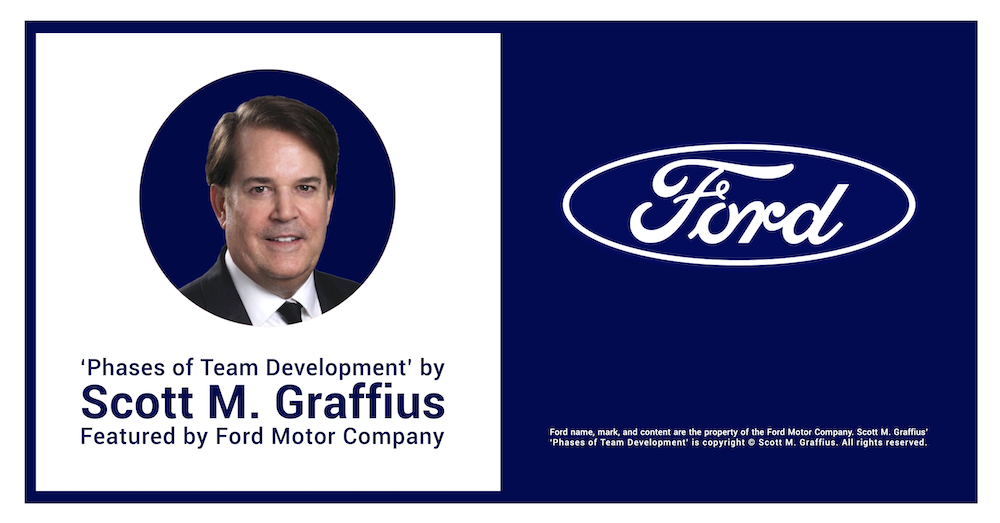

With a license from Scott M. Graffius, his copyrighted ‘Phases of Team Development’ work is featured and used by businesses, professional associations, government agencies, and universities around the world. Examples include Yale University, IEEE, Constructor Institute (Switzerland), Adobe, Boston University, Amsterdam Public Health Research Institute, United States National Park Service, Bayer, University of Galway (Ireland), Hasso Plattner Institute (Germany), American Management Association, UC San Diego, and many more.
Ford was added to the list.
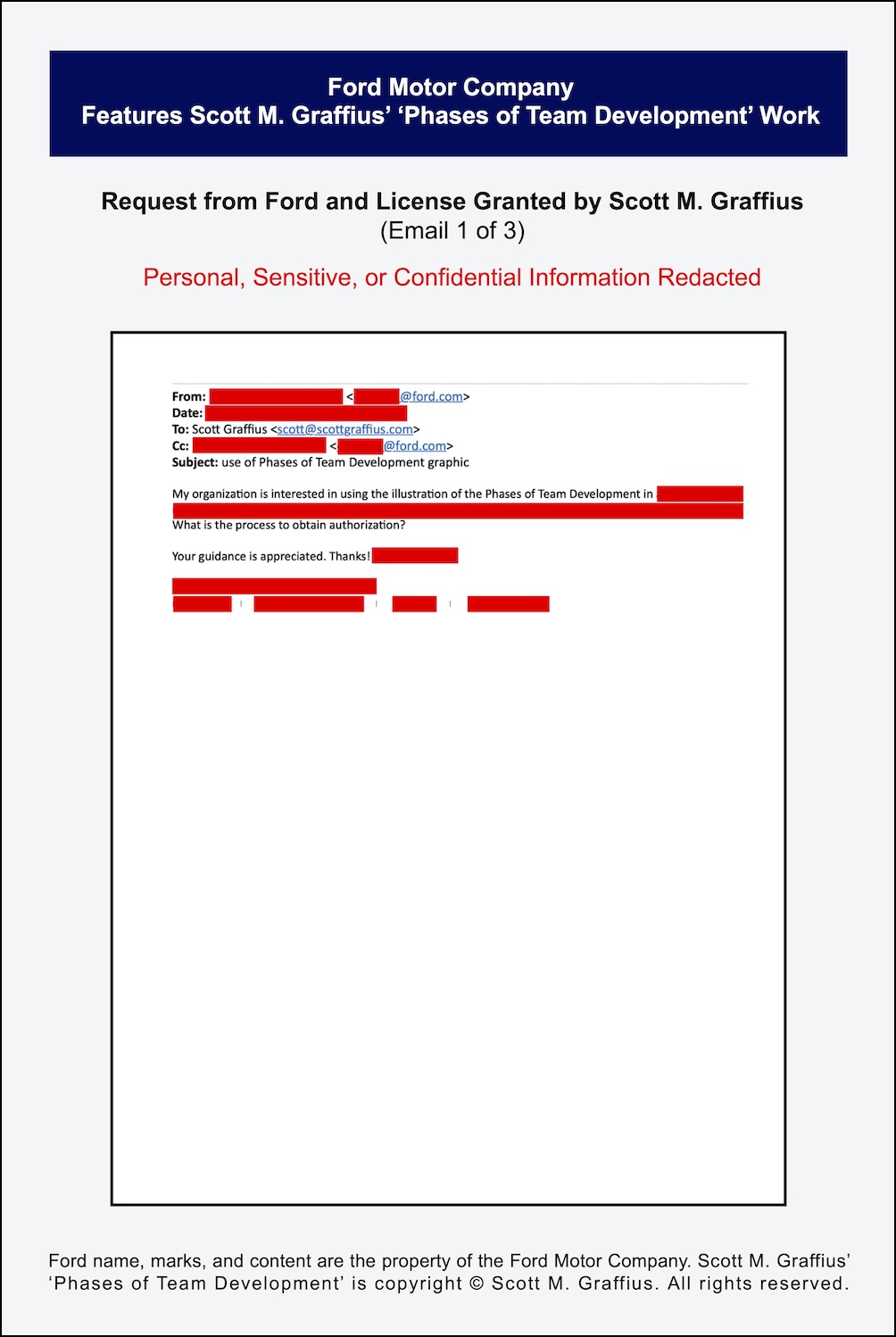
Email 1 of 3 is shown above.
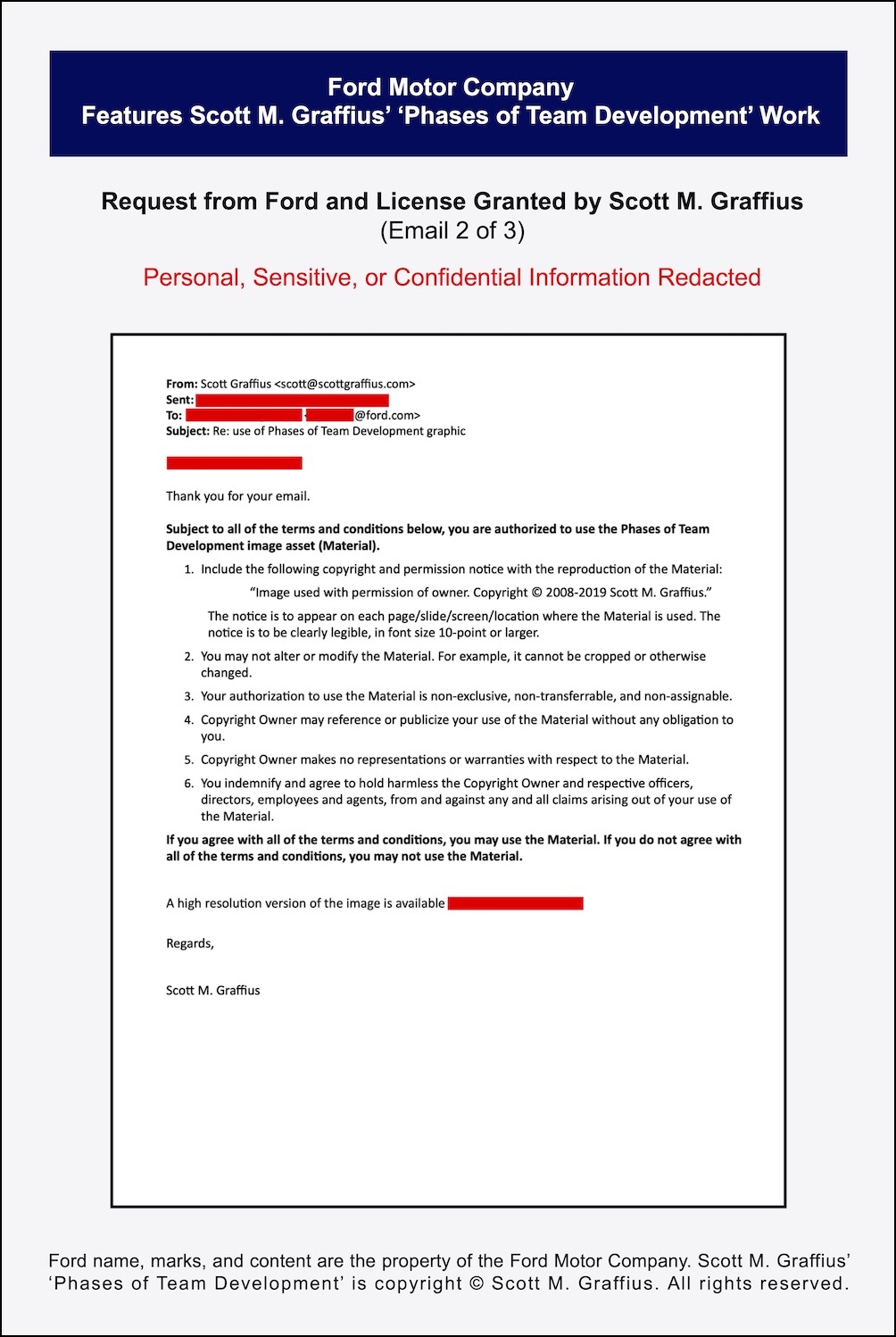
Email 2 of 3 is shown above.
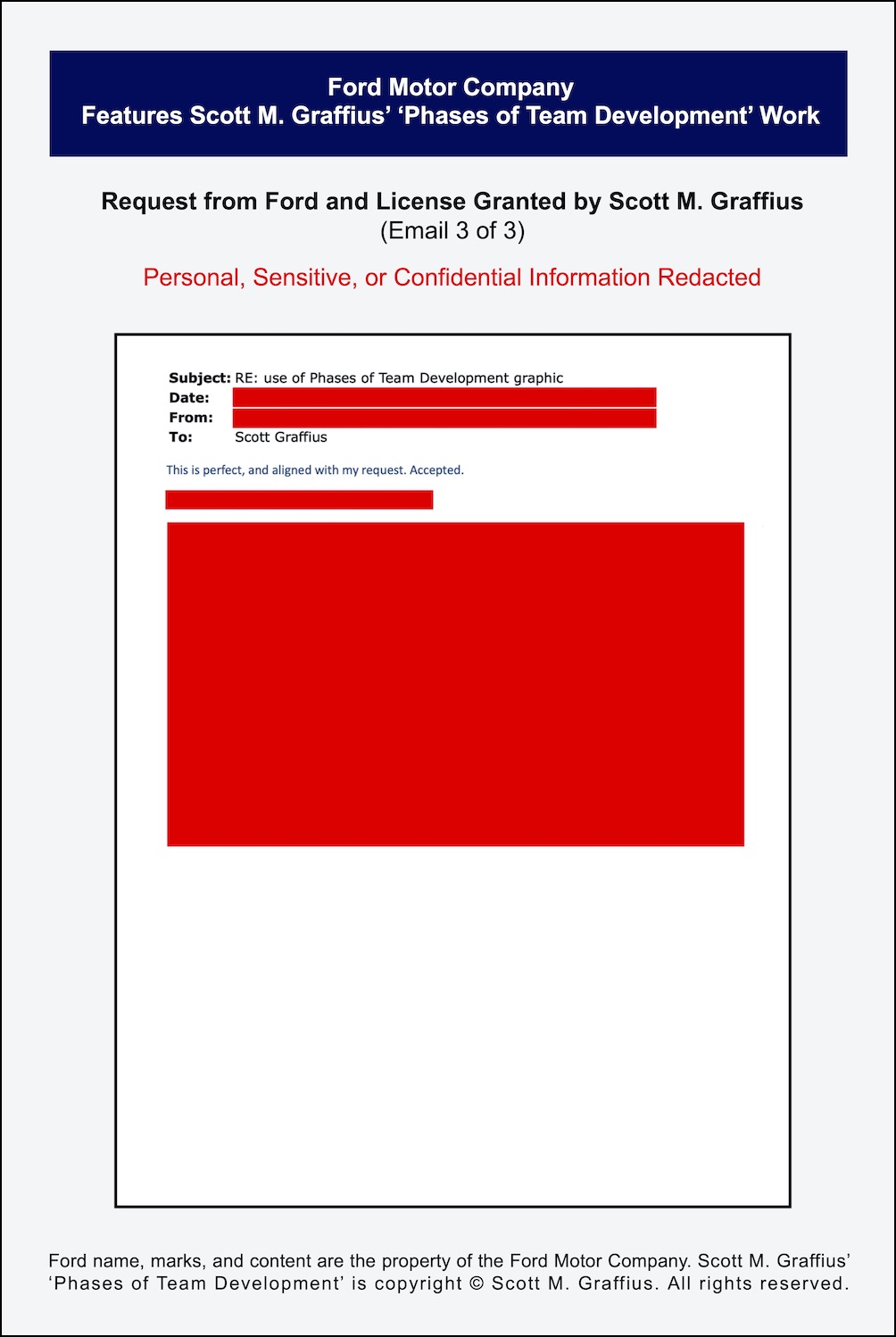
Email 3 of 3 is shown above.
More Information on Graffius' 'Phases of Team Development'
Informed by the research of Bruce W. Tuckman and Mary Ann C. Jensen, over 100 subsequent studies, and Scott M. Graffius' first-hand professional experience with, and analysis of, team leadership and performance, Graffius created his ‘Phases of Team Development.’ It’s a unique perspective and visual conveying the five phases of team development — Forming, Storming, Norming, Performing, and Adjourning. It’s also inclusive of a graph showing how performance varies by phase, as well as the characteristics and strategies for each phase.
Leaders of teams — Project Managers, Scrum Masters, Agile Coaches, DevOps Leads, and others — can apply the information to help handle challenges or issues experienced by teams. By doing so, they’ll advance the teams’ (and their own) happiness, productivity, and success.
Graffius initially developed the material in 2008, and he periodically refreshes it. For details on the current (2024) edition including permission request information, high resolution files, and more, visit here.
Graffius has presented talks and workshops at 89 conferences and other events across 25 countries. While each session is unique, the top topic is high performance teams. In those sessions, he expands upon on his ‘Phases of Team Development’ work. Sessions are dynamic, engaging, and packed with fresh insights and usable information. They’re highly rated by attendees and organizers alike. Visit here to learn more.
About Ford
Ford Motor Company is a multinational automobile manufacturer headquartered in Dearborn, Michigan, United States. It was founded by Henry Ford and incorporated on June 16, 1903. Ford develops and delivers Ford trucks, sport utility vehicles, commercial vans and cars, and Lincoln luxury vehicles. The company does that through three customer-centered business segments: Ford Blue, engineering gas-powered and hybrid vehicles; Ford Model e, developing electric vehicles (EVs); and Ford Pro, helping commercial customers transform and expand their businesses with vehicles and services tailored to their needs. Additionally, Ford provides financial services through Ford Motor Credit Company. Ford employs about 177,000 people worldwide. More information about the company and its products and services is available at https://corporate.ford.com.




About Scott M. Graffius

Scott M. Graffius, PMP, SA, CSP-SM, CSP-PO, CSM, CSPO, ITIL, LSSGB is an agile project management practitioner, consultant, thinker, creator, multi-award-winning author, and international public speaker. Founder and CEO of Exceptional PPM and PMO Solutions™ and subsidiary Exceptional Agility™, he has generated over $1.9 billion for Global Fortune 500 businesses and other organizations he has served. Graffius and content from his books, talks, workshops, and more have been featured and used by Microsoft, Oracle, Broadcom, Cisco, Gartner, Project Management Institute, IEEE, National Academy of Sciences, United States Department of Energy, Yale University, Tufts University, and others. He delights audiences with dynamic and engaging talks and workshops on agile project management, AI, Tech leadership, video game development, strategic alignment, the science of high performance teams, and more. To date, he's presented sessions at 89 conferences and other events across 25 countries.
His full bio is available here.
Connect with Scott on:



About Agile Scrum: Your Quick Start Guide with Step-by-Step Instructions

Shifting customer needs are common in today's marketplace. Businesses must be adaptive and responsive to change while delivering an exceptional customer experience to be competitive.
There are a variety of frameworks supporting the development of products and services, and most approaches fall into one of two broad categories: traditional or agile. Traditional practices such as waterfall engage sequential development, while agile involves iterative and incremental deliverables. Organizations are increasingly embracing agile to manage projects, and best meet their business needs of rapid response to change, fast delivery speed, and more.
With clear and easy to follow step-by-step instructions, Scott M. Graffius's award-winning Agile Scrum: Your Quick Start Guide with Step-by-Step Instructions helps the reader:
- Implement and use the most popular agile framework―Scrum;
- Deliver products in short cycles with rapid adaptation to change, fast time-to-market, and continuous improvement; and
- Support innovation and drive competitive advantage.
Hailed by Literary Titan as “the book highlights the versatility of Scrum beautifully.”
Winner of 17 first place awards.
Agile Scrum: Your Quick Start Guide with Step-by-Step Instructions is available in paperback and ebook/Kindle in the United States and around the world. Some links by country follow.
- 🇧🇷 Brazil
- 🇨🇦 Canada
- 🇨🇿 Czech Republic
- 🇩🇰 Denmark
- 🇫🇮 Finland
- 🇫🇷 France
- 🇩🇪 Germany
- 🇬🇷 Greece
- 🇭🇺 Hungary
- 🇮🇳 India
- 🇮🇪 Ireland
- 🇮🇱 Israel
- 🇮🇹 Italy
- 🇯🇵 Japan
- 🇱🇺 Luxembourg
- 🇲🇽 Mexico
- 🇳🇱 Netherlands
- 🇳🇿 New Zealand
- 🇳🇴 Norway
- 🇪🇸 Spain
- 🇸🇪 Sweden
- 🇨🇭 Switzerland
- 🇦🇪 UAE
- 🇬🇧 United Kingdom
- 🇺🇸 United States

About Agile Transformation: A Brief Story of How an Entertainment Company Developed New Capabilities and Unlocked Business Agility to Thrive in an Era of Rapid Change

Thriving in today's marketplace frequently depends on making a transformation to become more agile. Those successful in the transition enjoy faster delivery speed and ROI, higher satisfaction, continuous improvement, and additional benefits.
Based on actual events, Agile Transformation: A Brief Story of How an Entertainment Company Developed New Capabilities and Unlocked Business Agility to Thrive in an Era of Rapid Change provides a quick (60-90 minute) read about a successful agile transformation at a multinational entertainment and media company, told from the author's perspective as an agile coach.
The award-winning book by Scott M. Graffius is available in paperback and ebook/Kindle in the United States and around the world. Some links by country follow.
- 🇦🇺 Australia
- 🇦🇹 Austria
- 🇧🇷 Brazil
- 🇨🇦 Canada
- 🇨🇿 Czech Republic
- 🇩🇰 Denmark
- 🇫🇮 Finland
- 🇫🇷 France
- 🇩🇪 Germany
- 🇬🇷 Greece
- 🇮🇳 India
- 🇮🇪 Ireland
- 🇯🇵 Japan
- 🇱🇺 Luxembourg
- 🇲🇽 Mexico
- 🇳🇱 Netherlands
- 🇳🇿 New Zealand
- 🇪🇸 Spain
- 🇸🇪 Sweden
- 🇨🇭 Switzerland
- 🇦🇪 United Arab Emirates
- 🇬🇧 United Kingdom
- 🇺🇸 United States

Short link for this article is: https://bit.ly/ford-2024
© Copyright 2024 Scott M. Graffius. All rights reserved. This material may not be published, broadcast, rewritten or redistributed without the express written permission of Scott M. Graffius.

Division of the EU’s European Commission Used Material Developed by Scott M. Graffius
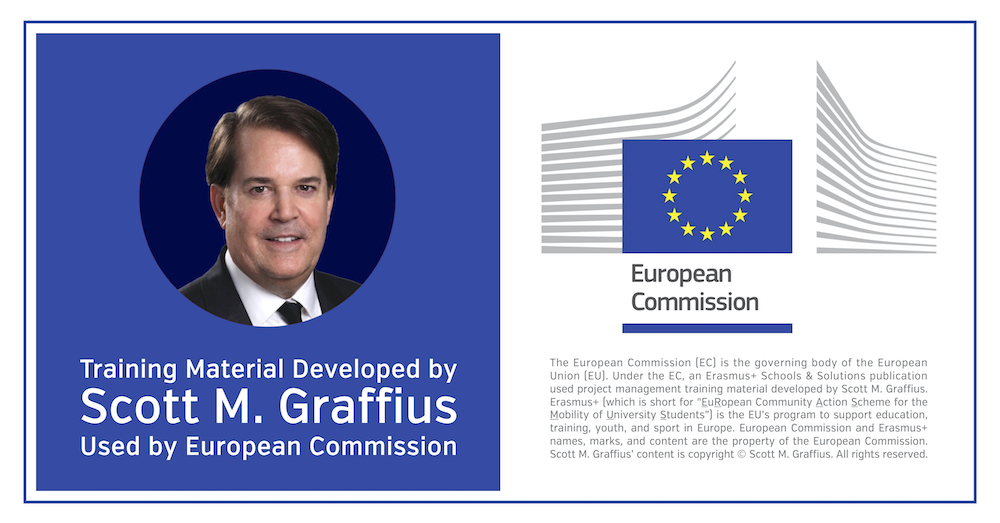

Strategic objectives play a crucial role in guiding organizations towards achieving their vision and mission. They’re fulfilled by projects, endeavors undertaken to create a unique product, service, or result.
The art and science of project management (Agile or otherwise) — the application of knowledge, skills, tools, and techniques to projects — is indispensable for the management and completion of projects. And tools can make a significant contribution to successful outcomes.
In 2007, Scott M. Graffius developed a fresh take on RACI charts, a simple project management tool. His unique material provides audiences with practical information they can use to leverage RACI charts to help manage complexities and achieve success. Graffius periodically refreshes his work. In 2020, he published an updated version on ResearchGate, a European platform for researchers and scientists.
Graffius' respective work is here and citation information follows:
Graffius, Scott M. (2020). How the RACI Tool Can Help You: Use RACI to Establish Roles and Responsibilities—and Improve Outcomes—for Projects and Other Work. Los Angeles, California: Exceptional PPM and PMO Solutions. DOI: 10.13140/RG.2.2.14713.62561/4.
A division of the EU’s European Commission, Erasmus+, used Graffius' material in one of their publications. Their work is here and select visuals follow.
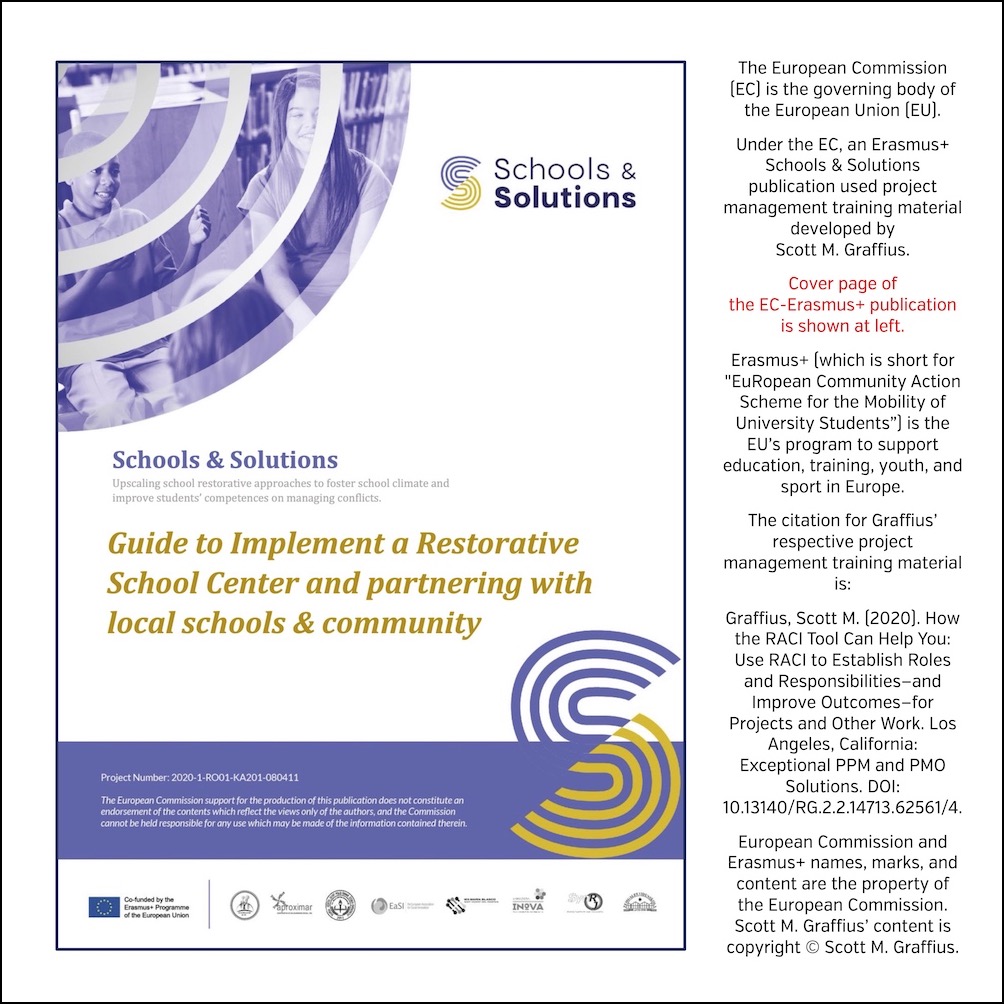
The cover page is shown above.
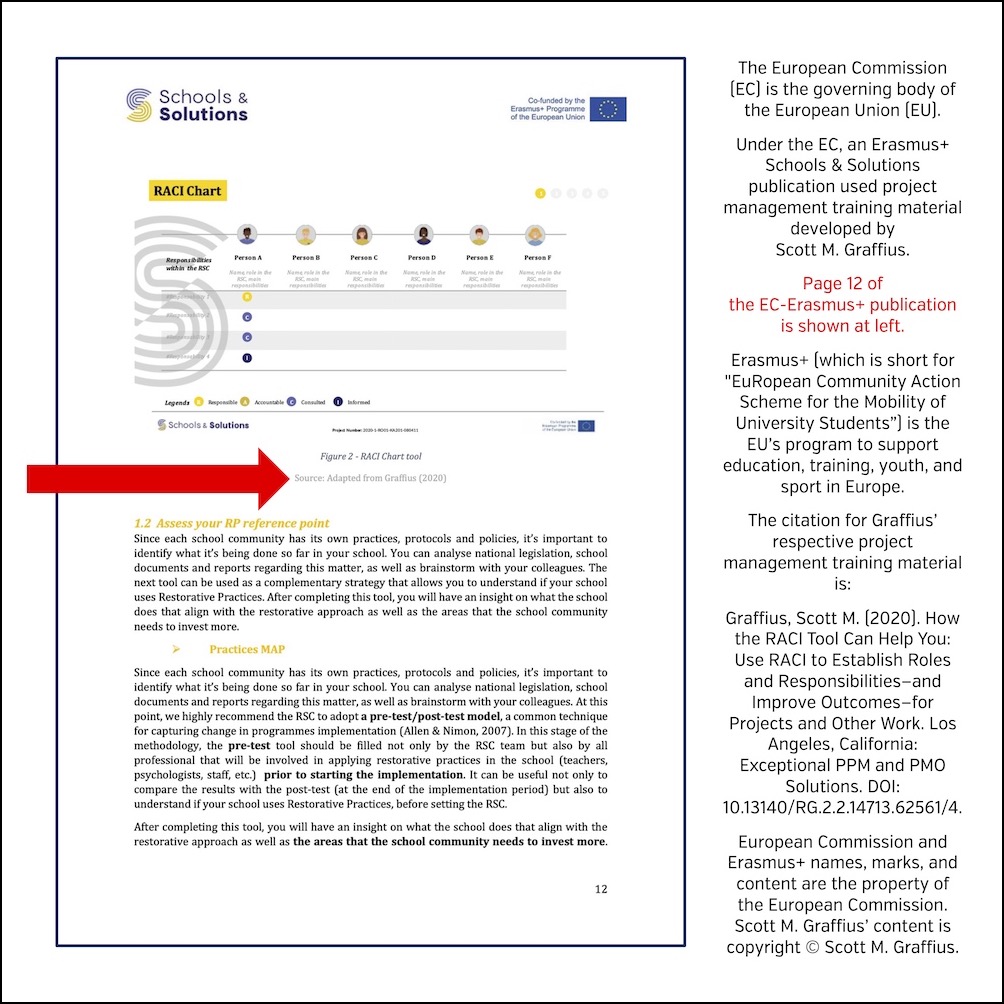
Page 13 is shown above.
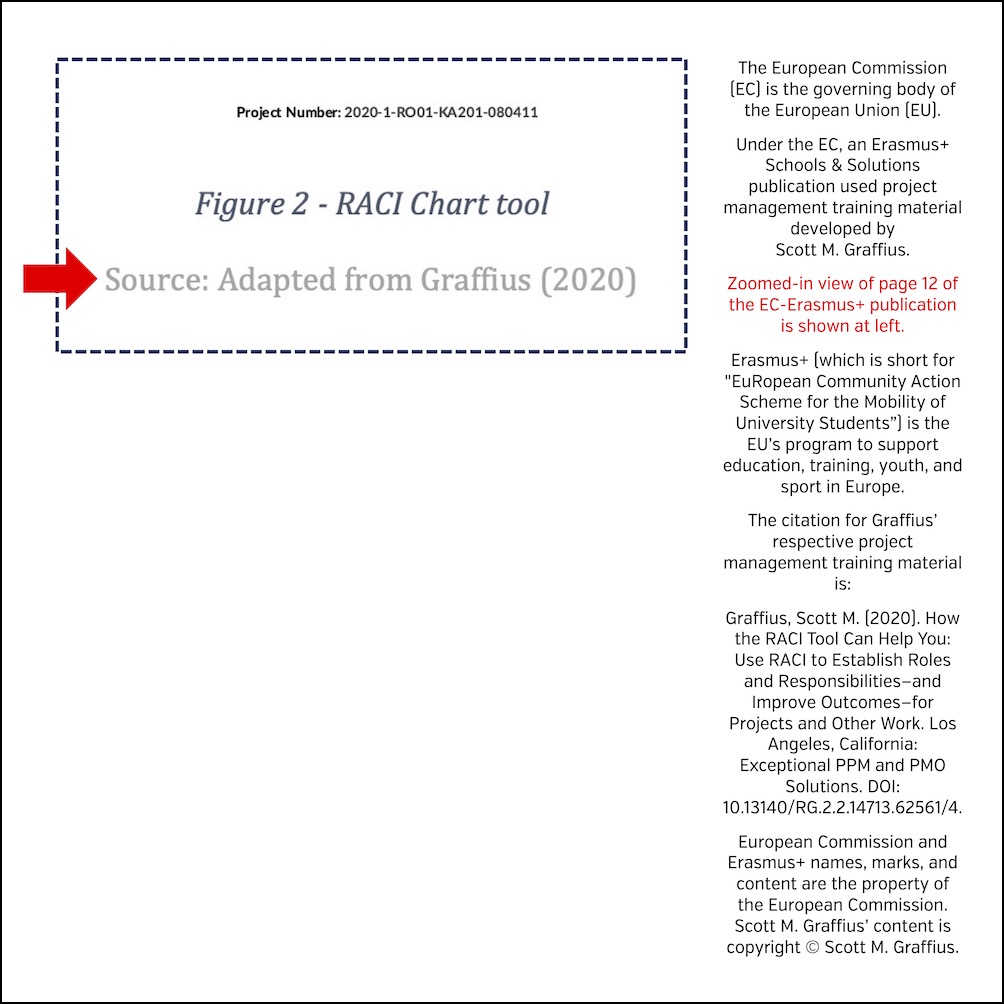
A zoomed-in version visual of page 13 is shown above.
About the European Commission
The European Commission (EC) is the governing body of the European Union (EU). It represents and upholds the interests of the EU as a whole and it is independent of national governments. The EC prepares legislation for adoption by the Council (representing the member countries) and the Parliament (representing the citizens). It administers the budget and the policy programs in cooperation with authorities in the member countries. The EC has an administrative body of about 32,000 European civil servants. Visit https://commission.europa.eu to learn more.
About Erasmus+
Erasmus+ (which is short for "EuRopean Community Action Scheme for the Mobility of University Students") is the European Union’s program to support education, training, youth, and sport in Europe. To learn more, visit https://erasmus-plus.ec.europa.eu.
About ResearchGate
Started in 2008, ResearchGate is a platform for researchers and scientists to connect, collaborate, and share their work. It reports, "Our mission is to connect the world of science and make research open to all." Visit https://www.researchgate.net to learn more.
How to Cite This Article
Graffius, Scott M. (2024, April 1). Division of the EU’s European Commission Used Material Developed by Scott M. Graffius. Available at: https://scottgraffius.com/blog/files/eu-2024.html. DOI: 10.13140/RG.2.2.23115.40488.




About Scott M. Graffius

Scott M. Graffius, PMP, SA, CSP-SM, CSP-PO, CSM, CSPO, ITIL, LSSGB is an agile project management practitioner, consultant, thinker, creator, multi-award-winning author, and international public speaker. Founder and CEO of Exceptional PPM and PMO Solutions™ and subsidiary Exceptional Agility™, he has generated over $1.9 billion for Global Fortune 500 businesses and other organizations he has served. Graffius and content from his books, talks, workshops, and more have been featured and used by Microsoft, Oracle, Broadcom, Cisco, Gartner, Project Management Institute, IEEE, National Academy of Sciences, United States Department of Energy, Yale University, Tufts University, and others. He delights audiences with dynamic and engaging talks and workshops on agile project management, AI, Tech leadership, video game development, strategic alignment, the science of high performance teams, and more. To date, he's presented sessions at 89 conferences and other events across 25 countries.
His full bio is available here.
Connect with Scott on:



About Agile Scrum: Your Quick Start Guide with Step-by-Step Instructions

Shifting customer needs are common in today's marketplace. Businesses must be adaptive and responsive to change while delivering an exceptional customer experience to be competitive.
There are a variety of frameworks supporting the development of products and services, and most approaches fall into one of two broad categories: traditional or agile. Traditional practices such as waterfall engage sequential development, while agile involves iterative and incremental deliverables. Organizations are increasingly embracing agile to manage projects, and best meet their business needs of rapid response to change, fast delivery speed, and more.
With clear and easy to follow step-by-step instructions, Scott M. Graffius's award-winning Agile Scrum: Your Quick Start Guide with Step-by-Step Instructions helps the reader:
- Implement and use the most popular agile framework―Scrum;
- Deliver products in short cycles with rapid adaptation to change, fast time-to-market, and continuous improvement; and
- Support innovation and drive competitive advantage.
Hailed by Literary Titan as “the book highlights the versatility of Scrum beautifully.”
Winner of 17 first place awards.
Agile Scrum: Your Quick Start Guide with Step-by-Step Instructions is available in paperback and ebook/Kindle in the United States and around the world. Some links by country follow.
- 🇧🇷 Brazil
- 🇨🇦 Canada
- 🇨🇿 Czech Republic
- 🇩🇰 Denmark
- 🇫🇮 Finland
- 🇫🇷 France
- 🇩🇪 Germany
- 🇬🇷 Greece
- 🇭🇺 Hungary
- 🇮🇳 India
- 🇮🇪 Ireland
- 🇮🇱 Israel
- 🇮🇹 Italy
- 🇯🇵 Japan
- 🇱🇺 Luxembourg
- 🇲🇽 Mexico
- 🇳🇱 Netherlands
- 🇳🇿 New Zealand
- 🇳🇴 Norway
- 🇪🇸 Spain
- 🇸🇪 Sweden
- 🇨🇭 Switzerland
- 🇦🇪 UAE
- 🇬🇧 United Kingdom
- 🇺🇸 United States

About Agile Transformation: A Brief Story of How an Entertainment Company Developed New Capabilities and Unlocked Business Agility to Thrive in an Era of Rapid Change

Thriving in today's marketplace frequently depends on making a transformation to become more agile. Those successful in the transition enjoy faster delivery speed and ROI, higher satisfaction, continuous improvement, and additional benefits.
Based on actual events, Agile Transformation: A Brief Story of How an Entertainment Company Developed New Capabilities and Unlocked Business Agility to Thrive in an Era of Rapid Change provides a quick (60-90 minute) read about a successful agile transformation at a multinational entertainment and media company, told from the author's perspective as an agile coach.
The award-winning book by Scott M. Graffius is available in paperback and ebook/Kindle in the United States and around the world. Some links by country follow.
- 🇦🇺 Australia
- 🇦🇹 Austria
- 🇧🇷 Brazil
- 🇨🇦 Canada
- 🇨🇿 Czech Republic
- 🇩🇰 Denmark
- 🇫🇮 Finland
- 🇫🇷 France
- 🇩🇪 Germany
- 🇬🇷 Greece
- 🇮🇳 India
- 🇮🇪 Ireland
- 🇯🇵 Japan
- 🇱🇺 Luxembourg
- 🇲🇽 Mexico
- 🇳🇱 Netherlands
- 🇳🇿 New Zealand
- 🇪🇸 Spain
- 🇸🇪 Sweden
- 🇨🇭 Switzerland
- 🇦🇪 United Arab Emirates
- 🇬🇧 United Kingdom
- 🇺🇸 United States

The short link for this article is: https://bit.ly/eu-2024
© Copyright 2024 Scott M. Graffius. All rights reserved. This material may not be published, broadcast, rewritten or redistributed without the express written permission of Scott M. Graffius.

"How Teams Work" Book Referenced Scott M. Graffius' 'Phases of Team Development'


Informed by the research of Bruce W. Tuckman and Mary Ann C. Jensen, over 100 subsequent studies, and Scott M. Graffius’ first-hand professional experience with, and analysis of, team leadership and performance, Graffius created his ‘Phases of Team Development’ as a unique perspective and visual conveying the five phases of team development — Forming, Storming, Norming, Performing, and Adjourning — inclusive of a graph showing how performance varies by phase, as well as the characteristics and strategies for each phase.
Leaders of teams — Project Managers, Scrum Masters, Agile Coaches, DevOps Leads, and others — can apply the information to help handle challenges or issues experienced by teams. By doing so, they’ll advance the teams’ (and their own) happiness, productivity, and success.
Graffius initially developed the material in 2008, and he periodically refreshes it. For details on the current (2024) edition including permission request information, high resolution files, and more, visit here.
Graffius’ ‘Phases of Team Development’ work is used by businesses, professional associations, government agencies, and universities around the world. Examples include Yale University, IEEE, Constructor Institute (Switzerland), Adobe, Boston University, Amsterdam Public Health Research Institute, United States National Park Service, Bayer, University of Galway (Ireland), Hasso Plattner Institute (Germany), American Management Association, UC San Diego, and many more.
How Teams Work: A Playbook for Distributing Leadership was added to the list.
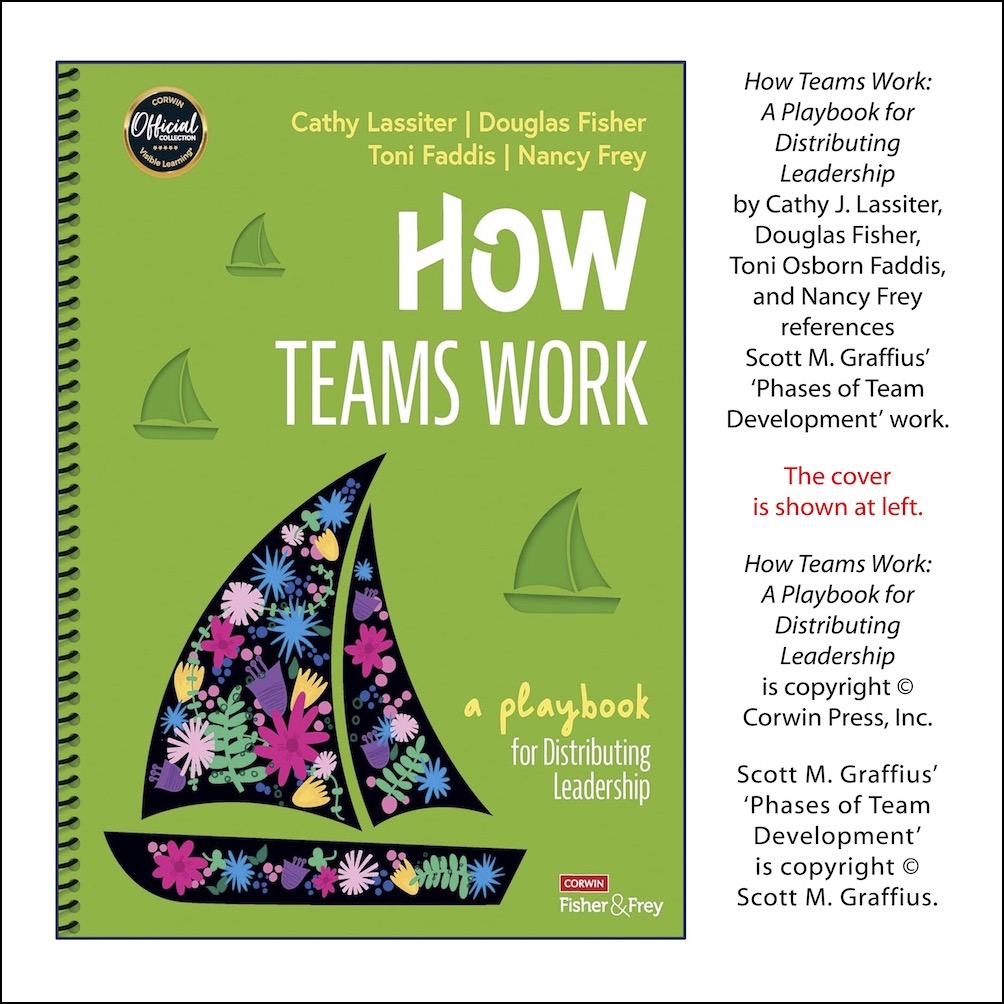
The cover image of the book is shown above.
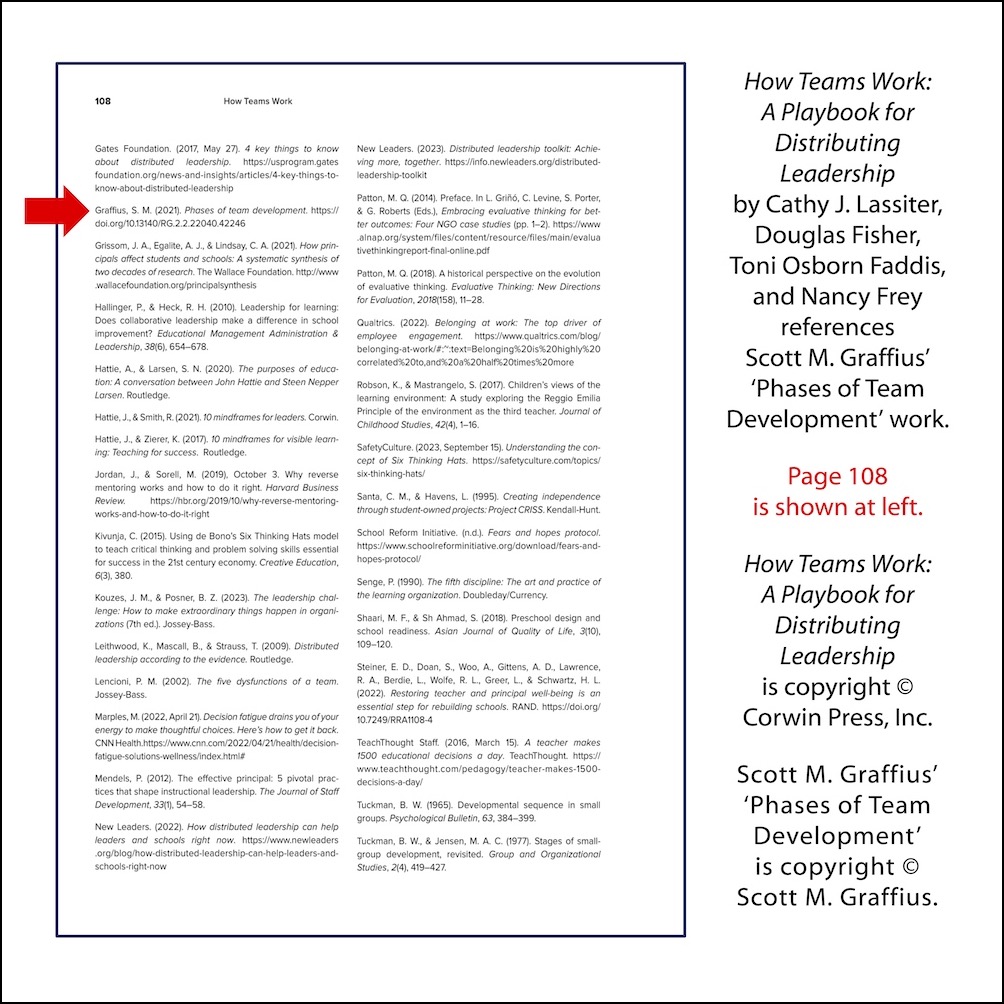
Page 108 from the book is shown above.
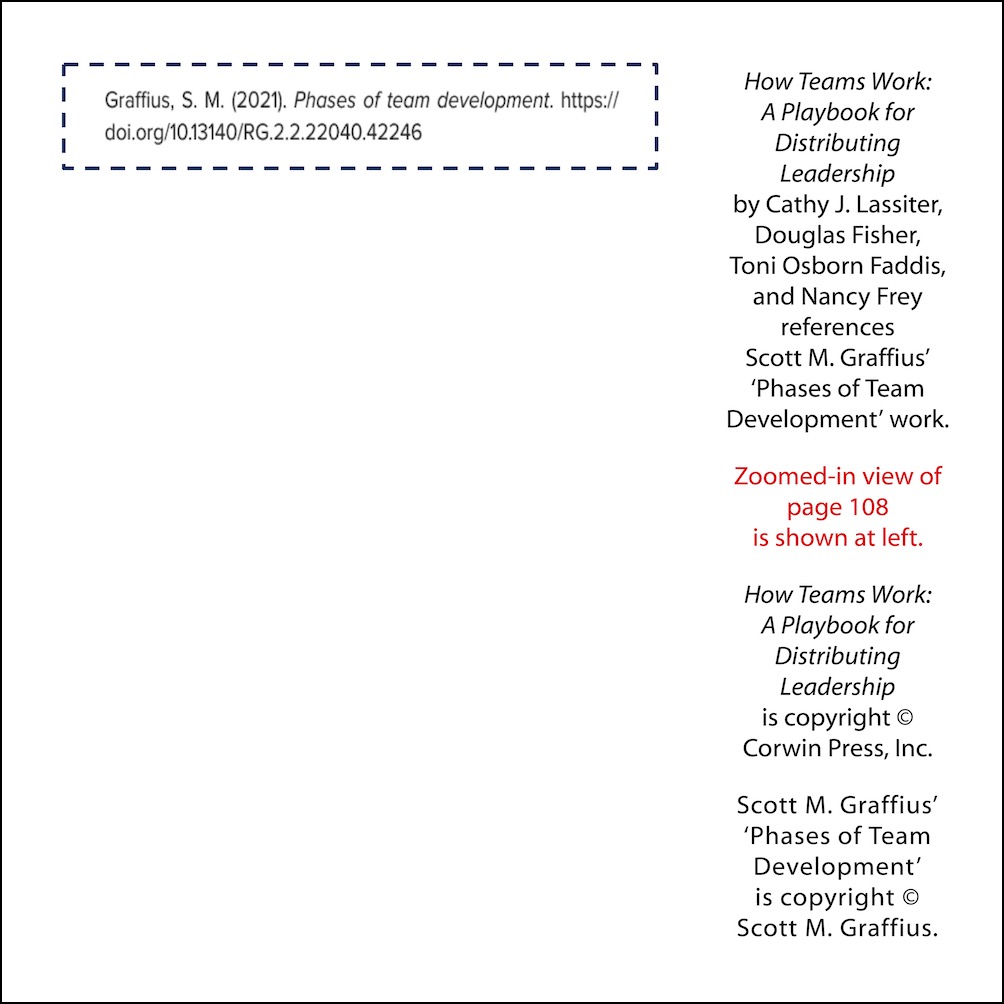
A zoomed-in view of page 108 from the book is shown above.
About How Teams Work: A Playbook for Distributing Leadership
From the product description: “Creating strong, cohesive teams is an art, and How Teams Work: A Playbook for Distributing Leadership is the essential guide for school leaders looking to master this craft. This interactive playbook doesn't just advise but actively equips leaders with the tools they need to foster trust, accountability, and engagement in their teams.”
How Teams Work: A Playbook for Distributing Leadership is available at Amazon and other sellers.
Google highlights the book here.
About the Authors
How Teams Work: A Playbook for Distributing Leadership was written by Cathy J. Lassiter, Douglas Fisher, Toni Osborn Faddis, and Nancy Frey.
Cathy Lassiter, Ed.D., is an international consultant with over 35 years of combined experience as a public school teacher, principal, central office administrator, and consultant. She is on X (stylized as 𝕏) at @cathy_lassiter. Visit here to learn more.
Douglas Fisher, Ph.D., is professor and chair of educational leadership at San Diego State University and a leader at Health Sciences High and Middle College. He is on X (stylized as 𝕏) at @DFISHERSDSU. Visit here to learn more.
Toni Faddis, EdD, is a Corwin author and full-time professional learning consultant. Additional information is available here. She is on X (stylized as 𝕏) at @ToniFaddis. Visit here to learn more.
Nancy Frey, Ph.D., is a professor in Educational Leadership at San Diego State University and a member of the International Literacy Association’s Literacy Research Panel. She is on X (stylized as 𝕏) at @ToniFaddis. Visit here to learn more.
Graffius Presents Unique and Compelling Talks and Workshops on High Performance Teams
Graffius has presented talks and workshops at 89 conferences and other events across 25 countries. While each session is unique, the top topic is high performance teams. In those sessions, he expands upon on his 'Phases of Team Development' work. Sessions are dynamic, engaging, and packed with fresh insights and usable information. They’re highly rated by attendees and organizers alike. Visit here to learn more.
How to Cite This Article
Graffius, Scott M. (2024, April 2). "How Teams Work" Book Referenced Scott M. Graffius' 'Phases of Team Development.' Available at: https://scottgraffius.com/blog/files/htw.html. DOI: 10.13140/RG.2.2.23495.51368.




About Scott M. Graffius

Scott M. Graffius, PMP, SA, CSP-SM, CSP-PO, CSM, CSPO, ITIL, LSSGB is an agile project management practitioner, consultant, thinker, creator, multi-award-winning author, and international public speaker. Founder and CEO of Exceptional PPM and PMO Solutions™ and subsidiary Exceptional Agility™, he has generated over $1.9 billion for Global Fortune 500 businesses and other organizations he has served. Graffius and content from his books, talks, workshops, and more have been featured and used by Microsoft, Oracle, Broadcom, Cisco, Gartner, Project Management Institute, IEEE, National Academy of Sciences, United States Department of Energy, Yale University, Tufts University, and others. He delights audiences with dynamic and engaging talks and workshops on agile project management, AI, Tech leadership, video game development, strategic alignment, the science of high performance teams, and more. To date, he's presented sessions at 89 conferences and other events across 25 countries.
His full bio is available here.
Connect with Scott on:



About Agile Scrum: Your Quick Start Guide with Step-by-Step Instructions

Shifting customer needs are common in today's marketplace. Businesses must be adaptive and responsive to change while delivering an exceptional customer experience to be competitive.
There are a variety of frameworks supporting the development of products and services, and most approaches fall into one of two broad categories: traditional or agile. Traditional practices such as waterfall engage sequential development, while agile involves iterative and incremental deliverables. Organizations are increasingly embracing agile to manage projects, and best meet their business needs of rapid response to change, fast delivery speed, and more.
With clear and easy to follow step-by-step instructions, Scott M. Graffius's award-winning Agile Scrum: Your Quick Start Guide with Step-by-Step Instructions helps the reader:
- Implement and use the most popular agile framework―Scrum;
- Deliver products in short cycles with rapid adaptation to change, fast time-to-market, and continuous improvement; and
- Support innovation and drive competitive advantage.
Hailed by Literary Titan as “the book highlights the versatility of Scrum beautifully.”
Winner of 17 first place awards.
Agile Scrum: Your Quick Start Guide with Step-by-Step Instructions is available in paperback and ebook/Kindle in the United States and around the world. Some links by country follow.
- 🇧🇷 Brazil
- 🇨🇦 Canada
- 🇨🇿 Czech Republic
- 🇩🇰 Denmark
- 🇫🇮 Finland
- 🇫🇷 France
- 🇩🇪 Germany
- 🇬🇷 Greece
- 🇭🇺 Hungary
- 🇮🇳 India
- 🇮🇪 Ireland
- 🇮🇱 Israel
- 🇮🇹 Italy
- 🇯🇵 Japan
- 🇱🇺 Luxembourg
- 🇲🇽 Mexico
- 🇳🇱 Netherlands
- 🇳🇿 New Zealand
- 🇳🇴 Norway
- 🇪🇸 Spain
- 🇸🇪 Sweden
- 🇨🇭 Switzerland
- 🇦🇪 UAE
- 🇬🇧 United Kingdom
- 🇺🇸 United States

About Agile Transformation: A Brief Story of How an Entertainment Company Developed New Capabilities and Unlocked Business Agility to Thrive in an Era of Rapid Change

Thriving in today's marketplace frequently depends on making a transformation to become more agile. Those successful in the transition enjoy faster delivery speed and ROI, higher satisfaction, continuous improvement, and additional benefits.
Based on actual events, Agile Transformation: A Brief Story of How an Entertainment Company Developed New Capabilities and Unlocked Business Agility to Thrive in an Era of Rapid Change provides a quick (60-90 minute) read about a successful agile transformation at a multinational entertainment and media company, told from the author's perspective as an agile coach.
The award-winning book by Scott M. Graffius is available in paperback and ebook/Kindle in the United States and around the world. Some links by country follow.
- 🇦🇺 Australia
- 🇦🇹 Austria
- 🇧🇷 Brazil
- 🇨🇦 Canada
- 🇨🇿 Czech Republic
- 🇩🇰 Denmark
- 🇫🇮 Finland
- 🇫🇷 France
- 🇩🇪 Germany
- 🇬🇷 Greece
- 🇮🇳 India
- 🇮🇪 Ireland
- 🇯🇵 Japan
- 🇱🇺 Luxembourg
- 🇲🇽 Mexico
- 🇳🇱 Netherlands
- 🇳🇿 New Zealand
- 🇪🇸 Spain
- 🇸🇪 Sweden
- 🇨🇭 Switzerland
- 🇦🇪 United Arab Emirates
- 🇬🇧 United Kingdom
- 🇺🇸 United States

The short link for this article is: https://bit.ly/htw-2024 .
© Copyright 2024 Scott M. Graffius. All rights reserved. This material may not be published, broadcast, rewritten or redistributed without the express written permission of Scott M. Graffius.

Cisco Features Scott M. Graffius' 'Phases of Team Development' Work
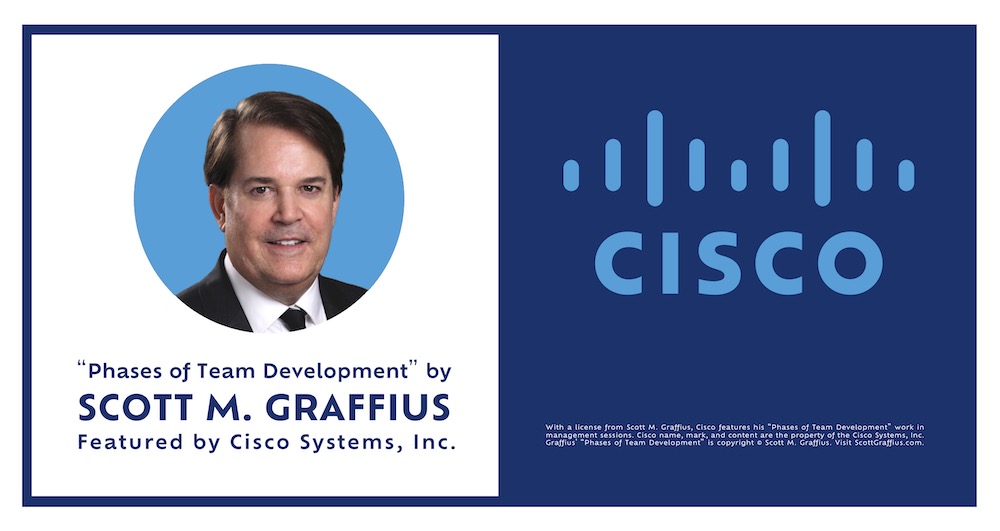

Informed by the research of Bruce W. Tuckman and Mary Ann C. Jensen, over 100 subsequent studies, and Scott M. Graffius' first-hand professional experience with, and analysis of, team leadership and performance, Graffius created his 'Phases of Team Development' as a unique perspective and visual conveying the five phases of team development — Forming, Storming, Norming, Performing, and Adjourning — inclusive of a graph showing how performance varies by phase, as well as the characteristics and strategies for each phase.
Leaders of teams — Project Managers, Scrum Masters, Agile Coaches, DevOps Leads, and others — can apply the information to help handle challenges or issues experienced by teams. By doing so, they’ll advance the teams’ (and their own) happiness, productivity, and success.
Graffius initially developed the material in 2008, and he periodically refreshes it. For details on the current (2024) edition including permission request information, high resolution files, and more, visit here.
Graffius’ ‘Phases of Team Development’ work is used by businesses, professional associations, government agencies, and universities around the world. Examples include Yale University, IEEE, Constructor Institute (Switzerland), Adobe, Boston University, Amsterdam Public Health Research Institute, United States National Park Service, Bayer, Ford, University of Galway (Ireland), Hasso Plattner Institute (Germany), American Management Association, UC San Diego, and many more.
Cisco was added to the list.
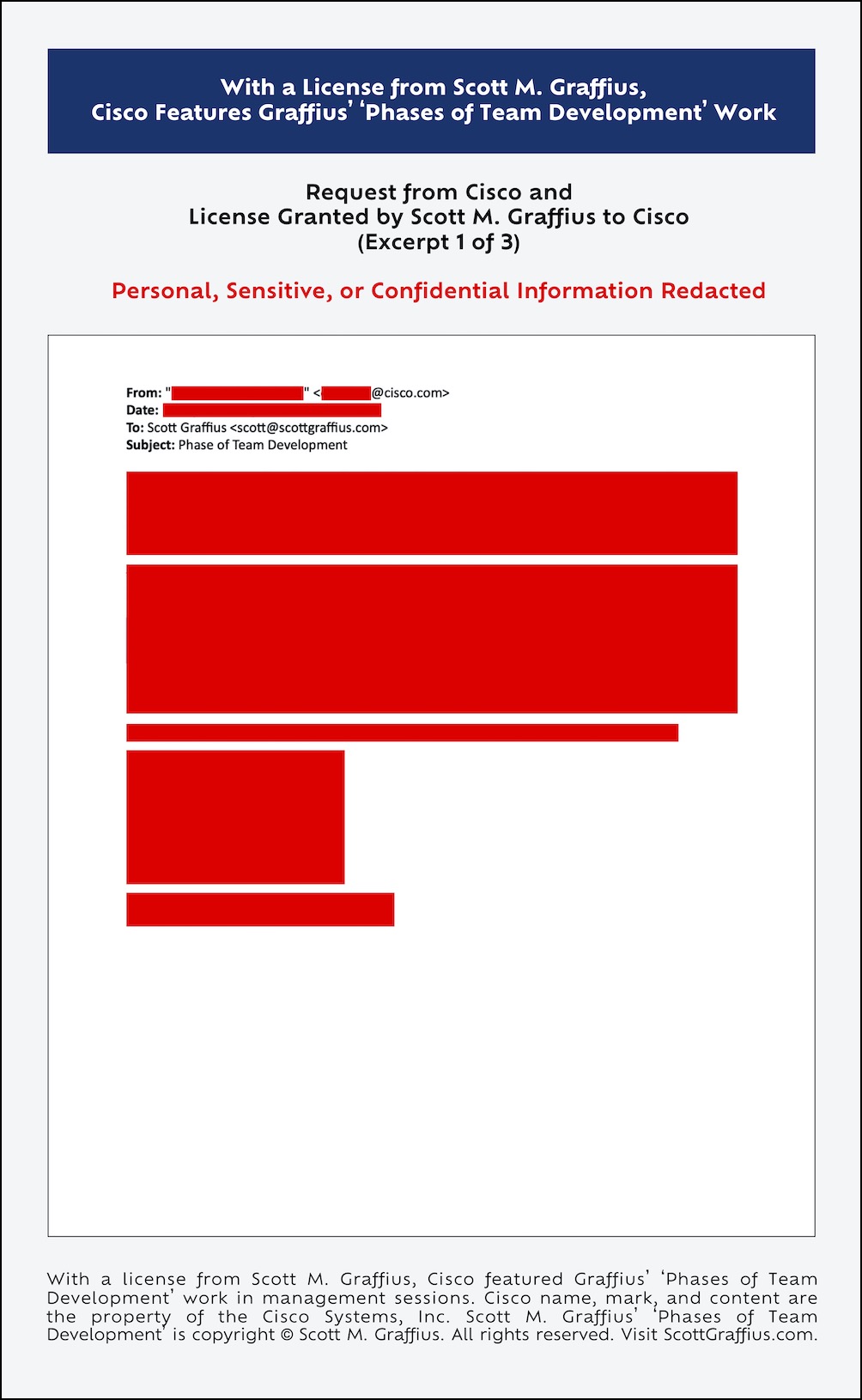
Excerpt 1 of the request from Cisco and the license granted by Scott M. Graffius to Cisco is above.
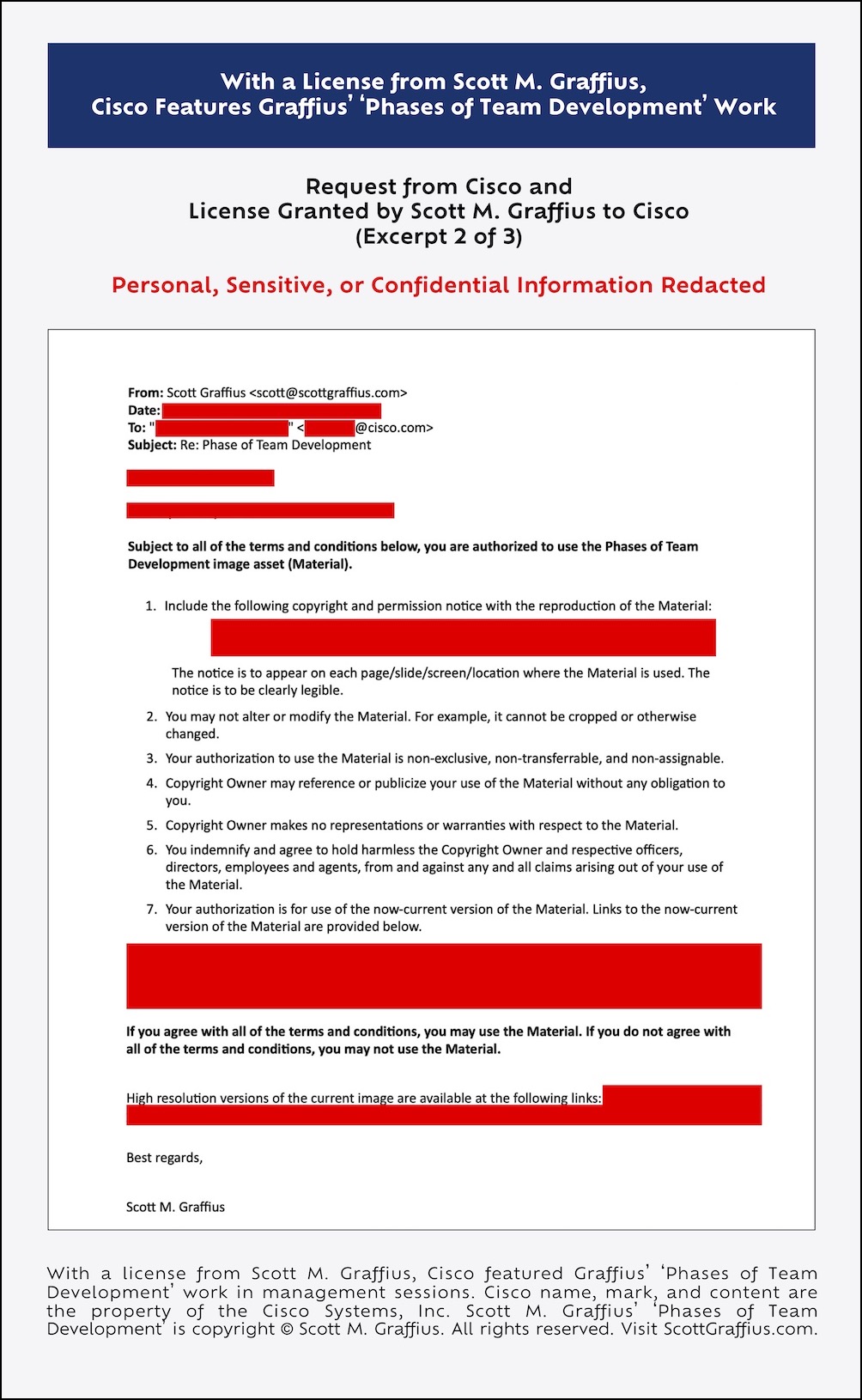
Excerpt 2 of the request from Cisco and the license granted by Scott M. Graffius to Cisco is above.
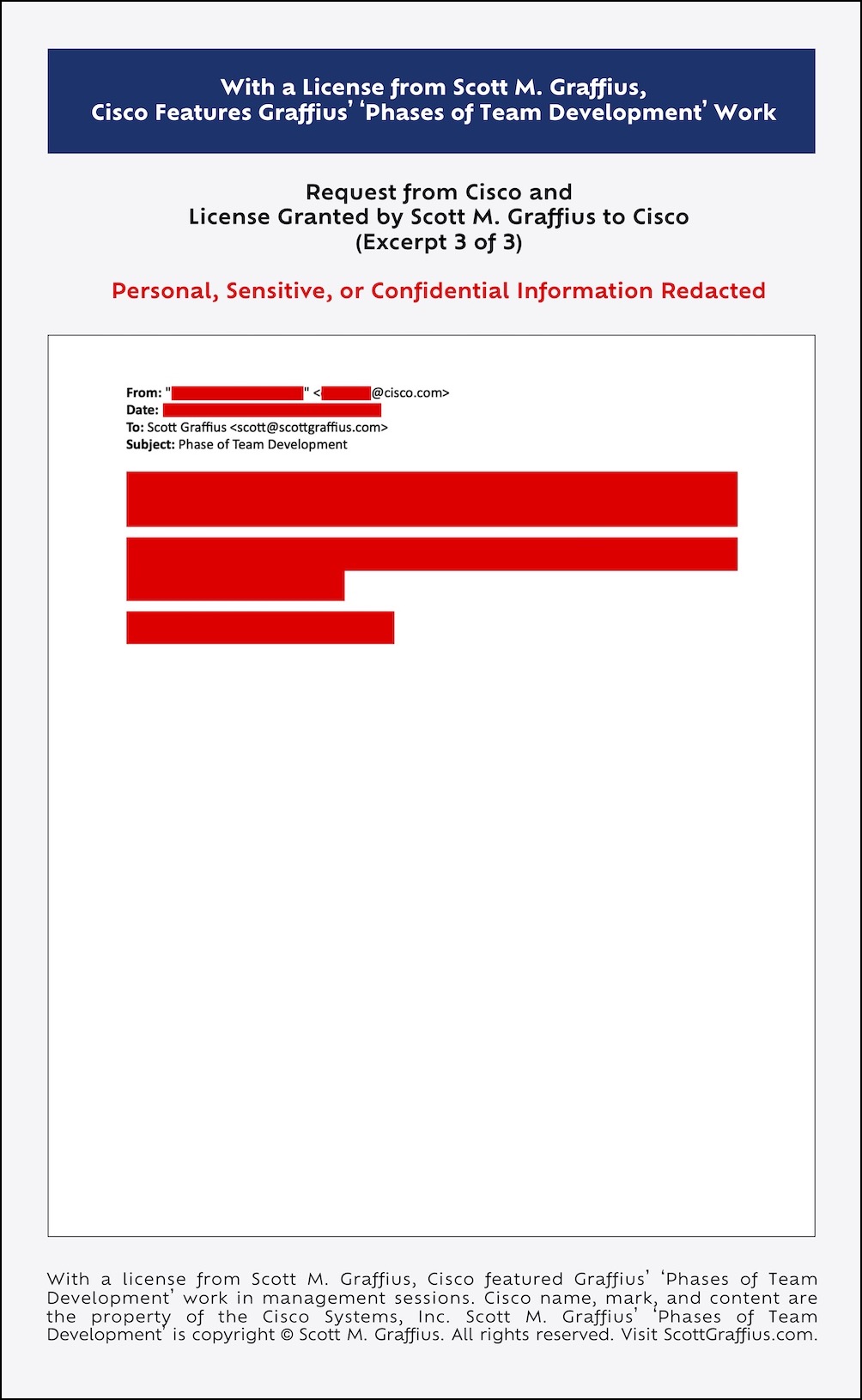
Excerpt 3 of the request from Cisco and the license granted by Scott M. Graffius to Cisco is above.
About Cisco
Cisco is an American multinational digital communications technology conglomerate corporation headquartered in San Jose, California. It develops, manufactures, and sells networking hardware, software, telecommunications equipment, and other high-technology services and products. Visit https://www.cisco.com to learn more.
How to Cite This Article
Graffius, Scott M. (2024, April 5). Cisco Features Scott M. Graffius' 'Phases of Team Development' Work' Available at: https://scottgraffius.com/blog/files/cisco-2024.html. DOI: 10.13140/RG.2.2.16689.60000.




About Scott M. Graffius

Scott M. Graffius, PMP, SA, CSP-SM, CSP-PO, CSM, CSPO, ITIL, LSSGB is an agile project management practitioner, consultant, thinker, creator, multi-award-winning author, and international public speaker. Founder and CEO of Exceptional PPM and PMO Solutions™ and subsidiary Exceptional Agility™, he has generated over $1.9 billion for Global Fortune 500 businesses and other organizations he has served. Graffius and content from his books, talks, workshops, and more have been featured and used by Microsoft, Oracle, Broadcom, Cisco, Gartner, Project Management Institute, IEEE, National Academy of Sciences, United States Department of Energy, Yale University, Tufts University, and others. He delights audiences with dynamic and engaging talks and workshops on agile project management, AI, Tech leadership, video game development, strategic alignment, the science of high performance teams, and more. To date, he's presented sessions at 89 conferences and other events across 25 countries.
His full bio is available here.
Connect with Scott on:



About Agile Scrum: Your Quick Start Guide with Step-by-Step Instructions

Shifting customer needs are common in today's marketplace. Businesses must be adaptive and responsive to change while delivering an exceptional customer experience to be competitive.
There are a variety of frameworks supporting the development of products and services, and most approaches fall into one of two broad categories: traditional or agile. Traditional practices such as waterfall engage sequential development, while agile involves iterative and incremental deliverables. Organizations are increasingly embracing agile to manage projects, and best meet their business needs of rapid response to change, fast delivery speed, and more.
With clear and easy to follow step-by-step instructions, Scott M. Graffius's award-winning Agile Scrum: Your Quick Start Guide with Step-by-Step Instructions helps the reader:
- Implement and use the most popular agile framework―Scrum;
- Deliver products in short cycles with rapid adaptation to change, fast time-to-market, and continuous improvement; and
- Support innovation and drive competitive advantage.
Hailed by Literary Titan as “the book highlights the versatility of Scrum beautifully.”
Winner of 17 first place awards.
Agile Scrum: Your Quick Start Guide with Step-by-Step Instructions is available in paperback and ebook/Kindle in the United States and around the world. Some links by country follow.
- 🇧🇷 Brazil
- 🇨🇦 Canada
- 🇨🇿 Czech Republic
- 🇩🇰 Denmark
- 🇫🇮 Finland
- 🇫🇷 France
- 🇩🇪 Germany
- 🇬🇷 Greece
- 🇭🇺 Hungary
- 🇮🇳 India
- 🇮🇪 Ireland
- 🇮🇱 Israel
- 🇮🇹 Italy
- 🇯🇵 Japan
- 🇱🇺 Luxembourg
- 🇲🇽 Mexico
- 🇳🇱 Netherlands
- 🇳🇿 New Zealand
- 🇳🇴 Norway
- 🇪🇸 Spain
- 🇸🇪 Sweden
- 🇨🇭 Switzerland
- 🇦🇪 UAE
- 🇬🇧 United Kingdom
- 🇺🇸 United States

About Agile Transformation: A Brief Story of How an Entertainment Company Developed New Capabilities and Unlocked Business Agility to Thrive in an Era of Rapid Change

Thriving in today's marketplace frequently depends on making a transformation to become more agile. Those successful in the transition enjoy faster delivery speed and ROI, higher satisfaction, continuous improvement, and additional benefits.
Based on actual events, Agile Transformation: A Brief Story of How an Entertainment Company Developed New Capabilities and Unlocked Business Agility to Thrive in an Era of Rapid Change provides a quick (60-90 minute) read about a successful agile transformation at a multinational entertainment and media company, told from the author's perspective as an agile coach.
The award-winning book by Scott M. Graffius is available in paperback and ebook/Kindle in the United States and around the world. Some links by country follow.
- 🇦🇺 Australia
- 🇦🇹 Austria
- 🇧🇷 Brazil
- 🇨🇦 Canada
- 🇨🇿 Czech Republic
- 🇩🇰 Denmark
- 🇫🇮 Finland
- 🇫🇷 France
- 🇩🇪 Germany
- 🇬🇷 Greece
- 🇮🇳 India
- 🇮🇪 Ireland
- 🇯🇵 Japan
- 🇱🇺 Luxembourg
- 🇲🇽 Mexico
- 🇳🇱 Netherlands
- 🇳🇿 New Zealand
- 🇪🇸 Spain
- 🇸🇪 Sweden
- 🇨🇭 Switzerland
- 🇦🇪 United Arab Emirates
- 🇬🇧 United Kingdom
- 🇺🇸 United States

© Copyright 2024 Scott M. Graffius. All rights reserved. This material may not be published, broadcast, rewritten or redistributed without the express written permission of Scott M. Graffius.

Graffius' 'Phases of Team Development' Featured by TAG at TBS24 Conference in Zermatt Switzerland
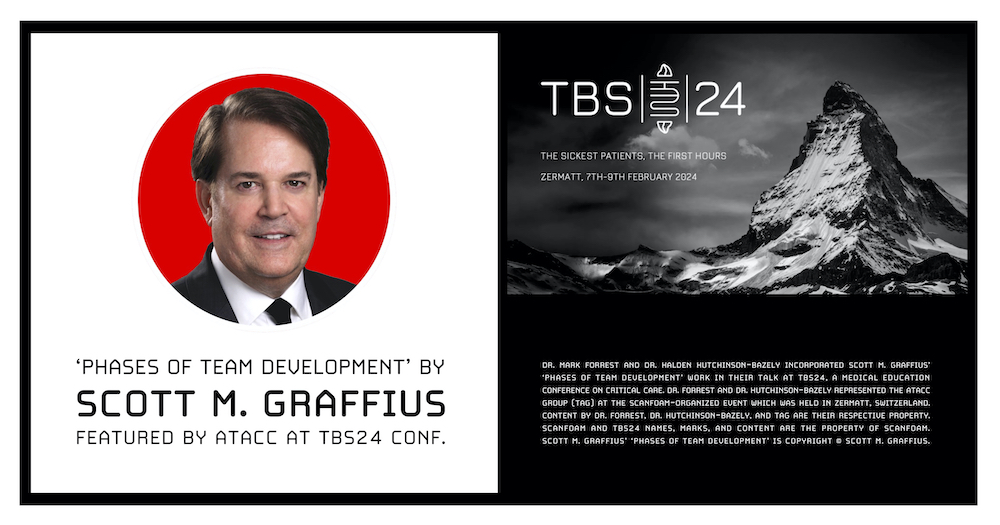

Informed by the research of Bruce W. Tuckman and Mary Ann C. Jensen, over 100 subsequent studies, and Scott M. Graffius' first-hand professional experience with, and analysis of, team leadership and performance, Graffius created his 'Phases of Team Development' as a unique perspective and visual conveying the five phases of team development — Forming, Storming, Norming, Performing, and Adjourning — inclusive of a graph showing how performance varies by phase, as well as the characteristics and strategies for each phase.
Leaders of teams can apply the information to help handle challenges or issues experienced by teams. By doing so, they’ll advance the teams' (and their own) happiness, productivity, and success.
Graffius initially developed the material in 2008, and he periodically refreshes it. For details on the current (2024) edition including permission request information, high resolution files, and more, visit here.
Graffius' 'Phases of Team Development' work is used by businesses, professional associations, government agencies, and universities around the world. Examples include Yale University, IEEE, Constructor Institute (Switzerland), Adobe, Boston University, Amsterdam Public Health Research Institute, United States National Park Service, Cisco, Bayer, Ford, University of Galway (Ireland), Hasso Plattner Institute (Germany), American Management Association, UC San Diego, and many more.
The ATACC Group (TAG) was added to the list. Dr. Mark Forrest and Dr. Halden Hutchinson-Bazely from TAG incorporated Graffius' 'Phases of Team Development' in their talk at TBS24 in Zermatt, Switzerland.

Slide 1 from their talk is shown above.
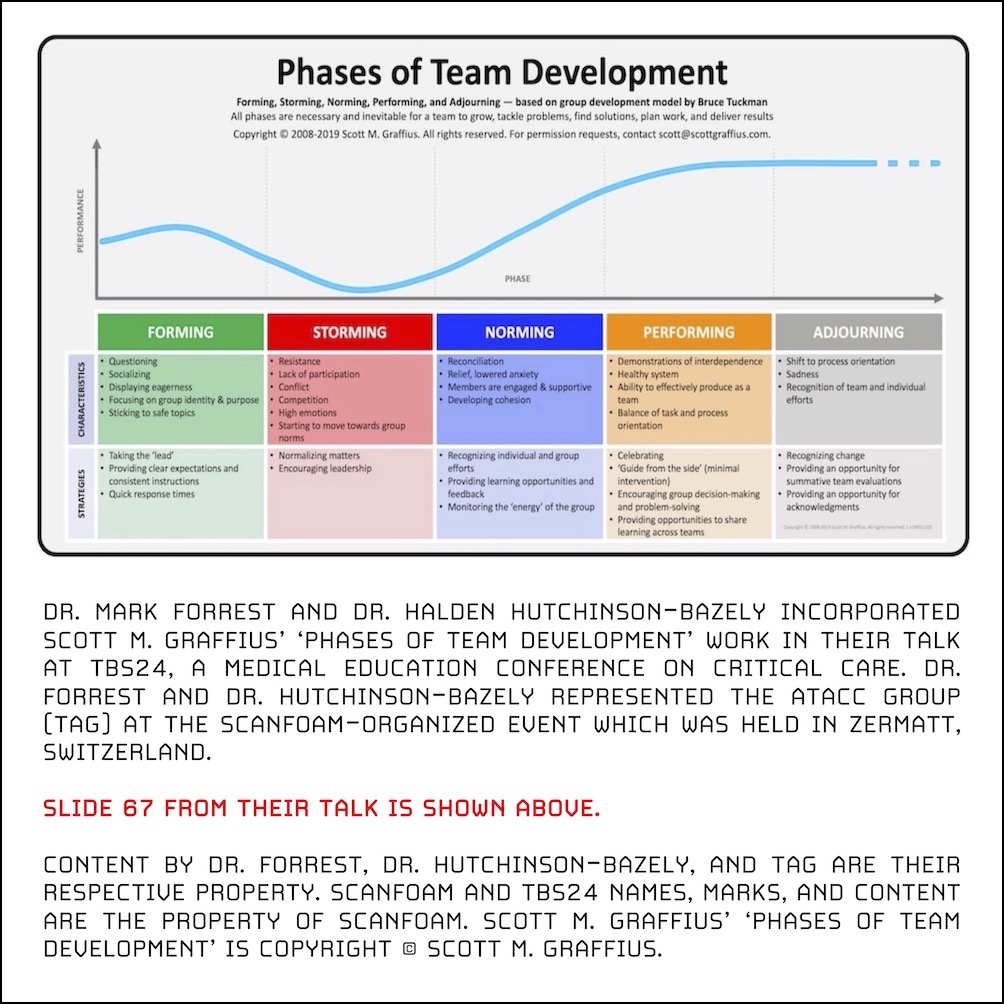
Slide 67 from their talk — which featured the 2019 edition of Graffius' 'Phases of Team Development' — is shown above. (For details on the current [2024] edition of Graffius' work including permission request information, high resolution files, and more, visit here.)
A recording of their session is on YouTube.
About Dr. Mark Forrest
The following includes content from https://scanfoam.org/tbs24.
Dr. Mark Forrest is a consultant in anaesthetics, critical care, prehospital care from the North West of England and Associate Medical Director in his NHS Trust. He has over 35 years of experience in these fields and has additional experience in aeromedical retrieval (including Paeds and ECMO), diving/hyperbaric medicine, and tactical medicine. Dr. Forrest flies as a consultant on HeliMed 29 and responds on a day-to-day basis as a 'Fire & Rescue Doctor.' He is passionate about trauma and critical care, especially in the prehospital arena and has a specialist interest in vehicle extrication as a Road Traffic Collision Extrication Instructor and Clinical Advisor to the National Fire Service College.
Dr. Forrest was the first appointed Medical Director for Fire & Rescue in the UK, over 17 years ago and now directs 9 UK Police Forces and 3 Fire and Rescue Services, through the ATACC Group.
Dr. Forrest is the Founder and Medical Director of the internationally renowned ATACC (Anesthesia Trauma and Critical Care) course and he is the First President of the Faculty of Trauma & Critical Care. He is an advocate for immersive simulation, unique training and innovation and has written over 20 varied courses for The ATACC Group as a Royal College Surgeons (London) Education Centre.
About Dr. Halden Hutchinson-Bazely
The following includes content from https://scanfoam.org/tbs24.
Dr. Halden Hutchinson-Bazely is an intensive care medicine doctor and pre hospital emergency medicine doctor in the UK. He works in a large, major trauma centre ICU, and he is a Helicopter Emergency Medical System (HEMS) doctor at East Anglian Air Ambulance (EAAA).
Dr. Hutchinson-Bazely is committed to delivering contemporary and compassionate critical care, and supporting others to do the same, so much of his non-clinical work is education. He is a faculty member at EAAA, where he specializes in endovascular resuscitation techniques. Dr. Hutchinson-Bazely is also part of the faculty for the international Endovascular Trauma Management (EVTM) society. His main commitment to education is as a deputy medical director for ATACC, where he co-directs the ATACC course.
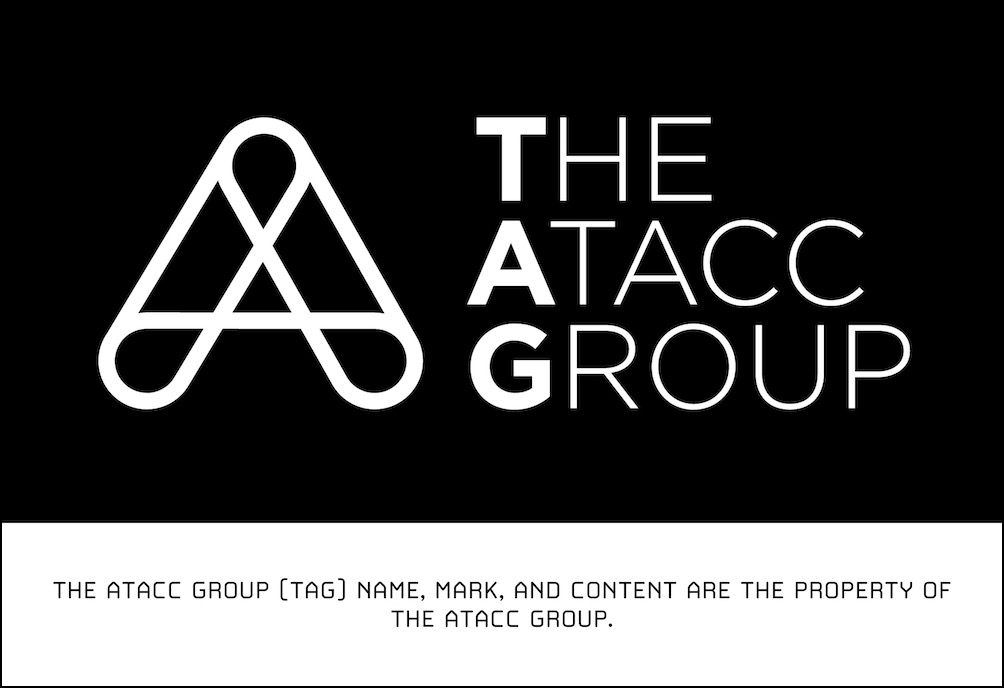
About The ATACC Group
The ATACC Group (TAG) is known for providing high quality first aid, clinical and medical education and training to every level of provider involved in patient care. It offers a suite of regulated qualifications in collaboration with Qualification Network UK (QNUK) who are an Ofqual, CCEA, and Qualification Wales recognized Awarding Organization. TAG is also a Royal College of Surgeons, London approved Educational Centre. ATACC is an acronym for Anesthesia, Trauma, and Critical Care. Visit https://www.ataccgroup.com to learn more.
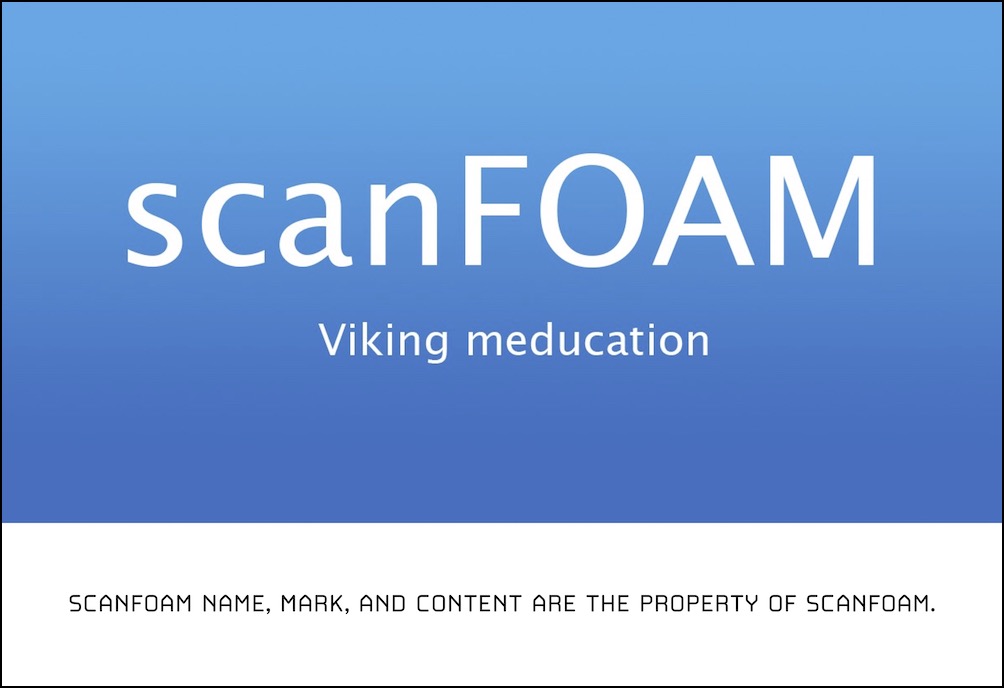
About scanFOAM
Scandinavia-based not-for-profit scanFOAM provides resources, conferences (such as TBS24), and more aimed at improving medicine. ScanFOAM is short for Scandinavia Free Open Access Meducation (or medical education). Visit https://scanfoam.org/ to learn more.
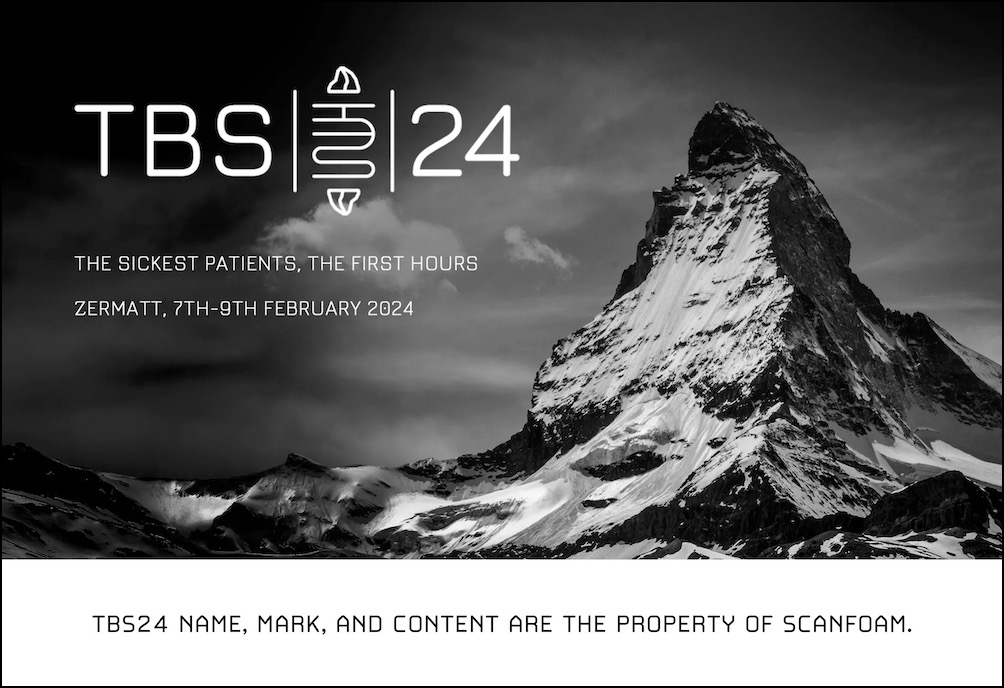
About the TBS24 Conference
TBS24 – the 6th iteration of cutting-edge talks on critical care, organized by scanFOAM – was held in beautiful Zermatt, Switzerland, on 7-9 February 2024. Visit https://scanfoam.org/tbs24/ to learn more.
How to Cite This Article
Graffius, Scott M. (2024, April 25). Graffius' 'Phases of Team Development' Featured by TAG at TBS24 Conference in Zermatt Switzerland. Available at: https://scottgraffius.com/blog/files/tbs24.html. DOI: 10.13140/RG.2.2.36021.90087.




About Scott M. Graffius

Scott M. Graffius, PMP, SA, CSP-SM, CSP-PO, CSM, CSPO, ITIL, LSSGB is an agile project management practitioner, consultant, thinker, creator, multi-award-winning author, and international public speaker. Founder and CEO of Exceptional PPM and PMO Solutions™ and subsidiary Exceptional Agility™, he has generated over $1.9 billion for Global Fortune 500 businesses and other organizations he has served. Graffius and content from his books, talks, workshops, and more have been featured and used by Microsoft, Oracle, Broadcom, Cisco, Gartner, Project Management Institute, IEEE, National Academy of Sciences, United States Department of Energy, Yale University, Tufts University, and others. He delights audiences with dynamic and engaging talks and workshops on agile project management, AI, Tech leadership, video game development, strategic alignment, the science of high performance teams, and more. To date, he's presented sessions at 89 conferences and other events across 25 countries.
His full bio is available here.
Connect with Scott on:



About Agile Scrum: Your Quick Start Guide with Step-by-Step Instructions

Shifting customer needs are common in today's marketplace. Businesses must be adaptive and responsive to change while delivering an exceptional customer experience to be competitive.
There are a variety of frameworks supporting the development of products and services, and most approaches fall into one of two broad categories: traditional or agile. Traditional practices such as waterfall engage sequential development, while agile involves iterative and incremental deliverables. Organizations are increasingly embracing agile to manage projects, and best meet their business needs of rapid response to change, fast delivery speed, and more.
With clear and easy to follow step-by-step instructions, Scott M. Graffius's award-winning Agile Scrum: Your Quick Start Guide with Step-by-Step Instructions helps the reader:
- Implement and use the most popular agile framework―Scrum;
- Deliver products in short cycles with rapid adaptation to change, fast time-to-market, and continuous improvement; and
- Support innovation and drive competitive advantage.
Hailed by Literary Titan as “the book highlights the versatility of Scrum beautifully.”
Winner of 17 first place awards.
Agile Scrum: Your Quick Start Guide with Step-by-Step Instructions is available in paperback and ebook/Kindle in the United States and around the world. Some links by country follow.
- 🇧🇷 Brazil
- 🇨🇦 Canada
- 🇨🇿 Czech Republic
- 🇩🇰 Denmark
- 🇫🇮 Finland
- 🇫🇷 France
- 🇩🇪 Germany
- 🇬🇷 Greece
- 🇭🇺 Hungary
- 🇮🇳 India
- 🇮🇪 Ireland
- 🇮🇱 Israel
- 🇮🇹 Italy
- 🇯🇵 Japan
- 🇱🇺 Luxembourg
- 🇲🇽 Mexico
- 🇳🇱 Netherlands
- 🇳🇿 New Zealand
- 🇳🇴 Norway
- 🇪🇸 Spain
- 🇸🇪 Sweden
- 🇨🇭 Switzerland
- 🇦🇪 UAE
- 🇬🇧 United Kingdom
- 🇺🇸 United States

About Agile Transformation: A Brief Story of How an Entertainment Company Developed New Capabilities and Unlocked Business Agility to Thrive in an Era of Rapid Change

Thriving in today's marketplace frequently depends on making a transformation to become more agile. Those successful in the transition enjoy faster delivery speed and ROI, higher satisfaction, continuous improvement, and additional benefits.
Based on actual events, Agile Transformation: A Brief Story of How an Entertainment Company Developed New Capabilities and Unlocked Business Agility to Thrive in an Era of Rapid Change provides a quick (60-90 minute) read about a successful agile transformation at a multinational entertainment and media company, told from the author's perspective as an agile coach.
The award-winning book by Scott M. Graffius is available in paperback and ebook/Kindle in the United States and around the world. Some links by country follow.
- 🇦🇺 Australia
- 🇦🇹 Austria
- 🇧🇷 Brazil
- 🇨🇦 Canada
- 🇨🇿 Czech Republic
- 🇩🇰 Denmark
- 🇫🇮 Finland
- 🇫🇷 France
- 🇩🇪 Germany
- 🇬🇷 Greece
- 🇮🇳 India
- 🇮🇪 Ireland
- 🇯🇵 Japan
- 🇱🇺 Luxembourg
- 🇲🇽 Mexico
- 🇳🇱 Netherlands
- 🇳🇿 New Zealand
- 🇪🇸 Spain
- 🇸🇪 Sweden
- 🇨🇭 Switzerland
- 🇦🇪 United Arab Emirates
- 🇬🇧 United Kingdom
- 🇺🇸 United States

An abridged version of this article is on LinkedIn.
The short link for this article is https://bit.ly/tbs-24
© Copyright 2024 Scott M. Graffius. All rights reserved. This material may not be published, broadcast, rewritten or redistributed without the express written permission of Scott M. Graffius.

Oracle Featured Scott M. Graffius' IP on Team Tradecraft in Their Publication


Oracles Featured Scott M. Graffius' 'Phases of Team Development' IP in Their Publication
Informed by the research of Bruce W. Tuckman and Mary Ann C. Jensen, over 100 subsequent studies, and Scott M. Graffius' first-hand professional experience with, and analysis of, team leadership and performance, Graffius created his 'Phases of Team Development' as a unique perspective and visual conveying the five phases of team development — Forming, Storming, Norming, Performing, and Adjourning — inclusive of a graph showing how performance varies by phase, as well as the characteristics and strategies for each phase. Graffius' 'Phases of Team Development' is registered with the U.S. Copyright Office.
Leaders of teams can apply Graffius' information to help handle challenges or issues experienced by teams. By doing so, they’ll advance the teams’ (and their own) happiness, productivity, and success.
Graffius' 'Phases of Team Development' intellectual property is used by businesses, professional associations, government agencies, and universities around the world. Select examples include:
- Adobe,
- American Management Association,
- Amsterdam Public Health Research Institute,
- Bayer,
- Boston University,
- Cisco,
- Deimos Aerospace,
- DevOps Institute,
- Ford Motor Company,
- Hasso Plattner Institute (Germany),
- IEEE,
- London South Bank University,
- Microsoft,
- New Zealand Government,
- Torrens University Australia,
- UC San Diego,
- TBS Switzerland,
- UK Sports Institute,
- University of Galway Ireland,
- U.S. National Park Service,
- U.S. Tennis Association,
- Virginia Tech,
- Yale University,
- and many others.
Today, Oracle was (re)added to the list. It incorporated Graffius' 'Phases of Team Development' intellectual property in its 2024 publication, CFOs as Growth Leaders. Images follow.

The cover page of Oracle's CFOs as Growth Leaders is shown above.
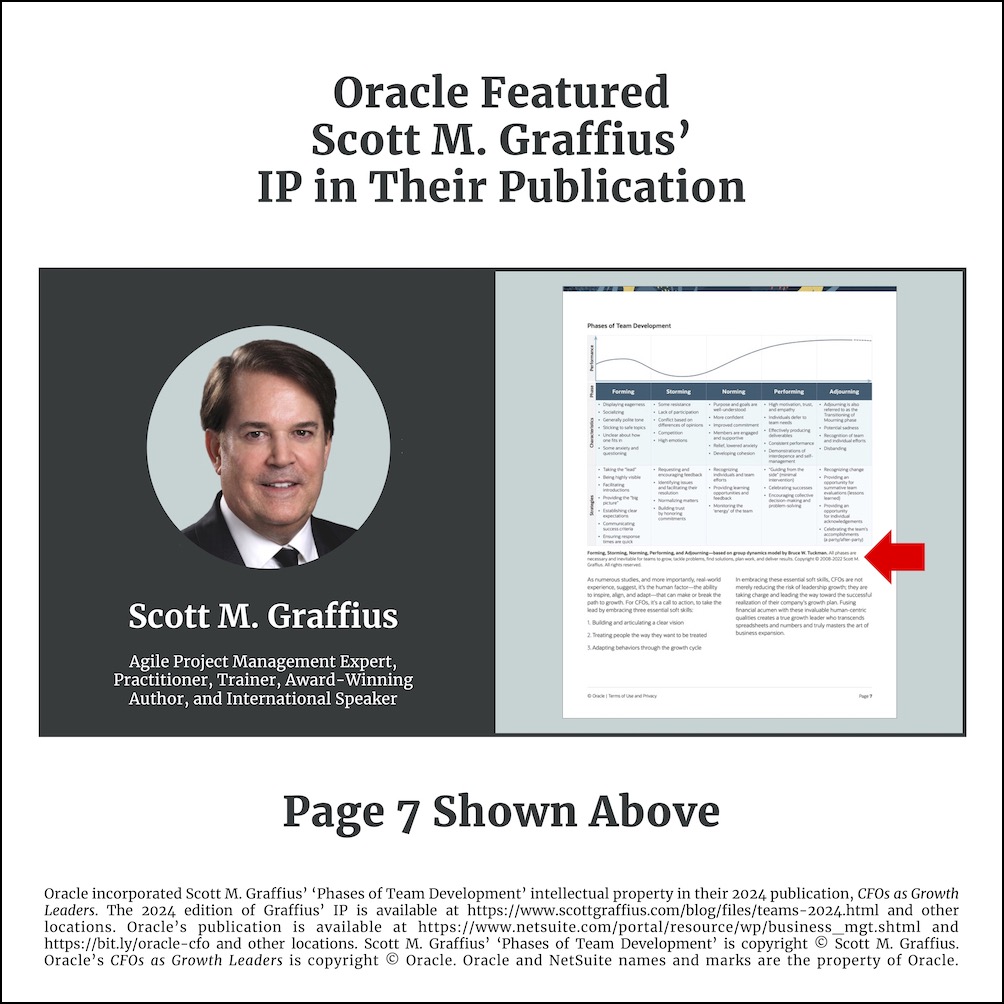
Page 7 of Oracle's CFOs as Growth Leaders is shown above.
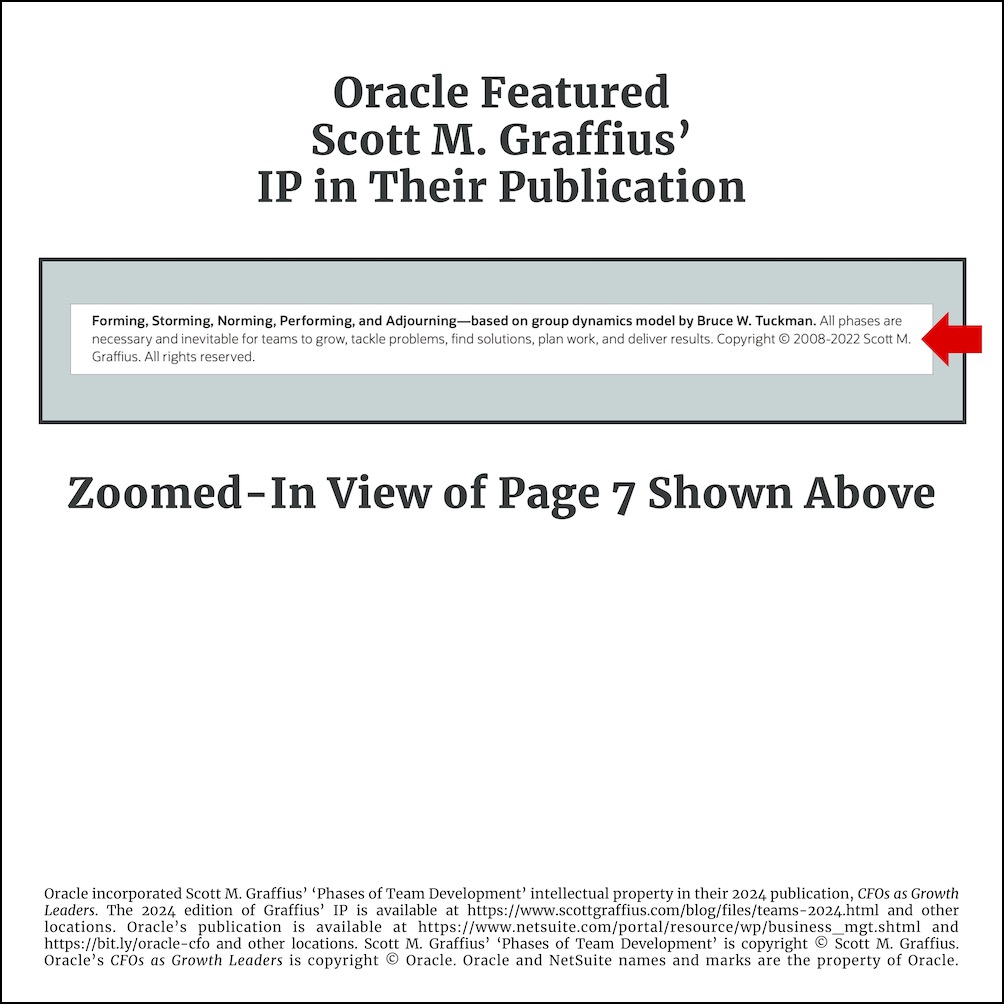
A zoomed-in view of page 7 of Oracle's CFOs as Growth Leaders is shown above.
Oracle’s publication is available at https://www.netsuite.com/portal/resource/wp/business_mgt.shtml and https://bit.ly/oracle-cfo and other locations.
Graffius initially developed his respective material in 2008, and he periodically refreshes it. Information on the current (2024) edition of his 'Phases of Team Development' IP is available at https://www.scottgraffius.com/blog/files/teams-2024.html and other locations.
Scott M. Graffius’ ‘Phases of Team Development’ is copyright © Scott M. Graffius. Oracle’s CFOs as Growth Leaders is copyright © Oracle. Oracle and NetSuite names and marks are the property of Oracle.





About Scott M. Graffius

Scott M. Graffius, PMP, SA, CSP-SM, CSP-PO, CSM, CSPO, ITIL, LSSGB is an agile project management practitioner, consultant, creator, award-winning author (Agile Scrum and Agile Transformation), and international public speaker. Founder and CEO of Exceptional PPM and PMO Solutions™ and subsidiary Exceptional Agility™, he has generated over $1.9 billion for Global Fortune 500 businesses and other organizations he has served. Graffius and content from his books, talks, workshops, and more have been featured and used by Microsoft, Oracle, Broadcom, Cisco, Adobe, Gartner, Project Management Institute, IEEE, Qantas, National Academy of Sciences, EU's European Commission, Amsterdam Public Health Research Institute, Boston University, U.S. National Park Service, Bayer, Ford, London South Bank University, Warsaw University of Technology, U.S. Tennis Association, Hasso Plattner Institute, American Management Association, Virginia Tech, University of Galway Ireland, UC San Diego, Yale University, and others. He delights audiences with dynamic and engaging talks and workshops on agile project management, AI, video game development, strategic alignment, the science of high performance teams, and more. To date, he's presented sessions at 91 conferences and other events across 25 countries. His full bio is available here.



About Agile Scrum: Your Quick Start Guide with Step-by-Step Instructions

Shifting customer needs are common in today's marketplace. Businesses must be adaptive and responsive to change while delivering an exceptional customer experience to be competitive.
There are a variety of frameworks supporting the development of products and services, and most approaches fall into one of two broad categories: traditional or agile. Traditional practices such as waterfall engage sequential development, while agile involves iterative and incremental deliverables. Organizations are increasingly embracing agile to manage projects, and best meet their business needs of rapid response to change, fast delivery speed, and more.
With clear and easy to follow step-by-step instructions, Scott M. Graffius's award-winning Agile Scrum: Your Quick Start Guide with Step-by-Step Instructions helps the reader:
- Implement and use the most popular agile framework―Scrum;
- Deliver products in short cycles with rapid adaptation to change, fast time-to-market, and continuous improvement; and
- Support innovation and drive competitive advantage.
Hailed by Literary Titan as “the book highlights the versatility of Scrum beautifully.”
Winner of 17 first place awards.
Agile Scrum: Your Quick Start Guide with Step-by-Step Instructions is available in paperback and ebook/Kindle in the United States and around the world. Some links by country follow.
- 🇧🇷 Brazil
- 🇨🇦 Canada
- 🇨🇿 Czech Republic
- 🇩🇰 Denmark
- 🇫🇮 Finland
- 🇫🇷 France
- 🇩🇪 Germany
- 🇬🇷 Greece
- 🇭🇺 Hungary
- 🇮🇳 India
- 🇮🇪 Ireland
- 🇮🇱 Israel
- 🇮🇹 Italy
- 🇯🇵 Japan
- 🇱🇺 Luxembourg
- 🇲🇽 Mexico
- 🇳🇱 Netherlands
- 🇳🇿 New Zealand
- 🇳🇴 Norway
- 🇪🇸 Spain
- 🇸🇪 Sweden
- 🇨🇭 Switzerland
- 🇦🇪 UAE
- 🇬🇧 United Kingdom
- 🇺🇸 United States

About Agile Transformation: A Brief Story of How an Entertainment Company Developed New Capabilities and Unlocked Business Agility to Thrive in an Era of Rapid Change

Thriving in today's marketplace frequently depends on making a transformation to become more agile. Those successful in the transition enjoy faster delivery speed and ROI, higher satisfaction, continuous improvement, and additional benefits.
Based on actual events, Agile Transformation: A Brief Story of How an Entertainment Company Developed New Capabilities and Unlocked Business Agility to Thrive in an Era of Rapid Change provides a quick (60-90 minute) read about a successful agile transformation at a multinational entertainment and media company, told from the author's perspective as an agile coach.
The award-winning book by Scott M. Graffius is available in paperback and ebook/Kindle in the United States and around the world. Some links by country follow.
- 🇦🇺 Australia
- 🇦🇹 Austria
- 🇧🇷 Brazil
- 🇨🇦 Canada
- 🇨🇿 Czech Republic
- 🇩🇰 Denmark
- 🇫🇮 Finland
- 🇫🇷 France
- 🇩🇪 Germany
- 🇬🇷 Greece
- 🇮🇳 India
- 🇮🇪 Ireland
- 🇯🇵 Japan
- 🇱🇺 Luxembourg
- 🇲🇽 Mexico
- 🇳🇱 Netherlands
- 🇳🇿 New Zealand
- 🇪🇸 Spain
- 🇸🇪 Sweden
- 🇨🇭 Switzerland
- 🇦🇪 United Arab Emirates
- 🇬🇧 United Kingdom
- 🇺🇸 United States

About Oracle
Oracle Corporation is a multinational computer technology company. In 2020, Oracle was the third-largest software company in the world by revenue and market capitalization. The company sells database software and cloud computing. Oracle's core application software is a suite of enterprise software products, such as enterprise resource planning (ERP) software, human capital management (HCM) software, customer relationship management (CRM) software, enterprise performance management (EPM) software, Customer Experience Commerce (CX Commerce) and supply chain management (SCM) software.
To learn more, visit https://www.oracle.com.

About Oracle NetSuite
For more than 25 years, Oracle NetSuite has helped organizations grow, scale, and adapt to change. NetSuite provides products and services tailored for small and medium-sized businesses (SMBs) including accounting and financial management, customer relationship management, inventory management, human capital management, payroll, procurement, project management, and e-commerce software. Its solutions are used by more than 38,000 across 219 countries.
Visit https://www.netsuite.com/portal/home.shtml to learn more.

How to Cite This Article
Graffius, Scott M. (2024, June 13). Oracle Featured Scott M. Graffius' IP on Team Tradecraft in Their Publication. Available at: https://scottgraffius.com/blog/files/oracle-2024.html. DOI: 10.13140/RG.2.2.14627.05920.



A PDF of this article is here.
© Copyright 2024 Scott M. Graffius. All rights reserved. This material may not be published, broadcast, rewritten or redistributed without the express written permission of Scott M. Graffius.

Johns Hopkins University Features the Work of Scott M. Graffius


Johns Hopkins University features Scott M. Graffius’ work!
Informed by the research of Bruce W. Tuckman and Mary Ann C. Jensen, over 100 subsequent studies, and Scott M. Graffius' first-hand professional experience with, and analysis of, team leadership and performance, Graffius created his 'Phases of Team Development' as a unique perspective and visual conveying the five phases of team development — Forming, Storming, Norming, Performing, and Adjourning — inclusive of a graph showing how performance varies by phase, as well as the characteristics and strategies for each phase. Graffius' 'Phases of Team Development' is registered with the U.S. Copyright Office.
Leaders of teams can apply Graffius' information to help handle challenges or issues experienced by teams. By doing so, they’ll advance the teams’ (and their own) happiness, productivity, and success.
Graffius' copyrighted 'Phases of Team Development' work is used by businesses, professional associations, government agencies, and universities around the world. Select examples include:
- Adobe,
- American Management Association,
- Amsterdam Public Health Research Institute,
- Bayer,
- Boston University,
- Broadcom,
- Cisco,
- Deimos Aerospace,
- DevOps Institute,
- Ford Motor Company,
- Hasso Plattner Institute (Germany),
- IEEE,
- London South Bank University,
- Microsoft,
- New Zealand Government,
- Oracle
- Torrens University Australia,
- UC San Diego,
- TBS Switzerland,
- UK Sports Institute,
- University of Galway Ireland,
- U.S. National Park Service,
- U.S. Tennis Association,
- Virginia Tech,
- Yale University,
- and many others.
Johns Hopkins University (JHU) was added to the list. JHU Carey Business School features Graffius’ ‘Phases of Team Development’ IP in its Business Communications (BU 120.601) course, taught by Steven D. Cohen, Ph.D., M.P.P.
Excerpts from a related presentation follow.

The title page of the JHU presentation is shown above.

Page 2 of the JHU presentation is shown above.

Page 3 of the JHU presentation is shown above.
Current Edition of Graffius’ ‘Phases of Team Development’ IP
Graffius initially developed his respective material in 2008, and he periodically refreshes it. Information on the current (2024) edition of his 'Phases of Team Development' IP is available at https://www.scottgraffius.com/blog/files/teams-2024.html.
About Johns Hopkins University
Johns Hopkins, founded in 1876, is America's first research university and home to nine world-class academic divisions working together as one university.
- The Johns Hopkins Carey Business School is the graduate business school of Johns Hopkins University, a private research university in Baltimore, Maryland. It was established in 2007 and offers full-time and part-time programs leading to the Master of Business Administration and Master of Science degrees.
- The School of Advanced International Studies’ interdisciplinary curriculum—delivered at locations on three continents and grounded in the study of international economics, international relations, and regional studies—prepares students to address the multifaceted challenges facing the world today.
- Krieger School of Arts and Sciences—comprised of 22 departments and 33 centers, programs, and institutes—is home to students interested in the arts, humanities, natural sciences, and social sciences.
- The School of Education prepares educators to make a difference in the lives of children and adults.
- The Whiting School of Engineering, a global leader in innovation and research, teaches students to think creatively while drawing upon mathematics and scientific principles to tackle difficult, real-world problems.
- The School of Medicine has revolutionized the education of physicians, the practice of medicine, and medical research nationally and internationally.
- The School of Nursing aims to improve health locally and globally through leadership and excellence in nursing education, research, practice, and service.
- Founded in 1857 as America’s first academy of music, the Peabody Institute trains musicians and dancers of every age and at every level through its degree-granting Conservatory and its community-based Preparatory.
- The Bloomberg School of Public Health educates scientists and public health professionals committed to the improvement of health and prevention of disease and disability around the world.
Visit https://www.jhu.edu/ to learn more.
About Business Communication (BU 120.601)
The JHU Business Communication (BU 120.601) course refines students’ skills in business writing, public speaking, and interpersonal communication. Through analyses and practice of communication strategies adopted by successful business professionals, students learn to write clearly and concisely, deliver compelling presentations, and construct effective arguments. See JHU’s course catalog at https://e-catalogue.jhu.edu/course-descriptions/management/ to learn more.
About Steven D. Cohen, Ph.D., M.P.P.
Steven D. Cohen is a Professor at the Johns Hopkins Carey Business School. He is well known for helping leaders communicate with confidence, influence, and authority. Dr. Cohen has been quoted in media outlets such as the Financial Times, Forbes, Vanity Fair, New York Magazine, and NBC News. To learn more about Professor Cohen, visit https://carey.jhu.edu/faculty/faculty-directory/steven-d-cohen-phd.





About Scott M. Graffius

Scott M. Graffius, PMP, SA, CSP-SM, CSP-PO, CSM, CSPO, ITIL, LSSGB is an agile project management practitioner, consultant, creator, award-winning author (Agile Scrum and Agile Transformation), and international public speaker. Founder and CEO of Exceptional PPM and PMO Solutions™ and subsidiary Exceptional Agility™, he has generated over $1.9 billion for Global Fortune 500 businesses and other organizations he has served. Graffius and content from his books, talks, workshops, and more have been featured and used by Microsoft, Oracle, Broadcom, Cisco, Adobe, Gartner, Project Management Institute, IEEE, Qantas, National Academy of Sciences, EU's European Commission, Amsterdam Public Health Research Institute, Boston University, U.S. National Park Service, Bayer, Ford, London South Bank University, Warsaw University of Technology, U.S. Tennis Association, Hasso Plattner Institute, American Management Association, Virginia Tech, University of Galway Ireland, UC San Diego, Yale University, and others. He delights audiences with dynamic and engaging talks and workshops on agile project management, AI, video game development, strategic alignment, the science of high performance teams, and more. To date, he's presented sessions at 91 conferences and other events across 25 countries. His full bio is available here.



About Agile Scrum: Your Quick Start Guide with Step-by-Step Instructions

Shifting customer needs are common in today's marketplace. Businesses must be adaptive and responsive to change while delivering an exceptional customer experience to be competitive.
There are a variety of frameworks supporting the development of products and services, and most approaches fall into one of two broad categories: traditional or agile. Traditional practices such as waterfall engage sequential development, while agile involves iterative and incremental deliverables. Organizations are increasingly embracing agile to manage projects, and best meet their business needs of rapid response to change, fast delivery speed, and more.
With clear and easy to follow step-by-step instructions, Scott M. Graffius's award-winning Agile Scrum: Your Quick Start Guide with Step-by-Step Instructions helps the reader:
- Implement and use the most popular agile framework―Scrum;
- Deliver products in short cycles with rapid adaptation to change, fast time-to-market, and continuous improvement; and
- Support innovation and drive competitive advantage.
Hailed by Literary Titan as “the book highlights the versatility of Scrum beautifully.”
Winner of 17 first place awards.
Agile Scrum: Your Quick Start Guide with Step-by-Step Instructions is available in paperback and ebook/Kindle in the United States and around the world. Some links by country follow.
- 🇧🇷 Brazil
- 🇨🇦 Canada
- 🇨🇿 Czech Republic
- 🇩🇰 Denmark
- 🇫🇮 Finland
- 🇫🇷 France
- 🇩🇪 Germany
- 🇬🇷 Greece
- 🇭🇺 Hungary
- 🇮🇳 India
- 🇮🇪 Ireland
- 🇮🇱 Israel
- 🇮🇹 Italy
- 🇯🇵 Japan
- 🇱🇺 Luxembourg
- 🇲🇽 Mexico
- 🇳🇱 Netherlands
- 🇳🇿 New Zealand
- 🇳🇴 Norway
- 🇪🇸 Spain
- 🇸🇪 Sweden
- 🇨🇭 Switzerland
- 🇦🇪 UAE
- 🇬🇧 United Kingdom
- 🇺🇸 United States

About Agile Transformation: A Brief Story of How an Entertainment Company Developed New Capabilities and Unlocked Business Agility to Thrive in an Era of Rapid Change

Thriving in today's marketplace frequently depends on making a transformation to become more agile. Those successful in the transition enjoy faster delivery speed and ROI, higher satisfaction, continuous improvement, and additional benefits.
Based on actual events, Agile Transformation: A Brief Story of How an Entertainment Company Developed New Capabilities and Unlocked Business Agility to Thrive in an Era of Rapid Change provides a quick (60-90 minute) read about a successful agile transformation at a multinational entertainment and media company, told from the author's perspective as an agile coach.
The award-winning book by Scott M. Graffius is available in paperback and ebook/Kindle in the United States and around the world. Some links by country follow.
- 🇦🇺 Australia
- 🇦🇹 Austria
- 🇧🇷 Brazil
- 🇨🇦 Canada
- 🇨🇿 Czech Republic
- 🇩🇰 Denmark
- 🇫🇮 Finland
- 🇫🇷 France
- 🇩🇪 Germany
- 🇬🇷 Greece
- 🇮🇳 India
- 🇮🇪 Ireland
- 🇯🇵 Japan
- 🇱🇺 Luxembourg
- 🇲🇽 Mexico
- 🇳🇱 Netherlands
- 🇳🇿 New Zealand
- 🇪🇸 Spain
- 🇸🇪 Sweden
- 🇨🇭 Switzerland
- 🇦🇪 United Arab Emirates
- 🇬🇧 United Kingdom
- 🇺🇸 United States

How to Cite This Article
Graffius, Scott M. (2024, August 1). Johns Hopkins University Features the Work of Scott M. Graffius. Available at: https://scottgraffius.com/blog/files/jhu-cbs.html. DOI: 10.13140/RG.2.2.35998.34889.

A PDF of this article is here
The short link for this article is https://bit.ly/jhu-cbs
© Copyright 2024 Scott M. Graffius. All rights reserved. This material may not be published, broadcast, rewritten or redistributed without the express written permission of Scott M. Graffius.

Boston Scientific Corporation Utilizes Scott M. Graffius' Intellectual Property
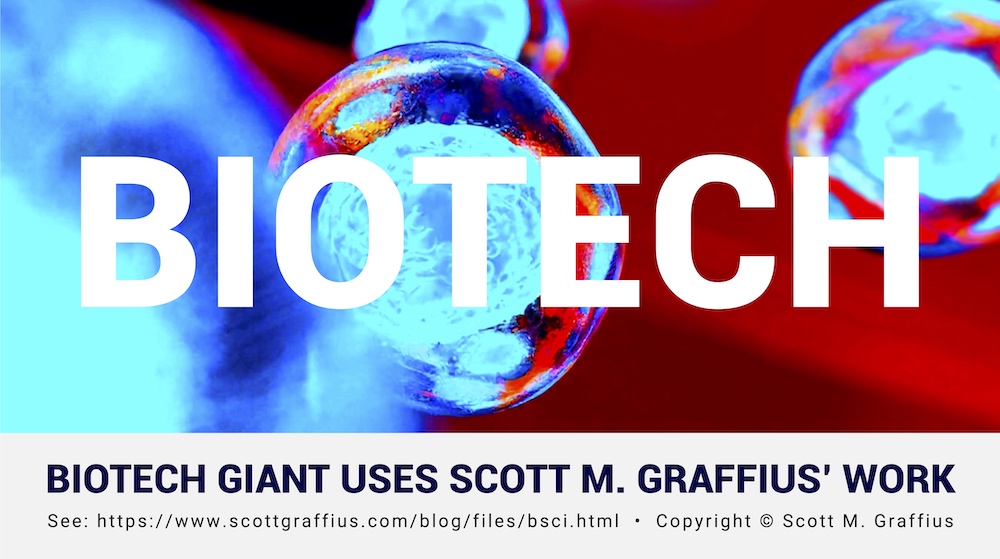
If there's an update after this article is published, the information will appear in the Post-Publication Notes section.

Scott M. Graffius' 'Phases of Team Development' Intellectual Property
Informed by the research of Bruce W. Tuckman and Mary Ann C. Jensen, over 100 subsequent studies, and Scott M. Graffius' first-hand professional experience with, and analysis of, team leadership and performance, Graffius created his ‘Phases of Team Development’ as a unique perspective and visual conveying the five phases of team development — Forming, Storming, Norming, Performing, and Adjourning — inclusive of a graph showing how performance varies by phase, as well as the characteristics and strategies for each phase.
Graffius' intellectual property (IP) is registered with the United States Copyright Office.
Graffius initially developed his ‘Phases of Team Development’ unique material in 2008, and he periodically refreshes it.
Graffius' property applicable to this story is here.
For reference only, the visual for the current (2024) edition is below and the details are here.

Organizations around the world engage Graffius to deliver compelling talks and workshops. To date, he's presented sessions at 91 conferences and other events across 25 countries, including:
- Armenia,
- Australia,
- Brazil,
- Canada,
- Czech Republic,
- Finland,
- France,
- Germany,
- Greece,
- Hong Kong,
- Hungary,
- India,
- Ireland,
- Lithuania,
- Luxembourg,
- Nepal,
- Netherlands,
- New Zealand,
- Norway,
- Romania,
- Sweden,
- Switzerland,
- United Arab Emirates,
- United Kingdom,
- and the United States.

Graffius ‘Phases of Team Development’ IP is central and key to many of those sessions. His rate card and a listing of his engagements are at https://scottgraffius.com/resources/Exceptional-PPM-and-PMO-Solutions-Rate-Card-for-2024-2025-v24071607.pdf and https://scottgraffius.com/publicspeaker.html, respectively.
With an authorization/license from Graffius, his ‘Phases of Team Development’ IP is featured and used by businesses, professional associations, government agencies, and universities around the world. Examples include:
- Adobe,
- American Management Association,
- Amsterdam Public Health Research Institute,
- Bayer,
- Boston University,
- Broadcom,
- Cisco,
- Deimos Aerospace,
- DevOps Institute,
- Ford Motor Company,
- Hasso Plattner Institute,
- IEEE,
- Johns Hopkins University,
- LeadingEng,
- London South Bank University,
- Manufacturers Alliance,
- Microsoft,
- New Zealand Government,
- Oracle,
- TBS Switzerland,
- Torrens University Australia,
- U.S. National Park Service,
- U.S. Tennis Association,
- UC San Diego,
- UK Sports Institute,
- University of Galway Ireland,
- Virginia Tech,
- Warsaw University,
- Yale University,
- and many others.
Copyrights protect the IP rights of creators, ensuring they receive recognition and compensation for their work, thus incentivizing creativity and innovation. Graffius is vigilant in upholding, protecting and enforcing his copyrights and other IP rights.
Boston Scientific — a global BioMed and BioTech corporation — used Graffius’ ‘Phases of Team Development’ IP without permission or attribution.
Notes:
- This article includes brief excerpts from Boston Scientific and other sources, attributed and used under fair use for news reporting and analysis. Graffius redacted sensitive information.
- Scott M. Graffius’ ‘Phases of Team Development’ IP is copyright © Scott M. Graffius. All rights reserved.
- Boston Scientific name, mark and content are the property of Boston Scientific Corporation. Boston Scientific images (logo and corporate headquarters) provided courtesy of Boston Scientific. © 2024 Boston Scientific Corporation or its affiliates. All rights reserved.
Boston Scientific Utilizes Scott M. Graffius' 'Phases of Team Development' IP Without Permission or Attribution
Boston Scientific is a biomedical/biotechnology engineering firm and multinational manufacturer of medical devices. Their website at https://www.bostonscientific.com/en-US/about-us.html informs that the company operates globally, employs 48,000 people, has invested $1.4 billion in research and development, and has $14.2 billion in net sales. A photo of their corporate headquarters is shown below.

Boston Scientific did not request nor receive permission to use Graffius' 'Phases of Team Development' IP.
Unfortunately, Boston Scientific's "Presentation Templates" site, shown next, includes content which infringes on Graffius' copyright.

The top of Boston Scientific's website includes four elements: Home, PowerPoint Templates, Visual & Data Templates, and “?”. As delineated below, selecting the "?" starts an email to [name redacted]@bsci.com.

As shown next, BSCI.com is the property of the Boston Scientific Corporation. Visual 1 of 2 is below.

Visual 2 of 2 is below.

And entering BSCI.com into a browser automatically takes the user to Boston Scientific's main website.
Selecting the URL (shown in the visual below) at Boston's Scientific's "Presentation Templates" site downloads a PowerPoint. Slide 1 (also shown in the visual below) infringes on Graffius' copyright.
Boston Scientific's use of Graffius' copyrighted text content is covered shortly.

As shown below, summary information for Boston Scientific's respective PowerPoint lists the author of the file as [name redacted]@bsci.com. That's the same identifier listed earlier. And again, @BSCI.com is a Boston Scientific address.

Boston Scientific's material infringes on Graffius' copyright. The infringement uses a significant portion (the majority of) Graffius' IP. There are too many examples to list, but some follow.
🟢 Under Forming, Scott M. Graffius’ copyrighted property includes “Questioning”
🔴 Under Forming, Boston Scientific’s infringing material includes “Questioning”
🟢 Under Forming, Scott M. Graffius’ copyrighted property includes “Socializing”
🔴 Under Forming, Boston Scientific’s infringing material includes “Socializing”
🟢 Under Forming, Scott M. Graffius’ copyrighted property includes “Displaying eagerness”
🔴 Under Forming, Boston Scientific’s infringing material includes “Displaying eagerness”
🟢 Under Forming, Scott M. Graffius’ copyrighted property includes “Sticking to safe topics”
🔴 Under Forming, Boston Scientific’s infringing material includes “Sticking to safe topics”
🟢 Under Forming, Scott M. Graffius’ copyrighted property includes “Taking the ‘lead’”
🔴 Under Forming, Boston Scientific’s infringing material includes “Taking the ‘lead’”
🟢 Under Forming, Scott M. Graffius’ copyrighted property includes “Quick response times”
🔴 Under Forming, Boston Scientific’s infringing material includes “Quick response times”
🟢 Under Storming, Scott M. Graffius’ copyrighted property includes “Resistance”
🔴 Under Storming, Boston Scientific’s infringing material includes “Resistance”
🟢 Under Storming, Scott M. Graffius’ copyrighted property includes “Lack of participation”
🔴 Under Storming, Boston Scientific’s infringing material includes “Lack of participation”
🟢 Under Storming, Scott M. Graffius’ copyrighted property includes “Conflict”
🔴 Under Storming, Boston Scientific’s infringing material includes “Conflict”
🟢 Under Storming, Scott M. Graffius’ copyrighted property includes “Competition”
🔴 Under Storming, Boston Scientific’s infringing material includes “Competition”
🟢 Under Storming, Scott M. Graffius’ copyrighted property includes “High emotions”
🔴 Under Storming, Boston Scientific’s infringing material includes “High emotions”
🟢 Under Storming, Scott M. Graffius’ copyrighted property includes “Normalizing matters”
🔴 Under Storming, Boston Scientific’s infringing material includes “Normalizing matters”
🟢 Under Norming, Scott M. Graffius’ copyrighted property includes “Encouraging leadership”
🔴 Under Norming, Boston Scientific’s infringing material includes “Encouraging leadership”
🟢 Under Norming, Scott M. Graffius’ copyrighted property includes “Reconciliation”
🔴 Under Norming, Boston Scientific’s infringing material includes “Reconciliation”
🟢 Under Norming, Scott M. Graffius’ copyrighted property includes “Developing cohesion”
🔴 Under Norming, Boston Scientific’s infringing material includes “Developing cohesion”
🟢 Under Performing, Scott M. Graffius’ copyrighted property includes “Healthy system”
🔴 Under Performing, Boston Scientific’s infringing material includes “Healthy system”
🟢 Under Performing, Scott M. Graffius’ copyrighted property includes “Celebrating”
🔴 Under Performing, Boston Scientific’s infringing material includes “Celebrating”
🟢 Under Adjourning, Scott M. Graffius’ copyrighted property includes “Shift to process orientation”
🔴 Under Adjourning, Boston Scientific’s infringing material includes “Shift to process orientation”
🟢 Under Adjourning, Scott M. Graffius’ copyrighted property includes “Sadness”
🔴 Under Adjourning, Boston Scientific’s infringing material includes “Sadness”
🟢 Under Adjourning, Scott M. Graffius’ copyrighted property includes “Recognizing change”
🔴 Under Adjourning, Boston Scientific’s infringing material includes “Recognizing change”
Those are just some examples.
Corresponding visuals follow. Here's part 1 of 2.

And here's part 2 of 2.

Boston Scientific did not request nor receive permission to use Graffius' IP. Nevertheless, Boston Scientific used a significant portion (the majority) of Graffius' IP and Boston Scientific did not credit Graffius as the author and copyright owner.
Ethics, Integrity, and IP Rights Including Copyright
What are Boston Scientific's stated commitments to ethics, integrity, and copyright and other IP rights? Answers follow.
As reported at https://www.bostonscientific.com/en-US/corporate-responsibility/integrity.html, Boston Scientific’s priorities include: “We believe in strong corporate governance and business practices that reflect our priorities, values and commitment to ethics and integrity.” But Boston Scientific infringed on Graffius' copyright.

In a press release at https://news.bostonscientific.com/news-releases?item=58870, Jim Tobin, President and Chief Executive Officer of Boston Scientific, is reported as saying: “Boston Scientific was built on the strength of its intellectual property.” But Boston Scientific utilized Graffius' IP — and without permission or attribution.

The company’s ‘Code of Conduct’ at https://www.bostonscientific.com/content/dam/bostonscientific/corporate/citizenship/compliance-ethics/Code%20of%20Conduct/2022/2022_CodeofConduct_English.pdf states that: “Boston Scientific protects its intellectual property rights to patents, trade names, trademarks, copyrights, trade secrets, and other intellectual property. We also respect the intellectual property rights of others.” But Boston Scientific infringed on Graffius' IP rights.

Boston Scientific addresses copyright infringement at https://www.bostonscientific.com/en-US/medical-specialties/electrophysiology/CRM-YouTube-Disclaimer.html, among other places. There, it informs that: “It is strictly forbidden to make copies, whether partial or total and on whichever media without prior approval. Anyone failing to respect this provision will be guilty of copyright infringement and liable to criminal punishment according to the law.” As shown, Boston Scientific's content infringes on Graffius' copyright.

Status
Scott M. Graffius notified Boston Scientific Corporation of their infringement. Here's an excerpt from Graffius' respective email:
"I did not receive a request to use my ‘Phases of Team Development’ IP nor did I provide an authorization/license for use. A significant portion (the majority) of my IP was used. The use did not credit me as the author and copyright owner. The use has damaged the marketability and value of my IP. For those reasons, among others, your use is not ‘fair use’ nor ‘fair dealing.’ Your use infringes on my copyright."
"Immediately remove your infringing material from your website at the aforementioned link and anywhere else it is located or used, in any form — digital or hard copy."
"I reserve all rights in this serious matter."
As of the time of this article, Boston Scientific Corporation has not responded to the notice nor discontinued their infringement of Graffius' IP.
Post-publication notes appear at the end of this article.







About Scott M. Graffius

Scott M. Graffius, PMP, SA, CSP-SM, CSP-PO, CSM, CSPO, ITIL, LSSGB is an Agile project management expert practitioner, consultant, creator, multi-award-winning author, and international public speaker.
He's generated over $1.9 billion of business value in aggregate for Global Fortune 500 businesses and other organizations he's served. Businesses and industries range from consumer products to advanced technology (including AI, R&D), e-commerce, music, streaming/OTT video, television, film, video games, financial services, government, and more.
Graffius and content from his books (Agile Scrum and Agile Transformation), talks, workshops, and more have been featured and used by businesses, professional associations, governments, and universities around the world. Examples include Adobe, American Management Association, Amsterdam Public Health Research Institute, Bayer, Boston University, Broadcom, Cisco, Deimos Aerospace, DevOps Institute, EU's European Commission, Ford Motor Company, Hasso Plattner Institute Germany, IEEE, Johns Hopkins University, London South Bank University, Microsoft, National Academy of Sciences, New Zealand Government, Oracle, Project Management Institute, Torrens University Australia, UC San Diego, TBS Switzerland, UK Sports Institute, University of Galway Ireland, U.S. Department of Energy, U.S. National Park Service, U.S. Tennis Association, Virginia Tech, Warsaw University of Technology, Yale University, Zurich University of Applied Sciences, and many others.
He delights audiences around the world with dynamic and engaging talks and workshops. He's presented sessions at 91 conferences and other events across 25 countries. Visit here to learn more and here to ask Scott to speak at your event.



About Agile Scrum: Your Quick Start Guide with Step-by-Step Instructions

Shifting customer needs are common in today's marketplace. Businesses must be adaptive and responsive to change while delivering an exceptional customer experience to be competitive.
There are a variety of frameworks supporting the development of products and services, and most approaches fall into one of two broad categories: traditional or agile. Traditional practices such as waterfall engage sequential development, while agile involves iterative and incremental deliverables. Organizations are increasingly embracing agile to manage projects, and best meet their business needs of rapid response to change, fast delivery speed, and more.
With clear and easy to follow step-by-step instructions, Scott M. Graffius's award-winning Agile Scrum: Your Quick Start Guide with Step-by-Step Instructions helps the reader:
- Implement and use the most popular agile framework―Scrum;
- Deliver products in short cycles with rapid adaptation to change, fast time-to-market, and continuous improvement; and
- Support innovation and drive competitive advantage.
Hailed by Literary Titan as “the book highlights the versatility of Scrum beautifully.”
Winner of 17 first place awards.
Agile Scrum: Your Quick Start Guide with Step-by-Step Instructions is available in paperback and ebook/Kindle in the United States and around the world. Some links by country follow.
- 🇧🇷 Brazil
- 🇨🇦 Canada
- 🇨🇿 Czech Republic
- 🇩🇰 Denmark
- 🇫🇮 Finland
- 🇫🇷 France
- 🇩🇪 Germany
- 🇬🇷 Greece
- 🇭🇺 Hungary
- 🇮🇳 India
- 🇮🇪 Ireland
- 🇮🇱 Israel
- 🇮🇹 Italy
- 🇯🇵 Japan
- 🇱🇺 Luxembourg
- 🇲🇽 Mexico
- 🇳🇱 Netherlands
- 🇳🇿 New Zealand
- 🇳🇴 Norway
- 🇪🇸 Spain
- 🇸🇪 Sweden
- 🇨🇭 Switzerland
- 🇦🇪 UAE
- 🇬🇧 United Kingdom
- 🇺🇸 United States

About Agile Transformation: A Brief Story of How an Entertainment Company Developed New Capabilities and Unlocked Business Agility to Thrive in an Era of Rapid Change

Thriving in today's marketplace frequently depends on making a transformation to become more agile. Those successful in the transition enjoy faster delivery speed and ROI, higher satisfaction, continuous improvement, and additional benefits.
Based on actual events, Agile Transformation: A Brief Story of How an Entertainment Company Developed New Capabilities and Unlocked Business Agility to Thrive in an Era of Rapid Change provides a quick (60-90 minute) read about a successful agile transformation at a multinational entertainment and media company, told from the author's perspective as an agile coach.
The award-winning book by Scott M. Graffius is available in paperback and ebook/Kindle in the United States and around the world. Some links by country follow.
- 🇦🇺 Australia
- 🇦🇹 Austria
- 🇧🇷 Brazil
- 🇨🇦 Canada
- 🇨🇿 Czech Republic
- 🇩🇰 Denmark
- 🇫🇮 Finland
- 🇫🇷 France
- 🇩🇪 Germany
- 🇬🇷 Greece
- 🇮🇳 India
- 🇮🇪 Ireland
- 🇯🇵 Japan
- 🇱🇺 Luxembourg
- 🇲🇽 Mexico
- 🇳🇱 Netherlands
- 🇳🇿 New Zealand
- 🇪🇸 Spain
- 🇸🇪 Sweden
- 🇨🇭 Switzerland
- 🇦🇪 United Arab Emirates
- 🇬🇧 United Kingdom
- 🇺🇸 United States


How to Cite This Article
Graffius, Scott M. (2024, August 19). Boston Scientific Corporation Utilizes Scott M. Graffius' Intellectual Property. Available at: https://scottgraffius.com/blog/files/bsci.html. DOI: 10.13140/RG.2.2.14032.32001.


Post-Publication Notes
If there are any supplements or updates to this article after the date of publication, they will appear here.
Update on 13 October 2024
Graffius notified Boston Scientific via email on 12 August 2024 about their violation of his intellectual property rights. This article was published on 19 August 2024.
As of today, 13 October 2024, Boston Scientific has not responded to Graffius’ notice of their violation. However, Graffius observed that Boston Scientific disabled access to their infringing content. Specifically, the https://r.mobirisesite.com/292221/assets/files/Stages-of-Group-Development-.pptx link that went to their infringing content before now displays an error page. A screen shot is below.

Again, Boston Scientific blatantly violated Graffius' copyright, damaging the marketability and value of his intellectual property. Copyright infringement is so serious that it is a Federal crime.
This consequential matter is currently open. It is not resolved.
Graffius reserves his rights. If Graffius opts to take legal action against Boston Scientific for their violation of his copyright, the Federal case will include the greater of statutory damages or actual damages, special charges for willful infringement (which has been clarified by the courts to be either "intentional behavior" or merely "reckless behavior"), and additional costs.
Any additional updates will appear here.

A PDF of this article is here
The short link for this article is https://bit.ly/bsci-x
A link to the infringing PowerPoint file is here
© Copyright 2024 Scott M. Graffius. All rights reserved. This material may not be published, broadcast, rewritten or redistributed without the express written permission of Scott M. Graffius.

FINAT (Fédération Internationale des Fabricants et Transformateurs d'Adhésifs et Thermocollants sur Papiers et Autres Supports) Features Scott M. Graffius’ Intellectual Property


Scott M. Graffius' Intellectual Property on Teamwork Tradecraft
Informed by the research of Bruce W. Tuckman and Mary Ann C. Jensen, over 100 subsequent studies, and Scott M. Graffius' first-hand professional experience with, and analysis of, team leadership and performance, Graffius created his ‘Phases of Team Development’ as a unique perspective and visual conveying the five phases of team development — Forming, Storming, Norming, Performing, and Adjourning — inclusive of a graph showing how performance varies by phase, as well as the characteristics and strategies for each phase.
Graffius' intellectual property (IP) is registered with the United States Copyright Office.
Graffius initially developed his ‘Phases of Team Development’ unique material in 2008, and he periodically refreshes it.
For reference, the visual for the current (2024) edition is below and the details are here.

Organizations around the world engage Graffius to deliver compelling talks and workshops. To date, he's presented sessions at 91 conferences and other events across 25 countries: Armenia, Australia, Brazil, Canada, Czech Republic, Finland, France, Germany, Greece, Hong Kong, Hungary, India, Ireland, Lithuania, Luxembourg, Nepal, Netherlands, New Zealand, Norway, Romania, Sweden, Switzerland, United Arab Emirates, United Kingdom, and the United States.

Graffius ‘Phases of Team Development’ IP is central and key to many of those sessions. His rate card and a listing of his engagements are at https://scottgraffius.com/resources/Exceptional-PPM-and-PMO-Solutions-Rate-Card-for-2024-2025-v24071607.pdf and https://scottgraffius.com/publicspeaker.html, respectively.

Graffius' 'Phases of Team Development' Intellectual Property Is Used By Organizations Around The World — And FINAT Was Added To The List
With an authorization/license from Graffius, his ‘Phases of Team Development’ IP is featured and used by businesses, professional associations, government agencies, and universities around the globe. Examples include:
- Adobe,
- American Management Association,
- Amsterdam Public Health Research Institute,
- Bayer,
- Boston University,
- Broadcom,
- Cisco,
- Deimos Aerospace,
- DevOps Institute,
- Erste Group Bank AG (Austria),
- Ford Motor Company,
- FSU College of Medicine,
- Hasso Plattner Institute,
- IEEE,
- James Madison University,
- Johns Hopkins University,
- LeadingEng,
- London South Bank University,
- Manufacturers Alliance,
- Microsoft,
- New Zealand Government,
- Oracle,
- Royal Australasian College of Physicians,
- TBS Switzerland,
- Torrens University Australia,
- Tufts University,
- U.S. National Park Service,
- U.S. Tennis Association,
- UC San Diego,
- UK Sports Institute,
- University of Galway Ireland,
- Victorian Institute of Technology (Australia),
- Virginia Tech,
- Warsaw University,
- Western Sydney University,
- World Resources Institute,
- Yale University,
- ZHAW Zurich University of Applied Sciences,
- and many others.
FINAT — the international association for the label industry’s development, education, and innovation — was added to the list.
The following visual shows a post from FINAT on LinkedIn with text about and pictures (including one featuring Graffius’ IP) from the FINAT Committee Summit in May 2024 in Amsterdam.

The following visual includes a picture from FINAT on LinkedIn. It shows Graffius’ 'Phases of Team Development' IP displayed on-screen in a talk at the FINAT Committee Summit in May 2024 in Amsterdam.

To learn more about FINAT, read on.
To learn more about Graffius' 'Phases of Team Development' intellectual property, visit here.

This article uses limited excerpts from FINAT (a post shared by FINAT on LinkedIn, and a picture from the same post featuring Graffius’ IP), attributed to FINAT and used under fair use for news reporting and analysis. FINAT name, mark, and content are the property of FINAT. Graffius’ ‘Phases of Team Development’ is copyright © Scott M. Graffius. All rights reserved.

About FINAT
FINAT is the international association for the label industry’s development, education, and innovation.
FINAT is an abbreviation for Fédération Internationale des Fabricants et Transformateurs d'Adhésifs et Thermocollants sur Papiers et Autres Supports. In English: International Federation of Manufacturers and Processors of Adhesives and Heat-Sealable Materials on Paper and Other Supports.
FINAT’s mission involves empowering the label industry by being the uniting platform that helps the international label industry excel in their daily business. FINAT's scope is to:
- Provide a global communication and networking platform for converters and direct and indirect suppliers.
- Represent members' interests.
- Provide a central source for industry information.
- Produce and distribute related educational and technical publications.
- Represent the industry's views at the EU level.
- Establish and maintain industry-related best practices, standards, and test methods.
To learn more, visit https://www.finat.com.

About Scott M. Graffius

Scott M. Graffius is a global leader in agile project management, an expert on teamwork tradecraft, an authority on temporal dynamics on social media platforms, a creator, a consultant, a trainer, an award-winning author, and an international public speaker.
He's generated over $1.9 billion of business value in aggregate for Global Fortune 500 businesses and other organizations he's served. Businesses and industries range from consumer products to advanced technology (including AI, R&D), e-commerce, music, streaming/OTT video, television, film, video games, financial services, government, and more.
Graffius and content from his books (Agile Scrum and Agile Transformation), talks, workshops, and more have been featured and used by businesses, professional associations, governments, and universities around the world. Examples include Adobe, American Management Association, Amsterdam Public Health Research Institute, Bayer, Boston University, Broadcom, Cisco, Deimos Aerospace, DevOps Institute, EU's European Commission, Ford Motor Company, Hasso Plattner Institute Germany, IEEE, Johns Hopkins University, London South Bank University, Microsoft, National Academy of Sciences, New Zealand Government, Oracle, Project Management Institute, Torrens University Australia, UC San Diego, TBS Switzerland, UK Sports Institute, University of Galway Ireland, U.S. Department of Energy, U.S. National Park Service, U.S. Tennis Association, Virginia Tech, Warsaw University of Technology, Yale University, Zurich University of Applied Sciences, and many others.
He delights audiences around the world with dynamic and engaging talks and workshops. He's presented sessions at 91 conferences and other events across 25 countries. Visit here to learn more and here to ask Scott to speak at your event.



About Agile Scrum: Your Quick Start Guide with Step-by-Step Instructions

Shifting customer needs are common in today's marketplace. Businesses must be adaptive and responsive to change while delivering an exceptional customer experience to be competitive.
There are a variety of frameworks supporting the development of products and services, and most approaches fall into one of two broad categories: traditional or agile. Traditional practices such as waterfall engage sequential development, while agile involves iterative and incremental deliverables. Organizations are increasingly embracing agile to manage projects, and best meet their business needs of rapid response to change, fast delivery speed, and more.
With clear and easy to follow step-by-step instructions, Scott M. Graffius's award-winning Agile Scrum: Your Quick Start Guide with Step-by-Step Instructions helps the reader:
- Implement and use the most popular agile framework―Scrum;
- Deliver products in short cycles with rapid adaptation to change, fast time-to-market, and continuous improvement; and
- Support innovation and drive competitive advantage.
Hailed by Literary Titan as “the book highlights the versatility of Scrum beautifully.”
Winner of 17 first place awards.
Agile Scrum: Your Quick Start Guide with Step-by-Step Instructions is available in paperback and ebook/Kindle in the United States and around the world. Some links by country follow.
- 🇧🇷 Brazil
- 🇨🇦 Canada
- 🇨🇿 Czech Republic
- 🇩🇰 Denmark
- 🇫🇮 Finland
- 🇫🇷 France
- 🇩🇪 Germany
- 🇬🇷 Greece
- 🇭🇺 Hungary
- 🇮🇳 India
- 🇮🇪 Ireland
- 🇮🇱 Israel
- 🇮🇹 Italy
- 🇯🇵 Japan
- 🇱🇺 Luxembourg
- 🇲🇽 Mexico
- 🇳🇱 Netherlands
- 🇳🇿 New Zealand
- 🇳🇴 Norway
- 🇪🇸 Spain
- 🇸🇪 Sweden
- 🇨🇭 Switzerland
- 🇦🇪 UAE
- 🇬🇧 United Kingdom
- 🇺🇸 United States

About Agile Transformation: A Brief Story of How an Entertainment Company Developed New Capabilities and Unlocked Business Agility to Thrive in an Era of Rapid Change

Thriving in today's marketplace frequently depends on making a transformation to become more agile. Those successful in the transition enjoy faster delivery speed and ROI, higher satisfaction, continuous improvement, and additional benefits.
Based on actual events, Agile Transformation: A Brief Story of How an Entertainment Company Developed New Capabilities and Unlocked Business Agility to Thrive in an Era of Rapid Change provides a quick (60-90 minute) read about a successful agile transformation at a multinational entertainment and media company, told from the author's perspective as an agile coach.
The award-winning book by Scott M. Graffius is available in paperback and ebook/Kindle in the United States and around the world. Some links by country follow.
- 🇦🇺 Australia
- 🇦🇹 Austria
- 🇧🇷 Brazil
- 🇨🇦 Canada
- 🇨🇿 Czech Republic
- 🇩🇰 Denmark
- 🇫🇮 Finland
- 🇫🇷 France
- 🇩🇪 Germany
- 🇬🇷 Greece
- 🇮🇳 India
- 🇮🇪 Ireland
- 🇯🇵 Japan
- 🇱🇺 Luxembourg
- 🇲🇽 Mexico
- 🇳🇱 Netherlands
- 🇳🇿 New Zealand
- 🇪🇸 Spain
- 🇸🇪 Sweden
- 🇨🇭 Switzerland
- 🇦🇪 United Arab Emirates
- 🇬🇧 United Kingdom
- 🇺🇸 United States


How to Cite This Article
Graffius, Scott M. (2024, September 12). FINAT (Fédération Internationale des Fabricants et Transformateurs d'Adhésifs et Thermocollants sur Papiers et Autres Supports) Features Scott M. Graffius’ Intellectual Property. Available at: https://scottgraffius.com/blog/files/finat.html. DOI: 10.13140/RG.2.2.16446.50244.


Post-Publication Notes
If there are any supplements or updates to this article after the date of publication, they will appear here.

A PDF of this article is here
The short link for this article is https://bit.ly/finat-24
© Copyright 2024 Scott M. Graffius. All rights reserved. This material may not be published, broadcast, rewritten or redistributed without the express written permission of Scott M. Graffius.

Radio Silence from the American Association of Neurological Surgeons on Report of Blatant Plagiarism in Their ‘Journal of Neurosurgery’ Publication


If there's an update after this article is published, the information will appear in the Post-Publication Notes section.

Introduction
Plagiarism, defined as ‘to steal and pass off (the ideas or words of another) as one’s own: use (another's production) without crediting the source’ (source: Merriam-Webster), damages trust, credibility, and the value of original content. The theft of intellectual property distorts the scholarly record and results in misinformation. It often violates copyright as well.
Publications must respond decisively to plagiarism reports by swiftly acknowledging complaints, conducting thorough investigations, and taking appropriate actions such as retractions.

Quiz Question
The visual at the top of this article depicts a quiz related to a real situation. Here's the question:
You discovered blatant plagiarism in a Journal of Neurosurgery publication of the American Association of Neurological Surgeons. You reported it—with detailed specifics and indisputable evidence—to the authors, the editors, and the publisher. What should happen next (within five business days)?
🔘 A. The publisher or one or more of the authors or editors replies with, “Thank you for alerting us about the violation; we’re looking into it.”
🔘 B. The publisher or one or more of the authors or editors challenges you to a duel to defend their honor.
🔘 C. Neither the publisher nor any of the authors or editors responds. Radio silence.

Quiz Answer
The question is about what should happen. For that reason, the correct answer about what should happen is: 'A. The publisher or one or more of the authors or editors replies with, "Thank you for alerting us about the violation; we're looking into it."
When publications receive a report of plagiarism, they should promptly acknowledge receipt of the report by responding within no longer than five business days. This action demonstrates transparency, professionalism, and a commitment to maintaining the integrity of the academic record. Conversely, not expeditiously acknowledging receipt of the report conveys a lack of transparency, a lack of professionalism, and a lack of commitment to integrity.

Radio Silence by the Publisher, the Editors, and the Authors
It would be nice if the quiz above was just a hypothetical/thought experiment. Unfortunately, it's related to the real situation where Scott M. Graffius discovered blatant plagiarism in a Journal of Neurosurgery publication of the American Association of Neurological Surgeons and notified the authors, the editors, and the publisher of the violation on 24 September 2024.
As mentioned earlier, publishers should promptly acknowledge receipt of plagiarism reports by responding within no longer than five business days. As of the date of this article (8 October 2024), 10 business days (14 calendar days) have elapsed since the violation was reported. And the publisher, the editors, and the authors maintain radio silence.
Plagiarism is bad. By not acknowledging receipt of the report, the publisher, the editors, and the authors made the bad situation worst. And the publisher (JNS Publishing Group / American Association of Neurological Surgeons) has not yet taken action such as retraction or removal of the infringing material.

It is imperative that the publisher demonstrate—through their actions—a commitment to upholding the highest standards of ethics and intellectual property rights. The publisher must take immediate and decisive action such as retracting or removing the infringing content. Otherwise, the publisher is knowingly endorsing, permitting or otherwise allowing ongoing misinformation and the perpetual violation of Graffius' intellectual property.
Details follow. If there's an update on this consequential matter after this article is published, the information will appear in the Post-Publication Notes section.


Details on the Plagiarism
On 24 September 2024, Scott M. Graffius observed plagiarism in a Journal of Neurosurgery (JNS) publication of the American Association of Neurological Surgeons. That same day, Graffius wrote to the publisher, the editors, and the authors of the violating material. His email was titled, 'JNS paper plagiarized and damaged the marketability and value of Scott M. Graffius’ copyrighted property.' It contained detailed specifics and indisputable evidence. Saved as a PDF, Graffius' email is 19 pages.
As a high-level overview, thumbnails of the 19-page email are shown below. Then, select 'readable' excerpts are provided.

Excerpts from Graffius' 19-page email follow. They're shown in italic font.
Here's an excerpt from the introduction section of Graffius' email.
Authors of a Journal of Neurosurgery (JNS) paper plagiarized Graffius’ copyrighted ‘Phases of Team Development’ property, constituting a profound and disgraceful breach of professional ethics, moral standards, and Graffius’ intellectual property rights. Here are the specifics on the publication.
- Publication: Journal of Neurosurgery
- Publisher: JNS Publishing Group, American Association of Neurological Surgeons
- Paper: Developing interdisciplinary research teams in neurosurgery: key elements to success in brachial plexus and peripheral nerve surgery
- Authors: Whitney E. Muhlestein, MD; Kate W. C. Chang, MA, MS; Denise Justice, OTRL, Sarah Johnson, MS, OTRL; Shawn Brown; and Miriana Popadich, MSN, NP-C
- Publication Date: 12 May 2023
- Volume/Issue: Volume 139: Issue 6
- Page Range: 1552-1559
- DOI link: https://doi.org/10.3171/2023.4.JNS222254
Here's an excerpt from the section of the email with background information.
Informed by the research of Bruce W. Tuckman, Ph.D. and Mary Ann C. Jensen, over 100 subsequent studies, and Scott M. Graffius’ first-hand professional experience with, and analysis of, team leadership and performance, Graffius created his ‘Phases of Team Development.’ It’s a unique perspective on the five phases of team development — Forming, Storming, Norming, Performing, and Adjourning — and it’s inclusive of the characteristics/features/traits and strategies for each phase.
Graffius’ ‘Phases of Team Development’ intellectual property is registered with the United States Copyright Office.
The integrated text from Graffius’ copyrighted property applies in this case.
Graffius initially developed his intellectual property in 2008, and he periodically refreshes it. An authorized example of his copyrighted property applicable in this case (2022 edition) is here: https://www.scottgraffius.com/blog/files/teams- 2022.html .
Here's more from the section of the email with background information.
Graffius’ copyright ownership details are integrated into and appear on his copyrighted property. Specifically, it reads: “Copyright © 2008-2022 Scott M. Graffius. All rights reserved. For permission requests, contact scott@scottgraffius.com.”
Additionally, his respective article includes this: “To request permission to use the 'Phases of Team Development' visual, contact Scott M. Graffius. If approved, high resolution JPG and PNG image files will be provided, subject to terms and conditions.”
And also this: “© Copyright 2022 Scott M. Graffius. All rights reserved. This material may not be published, broadcast, rewritten or redistributed without the express written permission of Scott M. Graffius.”
Conference organizers, businesses, professional associations, government agencies, and universities around the world engage Graffius to deliver compelling talks and workshops. To date, he’s presented sessions at 91 conferences and other events across 25 countries, including:
- Armenia,
- Australia,
- Brazil,
- Canada,
- Czech Republic,
- Finland,
- France,
- Germany,
- Greece,
- Hong Kong,
- Hungary,
- India,
- Ireland,
- Lithuania,
- Luxembourg,
- Nepal,
- Netherlands,
- New Zealand,
- Norway,
- Romania,
- Sweden,
- Switzerland,
- United Arab Emirates,
- United Kingdom,
- and the United States.
Graffius’ ‘Phases of Team Development’ intellectual property is central and key to many of those sessions. His rate card and a listing of his engagements are at https://scottgraffius.com/resources/Exceptional-PPM-and-PMO-Solutions- Rate-Card-for-2024-2025-v24071607.pdf and https://scottgraffius.com/publicspeaker.html, respectively.
With an authorization/license from Graffius, many organizations around the world have featured and used his copyrighted ‘Phases of Team Development’ work. Select examples include:
- Adobe,
- American Management Association,
- Amsterdam Public Health Research Institute,
- Boston University,
- Broadcom,
- Cisco,
- Deimos Aerospace,
- DevOps Institute,
- Erste Group Bank AG (Austria),
- FINAT,
- Ford Motor Company,
- FSU College of Medicine,
- Hasso Plattner Institute (Germany),
- IEEE,
- Johns Hopkins University,
- LeadingEng,
- London South Bank University,
- Manufacturers Alliance,
- Microsoft,
- New Zealand Government,
- Oracle,
- Royal Australasian College of Physicians,
- TBS Switzerland,
- Torrens University (Australia),
- Tufts University,
- U.S. National Park Service,
- U.S. Tennis Association,
- UC San Diego,
- UK Sports Institute,
- University of Galway (Ireland),
- Victorian Institute of Technology (Australia),
- Virginia Tech,
- Warsaw University,
- Western Sydney University (Australia),
- World Resources Institute,
- Yale University,
- ZHAW Zurich University of Applied Sciences,
- and many others.
The following excerpts are from the section of the email detailing the violation.
Again, Graffius’ copyright ownership details and permission request information are clearly noted.
Authors (Whitney E. Muhlestein, MD; Kate W. C. Chang, MA, MS; Denise Justice, OTRL, Sarah Johnson, MS, OTRL; Shawn Brown; and Miriana Popadich, MSN, NP-C) of the JNS paper ('Developing interdisciplinary research teams in neurosurgery: key elements to success in brachial plexus and peripheral nerve surgery') did not request nor receive permission to use Graffius’ copyrighted property.
Nevertheless, the authors used Graffius’ copyrighted property in their JNS article: they plagiarized Graffius’ work, damaging the marketability and value of his intellectual property.
The following excerpts from the email provide some side-by-side examples of Graffius' copyrighted property and the plagiarism in the JNS publication.
- Content from Scott M. Graffius 2022 copyrighted property: “High motivation, trust, and empathy”
- Content from 2023 JNS article, plagiarizing Graffius’ work: “High motivation, trust, and empathy”
- Content from Scott M. Graffius 2022 copyrighted property: “Individuals defer to team needs”
- Content from 2023 JNS article, plagiarizing Graffius’ work: “Individuals defer to team needs”
- Content from Scott M. Graffius 2022 copyrighted property: “Effectively producing deliverables”
- Content from 2023 JNS article, plagiarizing Graffius’ work: “Effectively producing deliverables”
- Content from Scott M. Graffius 2022 copyrighted property: “Consistent performance”
- Content from 2023 JNS article, plagiarizing Graffius’ work: “Consistent performance”
- Content from Scott M. Graffius 2022 copyrighted property: “Demonstrations of interdependence”
- Content from 2023 JNS article, plagiarizing Graffius’ work: “Demonstrations of interdependence”
- Content from Scott M. Graffius 2022 copyrighted property: “Purpose and goals are well-understood”
- Content from 2023 JNS article, plagiarizing Graffius’ work: “Purpose and goals are well-understood”
- Content from Scott M. Graffius 2022 copyrighted property: “More confident”
- Content from 2023 JNS article, plagiarizing Graffius’ work: “More confidence”
- Content from Scott M. Graffius 2022 copyrighted property: “Members are engaged and supportive”
- Content from 2023 JNS article, plagiarizing Graffius’ work: “Members are engaged and supportive”
The exhibit below also shows some examples of the blatant plagiarism.

The following excerpts are from the conclusion section of Graffius' email.
Graffius’ copyright ownership details are integrated into and appear on his copyrighted property. Specifically, it reads: “Copyright © 2008-2022 Scott M. Graffius. All rights reserved. For permission requests, contact scott@scottgraffius.com.” Additionally, his article includes this: “To request permission to use the 'Phases of Team Development' visual, contact Scott M. Graffius. If approved, high resolution JPG and PNG image files will be provided, subject to terms and conditions.” And also this: “© Copyright 2022 Scott M. Graffius. All rights reserved. This material may not be published, broadcast, rewritten or redistributed without the express written permission of Scott M. Graffius.”
Authors (Whitney E. Muhlestein, MD; Kate W. C. Chang, MA, MS; Denise Justice, OTRL, Sarah Johnson, MS, OTRL; Shawn Brown; and Miriana Popadich, MSN, NP-C) of the JNS paper (Developing interdisciplinary research teams in neurosurgery: key elements to success in brachial plexus and peripheral nerve surgery) did not request nor receive permission to use Graffius’ copyrighted property.
The authors of the JNS paper used Graffius’ copyrighted property, including plagiarizing it. The JNS paper did not attribute material to Graffius through citation or otherwise. By doing so, the authors are wrongly leading others to falsely believe that they are the author and owner of Graffius’ respective copyrighted content.
The JNS authors’ plagiarism damaged the marketability and value of Graffius’ copyrighted property.
The aforementioned actions of the authors of the JNS paper are a disgraceful breach of professional ethics, moral standards, and Graffius’ intellectual property rights.
The following excerpt is also from the conclusion section of Graffius' email.
Graffius maintains, enforces, and protects his copyright and other intellectual property rights. He is consulting with an IP attorney in Los Angeles. Graffius reserves his rights in this disturbing and consequential matter.
The preceding provided excerpts of key content—not the full transcript—of Graffius' email.
Authors of the Journal of Neurosurgery (JNS) paper blatantly plagiarized Graffius’ copyrighted ‘Phases of Team Development’ property, constituting a profound and disgraceful breach of professional ethics, moral standards, and Graffius’ intellectual property rights.
It is shocking that neither the publisher nor any of the editors or authors have responded to Graffius' report on the violation. By not acknowledging receipt of the plagiarism report, the publisher signals a lack of transparency, a lack of professionalism, and a lack of commitment to integrity.
It is imperative that the publisher, JNS Publishing Group / the American Association of Neurological Surgeons, demonstrate—through their actions—a commitment to upholding the highest standards of ethics and intellectual property rights. The publisher must take immediate and decisive action such as retracting or removing the infringing content. Otherwise, they risk losing their credibility and the trust placed in them by scientific and academic communities.
If there's an update after this article is published, the information will appear in the Post-Publication Notes section.
Read on to learn:
- About the Journal of Neurosurgery,
- About the American Association of Neurological Surgeons,
- About Scott M. Graffius,
- References/Sources,
- How to Cite This Article,
- Post-Publication Notes,
- and more.

About the Journal of Neurosurgery
The Journal of Neurosurgery (JNS) is a monthly peer-reviewed medical journal covering all aspects of neurosurgery. It is published by the American Association of Neurological Surgeons (AANS) and the editor-in-chief is James Rutka. The JNS brands itself as the world’s leading journal on neurosurgery and the official journal of the AANS.
Visit the JNS website to learn more.
Note: Scott M. Graffius included (among others) James Rutka, AANS Editor-in-Chief, on the 24 September 2024 email detailing the plagiarism violation.

About the American Association of Neurological Surgeons
The American Association of Neurological Surgeons (AANS) is dedicated to advancing neurological surgery. The AANS says that through rigorous education, groundbreaking research, robust advocacy, and the advancement of outcomes science, it strives to ensure the highest standards of patient care are met and exceeded. Katie O. Orrico is Chief Executive Officer of the AANS.
Visit the AANS website to learn more.
Note: Scott M. Graffius included (among others) Katie O. Orrico, AANS CEO, on the 24 September 2024 email detailing the plagiarism violation.

About Scott M. Graffius

Scott M. Graffius is a global leader in agile project management, an expert on teamwork tradecraft, an authority on temporal dynamics on social media platforms, a creator, a consultant, a trainer, an award-winning author, and an international public speaker.
He's generated over $1.9 billion of business value in aggregate for Global Fortune 500 businesses and other organizations he's served — as a consultant through Exceptional PPM and PMO Solutions and Exceptional Agility, and as a member of staff at organizations. Businesses and industries range from consumer products to advanced technology (including AI, R&D), e-commerce, music, streaming/OTT video, television, film, video games, financial services, government, and more.
Graffius and content from his books (Agile Scrum and Agile Transformation), talks, workshops, and more have been featured and used by businesses, professional associations, governments, and universities around the world. Examples include Adobe, American Management Association, Amsterdam Public Health Research Institute, Bayer, Boston University, Broadcom, Cisco, Deimos Aerospace, DevOps Institute, EU's European Commission, Ford Motor Company, Hasso Plattner Institute Germany, IEEE, Johns Hopkins University, London South Bank University, Microsoft, National Academy of Sciences, New Zealand Government, Oracle, Project Management Institute, Torrens University Australia, UC San Diego, TBS Switzerland, UK Sports Institute, University of Galway Ireland, U.S. Department of Energy, U.S. National Park Service, U.S. Tennis Association, Virginia Tech, Warsaw University of Technology, Yale University, Zurich University of Applied Sciences, and many others.
He delights audiences around the world with dynamic and engaging talks and workshops. He's presented sessions at 91 conferences and other events across 25 countries. Visit here to learn more and here to ask Scott to speak at your event.



About Agile Scrum: Your Quick Start Guide with Step-by-Step Instructions

Shifting customer needs are common in today's marketplace. Businesses must be adaptive and responsive to change while delivering an exceptional customer experience to be competitive.
There are a variety of frameworks supporting the development of products and services, and most approaches fall into one of two broad categories: traditional or agile. Traditional practices such as waterfall engage sequential development, while agile involves iterative and incremental deliverables. Organizations are increasingly embracing agile to manage projects, and best meet their business needs of rapid response to change, fast delivery speed, and more.
With clear and easy to follow step-by-step instructions, Scott M. Graffius's award-winning Agile Scrum: Your Quick Start Guide with Step-by-Step Instructions helps the reader:
- Implement and use the most popular agile framework―Scrum;
- Deliver products in short cycles with rapid adaptation to change, fast time-to-market, and continuous improvement; and
- Support innovation and drive competitive advantage.
Hailed by Literary Titan as “the book highlights the versatility of Scrum beautifully.”
Winner of 17 first place awards.
Agile Scrum: Your Quick Start Guide with Step-by-Step Instructions is available in paperback and ebook/Kindle in the United States and around the world. Some links by country follow.
- 🇧🇷 Brazil
- 🇨🇦 Canada
- 🇨🇿 Czech Republic
- 🇩🇰 Denmark
- 🇫🇮 Finland
- 🇫🇷 France
- 🇩🇪 Germany
- 🇬🇷 Greece
- 🇭🇺 Hungary
- 🇮🇳 India
- 🇮🇪 Ireland
- 🇮🇱 Israel
- 🇮🇹 Italy
- 🇯🇵 Japan
- 🇱🇺 Luxembourg
- 🇲🇽 Mexico
- 🇳🇱 Netherlands
- 🇳🇿 New Zealand
- 🇳🇴 Norway
- 🇪🇸 Spain
- 🇸🇪 Sweden
- 🇨🇭 Switzerland
- 🇦🇪 UAE
- 🇬🇧 United Kingdom
- 🇺🇸 United States

About Agile Transformation: A Brief Story of How an Entertainment Company Developed New Capabilities and Unlocked Business Agility to Thrive in an Era of Rapid Change

Thriving in today's marketplace frequently depends on making a transformation to become more agile. Those successful in the transition enjoy faster delivery speed and ROI, higher satisfaction, continuous improvement, and additional benefits.
Based on actual events, Agile Transformation: A Brief Story of How an Entertainment Company Developed New Capabilities and Unlocked Business Agility to Thrive in an Era of Rapid Change provides a quick (60-90 minute) read about a successful agile transformation at a multinational entertainment and media company, told from the author's perspective as an agile coach.
The award-winning book by Scott M. Graffius is available in paperback and ebook/Kindle in the United States and around the world. Some links by country follow.
- 🇦🇺 Australia
- 🇦🇹 Austria
- 🇧🇷 Brazil
- 🇨🇦 Canada
- 🇨🇿 Czech Republic
- 🇩🇰 Denmark
- 🇫🇮 Finland
- 🇫🇷 France
- 🇩🇪 Germany
- 🇬🇷 Greece
- 🇮🇳 India
- 🇮🇪 Ireland
- 🇯🇵 Japan
- 🇱🇺 Luxembourg
- 🇲🇽 Mexico
- 🇳🇱 Netherlands
- 🇳🇿 New Zealand
- 🇪🇸 Spain
- 🇸🇪 Sweden
- 🇨🇭 Switzerland
- 🇦🇪 United Arab Emirates
- 🇬🇧 United Kingdom
- 🇺🇸 United States


References/Sources
The following is a list of material on publishing standards and procedures. Some cover the reporting and handling of plagiarism.
- Alter, Alexandra (2019, September 22). It’s a Fact: Mistakes are Embarrassing the Publishing Industry. Available at: https://www.nytimes.com/2019/09/22/business/publishing-books-errors.html.
- American Psychological Association (2019, November). Correction Notices. Available at: https://apastyle.apa.org/style-grammar-guidelines/research-publication/correction-notices.
- Association for Computing Machinery (ACM) (2018, November 15). ACM Publications Policy on the Withdrawal, Correction, Retraction, and Removal of Works from ACM Publications and ACM DL. Available at: https://www.acm.org/publications/policies/retraction-policy.
- Cambridge University Press (n.d.). Publishing Ethics. Available at: https://www.cambridge.org/core/journals/flow/information/journal-policies/publishing-ethics.
- Committee on Publication Ethics (COPE) (n.d.). Post-Publication Discussions and Corrections. Available at: https://publicationethics.org/postpublication.
- Elsevier (n.d.). Policy and Best practice: Errata & Corrigenda. Available at: https://www.elsevier.com/editor/perk/policy-and-best-practice-errata-and-corrigenda.
- Emerald Publishing (n.d.). Article Withdrawal & Correction. Available at: https://www.emeraldgrouppublishing.com/publish-with-us/author-policies/article-withdrawal-correction.
- Faust, Jessica (2007, October 3). Typos and Errors After Publication. Available at: https://bookendsliterary.com/typos-and-errors-after-publication.
- Graffius, Scott M. (2024, March 22). The Protocol for Reporting an Error to an Author or Publisher. Available at: https://scottgraffius.com/blog/files/error-reporting.html. DOI: 10.13140/RG.2.2.18830.98883.
- Graffius, Scott M. (2021, November 10). An Error Was Introduced Into the Seventh Edition of 'A Guide to the Project Management Body of Knowledge (PMBOK)'. Available at: https://scottgraffius.com/blog/files/pmbok7.html.
- Idunn (n.d.). Publishing and Research Ethics Policy. Available at: https://www.idunn.no/info/publiseringsetikk.
- IEEE (n.d.). Publishing Ethics: Guidelines and Policies: Post-Publication Policies. Available at: https://books.ieeeauthorcenter.ieee.org/book-publishing-at-ieee/publishing-ethics/guidelines-and-policies/post-publication-policies.
- Institute for Operations Research and the Management Sciences (INFORMS) (n.d.). Guidelines for Ethical Behavior in Publishing. Available at: https://pubsonline.informs.org/page/opre/guidelines-for-ethical-behavior-in-publishing.
- IntechOpen (n.d.). Retraction and Correction Policy. Available at: https://www.intechopen.com/page/retraction-and-correction-policy.
- Marasović, Tea; Utrobiĉić, Ana; and Maruŝić, Ana (2018, March 31). Transparency of Retracting and Replacing Articles. The Lancet, 391 (10127): 1244-1245.
- Nature (n.d.). Editorial and Publishing Policies. Available at: https://www.nature.com/srep/journal-policies/editorial-policies.
- O’Reilly Media (n.d.). Errata for Java in a Nutshell. Available at: https://www.oreilly.com/catalog/errata.csp?isbn=0636920030775.
- Palgrave Macmillan (n.d.). Corrections and Retractions. Available at: https://www.palgrave.com/gp/editorial-policies/corrections-and-retractions.
- Pearson Education / InformIT (n.d.). Contact Us: Submit Errata. Available at: https://www.informit.com/about/contact_us/index.aspx?ContactUs_Topics_Partners_id=9d39709c-c911-4c96-ac2c-2c5a22d68ba9.
- Project Management Institute (PMI) (n.d.). PMI Standards Program Comment Form. Available at: https://www.pmi.org/-/media/pmi/documents/public/pdf/pmbok-standards/pmi-standards-program-comment-form.pdf.
- Project Management Institute (PMI) (n.d.). Standards Errata Sheets. Available at: https://www.pmi.org/pmbok-guide-standards/foundational/pmbok/errata-sheets.
- Public Library of Science (PLOS) (n.d.). Corrections, Expressions of Concern, and Retractions. Available at: https://journals.plos.org/plosone/s/corrections-and-retractions.
- SAE International (n.d.). ARINC Standard – Errata Report Template. Available at: https://wcm14.sae.org/site/binaries/content/assets/itc/content/arinc/errata-form.docx [note: selecting the link will download the file].
- Sage Publications (n.d.). Sage Corrections and Retractions Policy. Available at: https://us.sagepub.com/en-us/nam/sage-corrections-and-retractions-policy.
- Science Publishing Group (n.d.). Ethical Guidelines. Available at: https://www.sciencepublishinggroup.com/information/ethical-guidelines.
- Springer (n.d.). Editorial Policies: Corrections and Retractions. Available at: https://www.springer.com/gp/editorial-policies/corrections-and-retractions.
- Taylor & Francis (n.d.). Publishing Ethics for Journal Editors: FAQs. Available at: https://editorresources.taylorandfrancis.com/publishing-ethics-for-editors/publishing-ethics-faqs.
- Ubiquity Press (n.d.). Correction and Retraction Policy. Available at: https://ubiquitypress.com/site/corrections.
- Warner, Brooke (2019, April 26). How to Publish a Perfect Book. Available at: https://www.publishersweekly.com/pw/by-topic/authors/pw-select/article/79902-how-to-publish-a-perfect-book.html.
- Wiley (n.d.). Best Practice Guidelines on Research Integrity and Publishing Ethics. Available at: https://authorservices.wiley.com/ethics-guidelines/index.html.
- Wiley Author Services (n.d.). Wiley's Policy for Handling Retractions, Withdrawals, and Expressions of Concern. Available at: https://authorservices.wiley.com/ethics-guidelines/retractions-and-expressions-of-concern.html.
- World Intellectual Property Organization (WIPO) (n.d.). Managing Intellectual Property in the Book Publishing Industry. Available at: https://www.wipo.int/edocs/pubdocs/en/copyright/868/wipo_pub_868.pdf.


How to Cite This Article
Graffius, Scott M. (2024, October 8). Radio Silence from the American Association of Neurological Surgeons on Report of Blatant Plagiarism in Their ‘Journal of Neurosurgery’ Publication. Available at: https://scottgraffius.com/blog/files/aans-jns-publication.html. DOI: 10.13140/RG.2.2.25837.40160


Post-Publication Notes
If there are any supplements or updates to this article after the date of publication, they will appear here.
Update on 11 October 2024
As a recap, Graffius’ 24 September 2024 report provided indisputable proof of plagiarism. Graffius emailed the detailed report to the publisher, the editors, and the authors. However, weeks passed with radio silence. There was not even an acknowledgement of receipt of the report.
Graffius maintains, enforces, and protects his copyright and other intellectual property rights. The publisher’s non-response signaled that they were knowingly endorsing, permitting or otherwise allowing ongoing misinformation and the perpetual violation of Graffius' intellectual property. For those reasons, Graffius expanded communications on this consequential matter. Here's one example (of many).
On 11 October 2024, the publisher sent their first response to Graffius. Here’s an excerpt from the publisher’s email (it appears in italic font, within quotation marks):
“Thank you for your email and your patience as we have looked into this matter. We have concluded our investigation. The author did indeed unintentionally include unattributed references to your work. An erratum and article correction by the author are in process. Once submitted to us, time to publication is usually 2-3 weeks. I would expect this process to be concluded in less than 4 weeks’ time. I will send you a link to the errata and corrected paper for your files once they have been published online.”
Again, the above is an excerpt from—not a full transcript of—the publisher’s email to Graffius.
The publisher used the term “unintentionally.” That term, whether referencing a ridiculous excuse of the plagiarizing authors or otherwise, is counter-indicated by the undeniable facts in this serious matter and should not be used. For that reason, Graffius responded to the publisher’s email the same day. Here’s an excerpt from Graffius’ email (it appears in italic font, within quotation marks):
“Your response warrants a reply. So here it is.
I will not re-state my full 24 September 2024* report of the indisputable facts. But here’s an excerpt:
🟢 Content from Scott M. Graffius 2022 copyrighted property: “High motivation, trust, and empathy”
🔴 Content from 2023 JNS article, plagiarizing Graffius’ work: “High motivation, trust, and empathy”
🟢 Content from Scott M. Graffius 2022 copyrighted property: “Individuals defer to team needs”
🔴 Content from 2023 JNS article, plagiarizing Graffius’ work: “Individuals defer to team needs”
🟢 Content from Scott M. Graffius 2022 copyrighted property: “Effectively producing deliverables”
🔴 Content from 2023 JNS article, plagiarizing Graffius’ work: “Effectively producing deliverables”
🟢 Content from Scott M. Graffius 2022 copyrighted property: “Consistent performance”
🔴 Content from 2023 JNS article, plagiarizing Graffius’ work: “Consistent performance”
🟢 Content from Scott M. Graffius 2022 copyrighted property: “Demonstrations of interdependence”
🔴 Content from 2023 JNS article, plagiarizing Graffius’ work: “Demonstrations of interdependence”
🟢 Content from Scott M. Graffius 2022 copyrighted property: “Purpose and goals are well-understood”
🔴 Content from 2023 JNS article, plagiarizing Graffius’ work: “Purpose and goals are well-understood”
🟢 Content from Scott M. Graffius 2022 copyrighted property: “More confident”
🔴 Content from 2023 JNS article, plagiarizing Graffius’ work: “More confidence”
🟢 Content from Scott M. Graffius 2022 copyrighted property: “Members are engaged and supportive”
🔴 Content from 2023 JNS article, plagiarizing Graffius’ work: “Members are engaged and supportive”
My copyright ownership details are integrated into and appear on my copyrighted ‘Phases of Team Development’ property. Specifically, it reads: ‘Copyright © 2008-2022 Scott M. Graffius. All rights reserved. For permission requests, contact scott@scottgraffius.com.’ Additionally, my corresponding publication includes this: ‘© Copyright 2022 Scott M. Graffius. All rights reserved. This material may not be published, broadcast, rewritten or redistributed without the express written permission of Scott M. Graffius.’
Authors (Whitney E. Muhlestein, MD; Kate W. C. Chang, MA, MS; Denise Justice, OTRL, Sarah Johnson, MS, OTRL; Shawn Brown; and Miriana Popadich, MSN, NP-C) of the JNS paper ('Developing interdisciplinary research teams in neurosurgery: key elements to success in brachial plexus and peripheral nerve surgery') did not request nor receive permission to use my copyrighted property.
Plagiarism is defined as ‘to steal and pass off (the ideas or words of another) as one’s own: use (another's production) without crediting the source’ (source: Merriam-Webster). It infringes on the intellectual property rights of others, results in misinformation, and often violates copyright.
The authors of the JNS paper used my copyrighted property, including plagiarizing it. Most of their plagiarism was word-for-word use of my intellectual property.
The JNS paper did not attribute material to me through citation or otherwise. By doing so, the authors are wrongly leading others to falsely believe that they are the author and owner of my respective copyrighted content.
So, these author(s)—who have been proven to be plagiarizers—claim the violation was done “unintentionally”? They unintentionally took my copyrighted property and used it (mostly word-for-word) unintentionally, and unintentionally failed to credit me on their respective diagram, and also unintentionally failed to cite me in the references section of the paper? The authors are insulting others with their excuse. “Unintentionally” is a ridiculous and desperate attempt to ‘minimize’ or ‘spin’ their blatant violation. I reject it entirely and so should you.
Wouldn’t it be refreshing to see the proven plagiarizers take a nice turn and demonstrate integrity, sincerity, and remorse?! They could have, and should have, simply said that what they did was wrong. However, by asserting “unintentionally,” the authors are demonstrating an ongoing lack of integrity, sincerity, and remorse. I must say, I’m greatly concerned.
Maybe the authors are procedurally allowed to (falsely) claim whatever they want, including “unintentionally,” in their response to the charges. However, if “unintentionally” (or a similar term) appears in the official record—whether in an erratum, retraction, or other action—it must be noted that “unintentionally” (or a similar term) is the claim of the authors of the JNS paper. It is vital that the that it is made clear that “unintentionally” (or a similar operative term) is not the conclusion or position of others. Here, 'others' includes me. Given the facts and without bias, ‘others’ certainty also includes you, the Journal of Neurosurgery, JNS Publishing Group, the American Association of Neurological Surgeons, and others.
Plagiarism is a profound and disgraceful breach of professional ethics, moral standards, and intellectual property rights. The authors of the JNS paper damaged the marketability and value of my copyrighted property.
I maintain, enforce, and protect my copyright and other intellectual property rights. As mentioned earlier, I am consulting with an IP attorney in Los Angeles. I reserve my rights in this disturbing and consequential matter.
Given the serious nature of this issue, please reply with a short confirmation that you received this communication.”
Again, the above is an excerpt from—not a full transcript of—Graffius’ email to the publisher.
The publisher replied the same day with (it appears in italic font, within quotation marks):
“That word was solely mine, and not a reflection of what will be conveyed. You are correct that it is irrelevant to the discussion. Apologies for the miscommunication. Please be assured we do not take this situation lightly. Acknowledging receipt of your correspondence with this email. I will be back in touch soon.”
Again, the above is an excerpt from—not a full transcript of—the publisher’s email to Graffius.
Any further updates will appear here.
Update on 12 November 2024
On 12 November 2024, Graffius sent a follow up email to the publisher. Here's an excerpt from the message (it appears in italic font, within quotation marks):
"Chief Publications Officer Gillian Shasby,
Until the infringing article is appropriately addressed, it continues to spread misinformation and violate my intellectual property rights.
I provided notification of the infringement on 24 September (which may have appeared a few minutes into the following day). That was 49 days ago.
On 11 October, I was informed that: “... expect this process to be concluded in less than 4 weeks’ time.” That was 32 days (4.6 weeks) ago.
Why hasn’t this been addressed?
Exactly when will it be addressed?
I expressly reserve all rights in this troubling, damaging, and consequential matter.
Sincerely,
Scott M. Graffius"
Any further updates will appear here.
Update on 15 November 2024
Chief Publications Officer Gillian Shasby sent an email to Graffius. The email reported that:
- The publisher will rectify the current lack of attribution and correct the scientific record by updating the legend to Figure 3 and add Graffius’ work to the References.
- The publisher will publish an Erratum, stating that permission was not received and proper attribution was not given for the use of copyrighted material in Figure 3 of the paper and that permission has now been received and correctly attributed, and will include a link to the corrected paper. The Erratum will be deposited to PubMed and Crossref.
- The publisher will correct the paper and upload it to replace the current version. A note will appear within the corrected paper, informing the reader of the change that has been made and linking to the Erratum. All deposited versions (PubMed, CrossRef) will be replaced with the corrected paper. This process is in accordance with best practices for scientific publication.
After the changes have been implemented or if there are other updates, the information will be added to this Post-Publication Notes section.
Update on 20 December 2024
This matter was resolved on 20 December 2024.
The publisher published an Erratum.
Graffius published new article.


Copyright
Copyright © Scott M. Graffius. All rights reserved.
Content on this site—including text, images, videos, and data—may not be used for training or input into any artificial intelligence, machine learning, or automatized learning systems, or published, broadcast, rewritten, or redistributed without the express written permission of Scott M. Graffius.

The short link for this article is https://bit.ly/aans-jns

Japan Backlog User Group Event Featured Scott M. Graffius’ ‘Phases of Team Development’


Scott M. Graffius' Intellectual Property on Team Development
Informed by the research of Bruce W. Tuckman and Mary Ann C. Jensen, over 100 subsequent studies, and Scott M. Graffius' first-hand professional experience with, and analysis of, team leadership and performance, Graffius created his ‘Phases of Team Development’ as a unique perspective and visual conveying the five phases of team development — Forming, Storming, Norming, Performing, and Adjourning — inclusive of a graph showing how performance varies by phase, as well as the characteristics and strategies for each phase.
Graffius' intellectual property (IP) is registered with the United States Copyright Office.
Graffius initially developed his ‘Phases of Team Development’ unique material in 2008, and he periodically refreshes it.
For reference, the visual for the current (2024) edition is below and the details are here.

Organizations around the world engage Graffius to deliver compelling talks and workshops. To date, he's presented sessions at 91 conferences and other events across 25 countries: Armenia, Australia, Brazil, Canada, Czech Republic, Finland, France, Germany, Greece, Hong Kong, Hungary, India, Ireland, Lithuania, Luxembourg, Nepal, Netherlands, New Zealand, Norway, Romania, Sweden, Switzerland, United Arab Emirates, United Kingdom, and the United States.

Graffius ‘Phases of Team Development’ IP is central and key to many of those sessions. His rate card and a listing of his engagements are at https://scottgraffius.com/resources/Exceptional-PPM-and-PMO-Solutions-Rate-Card-for-2024-2025-v24071607.pdf and https://scottgraffius.com/publicspeaker.html, respectively.

Graffius' 'Phases of Team Development' Intellectual Property Is Used By Organizations Around The World
With an authorization/license from Graffius, his ‘Phases of Team Development’ intellectual property is featured and used by businesses, professional associations, government agencies, and universities around the globe. Examples include:
- Adobe,
- American Management Association,
- Amsterdam Public Health Research Institute,
- Bayer
- Boston University,
- Broadcom,
- Cisco,
- Deimos Aerospace,
- DevOps Institute,
- Erste Group Bank AG (Austria),
- FINAT,
- Ford Motor Company,
- FSU College of Medicine,
- Hasso Plattner Institute,
- IEEE,
- James Madison University,
- Johns Hopkins University,
- LeadingEng,
- London South Bank University,
- Manufacturers Alliance,
- Microsoft,
- New Zealand Government,
- Oracle,
- Royal Australasian College of Physicians,
- TBS Switzerland,
- Torrens University Australia,
- Tufts University,
- U.S. National Park Service,
- U.S. Tennis Association,
- UC San Diego,
- UK Sports Institute,
- University of Galway Ireland,
- Victorian Institute of Technology (Australia),
- Virginia Tech,
- Warsaw University,
- Western Sydney University,
- World Resources Institute,
- Yale University,
- ZHAW Zurich University of Applied Sciences,
- and many others.
The Japan Backlog User Group (JBUG) was added to the list!
Technology engineer Makky Tyuyan featured Graffius’ ‘Phases of Team Development’ material in his talk at a Japan Backlog User Group event on March 26, 2024. Excerpts with visuals follow.
Excerpt 1, showing the cover slide, is below.

Excerpt 2 is next. It shows slide 23, featuring Graffius' work.

And here's excerpt 3. It's slide 26, with another display of Graffius' work.

To learn more about Graffius' 'Phases of Team Development' intellectual property, visit here.

About the Japan Backlog User Group
The Japan Backlog User Group (JBUG) ( ジェイバグ ) is a community for users of Backlog, a project and task management tool, where members gather to share knowledge, discuss best practices, and enhance their hard (technical) and soft (interpersonal) skills. JBUG organizing events across Japan that feature talks, workshops, networking opportunities, and more. To learn more about JBUG, visit their website at https://jbuginfo.backlog.com.

About Scott M. Graffius

Scott M. Graffius is a global leader in agile project management, an expert on teamwork tradecraft, an authority on temporal dynamics on social media platforms, a creator, a consultant, a trainer, an award-winning author, and an international public speaker.
He's generated over $1.9 billion of business value in aggregate for Global Fortune 500 businesses and other organizations he's served. Businesses and industries range from consumer products to advanced technology (including AI, R&D), e-commerce, music, streaming/OTT video, television, film, video games, financial services, government, and more.
Graffius and content from his books (Agile Scrum and Agile Transformation), talks, workshops, and more have been featured and used by businesses, professional associations, governments, and universities around the world. Examples include Adobe, American Management Association, Amsterdam Public Health Research Institute, Bayer, Boston University, Broadcom, Cisco, Deimos Aerospace, DevOps Institute, EU's European Commission, Ford Motor Company, Hasso Plattner Institute Germany, IEEE, Johns Hopkins University, London South Bank University, Microsoft, National Academy of Sciences, New Zealand Government, Oracle, Project Management Institute, Torrens University Australia, UC San Diego, TBS Switzerland, UK Sports Institute, University of Galway Ireland, U.S. Department of Energy, U.S. National Park Service, U.S. Tennis Association, Virginia Tech, Warsaw University of Technology, Yale University, Zurich University of Applied Sciences, and many others.
He delights audiences around the world with dynamic and engaging talks and workshops. He's presented sessions at 91 conferences and other events across 25 countries. Visit here to learn more and here to ask Scott to speak at your event.




About Agile Scrum: Your Quick Start Guide with Step-by-Step Instructions

Shifting customer needs are common in today's marketplace. Businesses must be adaptive and responsive to change while delivering an exceptional customer experience to be competitive.
There are a variety of frameworks supporting the development of products and services, and most approaches fall into one of two broad categories: traditional or agile. Traditional practices such as waterfall engage sequential development, while agile involves iterative and incremental deliverables. Organizations are increasingly embracing agile to manage projects, and best meet their business needs of rapid response to change, fast delivery speed, and more.
With clear and easy to follow step-by-step instructions, Scott M. Graffius's award-winning Agile Scrum: Your Quick Start Guide with Step-by-Step Instructions helps the reader:
- Implement and use the most popular agile framework―Scrum;
- Deliver products in short cycles with rapid adaptation to change, fast time-to-market, and continuous improvement; and
- Support innovation and drive competitive advantage.
Hailed by Literary Titan as “the book highlights the versatility of Scrum beautifully.”
Winner of 17 first place awards.
Agile Scrum: Your Quick Start Guide with Step-by-Step Instructions is available in paperback and ebook/Kindle in the United States and around the world. Some links by country follow.
- 🇧🇷 Brazil
- 🇨🇦 Canada
- 🇨🇿 Czech Republic
- 🇩🇰 Denmark
- 🇫🇮 Finland
- 🇫🇷 France
- 🇩🇪 Germany
- 🇬🇷 Greece
- 🇭🇺 Hungary
- 🇮🇳 India
- 🇮🇪 Ireland
- 🇮🇱 Israel
- 🇮🇹 Italy
- 🇯🇵 Japan
- 🇱🇺 Luxembourg
- 🇲🇽 Mexico
- 🇳🇱 Netherlands
- 🇳🇿 New Zealand
- 🇳🇴 Norway
- 🇪🇸 Spain
- 🇸🇪 Sweden
- 🇨🇭 Switzerland
- 🇦🇪 UAE
- 🇬🇧 United Kingdom
- 🇺🇸 United States

About Agile Transformation: A Brief Story of How an Entertainment Company Developed New Capabilities and Unlocked Business Agility to Thrive in an Era of Rapid Change

Thriving in today's marketplace frequently depends on making a transformation to become more agile. Those successful in the transition enjoy faster delivery speed and ROI, higher satisfaction, continuous improvement, and additional benefits.
Based on actual events, Agile Transformation: A Brief Story of How an Entertainment Company Developed New Capabilities and Unlocked Business Agility to Thrive in an Era of Rapid Change provides a quick (60-90 minute) read about a successful agile transformation at a multinational entertainment and media company, told from the author's perspective as an agile coach.
The award-winning book by Scott M. Graffius is available in paperback and ebook/Kindle in the United States and around the world. Some links by country follow.
- 🇦🇺 Australia
- 🇦🇹 Austria
- 🇧🇷 Brazil
- 🇨🇦 Canada
- 🇨🇿 Czech Republic
- 🇩🇰 Denmark
- 🇫🇮 Finland
- 🇫🇷 France
- 🇩🇪 Germany
- 🇬🇷 Greece
- 🇮🇳 India
- 🇮🇪 Ireland
- 🇯🇵 Japan
- 🇱🇺 Luxembourg
- 🇲🇽 Mexico
- 🇳🇱 Netherlands
- 🇳🇿 New Zealand
- 🇪🇸 Spain
- 🇸🇪 Sweden
- 🇨🇭 Switzerland
- 🇦🇪 United Arab Emirates
- 🇬🇧 United Kingdom
- 🇺🇸 United States


How to Cite This Article
Graffius, Scott M. (2024, October 8). Japan Backlog User Group Event Featured Scott M. Graffius’ ‘Phases of Team Development.’ Available at: https://scottgraffius.com/blog/files/japan-backlog-user-group.html. DOI: 10.13140/RG.2.2.24605.32482.


Post-Publication Notes
If there are any supplements or updates to this article after the date of publication, they will appear here.


Content Acknowledgements
This article (including integrated visuals) provides brief excerpts from the respective JBUG event, attributed and used under fair use for news reporting and analysis. Japan Backlog User Group (JBUG) (ジェイバグ) name and mark are the property of the Japan Backlog User Group. Content of Makky Tyuyan is the property of Makky Tyuyan. Graffius’ ‘Phases of Team Development’ is copyright © Scott M. Graffius.


Copyright
Copyright © Scott M. Graffius. All rights reserved.
Content on this site—including text, images, videos, and data—may not be used for training or input into any artificial intelligence, machine learning, or automatized learning systems, or published, broadcast, rewritten, or redistributed without the express written permission of Scott M. Graffius.

A PDF of this article is here
The short link for this article is https://bit.ly/jbug

TurningWest's 'Trial'


If there's an update after this article is published, the information will appear in the Post-Publication Notes section.

Introduction
Plagiarism—defined as ‘to steal and pass off (the ideas or words of another) as one’s own: use (another's production) without crediting the source’ (source: Merriam-Webster)—infringes on the intellectual property rights of others, results in misinformation, and often violates copyright.

Background
Informed by the research of Bruce W. Tuckman and Mary Ann C. Jensen, over 100 subsequent studies, and Scott M. Graffius' first-hand professional experience with, and analysis of, team leadership and performance, Graffius created his ‘Phases of Team Development’ as a unique perspective and visual conveying the five phases of team development—Forming, Storming, Norming, Performing, and Adjourning—inclusive of a graph showing how performance varies by phase, as well as the characteristics and strategies for each phase.
Graffius' intellectual property (IP) is registered with the United States Copyright Office.
Graffius initially developed his ‘Phases of Team Development’ unique material in 2008, and he periodically refreshes it.
For reference, the visual applicable to this case (2021 edition) is shown below [Exhibit 1] and is available at: https://dx.doi.org/10.13140/RG.2.2.22040.42246.

As shown above, Graffius’ copyright ownership details are integrated into and appear on his copyrighted property. Specifically, it reads: “Copyright © 2008-2021 Scott M. Graffius. All rights reserved. For permission requests, contact scott@scottgraffius.com.”
Again, this 2021 edition is referenced because it is the one applicable to this case.
Organizations around the world engage Graffius to deliver compelling talks and workshops. To date, he's presented sessions at 91 conferences and other events across 25 countries:
- Armenia,
- Australia,
- Brazil,
- Canada,
- Czech Republic,
- Finland,
- France,
- Germany,
- Greece,
- Hong Kong,
- Hungary,
- India,
- Ireland,
- Lithuania,
- Luxembourg,
- Nepal,
- Netherlands,
- New Zealand,
- Norway,
- Romania,
- Sweden,
- Switzerland,
- United Arab Emirates,
- United Kingdom,
- and the United States.

Graffius ‘Phases of Team Development’ IP is central and key to many of those sessions. His rate card and a listing of his engagements are at https://scottgraffius.com/resources/Exceptional-PPM-and-PMO-Solutions-Rate-Card-for-2024-2025-v24071607.pdf and https://scottgraffius.com/publicspeaker.html, respectively.
With an authorization/license from Graffius, his copyrighted ‘Phases of Team Development’ intellectual property is featured and used by businesses, professional associations, government agencies, and universities around the globe. Examples include:
- Adobe,
- American Management Association,
- Amsterdam Public Health Research Institute,
- Boston University,
- Broadcom,
- Cisco,
- Deimos Aerospace,
- DevOps Institute,
- Erste Group Bank AG (Austria),
- FINAT,
- Ford Motor Company,
- FSU College of Medicine,
- Hasso Plattner Institute,
- IEEE,
- James Madison University,
- Johns Hopkins University,
- LeadingEng,
- London South Bank University,
- Manufacturers Alliance,
- Microsoft,
- New Zealand Government,
- Oracle,
- Royal Australasian College of Physicians,
- TBS Switzerland,
- Torrens University Australia,
- Tufts University,
- U.S. National Park Service,
- U.S. Tennis Association,
- UC San Diego,
- UK Sports Institute,
- University of Galway Ireland,
- Victorian Institute of Technology (Australia),
- Virginia Tech,
- Warsaw University,
- Western Sydney University,
- World Resources Institute,
- Yale University,
- and many others.

Details on the Plagiarism
Note: All evidence has been preserved.
A whistleblower tip informed Scott M. Graffius that a video is using Graffius’ intellectual property. The video was identified as:
- Publisher of video: TurningWest
- Date of publication: 16 September 2024
- Title of video: ‘9 13 24 Mastering Team Dev webinar’ (note: the preceding is what is listed on YouTube as the title; however, for reference, the video itself notes that the title is: 'Mastering Team Development: Key Modules and Performance Examples')
- Link to video: https://www.youtube.com/watch?v=n7qldELhp7s
Exhibit 2 is shown below. It provides an overview, including thumbnail images from the the video.

Graffius reviewed TurningWest’s 2024 video and saw numerous examples of material—content on the characteristics and strategies for the phases of team development—plagiarized from Graffius’ 2021 copyrighted ‘Phases of Team Development’ property.
TurningWest did not request nor receive permission to use Graffius’ 2021 copyrighted ‘Phases of Team Development’ property. Yet, TurningWest used it (some with slight rewording such as changing "recognizing" to "recognize" and similar, which remains plagiarism) commercially and without attribution.
Again, plagiarism is defined as ‘to steal and pass off (the ideas or words of another) as one’s own: use (another's production) without crediting the source’ (source: Merriam-Webster). TurningWest’s presentation plagiarized Graffius’ copyrighted ’Phases of Team Development,’ violating his intellectual property.
Instances of TurningWest changing a word from a section from Graffius’ copyrighted property that’s in the present participle form (such as "recognizing") to the present simple form (such as "recognize") or otherwise similar slight rewording is still stealing Graffius' words and ideas; it is still plagiarism. The combination of such rewording and lack of attribution may be seen as a signal of intent to deceive. Regardless of whether the infringement was intentional or "inadvertent," the actions misrepresent the originator of the words and ideas, which is at the heart of plagiarism.
Plagiarism is a profound and disgraceful breach of professional ethics, moral standards, and Graffius’ intellectual property rights.
Graffius maintains, enforces, and protects his copyright and other intellectual property rights.
Graffius informed TurningWest and TurningWest’s Steve Goodwin about the infringement. An excerpt: "An authorized example of my copyrighted property is at https://dx.doi.org/10.13140/RG.2.2.22040.42246 and other locations. Steven Goodwin and Megan Sands of TurningWest's presentation used some of my intellectual property ... with no attribution to me whatsoever. By doing so, they are falsely leading others to wrongly believe that they are the authors and owners of my intellectual property. Uncool."
Here’s a reaction from TurningWest's Goodwin: "I have never heard of you before and have never seen any of your materials. This is very basic information and foundational to all team formation efforts." As shown by the indisputable proof to come, Goodwin's reaction is problematic for him. TurningWest plagiarized Graffius' work.
Here’s another reaction from TurningWest's Goodwin: "Who are you and what kind of scam are you trying to pull? I have NEVER heard your name before nor have I EVER seen one word of your materials." Again, as shown by the indisputable proof to come, Goodwin's reaction is problematic for him. TurningWest plagiarized Graffius' work.
Additionally, by TurningWest not taking responsibility for and addressing their damaging plagiarism, TurningWest continues to spread misinformation and is directly responsible for their ongoing violation of Graffius' intellectual property.
When Graffius reviewed the TurningWest's infringing 2024 video, he saw that content on the characteristics and strategies for the phases of team development was teeming with plagiarized material from Graffius’ 2021 copyrighted ‘Phases of Team Development’ property. The indisputable proof follows.
Here's Exhibit 3. It's a delineated, side-by-side comparison of content on the characteristics and strategies for the Forming phase of team development. Respective content from Graffius' 2021 copyrighted 'Phases of Team Development' appears with a green background. Material from TurningWest's infringing 2024 video is exposed with a red background. It shows examples of TurningWest's plagiarism—TurningWest stealing and passing off Graffius' words or ideas as their own.

Exhibit 4 is below. It provides diligent, side-by-side comparison of content on the characteristics and strategies for the Storming phase of team development. Respective content from Graffius' 2021 copyrighted 'Phases of Team Development' appears with a green background. Material from TurningWest's infringing 2024 video is exposed with a red background. It shows more examples of TurningWest's plagiarism—TurningWest stealing and passing off Graffius' words or ideas as their own.

Here's Exhibit 5. It's a delineated, side-by-side comparison of content on the characteristics and strategies for the Norming phase of team development. Respective content from Graffius' 2021 copyrighted 'Phases of Team Development' appears with a green background. Material from TurningWest's infringing 2024 video is exposed with a red background. It shows additional examples of TurningWest's plagiarism—TurningWest stealing and passing off Graffius' words or ideas as their own.

Here's Exhibit 6. It's a delineated, side-by-side comparison of content on the characteristics and strategies for the Performing phase of team development. Respective content from Graffius' 2021 copyrighted 'Phases of Team Development' appears with a green background. Material from TurningWest's infringing 2024 video is exposed with a red background. It shows examples of TurningWest's plagiarism—TurningWest stealing and passing off Graffius' words or ideas as their own.

Here's Exhibit 7. It's a delineated, side-by-side comparison of content on the characteristics and strategies for the Adjourning phase of team development. Respective content from Graffius' 2021 copyrighted 'Phases of Team Development' appears with a green background. Material from TurningWest's infringing 2024 video is exposed with a red background. It shows additional examples of TurningWest's plagiarism—TurningWest stealing and passing off Graffius' words or ideas as their own.

Each of the five immediately preceding exhibits (Exhibit 3, Exhibit 4, Exhibit 5, Exhibit 6, and Exhibit 7) showed examples of TurningWest's plagiarism—TurningWest stealing and passing off Graffius' words and ideas as their own. Individually, the exhibits are compelling. Collectively, they form an irrefutable, damning picture of TurningWest's plagiarism.
Given the indisputable facts, TurningWest’s Goodwin must now reflect on his earlier reactions with regret, as they have cast him in an entirely unfavorable light.
Graffius' 'Phases of Team Development' is registered with the US Copyright Office. TurningWest did not request nor receive permission to use Graffius' property. Yet, TurningWest used Graffius' property commercially and without attribution. TurningWest's actions are a disgraceful breach of professional ethics, moral standards, and Graffius’ intellectual property rights.
TurningWest's plagiarism damaged the marketability and value of Graffius' copyrighted property. Further, by not taking responsibility for and addressing their damaging plagiarism, TurningWest continues to spread misinformation and is directly responsible for their ongoing violation of Graffius' intellectual property.
Graffius maintains, enforces, and protects his copyright and other intellectual property rights. Plagiarism often involves the violation of copyright, and copyright infringement is so serious that it is a Federal crime. For many reasons including facts covered in this article, if Graffius opts to take legal action against TurningWest for their violation of his copyright, the Federal case will include the greater of statutory damages or actual damages, special charges for willful infringement (which has been clarified by the courts to be either "intentional behavior" or merely "reckless behavior"), and additional costs.

If there's an update after this article is published, the information will appear in the Post-Publication Notes section.

About Scott M. Graffius

Scott M. Graffius is a global leader in agile project management, an expert on teamwork tradecraft, an authority on temporal dynamics on social media platforms, a creator, a consultant, a trainer, an award-winning author, and an international public speaker.
See his bio to learn more.








About Agile Scrum: Your Quick Start Guide with Step-by-Step Instructions

Shifting customer needs are common in today's marketplace. Businesses must be adaptive and responsive to change while delivering an exceptional customer experience to be competitive.
There are a variety of frameworks supporting the development of products and services, and most approaches fall into one of two broad categories: traditional or agile. Traditional practices such as waterfall engage sequential development, while agile involves iterative and incremental deliverables. Organizations are increasingly embracing agile to manage projects, and best meet their business needs of rapid response to change, fast delivery speed, and more.
With clear and easy to follow step-by-step instructions, Scott M. Graffius's award-winning Agile Scrum: Your Quick Start Guide with Step-by-Step Instructions helps the reader:
- Implement and use the most popular agile framework―Scrum;
- Deliver products in short cycles with rapid adaptation to change, fast time-to-market, and continuous improvement; and
- Support innovation and drive competitive advantage.
Hailed by Literary Titan as “the book highlights the versatility of Scrum beautifully.”
Winner of 17 first place awards.
Agile Scrum: Your Quick Start Guide with Step-by-Step Instructions is available in paperback and ebook/Kindle in the United States and around the world. Some links by country follow.
- 🇧🇷 Brazil
- 🇨🇦 Canada
- 🇨🇿 Czech Republic
- 🇩🇰 Denmark
- 🇫🇮 Finland
- 🇫🇷 France
- 🇩🇪 Germany
- 🇬🇷 Greece
- 🇭🇺 Hungary
- 🇮🇳 India
- 🇮🇪 Ireland
- 🇮🇱 Israel
- 🇮🇹 Italy
- 🇯🇵 Japan
- 🇱🇺 Luxembourg
- 🇲🇽 Mexico
- 🇳🇱 Netherlands
- 🇳🇿 New Zealand
- 🇳🇴 Norway
- 🇪🇸 Spain
- 🇸🇪 Sweden
- 🇨🇭 Switzerland
- 🇦🇪 UAE
- 🇬🇧 United Kingdom
- 🇺🇸 United States

About Agile Transformation: A Brief Story of How an Entertainment Company Developed New Capabilities and Unlocked Business Agility to Thrive in an Era of Rapid Change

Thriving in today's marketplace frequently depends on making a transformation to become more agile. Those successful in the transition enjoy faster delivery speed and ROI, higher satisfaction, continuous improvement, and additional benefits.
Based on actual events, Agile Transformation: A Brief Story of How an Entertainment Company Developed New Capabilities and Unlocked Business Agility to Thrive in an Era of Rapid Change provides a quick (60-90 minute) read about a successful agile transformation at a multinational entertainment and media company, told from the author's perspective as an agile coach.
The award-winning book by Scott M. Graffius is available in paperback and ebook/Kindle in the United States and around the world. Some links by country follow.
- 🇦🇺 Australia
- 🇦🇹 Austria
- 🇧🇷 Brazil
- 🇨🇦 Canada
- 🇨🇿 Czech Republic
- 🇩🇰 Denmark
- 🇫🇮 Finland
- 🇫🇷 France
- 🇩🇪 Germany
- 🇬🇷 Greece
- 🇮🇳 India
- 🇮🇪 Ireland
- 🇯🇵 Japan
- 🇱🇺 Luxembourg
- 🇲🇽 Mexico
- 🇳🇱 Netherlands
- 🇳🇿 New Zealand
- 🇪🇸 Spain
- 🇸🇪 Sweden
- 🇨🇭 Switzerland
- 🇦🇪 United Arab Emirates
- 🇬🇧 United Kingdom
- 🇺🇸 United States


How to Cite This Article
Graffius, Scott M. (2024, October 8). TurningWest's Trial. Available at: https://scottgraffius.com/blog/files/turningwest.html. DOI: 10.13140/RG.2.2.19899.84008.


Post-Publication Notes
If there are any supplements or updates to this article after the date of publication, they will appear here.
Update on 6 November 2024
To date, the TurningWest has failed to remove their infringing material. Accordingly, TurningWest knowingly and willfully continues to spread misinformation and violate Graffius’ intellectual property rights.
Any further updates on this consequential matter will appear here.


Content Acknowledgements
This article uses limited excerpts from TurningWest, attributed to TurningWest and used under fair use for news reporting and analysis. TurningWest name, mark, and content (except for what was plagiarized) are the property of TurningWest.


Copyright
Copyright © Scott M. Graffius. All rights reserved.
Content on this site—including text, images, videos, and data—may not be used for training or input into any artificial intelligence, machine learning, or automatized learning systems, or published, broadcast, rewritten, or redistributed without the express written permission of Scott M. Graffius.

A PDF of this article is here
The short link for this article is https://bit.ly/turningwest

TurningWest's 'Trial'


If there's an update after this article is published, the information will appear in the Post-Publication Notes section.

Introduction
Plagiarism—defined as ‘to steal and pass off (the ideas or words of another) as one’s own: use (another's production) without crediting the source’ (source: Merriam-Webster)—infringes on the intellectual property rights of others, results in misinformation, and often violates copyright.

Background
Informed by the research of Bruce W. Tuckman and Mary Ann C. Jensen, over 100 subsequent studies, and Scott M. Graffius' first-hand professional experience with, and analysis of, team leadership and performance, Graffius created his ‘Phases of Team Development’ as a unique perspective and visual conveying the five phases of team development—Forming, Storming, Norming, Performing, and Adjourning—inclusive of a graph showing how performance varies by phase, as well as the characteristics and strategies for each phase.
Graffius' intellectual property (IP) is registered with the United States Copyright Office.
Graffius initially developed his ‘Phases of Team Development’ unique material in 2008, and he periodically refreshes it.
For reference, the visual applicable to this case (2021 edition) is shown below [Exhibit 1] and is available at: https://dx.doi.org/10.13140/RG.2.2.22040.42246.

As shown above, Graffius’ copyright ownership details are integrated into and appear on his copyrighted property. Specifically, it reads: “Copyright © 2008-2021 Scott M. Graffius. All rights reserved. For permission requests, contact scott@scottgraffius.com.”
Again, this 2021 edition is referenced because it is the one applicable to this case.
Organizations around the world engage Graffius to deliver compelling talks and workshops. To date, he's presented sessions at 91 conferences and other events across 25 countries:
- Armenia,
- Australia,
- Brazil,
- Canada,
- Czech Republic,
- Finland,
- France,
- Germany,
- Greece,
- Hong Kong,
- Hungary,
- India,
- Ireland,
- Lithuania,
- Luxembourg,
- Nepal,
- Netherlands,
- New Zealand,
- Norway,
- Romania,
- Sweden,
- Switzerland,
- United Arab Emirates,
- United Kingdom,
- and the United States.

Graffius ‘Phases of Team Development’ IP is central and key to many of those sessions. His rate card and a listing of his engagements are at https://scottgraffius.com/resources/Exceptional-PPM-and-PMO-Solutions-Rate-Card-for-2024-2025-v24071607.pdf and https://scottgraffius.com/publicspeaker.html, respectively.
With an authorization/license from Graffius, his copyrighted ‘Phases of Team Development’ intellectual property is featured and used by businesses, professional associations, government agencies, and universities around the globe. Examples include:
- Adobe,
- American Management Association,
- Amsterdam Public Health Research Institute,
- Boston University,
- Broadcom,
- Cisco,
- Deimos Aerospace,
- DevOps Institute,
- Erste Group Bank AG (Austria),
- FINAT,
- Ford Motor Company,
- FSU College of Medicine,
- Hasso Plattner Institute,
- IEEE,
- James Madison University,
- Johns Hopkins University,
- LeadingEng,
- London South Bank University,
- Manufacturers Alliance,
- Microsoft,
- New Zealand Government,
- Oracle,
- Royal Australasian College of Physicians,
- TBS Switzerland,
- Torrens University Australia,
- Tufts University,
- U.S. National Park Service,
- U.S. Tennis Association,
- UC San Diego,
- UK Sports Institute,
- University of Galway Ireland,
- Victorian Institute of Technology (Australia),
- Virginia Tech,
- Warsaw University,
- Western Sydney University,
- World Resources Institute,
- Yale University,
- and many others.

Details on the Plagiarism
Note: All evidence has been preserved.
A whistleblower tip informed Scott M. Graffius that a video is using Graffius’ intellectual property. The video was identified as:
- Publisher of video: TurningWest
- Date of publication: 16 September 2024
- Title of video: ‘9 13 24 Mastering Team Dev webinar’ (note: the preceding is what is listed on YouTube as the title; however, for reference, the video itself notes that the title is: 'Mastering Team Development: Key Modules and Performance Examples')
- Link to video: https://www.youtube.com/watch?v=n7qldELhp7s
Exhibit 2 is shown below. It provides an overview, including thumbnail images from the the video.

Graffius reviewed TurningWest’s 2024 video and saw numerous examples of material—content on the characteristics and strategies for the phases of team development—plagiarized from Graffius’ 2021 copyrighted ‘Phases of Team Development’ property.
TurningWest did not request nor receive permission to use Graffius’ 2021 copyrighted ‘Phases of Team Development’ property. Yet, TurningWest used it (some with slight rewording such as changing "recognizing" to "recognize" and similar, which remains plagiarism) commercially and without attribution.
Again, plagiarism is defined as ‘to steal and pass off (the ideas or words of another) as one’s own: use (another's production) without crediting the source’ (source: Merriam-Webster). TurningWest’s presentation plagiarized Graffius’ copyrighted ’Phases of Team Development,’ violating his intellectual property.
Instances of TurningWest changing a word from a section from Graffius’ copyrighted property that’s in the present participle form (such as "recognizing") to the present simple form (such as "recognize") or otherwise similar slight rewording is still stealing Graffius' words and ideas; it is still plagiarism. The combination of such rewording and lack of attribution may be seen as a signal of intent to deceive. Regardless of whether the infringement was intentional or "inadvertent," the actions misrepresent the originator of the words and ideas, which is at the heart of plagiarism.
Plagiarism is a profound and disgraceful breach of professional ethics, moral standards, and Graffius’ intellectual property rights.
Graffius maintains, enforces, and protects his copyright and other intellectual property rights.
Graffius informed TurningWest and TurningWest’s Steve Goodwin about the infringement. An excerpt: "An authorized example of my copyrighted property is at https://dx.doi.org/10.13140/RG.2.2.22040.42246 and other locations. Steven Goodwin and Megan Sands of TurningWest's presentation used some of my intellectual property ... with no attribution to me whatsoever. By doing so, they are falsely leading others to wrongly believe that they are the authors and owners of my intellectual property. Uncool."
Here’s a reaction from TurningWest's Goodwin: "I have never heard of you before and have never seen any of your materials. This is very basic information and foundational to all team formation efforts." As shown by the indisputable proof to come, Goodwin's reaction is problematic for him. TurningWest plagiarized Graffius' work.
Here’s another reaction from TurningWest's Goodwin: "Who are you and what kind of scam are you trying to pull? I have NEVER heard your name before nor have I EVER seen one word of your materials." Again, as shown by the indisputable proof to come, Goodwin's reaction is problematic for him. TurningWest plagiarized Graffius' work.
Additionally, by TurningWest not taking responsibility for and addressing their damaging plagiarism, TurningWest continues to spread misinformation and is directly responsible for their ongoing violation of Graffius' intellectual property.
When Graffius reviewed the TurningWest's infringing 2024 video, he saw that content on the characteristics and strategies for the phases of team development was teeming with plagiarized material from Graffius’ 2021 copyrighted ‘Phases of Team Development’ property. The indisputable proof follows.
Here's Exhibit 3. It's a delineated, side-by-side comparison of content on the characteristics and strategies for the Forming phase of team development. Respective content from Graffius' 2021 copyrighted 'Phases of Team Development' appears with a green background. Material from TurningWest's infringing 2024 video is exposed with a red background. It shows examples of TurningWest's plagiarism—TurningWest stealing and passing off Graffius' words or ideas as their own.

Exhibit 4 is below. It provides diligent, side-by-side comparison of content on the characteristics and strategies for the Storming phase of team development. Respective content from Graffius' 2021 copyrighted 'Phases of Team Development' appears with a green background. Material from TurningWest's infringing 2024 video is exposed with a red background. It shows more examples of TurningWest's plagiarism—TurningWest stealing and passing off Graffius' words or ideas as their own.

Here's Exhibit 5. It's a delineated, side-by-side comparison of content on the characteristics and strategies for the Norming phase of team development. Respective content from Graffius' 2021 copyrighted 'Phases of Team Development' appears with a green background. Material from TurningWest's infringing 2024 video is exposed with a red background. It shows additional examples of TurningWest's plagiarism—TurningWest stealing and passing off Graffius' words or ideas as their own.

Here's Exhibit 6. It's a delineated, side-by-side comparison of content on the characteristics and strategies for the Performing phase of team development. Respective content from Graffius' 2021 copyrighted 'Phases of Team Development' appears with a green background. Material from TurningWest's infringing 2024 video is exposed with a red background. It shows examples of TurningWest's plagiarism—TurningWest stealing and passing off Graffius' words or ideas as their own.

Here's Exhibit 7. It's a delineated, side-by-side comparison of content on the characteristics and strategies for the Adjourning phase of team development. Respective content from Graffius' 2021 copyrighted 'Phases of Team Development' appears with a green background. Material from TurningWest's infringing 2024 video is exposed with a red background. It shows additional examples of TurningWest's plagiarism—TurningWest stealing and passing off Graffius' words or ideas as their own.

Each of the five immediately preceding exhibits (Exhibit 3, Exhibit 4, Exhibit 5, Exhibit 6, and Exhibit 7) showed examples of TurningWest's plagiarism—TurningWest stealing and passing off Graffius' words and ideas as their own. Individually, the exhibits are compelling. Collectively, they form an irrefutable, damning picture of TurningWest's plagiarism.
Given the indisputable facts, TurningWest’s Goodwin must now reflect on his earlier reactions with regret, as they have cast him in an entirely unfavorable light.
Graffius' 'Phases of Team Development' is registered with the US Copyright Office. TurningWest did not request nor receive permission to use Graffius' property. Yet, TurningWest used Graffius' property commercially and without attribution. TurningWest's actions are a disgraceful breach of professional ethics, moral standards, and Graffius’ intellectual property rights.
TurningWest's plagiarism damaged the marketability and value of Graffius' copyrighted property. Further, by not taking responsibility for and addressing their damaging plagiarism, TurningWest continues to spread misinformation and is directly responsible for their ongoing violation of Graffius' intellectual property.
Graffius maintains, enforces, and protects his copyright and other intellectual property rights. Plagiarism often involves the violation of copyright, and copyright infringement is so serious that it is a Federal crime. For many reasons including facts covered in this article, if Graffius opts to take legal action against TurningWest for their violation of his copyright, the Federal case will include the greater of statutory damages or actual damages, special charges for willful infringement (which has been clarified by the courts to be either "intentional behavior" or merely "reckless behavior"), and additional costs.

If there's an update after this article is published, the information will appear in the Post-Publication Notes section.

About Scott M. Graffius

Scott M. Graffius is a global leader in agile project management, an expert on teamwork tradecraft, an authority on temporal dynamics on social media platforms, a creator, a consultant, a trainer, an award-winning author, and an international public speaker.
See his bio to learn more.








About Agile Scrum: Your Quick Start Guide with Step-by-Step Instructions

Shifting customer needs are common in today's marketplace. Businesses must be adaptive and responsive to change while delivering an exceptional customer experience to be competitive.
There are a variety of frameworks supporting the development of products and services, and most approaches fall into one of two broad categories: traditional or agile. Traditional practices such as waterfall engage sequential development, while agile involves iterative and incremental deliverables. Organizations are increasingly embracing agile to manage projects, and best meet their business needs of rapid response to change, fast delivery speed, and more.
With clear and easy to follow step-by-step instructions, Scott M. Graffius's award-winning Agile Scrum: Your Quick Start Guide with Step-by-Step Instructions helps the reader:
- Implement and use the most popular agile framework―Scrum;
- Deliver products in short cycles with rapid adaptation to change, fast time-to-market, and continuous improvement; and
- Support innovation and drive competitive advantage.
Hailed by Literary Titan as “the book highlights the versatility of Scrum beautifully.”
Winner of 17 first place awards.
Agile Scrum: Your Quick Start Guide with Step-by-Step Instructions is available in paperback and ebook/Kindle in the United States and around the world. Some links by country follow.
- 🇧🇷 Brazil
- 🇨🇦 Canada
- 🇨🇿 Czech Republic
- 🇩🇰 Denmark
- 🇫🇮 Finland
- 🇫🇷 France
- 🇩🇪 Germany
- 🇬🇷 Greece
- 🇭🇺 Hungary
- 🇮🇳 India
- 🇮🇪 Ireland
- 🇮🇱 Israel
- 🇮🇹 Italy
- 🇯🇵 Japan
- 🇱🇺 Luxembourg
- 🇲🇽 Mexico
- 🇳🇱 Netherlands
- 🇳🇿 New Zealand
- 🇳🇴 Norway
- 🇪🇸 Spain
- 🇸🇪 Sweden
- 🇨🇭 Switzerland
- 🇦🇪 UAE
- 🇬🇧 United Kingdom
- 🇺🇸 United States

About Agile Transformation: A Brief Story of How an Entertainment Company Developed New Capabilities and Unlocked Business Agility to Thrive in an Era of Rapid Change

Thriving in today's marketplace frequently depends on making a transformation to become more agile. Those successful in the transition enjoy faster delivery speed and ROI, higher satisfaction, continuous improvement, and additional benefits.
Based on actual events, Agile Transformation: A Brief Story of How an Entertainment Company Developed New Capabilities and Unlocked Business Agility to Thrive in an Era of Rapid Change provides a quick (60-90 minute) read about a successful agile transformation at a multinational entertainment and media company, told from the author's perspective as an agile coach.
The award-winning book by Scott M. Graffius is available in paperback and ebook/Kindle in the United States and around the world. Some links by country follow.
- 🇦🇺 Australia
- 🇦🇹 Austria
- 🇧🇷 Brazil
- 🇨🇦 Canada
- 🇨🇿 Czech Republic
- 🇩🇰 Denmark
- 🇫🇮 Finland
- 🇫🇷 France
- 🇩🇪 Germany
- 🇬🇷 Greece
- 🇮🇳 India
- 🇮🇪 Ireland
- 🇯🇵 Japan
- 🇱🇺 Luxembourg
- 🇲🇽 Mexico
- 🇳🇱 Netherlands
- 🇳🇿 New Zealand
- 🇪🇸 Spain
- 🇸🇪 Sweden
- 🇨🇭 Switzerland
- 🇦🇪 United Arab Emirates
- 🇬🇧 United Kingdom
- 🇺🇸 United States


How to Cite This Article
Graffius, Scott M. (2024, October 8). TurningWest's Trial. Available at: https://scottgraffius.com/blog/files/turningwest.html. DOI: 10.13140/RG.2.2.19899.84008.


Post-Publication Notes
If there are any supplements or updates to this article after the date of publication, they will appear here.
Update on 6 November 2024
To date, the TurningWest has failed to remove their infringing material. Accordingly, TurningWest knowingly and willfully continues to spread misinformation and violate Graffius’ intellectual property rights.
Any further updates on this consequential matter will appear here.


Content Acknowledgements
This article uses limited excerpts from TurningWest, attributed to TurningWest and used under fair use for news reporting and analysis. TurningWest name, mark, and content (except for what was plagiarized) are the property of TurningWest.


Copyright
Copyright © Scott M. Graffius. All rights reserved.
Content on this site—including text, images, videos, and data—may not be used for training or input into any artificial intelligence, machine learning, or automatized learning systems, or published, broadcast, rewritten, or redistributed without the express written permission of Scott M. Graffius.

A PDF of this article is here
The short link for this article is https://bit.ly/turningwest

‘Comparative Methodological Guidelines: Handbook for Educators’ Violates Scott M. Graffius’ Copyright


If there's an update after this article is published, the information will appear in the Post-Publication Notes section.

Scott M. Graffius' 'Phases of Team Development' Copyrighted Property
Informed by the research of Bruce W. Tuckman and Mary Ann C. Jensen, over 100 subsequent studies, and Scott M. Graffius' first-hand professional experience with, and analysis of, team leadership and performance, Graffius created his ‘Phases of Team Development’ as a unique perspective and visual conveying the five phases of team development — Forming, Storming, Norming, Performing, and Adjourning — inclusive of a graph showing how performance varies by phase, as well as the characteristics and strategies for each phase.
Graffius' intellectual property (IP) is registered with the United States Copyright Office.
Graffius initially developed his ‘Phases of Team Development’ unique material in 2008, and he periodically refreshes it.
For reference, the visual from the edition applicable to this case (4 January 2021 edition) is shown below [Exhibit 1] and is available at: https://dx.doi.org/10.13140/RG.2.2.22040.42246. The integrated text applies.

As shown above, Graffius’ copyright ownership details are integrated into and appear on his copyrighted property. Specifically, it reads: “Copyright © 2008-2021 Scott M. Graffius. All rights reserved. For permission requests, contact scott@scottgraffius.com.”
Organizations around the world engage Graffius to deliver compelling talks and workshops. To date, he's presented sessions at 91 conferences and other events across 25 countries, including:
- Armenia,
- Australia,
- Brazil,
- Canada,
- Czech Republic,
- Finland,
- France,
- Germany,
- Greece,
- Hong Kong,
- Hungary,
- India,
- Ireland,
- Lithuania,
- Luxembourg,
- Nepal,
- Netherlands,
- New Zealand,
- Norway,
- Romania,
- Sweden,
- Switzerland,
- United Arab Emirates,
- United Kingdom,
- and the United States.

Graffius ‘Phases of Team Development’ IP is central and key to many of those sessions. His rate card and a listing of his engagements are at https://scottgraffius.com/resources/Exceptional-PPM-and-PMO-Solutions-Rate-Card-for-2024-2025-v24071607.pdf and https://scottgraffius.com/publicspeaker.html, respectively.
With an authorization/license from Graffius, his ‘Phases of Team Development’ IP is featured and used by businesses, professional associations, government agencies, and universities around the world. Examples include:
- Adobe,
- American Management Association,
- Amsterdam Public Health Research Institute,
- Bayer,
- Boston University,
- Broadcom,
- Cisco,
- Deimos Aerospace,
- DevOps Institute,
- Ford Motor Company,
- Hasso Plattner Institute,
- IEEE,
- Johns Hopkins University,
- LeadingEng,
- London South Bank University,
- Manufacturers Alliance,
- Microsoft,
- New Zealand Government,
- Oracle,
- TBS Switzerland,
- Torrens University Australia,
- U.S. National Park Service,
- U.S. Tennis Association,
- UC San Diego,
- UK Sports Institute,
- University of Galway Ireland,
- Virginia Tech,
- Warsaw University,
- Yale University,
- and many others.
Copyrights protect the intellectual property rights of creators, ensuring they receive recognition and compensation for their work, thus incentivizing creativity and innovation. Graffius is vigilant in upholding, protecting and enforcing his copyrights and other IP rights.

Comparative Methodological Guidelines: Handbook for Educators Violates Scott M. Graffius’ Copyright
Here's information on the infringing publication:
- Title of infringing publication: Comparative Methodological Guidelines: Handbook for Educators
- Authors of infringing publication: Maša Cek, Kety Zhvania-Tyson, Ema Žufić, Diana Maminaishvili, Sara Sušanj, and Tatia Gogishvili
- Infringing publication was created within the project: The Roadmap for Educators in Digital Soft Skills (TRENDSS)
- Infringing publication was co-funded by: Erasmus+ Programme of the European Union
- Known location(s) of the infringing publication: https://trendss.eu/wp-content/uploads/2021/06/Comparative-Methodological-Guidelines-Handbook-for-Digital-Educators.pdf
Details, including indisputable proof of the violation, are reported next.
Again, Graffius’ copyright ownership details and permission request information are integrated into and appear on his intellectual property.
The authors (Maša Cek, Kety Zhvania-Tyson, Ema Žufić, Diana Maminaishvili, Sara Sušanj, and Tatia Gogishvili) of Comparative Methodological Guidelines: Handbook for Educators did not request nor receive permission to use Graffius’ copyrighted property.
Nevertheless, the authors used Graffius’ 4 January 2021 copyrighted property in their publication.
Exhibit 2 is below. It shows thumbnail images of pages 1, 2, 73, 75, 77, 78, 80, and 89 from the infringing publication.

Comparing Graffius' copyrighted 4 January 2021 'Phases of Team Development' intellectual property with Comparative Methodological Guidelines reveals that Comparative Methodological Guidelines violated Graffius' copyright. There are too many examples to list, but some follow.
The infringing publication used Graffius’ copyrighted property on the characteristics and strategies for the phases of team development word-for-word. Here are some examples:
🟢 Graffius’ copyrighted Phases of Team Development has this content: "Some resistance"
🔴 Infringing Comparative Methodological Guidelines has this material: "Some resistance"
🟢 Graffius’ copyrighted Phases of Team Development has this content: "Lack of participation"
🔴 Infringing Comparative Methodological Guidelines has this material: "Lack of participation"
🟢 Graffius’ copyrighted Phases of Team Development has this content: "Requesting & encouraging feedback"
🔴 Infringing Comparative Methodological Guidelines has this material: "Requesting and encouraging feedback"
🟢 Graffius’ copyrighted Phases of Team Development has this content: "Identifying issues & facilitating their resolution"
🔴 Infringing Comparative Methodological Guidelines has this material: "Identifying issues and facilitating their resolutions"
🟢 Graffius’ copyrighted Phases of Team Development has this content: "Building trust by honoring commitments"
🔴 Infringing Comparative Methodological Guidelines has this material: "Building trust by honouring commitments"
🟢 Graffius’ copyrighted Phases of Team Development has this content: "Sadness"
🔴 Infringing Comparative Methodological Guidelines has this material: "Sadness"
Additionally the infringing publication used Graffius’ copyrighted property on the characteristics and strategies for the phases of team development with slight re-wording (which, in context, is still infringement). Here are some examples:
🟢 Graffius’ copyrighted Phases of Team Development has this content: "More confident"
🔴 Infringing Comparative Methodological Guidelines has this material: "Confidence is high"
🟢 Graffius’ copyrighted Phases of Team Development has this content: "Improved commitment"
🔴 Infringing Comparative Methodological Guidelines has this material: "High commitment"
The indisputable proof shows that the infringing publication used Graffius' copyrighted property.
The authors used Graffius' material but did not attribute the material to him through citation in-line (in pages 73, 75, 77, 78, 80, and 89 of the infringing publication), or in the references and resources section (page 89 of the infringing publication) or otherwise. Through their actions or failure to act, the authors are wrongly leading others to falsely believe that they (or others) are the author and owner of Graffius’ respective copyrighted content.
Additionally, the authors made their violation of Graffius’ intellectual property even worse by marking page 2 of their infringing publication with the following (with hyperlink): "Attribution 4.0 International (CC BY 4.0)" — where the link is https://creativecommons.org/licenses/by/4.0/. At the preceding link, Creative Commons specifies that CC BY 4.0 means that: "You are free to: Share — copy and redistribute the material in any medium or format for any purpose, even commercially. Adapt — remix, transform, and build upon the material for any purpose, even commercially." Again, the authors do not have any rights to Graffius' intellectual property. By the marking the infringing document with "Attribution 4.0 International (CC BY 4.0)," the authors are falsely informing and instructing readers that anyone can freely copy and redistribute or adapt Graffius' copyrighted property in any medium or format for any purpose, even commercially. That's egregious, appalling, and destructive.
So long as the infringing publication exists in any language or form, it continues to spread misinformation and violate Graffius’ intellectual property.

Conclusion
Again, Graffius’ copyright ownership details and permission request information are integrated into and appear on his intellectual property.
Authors (Maša Cek, Kety Zhvania-Tyson, Ema Žufić, Diana Maminaishvili, Sara Sušanj, and Tatia Gogishvili) of Comparative Methodological Guidelines: Handbook for Educators did not request nor receive permission to use Graffius’ copyrighted property.
Nevertheless, the authors used Graffius’ 4 January 2021 copyrighted property in their publication.
The authors used a material volume of Graffius’ copyrighted property.
The authors used Graffius' copyrighted property word-for-word and also with slight re-wording (which is still a violation).
The authors did not attribute their use of Graffius' copyrighted property to Graffius through citation or otherwise. Through their actions or failure to act, the authors are wrongly leading others to falsely believe that they (or others) are the author and owner of Graffius’ respective copyrighted content.
Could it possibly get worse? Unfortunately, yes. The authors marked page 2 of their infringing publication with the following (with hyperlink): "Attribution 4.0 International (CC BY 4.0)" — where the link is https://creativecommons.org/licenses/by/4.0/. At the preceding link, Creative Commons specifies that CC BY 4.0 means that: "You are free to: Share — copy and redistribute the material in any medium or format for any purpose, even commercially. Adapt — remix, transform, and build upon the material for any purpose, even commercially." Again, the authors do not have any rights to Graffius' intellectual property. By the marking the infringing document with "Attribution 4.0 International (CC BY 4.0)," the authors are falsely informing and instructing readers that anyone can freely copy and redistribute or adapt Graffius' copyrighted property in any medium or format for any purpose, even commercially. That's egregious, appalling, and destructive.
So long as the infringing publication exists in any language or form, it continues to spread misinformation and violate Graffius’ intellectual property.
The authors damaged the marketability and value of Graffius’ copyrighted property.
For the aforementioned reasons, the authors’ use of Graffius’ copyrighted property was not ‘fair use’ nor ‘fair dealing’ nor otherwise allowed.
The actions of the authors are a disgraceful breach of professional ethics, moral standards, and Graffius’ intellectual property rights.
The publisher must immediately implement the following three (3) actions:
- Remove the Infringing Material. Electronic Versions: Immediately remove the infringing material from digital platforms where it is advertised, promoted, sold, or distributed; this includes removing or disabling any online access to it. Physical Copies: If physical copies of the material are in inventory or circulation, stop further distribution; recall any copies already distributed.
- Issue a Retraction. Publish a formal retraction notice acknowledging the infringement and the steps taken to rectify the situation. The notice will present the facts as they are—the notice will not "spin" or "downplay" the infringement. The notice is to be clearly visible and accessible.
- Notify Relevant Parties. Subscribers and Purchasers and other Recipients: Inform the respective subscribers, purchasers, or recipients of the material about the retraction, ensuring transparency about the issue; again, the notice will present the facts as they are—the notice will not "spin" or "downplay" the infringement. Indexes and Databases: Notify any databases or indexing services that list the material so they can update their records accordingly.
Graffius maintains, enforces, and protects his copyright and other intellectual property rights. He reserves his rights in this disturbing and consequential matter.
If there's an update after this article is published, the information will appear in the Post-Publication Notes section.

About the Erasmus+ Programme of the European Union
The Erasmus+ Programme, funded by the European Union, is a flagship initiative designed to enhance education, training, youth, and sports across Europe and beyond. Established as a successor to various EU programs, it aims to promote mobility, cooperation, and skills development among individuals and institutions. Erasmus+ supports a wide array of activities including student and staff exchanges, traineeships, and various collaborative projects. Since its inception, it has impacted millions of participants, contributing significantly to cultural exchange and lifelong learning across different sectors of society.
To learn more about the Erasmus+ Programme, visit its website.

About Scott M. Graffius

Scott M. Graffius is a global leader in agile project management, an expert on teamwork tradecraft, an authority on temporal dynamics on social media platforms, a creator, a consultant, a trainer, an award-winning author, and an international public speaker.
See his bio to learn more.









Post-Publication Notes
If there are any supplements or updates to this article after the date of publication, they will appear here.


How to Cite This Article
Graffius, Scott M. (2024, October 8). ‘Comparative Methodological Guidelines: Handbook for Educators’ Violates Scott M. Graffius’ Copyright. Available at: https://scottgraffius.com/blog/files/cmg-eu-ec-publication-infringes-on-copyright-of-scott-m-graffius.html. DOI: 10.13140/RG.2.2.29872.78085.


Content Acknowledgements
This article uses limited excerpts from Comparative Methodological Guidelines: Handbook for Educators, attributed to Comparative Methodological Guidelines: Handbook for Educators and used under fair use for news reporting and analysis. Names, marks, and content are the property of their respective owners.


Copyright
Copyright © Scott M. Graffius. All rights reserved.
Content on this site—including text, images, videos, and data—may not be used for training or input into any artificial intelligence, machine learning, or automatized learning systems, or published, broadcast, rewritten, or redistributed without the express written permission of Scott M. Graffius.

Singapore Institute of Technology Features Work of Scott M. Graffius


Scott M. Graffius' Intellectual Property on Team Development
Informed by the research of Bruce W. Tuckman and Mary Ann C. Jensen, over 100 subsequent studies, and Scott M. Graffius' first-hand professional experience with, and analysis of, team leadership and performance, Graffius created his ‘Phases of Team Development’ as a unique perspective and visual conveying the five phases of team development — Forming, Storming, Norming, Performing, and Adjourning — inclusive of a graph showing how performance varies by phase, as well as the characteristics and strategies for each phase.
Graffius' intellectual property (IP) is registered with the United States Copyright Office.
Graffius initially developed his ‘Phases of Team Development’ unique material in 2008, and he periodically refreshes it.
For reference, the visual for the current (2024) edition is below and the details are here.

Organizations around the world engage Graffius to deliver compelling talks and workshops. To date, he's presented sessions at 91 conferences and other events across 25 countries:
- Armenia,
- Australia,
- Brazil,
- Canada,
- Czech Republic,
- Finland,
- France,
- Germany,
- Greece,
- Hong Kong,
- Hungary,
- India, Ireland,
- Lithuania,
- Luxembourg,
- Nepal,
- Netherlands,
- New Zealand,
- Norway,
- Romania,
- Sweden,
- Switzerland,
- United Arab Emirates,
- United Kingdom,
- and the United States.

Graffius ‘Phases of Team Development’ IP is central and key to many of those sessions. His rate card and a listing of his engagements are at https://scottgraffius.com/resources/Exceptional-PPM-and-PMO-Solutions-Rate-Card-for-2024-2025-v24071607.pdf and https://scottgraffius.com/publicspeaker.html, respectively.
With an authorization/license from Graffius, his ‘Phases of Team Development’ intellectual property is featured and used by businesses, professional associations, government agencies, and universities around the globe. Examples include:
- Adobe,
- American Management Association,
- Amsterdam Public Health Research Institute,
- Bayer
- Boston University,
- Broadcom,
- Cisco,
- Deimos Aerospace,
- DevOps Institute,
- Erste Group Bank AG (Austria),
- FINAT,
- Ford Motor Company,
- FSU College of Medicine,
- Hasso Plattner Institute,
- IEEE,
- James Madison University,
- Johns Hopkins University,
- LeadingEng,
- London South Bank University,
- Manufacturers Alliance,
- Microsoft,
- New Zealand Government,
- Oracle,
- Royal Australasian College of Physicians,
- TBS Switzerland,
- Torrens University Australia,
- Tufts University,
- U.S. National Park Service,
- U.S. Tennis Association,
- UC San Diego,
- UK Sports Institute,
- University of Galway Ireland,
- Victorian Institute of Technology (Australia),
- Virginia Tech,
- Warsaw University,
- Western Sydney University,
- World Resources Institute,
- Yale University,
- ZHAW Zurich University of Applied Sciences,
- and many others.
The Singapore Institute of Technology (新加坡理工大学), or SIT (新工大), was added to the list!
SIT features Graffius’ ‘Phases of Team Development’ intellectual property in course USI2001: Social Innovation Project.
Page 1 of SIT’s corresponding module guide and journal for the course is shown below. It’s Exhibit 2.

Page 15 of SIT’s corresponding module guide and journal for the course is shown below. It’s Exhibit 3.

Page 16 of SIT’s corresponding module guide and journal for the course is shown below. It’s Exhibit 4.

As shown above, page 16 includes, “Graffius (2021) has succinctly captured Tuckman’s five sages in one diagram (Figure 2).” The document incorporated the 2021 edition of the visual.
Read on to learn:
- About the Singapore Institute of Technology,
- About Scott M. Graffius,
- How to Cite This Article,
- and more.

About the Singapore Institute of Technology
The Singapore Institute of Technology (新加坡理工大学), or SIT (新工大), is Singapore's inaugural University of Applied Learning, dedicated to offering specialized degree programs that equip graduates to enter the workforce as professionals. SIT is committed to fostering individual growth, driving innovation in partnership with industry to positively influence the economy and society, and leading in innovative workplace education and applied research.
SIT's distinctive educational approach blends practical work experience with academic studies, fostering real-world learning through partnerships with significant industry allies. The emphasis on applied research with business implications is designed to assist industries in innovation and expansion. The University's main campus in Punggol is purposefully designed within the broader Punggol Digital District, where education, business, and community are seamlessly intertwined.
Visit https://www.singaporetech.edu.sg to learn more.

About Scott M. Graffius

Scott M. Graffius is a global leader in agile project management, an expert on teamwork tradecraft, an authority on temporal dynamics on social media platforms, a creator, a consultant, a trainer, an award-winning author, and an international public speaker.
See his bio to learn more.









About Agile Scrum: Your Quick Start Guide with Step-by-Step Instructions

Shifting customer needs are common in today's marketplace. Businesses must be adaptive and responsive to change while delivering an exceptional customer experience to be competitive.
There are a variety of frameworks supporting the development of products and services, and most approaches fall into one of two broad categories: traditional or agile. Traditional practices such as waterfall engage sequential development, while agile involves iterative and incremental deliverables. Organizations are increasingly embracing agile to manage projects, and best meet their business needs of rapid response to change, fast delivery speed, and more.
With clear and easy to follow step-by-step instructions, Scott M. Graffius's award-winning Agile Scrum: Your Quick Start Guide with Step-by-Step Instructions helps the reader:
- Implement and use the most popular agile framework―Scrum;
- Deliver products in short cycles with rapid adaptation to change, fast time-to-market, and continuous improvement; and
- Support innovation and drive competitive advantage.
Hailed by Literary Titan as “the book highlights the versatility of Scrum beautifully.”
Winner of 17 first place awards.
Agile Scrum: Your Quick Start Guide with Step-by-Step Instructions is available in paperback and ebook/Kindle in the United States and around the world. Some links by country follow.
- 🇧🇷 Brazil
- 🇨🇦 Canada
- 🇨🇿 Czech Republic
- 🇩🇰 Denmark
- 🇫🇮 Finland
- 🇫🇷 France
- 🇩🇪 Germany
- 🇬🇷 Greece
- 🇭🇺 Hungary
- 🇮🇳 India
- 🇮🇪 Ireland
- 🇮🇱 Israel
- 🇮🇹 Italy
- 🇯🇵 Japan
- 🇱🇺 Luxembourg
- 🇲🇽 Mexico
- 🇳🇱 Netherlands
- 🇳🇿 New Zealand
- 🇳🇴 Norway
- 🇪🇸 Spain
- 🇸🇪 Sweden
- 🇨🇭 Switzerland
- 🇦🇪 UAE
- 🇬🇧 United Kingdom
- 🇺🇸 United States

About Agile Transformation: A Brief Story of How an Entertainment Company Developed New Capabilities and Unlocked Business Agility to Thrive in an Era of Rapid Change

Thriving in today's marketplace frequently depends on making a transformation to become more agile. Those successful in the transition enjoy faster delivery speed and ROI, higher satisfaction, continuous improvement, and additional benefits.
Based on actual events, Agile Transformation: A Brief Story of How an Entertainment Company Developed New Capabilities and Unlocked Business Agility to Thrive in an Era of Rapid Change provides a quick (60-90 minute) read about a successful agile transformation at a multinational entertainment and media company, told from the author's perspective as an agile coach.
The award-winning book by Scott M. Graffius is available in paperback and ebook/Kindle in the United States and around the world. Some links by country follow.
- 🇦🇺 Australia
- 🇦🇹 Austria
- 🇧🇷 Brazil
- 🇨🇦 Canada
- 🇨🇿 Czech Republic
- 🇩🇰 Denmark
- 🇫🇮 Finland
- 🇫🇷 France
- 🇩🇪 Germany
- 🇬🇷 Greece
- 🇮🇳 India
- 🇮🇪 Ireland
- 🇯🇵 Japan
- 🇱🇺 Luxembourg
- 🇲🇽 Mexico
- 🇳🇱 Netherlands
- 🇳🇿 New Zealand
- 🇪🇸 Spain
- 🇸🇪 Sweden
- 🇨🇭 Switzerland
- 🇦🇪 United Arab Emirates
- 🇬🇧 United Kingdom
- 🇺🇸 United States


How to Cite This Article
Graffius, Scott M. (2024, October 23). Singapore Institute of Technology Features Work of Scott M. Graffius. Available at: https://scottgraffius.com/blog/files/sit-2024.html. DOI: 10.13140/RG.2.2.13413.41441.


Post-Publication Notes
If there are any supplements or updates to this article after the date of publication, they will appear here.


Content Acknowledgements
The Singapore Institute of Technology (新加坡理工大学) features Scott M. Graffius’ ‘Phases of Team Development’ intellectual property in a course on innovation (USI2001).
This article uses limited excerpts from The Singapore Institute of Technology content, attributed to The Singapore Institute of Technology and used under fair use for news reporting and analysis.
The Singapore Institute of Technology name, mark, and content are the property of the Singapore Institute of Technology.
Graffius’ ‘Phases of Team Development’ is copyright © Scott M. Graffius. All rights reserved.


Copyright
Copyright © Scott M. Graffius. All rights reserved.
Content on this site—including text, images, videos, and data—may not be used for training or input into any artificial intelligence, machine learning, or automatized learning systems, or published, broadcast, rewritten, or redistributed without the express written permission of Scott M. Graffius.

Pennsylvania State Agency Used Scott M. Graffius' Intellectual Property


If there's an update after this article is published, the information will appear in the Post-Publication Notes section.

Introduction
A whistleblower/tip informed Scott M. Graffius that a Pennsylvania state agency is using his copyrighted property without credit. After Graffius received the details, he confirmed that the report was valid. Based on the indisputable facts, the bad acts involve the ethical issue of plagiarism and the legal issue of copyright infringement. The Pennsylvania state agency's use of Graffius' intellectual property was not ‘fair use’ nor otherwise allowed.
Graffius vigorously maintains, enforces, and protects his copyright and other intellectual property rights. This article serves as a clarion call for the Pennsylvania state agency to face the repercussions of, and take responsibility for, their blatant and damaging violation.

Background
Informed by the research of Bruce W. Tuckman and Mary Ann C. Jensen, over 100 subsequent studies, and Scott M. Graffius' first-hand professional experience with, and analysis of, team leadership and performance, Graffius created his ‘Phases of Team Development’ as a unique perspective and visual conveying the five phases of team development — Forming, Storming, Norming, Performing, and Adjourning — inclusive of a graph showing how performance varies by phase, as well as the characteristics and strategies for each phase.
Graffius' intellectual property (IP) is registered with the United States Copyright Office.
Graffius initially developed his ‘Phases of Team Development’ unique material in 2008, and he periodically refreshes it.
For reference, the visual from the edition applicable to this case (v2019) [Exhibit 1] is shown below. It is also available here and other locations. The integrated text applies.

As shown above, Graffius’ copyright ownership details are integrated into and appear on his copyrighted property. Specifically, it reads: “Copyright © 2008-2019 Scott M. Graffius. All rights reserved. For permission requests, contact scott@scottgraffius.com.”
Organizations around the world engage Graffius to deliver compelling talks and workshops. To date, he's presented sessions at 91 conferences and other events across 25 countries, including:
- Armenia,
- Australia,
- Brazil,
- Canada,
- Czech Republic,
- Finland,
- France,
- Germany,
- Greece,
- Hong Kong,
- Hungary,
- India,
- Ireland,
- Lithuania,
- Luxembourg,
- Nepal,
- Netherlands,
- New Zealand,
- Norway,
- Romania,
- Sweden,
- Switzerland,
- United Arab Emirates,
- United Kingdom,
- and the United States.
Graffius ‘Phases of Team Development’ IP is central and key to many of those sessions. His rate card and a listing of his engagements are here and here, respectively.
With an authorization/license from Graffius, his ‘Phases of Team Development’ IP is featured and used by businesses, professional associations, government agencies, and universities around the world. Examples include:
• Adobe,
• American Management Association,
• Amsterdam Public Health Research Institute,
• Bayer,
• Boston University,
• Broadcom,
• Cisco,
• Deimos Aerospace,
• DevOps Institute,
• Ford Motor Company,
• Hasso Plattner Institute,
• IEEE,
• Johns Hopkins University,
• LeadingEng,
• London South Bank University,
• Manufacturers Alliance,
• Microsoft,
• New Zealand Government,
• Oracle,
• TBS Switzerland,
• Torrens University Australia,
• U.S. National Park Service,
• U.S. Tennis Association,
• UC San Diego,
• UK Sports Institute,
• University of Galway Ireland,
• Virginia Tech,
• Warsaw University,
• Yale University,
• and many others.
Copyrights protect the intellectual property rights of creators, ensuring they receive recognition and compensation for their work, thus incentivizing creativity and innovation. Graffius is vigilant in upholding, protecting, and enforcing his copyrights and other IP rights.
Pennsylvania Department of Human Services Publication Uses Graffius’ Copyrighted Property Without Permission and Without Attribution, Violating Graffius' Intellectual Property Rights
Exhibit 2 is below. It shows pages 1, 54, 55, and 56 of the infringing publication.

As shown above, the infringing document is marked with:
- “Pennsylvania”
- “Department of Human Services”
- “Office of Developmental Programs”
- “Quality Management Certification Handbook”
The PDF file is named ‘QM_Handbook_FINAL_20220322.pdf.’
The infringing document is known to reside here and here.
The infringing document may reside at additional locations.
Exhibit 3 is below. It provides a view of characteristics and strategies content from Graffius’ 2019 copyrighted ‘Phases of Team Development’ property, contrasted with infringing corresponding content from the Pennsylvania Department of Human Services’ 2022 ‘Quality Management Certification Handbook.’

Again, Graffius’ copyright ownership details and permission request information are integrated into and appear on his intellectual property.
Permission to use Graffius’ copyrighted property was not requested nor approved.
Nevertheless, Graffius’ copyrighted property was used in the infringing publication.
Comparing Graffius' copyrighted 'Phases of Team Development' intellectual property with the infringing document is reveals blatant infringement. As a supplement to the visual above, here are some examples, shown in-line:
🟢 Graffius’ copyrighted 2019 property includes: ”Sticking to safe topics”
🔴 The infringing 2022 publication includes this: “stick to safe topics”
🟢 Graffius’ copyrighted 2019 property includes: “Taking the ‘lead’”
🔴 The infringing 2022 publication includes this: “taking the lead”
🟢 Graffius’ copyrighted 2019 property includes: “Providing clear expectations and consistent instructions”
🔴 The infringing 2022 publication includes this: “providing clear expectations and consistent instructions”
🟢 Graffius’ copyrighted 2019 property includes: “Competition
🔴 The infringing 2022 publication includes this: “competition”
🟢 Graffius’ copyrighted 2019 property includes: “High emotions”
🔴 The infringing 2022 publication includes this: “strong emotions”
🟢 Graffius’ copyrighted 2019 property includes: “Normalizing matters”
🔴 The infringing 2022 publication includes this: “normalizing”
🟢 Graffius’ copyrighted 2019 property includes: “Reconciliation”
🔴 The infringing 2022 publication includes this: “reconciliation”
🟢 Graffius’ copyrighted 2019 property includes: “Members are engaged & supportive”
🔴 The infringing 2022 publication includes this: “engaged and supportive of each other”
🟢 Graffius’ copyrighted 2019 property includes: “Relief, lowered anxiety”
🔴 The infringing 2022 publication includes this: “relief/lowered anxiety”
🟢 Graffius’ copyrighted 2019 property includes: “Developing cohesion”
🔴 The infringing 2022 publication includes this: “cohesion”
🟢 Graffius’ copyrighted 2019 property includes: “Recognizing individual and group efforts”
🔴 The infringing 2022 publication includes this: “recognizing individual and group efforts”
🟢 Graffius’ copyrighted 2019 property includes: “Providing learning opportunities and feedback”
🔴 The infringing 2022 publication includes this: “providing learning opportunities and feedback”
🟢 Graffius’ copyrighted 2019 property includes: “Monitoring the ‘energy’ of the group”
🔴 The infringing 2022 publication includes this: “monitoring the energy of the group”
🟢 Graffius’ copyrighted 2019 property includes: “Reconciliation”
🔴 The infringing 2022 publication includes this: “reconciliation”
🟢 Graffius’ copyrighted 2019 property includes: “Demonstrations of interdependence”
🔴 The infringing 2022 publication includes this: “demonstration of interdependence”
🟢 Graffius’ copyrighted 2019 property includes: “Ability to effectively produce as a team”
🔴 The infringing 2022 publication includes this: “ability to effectively produce as a team”
🟢 Graffius’ copyrighted 2019 property includes: “’Guiding from the side’ (minimal intervention)”
🔴 The infringing 2022 publication includes this: “guiding from the side lines with minimal intervention”
🟢 Graffius’ copyrighted 2019 property includes: “Celebrating”
🔴 The infringing 2022 publication includes this: “celebrating”
🟢 Graffius’ copyrighted 2019 property includes: “Encouraging group decision-making & problem-solving”
🔴 The infringing 2022 publication includes this: “encouraging group decision-making and problem-solving”
🟢 Graffius’ copyrighted 2019 property includes: “Providing opportunities to share learning across teams”
🔴 The infringing 2022 publication includes this: ”providing opportunities to share learning across teams”
Conclusion
Again, Graffius’ copyright ownership details and permission request information are integrated into and appear on his intellectual property.
Permission to use Graffius’ copyrighted property was not requested nor approved.
Nevertheless, the infringing Pennsylvania Department of Human Services publication used Graffius’ copyrighted property.
A significant volume of Graffius’ copyrighted property was used.
The Pennsylvania Department of Human Services infringing publication did not attribute Graffius’ copyrighted property to Graffius. Accordingly, the Pennsylvania Department of Human Services wrongly leads others to falsely believe that it is the author and owner of Graffius’ respective intellectual property.
The Pennsylvania Department of Human Services blatantly violated Graffius’ intellectual property rights.
Copyright infringement is disgraceful, unprofessional, unethical, immoral, and illegal.
The Pennsylvania Department of Human Services’ infringement damaged the marketability and value of Graffius’ intellectual property.
For the aforementioned reasons, the Pennsylvania Department of Human Services’ use of Graffius’ copyrighted property was not ‘fair use’ nor otherwise allowed.
So long as the Pennsylvania Department of Human Services’ infringing publication exists anywhere, in any form, the Pennsylvania Department of Human Services continues to spread misinformation and violate Graffius’ intellectual property rights.
The Pennsylvania Department of Human Services must immediately implement the following three (3) actions regarding their infringing publication—and any other documents or materials containing infringing content:
- Remove the Infringing Material. Electronic Versions: Immediately remove the infringing publication from all digital platforms where it is advertised, promoted, sold, or distributed; this includes removing or disabling any online access to it. Physical Copies: If physical copies of the material are in inventory or circulation, stop further distribution; recall any copies already distributed; destroy all physical copies.
- Issue a Retraction. Publish a formal retraction notice acknowledging the infringement and the steps taken to rectify the situation. The notice will present the facts as they are—the notice will not "spin" or "downplay" the infringement.
- Notify Relevant Parties. Recipients: Inform the respective subscribers, purchasers, users, or other recipients of the material about the retraction, ensuring transparency about the issue; again, the notice will present the facts as they are—the notice will not "spin" or "downplay" the infringement. Indexes and Databases: Notify any databases or indexing services that list the material so they can update their records accordingly.
Copyrights and other intellectual property rights are essential because they safeguard the works of creators, allowing them to benefit from their efforts, which in turn fosters creativity and innovation. Graffius vigorously maintains, enforces, and protects his copyright and other intellectual property rights.
This troubling and consequential case is open.
If there's an update after this article is published, the information will appear in the Post-Publication Notes section.
Read on to learn:
- About Pennsylvania,
- About Scott M. Graffius,
- References/Sources,
- How to Cite This Article,
- Post-Publication Notes,
- and more.

About Pennsylvania
Pennsylvania, officially the Commonwealth of Pennsylvania, is a U.S. state spanning the Mid-Atlantic, Northeastern, Appalachian, and Great Lakes regions of the United States.
It’s the fifth-most populous state, with over 13 million residents as of the 2020 U.S. census.

About Scott M. Graffius

Scott M. Graffius is a global leader in agile project management, an expert on teamwork tradecraft, an authority on temporal dynamics on social media platforms, a creator, a consultant, a trainer, an award-winning author, and an international public speaker.
See his bio to learn more.



About Agile Scrum: Your Quick Start Guide with Step-by-Step Instructions

Shifting customer needs are common in today's marketplace. Businesses must be adaptive and responsive to change while delivering an exceptional customer experience to be competitive.
There are a variety of frameworks supporting the development of products and services, and most approaches fall into one of two broad categories: traditional or agile. Traditional practices such as waterfall engage sequential development, while agile involves iterative and incremental deliverables. Organizations are increasingly embracing agile to manage projects, and best meet their business needs of rapid response to change, fast delivery speed, and more.
With clear and easy to follow step-by-step instructions, Scott M. Graffius's award-winning Agile Scrum: Your Quick Start Guide with Step-by-Step Instructions helps the reader:
- Implement and use the most popular agile framework―Scrum;
- Deliver products in short cycles with rapid adaptation to change, fast time-to-market, and continuous improvement; and
- Support innovation and drive competitive advantage.
Hailed by Literary Titan as “the book highlights the versatility of Scrum beautifully.”
Winner of 17 first place awards.
Agile Scrum: Your Quick Start Guide with Step-by-Step Instructions is available in paperback and ebook/Kindle in the United States and around the world. Some links by country follow.
- 🇧🇷 Brazil
- 🇨🇦 Canada
- 🇨🇿 Czech Republic
- 🇩🇰 Denmark
- 🇫🇮 Finland
- 🇫🇷 France
- 🇩🇪 Germany
- 🇬🇷 Greece
- 🇭🇺 Hungary
- 🇮🇳 India
- 🇮🇪 Ireland
- 🇮🇱 Israel
- 🇮🇹 Italy
- 🇯🇵 Japan
- 🇱🇺 Luxembourg
- 🇲🇽 Mexico
- 🇳🇱 Netherlands
- 🇳🇿 New Zealand
- 🇳🇴 Norway
- 🇪🇸 Spain
- 🇸🇪 Sweden
- 🇨🇭 Switzerland
- 🇦🇪 UAE
- 🇬🇧 United Kingdom
- 🇺🇸 United States

About Agile Transformation: A Brief Story of How an Entertainment Company Developed New Capabilities and Unlocked Business Agility to Thrive in an Era of Rapid Change

Thriving in today's marketplace frequently depends on making a transformation to become more agile. Those successful in the transition enjoy faster delivery speed and ROI, higher satisfaction, continuous improvement, and additional benefits.
Based on actual events, Agile Transformation: A Brief Story of How an Entertainment Company Developed New Capabilities and Unlocked Business Agility to Thrive in an Era of Rapid Change provides a quick (60-90 minute) read about a successful agile transformation at a multinational entertainment and media company, told from the author's perspective as an agile coach.
The award-winning book by Scott M. Graffius is available in paperback and ebook/Kindle in the United States and around the world. Some links by country follow.
- 🇦🇺 Australia
- 🇦🇹 Austria
- 🇧🇷 Brazil
- 🇨🇦 Canada
- 🇨🇿 Czech Republic
- 🇩🇰 Denmark
- 🇫🇮 Finland
- 🇫🇷 France
- 🇩🇪 Germany
- 🇬🇷 Greece
- 🇮🇳 India
- 🇮🇪 Ireland
- 🇯🇵 Japan
- 🇱🇺 Luxembourg
- 🇲🇽 Mexico
- 🇳🇱 Netherlands
- 🇳🇿 New Zealand
- 🇪🇸 Spain
- 🇸🇪 Sweden
- 🇨🇭 Switzerland
- 🇦🇪 United Arab Emirates
- 🇬🇧 United Kingdom
- 🇺🇸 United States


References/Sources
The following is a list of material on publishing standards and procedures. Some cover the reporting and handling of copyright infringement.
- Alter, Alexandra (2019, September 22). It’s a Fact: Mistakes are Embarrassing the Publishing Industry. Available at: https://www.nytimes.com/2019/09/22/business/publishing-books-errors.html.
- American Psychological Association (2019, November). Correction Notices. Available at: https://apastyle.apa.org/style-grammar-guidelines/research-publication/correction-notices.
- Association for Computing Machinery (ACM) (2018, November 15). ACM Publications Policy on the Withdrawal, Correction, Retraction, and Removal of Works from ACM Publications and ACM DL. Available at: https://www.acm.org/publications/policies/retraction-policy.
- Cambridge University Press (n.d.). Publishing Ethics. Available at: https://www.cambridge.org/core/journals/flow/information/journal-policies/publishing-ethics.
- Committee on Publication Ethics (COPE) (n.d.). Post-Publication Discussions and Corrections. Available at: https://publicationethics.org/postpublication.
- Elsevier (n.d.). Policy and Best practice: Errata & Corrigenda. Available at: https://www.elsevier.com/editor/perk/policy-and-best-practice-errata-and-corrigenda.
- Emerald Publishing (n.d.). Article Withdrawal & Correction. Available at: https://www.emeraldgrouppublishing.com/publish-with-us/author-policies/article-withdrawal-correction.
- Faust, Jessica (2007, October 3). Typos and Errors After Publication. Available at: https://bookendsliterary.com/typos-and-errors-after-publication.
- Graffius, Scott M. (2024, March 22). The Protocol for Reporting an Error to an Author or Publisher. Available at: https://scottgraffius.com/blog/files/error-reporting.html. DOI: 10.13140/RG.2.2.18830.98883.
- Graffius, Scott M. (2021, November 10). An Error Was Introduced Into the Seventh Edition of 'A Guide to the Project Management Body of Knowledge (PMBOK)'. Available at: https://scottgraffius.com/blog/files/pmbok7.html.
- Idunn (n.d.). Publishing and Research Ethics Policy. Available at: https://www.idunn.no/info/publiseringsetikk.
- IEEE (n.d.). Publishing Ethics: Guidelines and Policies: Post-Publication Policies. Available at: https://books.ieeeauthorcenter.ieee.org/book-publishing-at-ieee/publishing-ethics/guidelines-and-policies/post-publication-policies.
- Institute for Operations Research and the Management Sciences (INFORMS) (n.d.). Guidelines for Ethical Behavior in Publishing. Available at: https://pubsonline.informs.org/page/opre/guidelines-for-ethical-behavior-in-publishing.
- IntechOpen (n.d.). Retraction and Correction Policy. Available at: https://www.intechopen.com/page/retraction-and-correction-policy.
- Marasović, Tea; Utrobiĉić, Ana; and Maruŝić, Ana (2018, March 31). Transparency of Retracting and Replacing Articles. The Lancet, 391 (10127): 1244-1245.
- Nature (n.d.). Editorial and Publishing Policies. Available at: https://www.nature.com/srep/journal-policies/editorial-policies.
- O’Reilly Media (n.d.). Errata for Java in a Nutshell. Available at: https://www.oreilly.com/catalog/errata.csp?isbn=0636920030775.
- Palgrave Macmillan (n.d.). Corrections and Retractions. Available at: https://www.palgrave.com/gp/editorial-policies/corrections-and-retractions.
- Pearson Education / InformIT (n.d.). Contact Us: Submit Errata. Available at: https://www.informit.com/about/contact_us/index.aspx?ContactUs_Topics_Partners_id=9d39709c-c911-4c96-ac2c-2c5a22d68ba9.
- Project Management Institute (PMI) (n.d.). PMI Standards Program Comment Form. Available at: https://www.pmi.org/-/media/pmi/documents/public/pdf/pmbok-standards/pmi-standards-program-comment-form.pdf.
- Project Management Institute (PMI) (n.d.). Standards Errata Sheets. Available at: https://www.pmi.org/pmbok-guide-standards/foundational/pmbok/errata-sheets.
- Public Library of Science (PLOS) (n.d.). Corrections, Expressions of Concern, and Retractions. Available at: https://journals.plos.org/plosone/s/corrections-and-retractions.
- SAE International (n.d.). ARINC Standard – Errata Report Template. Available at: https://wcm14.sae.org/site/binaries/content/assets/itc/content/arinc/errata-form.docx [note: selecting the link will download the file].
- Sage Publications (n.d.). Sage Corrections and Retractions Policy. Available at: https://us.sagepub.com/en-us/nam/sage-corrections-and-retractions-policy.
- Science Publishing Group (n.d.). Ethical Guidelines. Available at: https://www.sciencepublishinggroup.com/information/ethical-guidelines.
- Springer (n.d.). Editorial Policies: Corrections and Retractions. Available at: https://www.springer.com/gp/editorial-policies/corrections-and-retractions.
- Taylor & Francis (n.d.). Publishing Ethics for Journal Editors: FAQs. Available at: https://editorresources.taylorandfrancis.com/publishing-ethics-for-editors/publishing-ethics-faqs.
- Ubiquity Press (n.d.). Correction and Retraction Policy. Available at: https://ubiquitypress.com/site/corrections.
- Warner, Brooke (2019, April 26). How to Publish a Perfect Book. Available at: https://www.publishersweekly.com/pw/by-topic/authors/pw-select/article/79902-how-to-publish-a-perfect-book.html.
- Wiley (n.d.). Best Practice Guidelines on Research Integrity and Publishing Ethics. Available at: https://authorservices.wiley.com/ethics-guidelines/index.html.
- Wiley Author Services (n.d.). Wiley's Policy for Handling Retractions, Withdrawals, and Expressions of Concern. Available at: https://authorservices.wiley.com/ethics-guidelines/retractions-and-expressions-of-concern.html.
- World Intellectual Property Organization (WIPO) (n.d.). Managing Intellectual Property in the Book Publishing Industry. Available at: https://www.wipo.int/edocs/pubdocs/en/copyright/868/wipo_pub_868.pdf.


How to Cite This Article
Graffius, Scott M. (2024, October 21). Pennsylvania State Agency Used Scott M. Graffius' Intellectual Property. Available at: https://scottgraffius.com/blog/files/pa-state-agency-2024.html. DOI: 10.13140/RG.2.2.29391.09120.


Post-Publication Notes
If there are any supplements or updates to this article after the date of publication (21 October 2024), they will appear here.
Update on 25 October 2024
Graffius emailed the details of the violation—as delineated in this article—to multiple people with Pennsylvania's Department of Human Services. That email was titled "Notice to Pennsylvania Department of Human Services on the unauthorized and unattributed use of Scott M. Graffius' intellectual property; copyright infringement, damages."
Update on 26 October 2024
Additionally, Graffius forwarded the email referenced above to Valerie A. Arkoosh. She is the head of Pennsylvania's Department of Human Services.
Update on 28 October 2024
To date, Pennsylvania's Department of Human Services has not addressed nor resolved their violation. Accordingly, it knowingly and willfully continues to spread misinformation and violate Graffius’ intellectual property rights.
Update on 6 November 2024
To date, the agency has failed to remove their infringing publication (or even respond). Accordingly, it knowingly and willfully continues to spread misinformation and violate Graffius’ intellectual property rights.
Any further updates on this consequential matter will appear here.
Update on 7 November 2024

Among other actions, the Pennsylvania Department of Human Services must immediately remove their infringing publication from all platforms/channels/distributions. The Pennsylvania Department of Human Services continues to serve their infringing publication at https://palms-awss3-repository.s3.us-west-2.amazonaws.com/Shared_Content/Quality+Management/2022+Certification/QM_Handbook_FINAL_20220322.pdf. Graffius included that link along with other details in his initial email to the agency, titled "Notice to Pennsylvania Department of Human Services on the unauthorized and unattributed use of Scott M. Graffius' intellectual property; copyright infringement, damages." Graffius specified the locations known to him; the agency may be serving their infringing publication at additional locations; the agency is responsible for everywhere they published their infringing publication.
By still serving its infringing publication, the Pennsylvania Department of Human Services continues to knowingly and willfully spread misinformation and violate Graffius' intellectual property rights.
Any further updates on this consequential matter will appear here.
Update on 14 November 2024
As noted in the article, the Pennsylvania Department of Human Services was serving its infringing publication (PDF with file name 'QM_Handbook_FINAL_20220322.pdf') at multiple locations. The two locations known to Graffius were here and here. However, there may be additional locations.
The agency disabled access to their infringing publication at the first location known to Graffius - https://palms-awss3-repository.s3.us-west-2.amazonaws.com/Shared_Content/Quality+Management/2022+Certification/QM_Handbook_FINAL_20220322.pdf. Going to that link now displays an error page. A screen shot is below.

The agency replaced their infringing publication with a different publication at the second location known to Graffius - https://www.myodp.org/course/view.php?id=1795.
Again, the Pennsylvania state agency blatantly violated Graffius' copyright, damaging the marketability and value of his intellectual property. Copyright infringement is so serious that it is a Federal crime.
Graffius reserves his rights. If Graffius opts to take legal action against the Pennsylvania state agency for their violation of his copyright, the Federal case will include the greater of statutory damages or actual damages, special charges for willful infringement (which has been clarified by the courts to be either "intentional behavior" or merely "reckless behavior"), and additional costs.
Further updates, if any, will appear here.



Content Acknowledgements
This article uses limited excerpts from the Pennsylvania Department of Human Services’ content, attributed to the Pennsylvania Department of Human Services and used under fair use for news reporting and analysis. Pennsylvania Department of Human Services’ content (excerpt for what was stolen from others) is the property of the Pennsylvania Department of Human Services.
Graffius’ ‘Phases of Team Development’ is copyright © Scott M. Graffius. All rights reserved. Visit ScottGraffius.com.


Copyright
Copyright © Scott M. Graffius. All rights reserved.
Content on this site—including text, images, videos, and data—may not be used for training or input into any artificial intelligence, machine learning, or automatized learning systems, or published, broadcast, rewritten, or redistributed without the express written permission of Scott M. Graffius.


Toastmasters Used Scott M. Graffius' Copyrighted Property Word-for-Word in Their Publication Without Authorization or Attribution
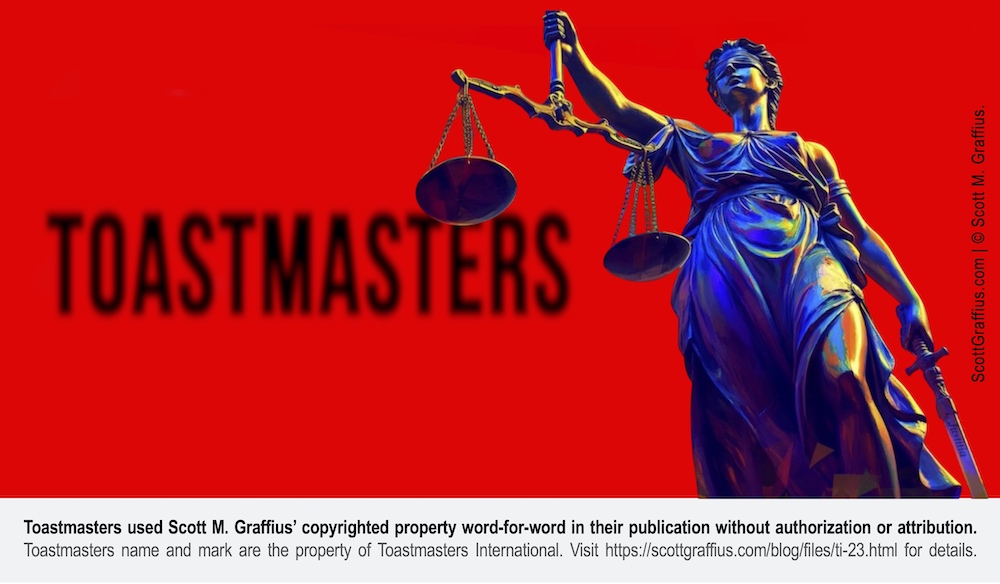

Introduction
Toastmasters used—without authorization or attribution—Scott M. Graffius’ copyrighted property in their publication. Based on the indisputable facts, Toastmasters’ bad acts involve the ethical issue of plagiarism and the legal issue of copyright infringement.
Graffius maintains, enforces, and protects his copyright and other intellectual property rights. This article serves as a clarion call for Toastmasters to face the repercussions of, and take responsibility for, their blatant and damaging violation.

Background
Informed by the research of Bruce W. Tuckman, Ph.D., and Mary Ann C. Jensen, over 100 subsequent studies, and Scott M. Graffius’ first-hand professional experience with, and analysis of, team leadership and performance, Graffius created his ‘Phases of Team Development.’ It’s a unique perspective on the five phases of team development—Forming, Storming, Norming, Performing, and Adjourning—and it’s inclusive of the characteristics/features/traits and strategies for each phase.
Graffius’ ‘Phases of Team Development’ intellectual property is registered with the United States Copyright Office.
Graffius initially developed his intellectual property in 2008, and he periodically refreshes it. For reference, an authorized example of his copyrighted property applicable in this case (2021 edition) is here: https://dx.doi.org/10.13140/RG.2.2.22040.42246 . It is shown below as well (as Exhibit 1).

As shown above, Graffius’ copyright ownership details are integrated into and appear on his copyrighted property. Specifically, it reads: “Copyright © 2008-2021 Scott M. Graffius. All rights reserved. For permission requests, contact scott@scottgraffius.com.”
Conference organizers, businesses, professional associations, government agencies, and universities around the world engage Graffius to deliver compelling talks and workshops. Examples are here.
Graffius’ ‘Phases of Team Development’ intellectual property is central and key to many of those sessions. Details including his rate card, a listing of his engagements, and more are here.
With an authorization/license from Graffius, many organizations around the world have featured and used his copyrighted ‘Phases of Team Development’ work. Select examples include Yale University, Adobe, IEEE, Microsoft, UK Sports Institute, Amsterdam Public Health Research Institute, American Management Association, and many others.
Copyrights protect the intellectual property rights of creators, ensuring they receive recognition and compensation for their work, thus incentivizing creativity and innovation. Graffius is vigilant in upholding, protecting, and enforcing his copyrights and other IP rights.
Toastmasters Used Scott M. Graffius' Copyrighted Property Word-for-Word in Their Publication Without Authorization or Attribution, Violating Graffius’ Intellectual Property Rights
Toastmasters infringing 2022 publication is marked with:
- “Toastmasters International”
- “Area Director Handbook”
- “2022”
- “Guide to a successful year as Area Director”
- “District 101”
Exhibit 2 is below. It shows pages 2, 19, 20, and 21 from the infringing 2022 publication.

Further details follow.
Again, Graffius’ copyright ownership details and permission request information are integrated into and appear on his intellectual property.
Toastmasters did not request nor receive permission to use Graffius’ copyrighted property.
Nevertheless, Toastmasters used Graffius’ 4 January 2021 copyrighted property in their 2022 publication.
Comparing Graffius' copyrighted 4 January 2021 'Phases of Team Development' intellectual property what Toastmasters has in its 2022 publication is reveals Toastmasters’ blatant infringement.
Exhibit 3 is below. It shows Toastmasters extensive—including word-for-word—use of Graffius’ copyrighted property on the characteristics and strategies for the Forming stage of team development.

Exhibit 4 is below. It shows Toastmasters extensive—including word-for-word—use of Graffius’ copyrighted property on the characteristics and strategies for the Storming stage of team development.

Exhibit 5 is below. It shows Toastmasters extensive—including word-for-word—use of Graffius’ copyrighted property on the characteristics and strategies for the Norming stage of team development.

Exhibit 6 is below. It shows Toastmasters extensive—including word-for-word—use of Graffius’ copyrighted property on the characteristics and strategies for the Performing stage of team development.

Exhibit 7 is below. It shows Toastmasters extensive—including word-for-word—use of Graffius’ copyrighted property on the characteristics and strategies for the Adjourning stage of team development.

Further, Toastmasters did not attribute their use of Graffius’ copyrighted property to Graffius. Accordingly, Toastmasters is wrongly leading others to falsely believe that they (or others) are the author and owner of Graffius’ respective copyrighted property.

Conclusion
Again, Graffius’ copyright ownership details and permission request information are integrated into and appear on his intellectual property.
Toastmasters did not request nor receive permission to use Graffius’ copyrighted property.
Nevertheless, Toastmasters used Graffius’ 4 January 2021 copyrighted property in their 2022 infringing publication.
Toastmasters used a significant volume of Graffius’ copyrighted property.
Toastmasters’ infringement included extensive word-for-word use of Graffius’ copyrighted property.
Toastmasters did not attribute their use of Graffius’ copyrighted property to Graffius. Accordingly, Toastmasters is wrongly leading others to falsely believe that they (or others) are the author and owner of Graffius’ respective copyrighted content.
Toastmasters damaged the marketability and value of Graffius’ copyrighted property.
For the aforementioned reasons, Toastmasters’ use of Graffius’ copyrighted property was not ‘fair use’ nor otherwise allowed.
Additionally, the Digital Millennium Copyright Act (DMCA), 17 U.S. Code § 1202, addresses the integrity of copyright management information. It specifies that that removal of copyright information from another’s intellectual property is a crime. That’s for all cases, including educational/non-commercial use. As shown by comparing Graffius' copyrighted property (Exhibit 1) and with page 19 of Toastmasters infringing publication (shown in Exhibit 2), Toastmasters cropped-out or otherwise removed Graffius’ copyright information. That alone makes Toastmasters' actions not ‘fair use’ and a crime.
Toastmasters’ actions in this matter are a disgraceful breach of professional ethics, moral standards, and Graffius’ intellectual property rights.
So long as the infringing publication exists in any form, Toastmasters knowingly and willfully continues to spread misinformation and violate Graffius’ intellectual property rights.
Toastmasters must immediately implement the following three (3) actions:
- Remove the Infringing Material. Electronic Versions: Immediately remove the infringing material from all digital platforms where it is advertised, promoted, sold, or distributed; this includes removing or disabling any online access to it. Physical Copies: If physical copies of the material are in inventory or circulation, stop further distribution; recall any copies already distributed; destroy (recycle) physical copies.
- Issue a Retraction. Publish a formal retraction notice acknowledging the infringement and the steps taken to rectify the situation. The notice will present the facts as they are—the notice will not "spin" or "downplay" the infringement.
- Notify Relevant Parties. Subscribers and Purchasers and other Recipients: Inform the respective subscribers, purchasers, or recipients of the material about the retraction, ensuring transparency about the issue; again, the notice will present the facts as they are—the notice will not "spin" or "downplay" the infringement. Indexes and Databases: Notify any databases or indexing services that list the material so they can update their records accordingly.
Graffius maintains, enforces, and protects his copyright and other intellectual property rights. He reserves his rights in this damaging, disturbing, and consequential matter.
This article serves as a clarion call for Toastmasters to face the repercussions of, and take responsibility for, their blatant and damaging violation.
This case is open.

About Scott M. Graffius

Scott M. Graffius is a global leader in agile project management, an expert on teamwork tradecraft, an authority on temporal dynamics on social media platforms, a creator, a consultant, a trainer, an award-winning author, and an international public speaker.
See his bio to learn more.









About Agile Scrum: Your Quick Start Guide with Step-by-Step Instructions

Shifting customer needs are common in today's marketplace. Businesses must be adaptive and responsive to change while delivering an exceptional customer experience to be competitive.
There are a variety of frameworks supporting the development of products and services, and most approaches fall into one of two broad categories: traditional or agile. Traditional practices such as waterfall engage sequential development, while agile involves iterative and incremental deliverables. Organizations are increasingly embracing agile to manage projects, and best meet their business needs of rapid response to change, fast delivery speed, and more.
With clear and easy to follow step-by-step instructions, Scott M. Graffius's award-winning Agile Scrum: Your Quick Start Guide with Step-by-Step Instructions helps the reader:
- Implement and use the most popular agile framework―Scrum;
- Deliver products in short cycles with rapid adaptation to change, fast time-to-market, and continuous improvement; and
- Support innovation and drive competitive advantage.
Hailed by Literary Titan as “the book highlights the versatility of Scrum beautifully.”
Winner of 17 first place awards.
Agile Scrum: Your Quick Start Guide with Step-by-Step Instructions is available in paperback and ebook/Kindle in the United States and around the world. Some links by country follow.
- 🇧🇷 Brazil
- 🇨🇦 Canada
- 🇨🇿 Czech Republic
- 🇩🇰 Denmark
- 🇫🇮 Finland
- 🇫🇷 France
- 🇩🇪 Germany
- 🇬🇷 Greece
- 🇭🇺 Hungary
- 🇮🇳 India
- 🇮🇪 Ireland
- 🇮🇱 Israel
- 🇮🇹 Italy
- 🇯🇵 Japan
- 🇱🇺 Luxembourg
- 🇲🇽 Mexico
- 🇳🇱 Netherlands
- 🇳🇿 New Zealand
- 🇳🇴 Norway
- 🇪🇸 Spain
- 🇸🇪 Sweden
- 🇨🇭 Switzerland
- 🇦🇪 UAE
- 🇬🇧 United Kingdom
- 🇺🇸 United States

About Agile Transformation: A Brief Story of How an Entertainment Company Developed New Capabilities and Unlocked Business Agility to Thrive in an Era of Rapid Change

Thriving in today's marketplace frequently depends on making a transformation to become more agile. Those successful in the transition enjoy faster delivery speed and ROI, higher satisfaction, continuous improvement, and additional benefits.
Based on actual events, Agile Transformation: A Brief Story of How an Entertainment Company Developed New Capabilities and Unlocked Business Agility to Thrive in an Era of Rapid Change provides a quick (60-90 minute) read about a successful agile transformation at a multinational entertainment and media company, told from the author's perspective as an agile coach.
The award-winning book by Scott M. Graffius is available in paperback and ebook/Kindle in the United States and around the world. Some links by country follow.
- 🇦🇺 Australia
- 🇦🇹 Austria
- 🇧🇷 Brazil
- 🇨🇦 Canada
- 🇨🇿 Czech Republic
- 🇩🇰 Denmark
- 🇫🇮 Finland
- 🇫🇷 France
- 🇩🇪 Germany
- 🇬🇷 Greece
- 🇮🇳 India
- 🇮🇪 Ireland
- 🇯🇵 Japan
- 🇱🇺 Luxembourg
- 🇲🇽 Mexico
- 🇳🇱 Netherlands
- 🇳🇿 New Zealand
- 🇪🇸 Spain
- 🇸🇪 Sweden
- 🇨🇭 Switzerland
- 🇦🇪 United Arab Emirates
- 🇬🇧 United Kingdom
- 🇺🇸 United States


How to Cite This Article
Graffius, Scott M. (2023, October 23). Toastmasters Used Scott M. Graffius' Copyrighted Property Word-for-Word in Their Publication Without Authorization or Attribution. Available at: https://scottgraffius.com/blog/files/ti-23.html. DOI: 10.13140/RG.2.2.18914.34240.


Post-Publication Notes
If there are any supplements or updates to this article after the date of publication, they will appear here.


Content Acknowledgements
This article uses limited excerpts from Toastmasters International content, attributed to Toastmasters International and used under fair use for news reporting and analysis.
Toastmasters International name, mark, and content (except for what was stolen from others) are the property of Toastmasters International.
Graffius’ ‘Phases of Team Development’ is copyright © Scott M. Graffius. All rights reserved.


Copyright
Copyright © Scott M. Graffius. All rights reserved.
Content on this site—including text, images, videos, and data—may not be used for training or input into any artificial intelligence, machine learning, or automatized learning systems, or published, broadcast, rewritten, or redistributed without the express written permission of Scott M. Graffius.

2014 NSDM Publication on Leadership by National Security Affairs Professor Mary Raum Featured the 2008 Edition of Scott M. Graffius’ Work on Team Development


Informed by the research of Bruce W. Tuckman and Mary Ann C. Jensen, over 100 subsequent studies, and Scott M. Graffius' first-hand professional experience with, and analysis of, team leadership and performance, Graffius created his ‘Phases of Team Development’ as a unique perspective and visual conveying the five phases of team development — Forming, Storming, Norming, Performing, and Adjourning — inclusive of a graph showing how performance varies by phase, as well as the characteristics and strategies for each phase.
Graffius' intellectual property (IP) is registered with the United States Copyright Office.
Graffius initially developed his ‘Phases of Team Development’ unique material in 2008, and he periodically refreshes it.
In 2012, the Internet Archive recorded an article with Graffius’ IP at http://scottgraffius.com/Articles/files/5747fde6fd9c565c5a0c5f8ea450a000-16.html (note: it subsequently migrated). A related visual is below.

Specifically, the Internet Archive recorded it on 13 October 2012.
For reference, the Internet Archive does not record every webpage or all elements on webpages. Of the websites that are recorded, it can be years before they are chronicled.
The 2014 NSDM publication, 'Leader Theory Explanations and Original Texts,' by National Security Affairs Professor Mary Raum, featured the 2008 Edition of Scott M. Graffius’ work on team development. Raum cited http://scottgraffius.com/Articles/files/5747fde6fd9c565c5a0c5f8ea450a000-16.html; that’s the same URL recorded by the Internet Archive in 2012.
Dr. Raum lists the publication on her resume. Visual set exhibit 1 is below. It shows page 13 from the addendum section of her resume.

Visual set exhibit 2 is below. It shows that Dr. Raum shared her respective 2014 NSDM publication on Academia.edu. Specifically, it's here.

Visual set exhibit 3 is below. It shows:
- Page 1 from Dr. Raum’s 2014 NSDM publication,
- Page 29,
- a zoomed-in view of source information from page 29,
- a larger view of Graffius’ work featured on page 29,
- and Page 37.

Graffius' intellectual property on teamwork tradecraft was initially titled 'Stages of Group Development' but it was renamed to 'Phases of Team Development.'
As a recap:
- In 2008, Graffius developed his respective intellectual property.
- In 2012, the Internet Archive recorded an article by Graffius which then featured his intellectual property at http://scottgraffius.com/Articles/files/5747fde6fd9c565c5a0c5f8ea450a000-16.html.
- Mary Raum's 2014 publication featured the 2008 edition of Graffius' IP — and she cited the source as http://scottgraffius.com/Articles/files/5747fde6fd9c565c5a0c5f8ea450a000-16.html (the same link recorded by the Internet Archive in 2012).
Read on to learn:
- About About Mary Raum,
- About Scott M. Graffius,
- How to Cite This Article,
- and more.

About Mary Raum, Ph.D.
Dr. Raum has extensive experience at the executive level across private, public, and academic communities. She is a tenured professor of national security affairs at the United States Naval War College. Dr. Raum has a dual Ph.D. in Engineering and Public Affairs. She was the legacy Swanee Hunt Academic Chair for Women Peace and Security and served in that role for a decade.

About Scott M. Graffius

Scott M. Graffius is a global leader in agile project management and an expert on teamwork tradecraft. See his bio to learn more.


How to Cite This Article
Graffius, Scott M. (2016, January 21). 2014 NSDM Publication on Leadership by National Security Affairs Professor Mary Raum Featured the 2008 Edition of Scott M. Graffius’ Work on Team Development. Available at: https://scottgraffius.com/blog/files/nsdm-leadership.html. DOI: 10.13140/RG.2.2.22276.33920.


Post-Publication Notes
If there are any supplements or updates to this article after the date of publication, they will appear here.


Content Acknowledgements
This article used limited excerpts of content from Mary Raum, attributed to Mary Raum and used under fair use for news reporting and analysis.


Copyright
Copyright © Scott M. Graffius. All rights reserved.
Content on this site—including text, images, videos, and data—may not be used for training or input into any artificial intelligence, machine learning, or automatized learning systems, or published, broadcast, rewritten, or redistributed without the express written permission of Scott M. Graffius.

Scott M. Graffius’ Intellectual Property was Employed by the NHS — the Largest Single-Payer Healthcare System in Europe


If there's an update after this article is published, the information will appear in the Post-Publication Notes section.

Introduction
With authorization/license from Scott M. Graffius, over 200 organizations around the world have featured and used his intellectual property. However, some others engage in bad acts such as the ethical issue of plagiarism or the legal issue of copyright infringement, violating Graffius' intellectual property rights.
Graffius maintains, enforces, and protects his copyright and other intellectual property rights. Among other measures, he identifies the violators to protect the integrity and value of his intellectual property contributions and to deter future violations. This is one such story.
How will the offending organization respond to being served a detailed notice of their blatant violation? Read on—including the Post-Publication Notes section—to find out.

Background
Informed by the research of Bruce W. Tuckman and Mary Ann C. Jensen, over 100 subsequent studies, and Scott M. Graffius' first-hand professional experience with, and analysis of, team leadership and performance, Graffius created his ‘Phases of Team Development’ as a unique perspective and visual conveying the five phases of team development—Forming, Storming, Norming, Performing, and Adjourning—inclusive of a graph showing how performance varies by phase, as well as the characteristics and strategies for each phase.
Graffius' intellectual property is registered with the United States Copyright Office.
He initially developed his ‘Phases of Team Development’ unique material in 2008, and he periodically refreshes it.
Exhibit 1, Graffius’ 2021 copyrighted property—the edition applicable to this case, is shown below and attached. It is also available here and here and other locations. The integrated text applies.

As shown above, Graffius’ copyright ownership details are integrated into and appear on his copyrighted property. Specifically, it reads: “Copyright © 2008-2021 Scott M. Graffius. All rights reserved. For permission requests, contact scott@scottgraffius.com.”
[If you're looking for the now-current (2024) edition of Graffius' 'Phases of Team Development' then select here.]
Organizations around the world engage Graffius to deliver compelling talks and workshops. To date, he's presented sessions at 91 conferences and other events across 25 countries, including:
- Armenia,
- Australia,
- Brazil,
- Canada,
- Czech Republic,
- Finland,
- France,
- Germany,
- Greece,
- Hong Kong,
- Hungary,
- India,
- Ireland,
- Lithuania,
- Luxembourg,
- Nepal,
- Netherlands,
- New Zealand,
- Norway,
- Romania,
- Sweden,
- Switzerland,
- United Arab Emirates,
- United Kingdom,
- and the United States.
Graffius’ ‘Phases of Team Development’ intellectual property is central and key to many of those sessions. His rate card and a listing of his engagements are at here and here, respectively.
With authorization/license from Graffius, his ‘Phases of Team Development’ property is featured and used by businesses, professional associations, government agencies, and universities worldwide. Examples include:
- Adobe,
- American Management Association,
- Amsterdam Public Health Research Institute,
- Bayer,
- Boston University,
- Broadcom,
- Cisco,
- Deimos Aerospace,
- DevOps Institute,
- Ford Motor Company,
- Hasso Plattner Institute,
- IEEE,
- Johns Hopkins University,
- LeadingEng,
- Manufacturers Alliance,
- Microsoft,
- New Zealand Government,
- Oracle,
- Royal Australasian College of Physicians,
- Singapore Institute of Technology,
- TBS Switzerland,
- Torrens University Australia,
- US National Park Service,
- US Tennis Association,
- UC San Diego,
- University of Galway Ireland,
- Virginia Tech,
- Warsaw University,
- Yale University,
- and many others.
Copyrights protect the intellectual property rights of creators, ensuring they receive recognition and compensation for their work, thus incentivizing creativity and innovation. Graffius is vigilant in upholding, protecting, and enforcing his copyrights and other IP rights.
The National Health Service (NHS) — the Largest Single-Payer Healthcare System in Europe — Violated Graffius’ Intellectual Property Rights
Here's information on the NHS’s infringing publication:
- NHS event: ‘NHS Trusts and Primary Care Collaboration Knowledge Sharing Event.’
- Date of NHS event: 16 October 2024.
- Title of infringing NHS publication: ‘System Convening.’
- Known locations(s) of the HNS’s infringing 2024 publication: The delivery of the infringing NHS publication was recorded and published as a public video at https://www.youtube.com/watch?v=MesI1l7SAzY .
Exhibit 2 is shown below and attached. It provides excerpts from the NHS’s ‘System Convening’ infringing publication, which was delivered at the ‘NHS Trusts and Primary Care Collaboration Knowledge Sharing Event’ on 16 October 2024 (recorded and published as a video). The exhibit shows:
- Slide titled “NHS Trusts and Primary Care Collaboration Knowledge Sharing Event”
- Slide titled “System Convening”
- Slide titled “Agenda”
- Slide titled “Continuing to Develop as a Partnership”
- Zoomed-in view of slide titled “Agenda”
- Zoomed-in view of slide titled “Continuing to Develop as a Partnership”

Indisputable proof of the violation is delineated next.
Again, Graffius’ copyright ownership details and permission request information are integrated into and appear on his 2021 intellectual property.
The NHS (inclusive of its entities and people) did not request nor receive permission to use Graffius’ 2021 copyrighted property.
Nevertheless, the NHS used Graffius’ 2021 copyrighted property in its 2024 infringing publication.
NHS’s infringing 2024 publication used a significant volume of Graffius’ 2021 copyrighted property.
NHS’s infringing 2024 publication failed to acknowledge Graffius' ownership of his respective content, thereby misleading others including the public into believing that it, the NHS, is the author and rightful owner of Graffius' intellectual property.
A review of the NHS’s 2024 publication uncovered a slew of infringing content.
Exhibit 3 is below and attached. It provides a side-by-side view of content from Graffius’ 2021 ‘Phases of Team Development’ copyrighted property and the NHS’s 2024 infringing publication.

As shown, the NHS blatantly infringed on Graffius’ copyright.
The NHS’s infringing 2024 publication used Graffius’ 2021 copyrighted content word-for-word.
In what is reasonably considered to be the NHS’s demonstration of its knowing and willful infringement, the NHS author(s) of the infringing 2024 publication seemed to attempt to conceal their theft by slightly altering some words. The NHS author(s) localized some content (such as changing "socializing" to "socialising") and made a few other slight alterations (such as changing "&" to "and"). All of that is still infringement.
In addition to Exhibit 3, here’s a comparison of content from Graffius’ 2021 copyrighted property and what the NHS has in its infringing 2024 publication.
Forming Phase: Characteristics and Strategies:
🟢 Graffius’ 2021 copyrighted property includes: “Displaying eagerness”
🔴 The NHS infringing 2024 publication includes: “Displaying eagerness”
🟢 Graffius’ 2021 copyrighted property includes: “Socializing”
🔴 The NHS infringing 2024 publication includes: “Socialising”
🟢 Graffius’ 2021 copyrighted property includes: “Generally polite tone”
🔴 The NHS infringing 2024 publication includes: “Generally polite tones”
🟢 Graffius’ 2021 copyrighted property includes: “Sticking to safe topics”
🔴 The NHS infringing 2024 publication includes: “Sticking to safe topics”
🟢 Graffius’ 2021 copyrighted property includes: “Unclear about how one fits in”
🔴 The NHS infringing 2024 publication includes: “Unclear about how one fits in”
🟢 Graffius’ 2021 copyrighted property includes: “Some anxiety & questioning”
🔴 The NHS infringing 2024 publication includes: “Some anxiety and questioning”
Storming Phase: Characteristics and Strategies:
🟢 Graffius’ 2021 copyrighted property includes: “Some resistance”
🔴 The NHS infringing 2024 publication includes: “Some resistance”
🟢 Graffius’ 2021 copyrighted property includes: “Lack of participation”
🔴 The NHS infringing 2024 publication includes: “Lack of participation”
🟢 Graffius’ 2021 copyrighted property includes: “Conflict based on differences of feelings & opinions”
🔴 The NHS infringing 2024 publication includes: “Conflict based on differences of feelings and opinions”
🟢 Graffius’ 2021 copyrighted property includes: “Competition”
🔴 The NHS infringing 2024 publication includes: “Competition”
🟢 Graffius’ 2021 copyrighted property includes: “High emotions”
🔴 The NHS infringing 2024 publication includes: “High emotions”
🟢 Graffius’ 2021 copyrighted property includes: “Starting to move towards group norms”
🔴 The NHS infringing 2024 publication includes: “Starting to move towards group norms”
Norming Phase: Characteristics and Strategies:
🟢 Graffius’ 2021 copyrighted property includes: “Purpose & goals are well-understood”
🔴 The NHS infringing 2024 publication includes: “Collectively understood purpose & goals”
🟢 Graffius’ 2021 copyrighted property includes: “More confident”
🔴 The NHS infringing 2024 publication includes: “Increased confidence”
🟢 Graffius’ 2021 copyrighted property includes: “Improved commitment”
🔴 The NHS infringing 2024 publication includes: “Improved commitment”
🟢 Graffius’ 2021 copyrighted property includes: “Members are engaged and supportive”
🔴 The NHS infringing 2024 publication includes: “Members are engaged”
🟢 Graffius’ 2021 copyrighted property includes: “Relief, lowered anxiety”
🔴 The NHS infringing 2024 publication includes: “Relief and lowered anxiety”
🟢 Graffius’ 2021 copyrighted property includes: “Developing cohesion”
🔴 The NHS infringing 2024 publication includes: “Greater cohesion”
Performing Phase: Characteristics and Strategies:
🟢 Graffius’ 2021 copyrighted property includes: “High motivation, trust & empathy”
🔴 The NHS infringing 2024 publication includes: “High motivation and empathy”
🟢 Graffius’ 2021 copyrighted property includes: “Individuals defer to team needs”
🔴 The NHS infringing 2024 publication includes: “Individuals defer to partnership needs”
🟢 Graffius’ 2021 copyrighted property includes: “Effectively producing deliverables”
🔴 The NHS infringing 2024 publication includes: “Effectively producing deliverables”
🟢 Graffius’ 2021 copyrighted property includes: “Consistent performance”
🔴 The NHS infringing 2024 publication includes: “Consistent performance”
🟢 Graffius’ 2021 copyrighted property includes: “Demonstrations of interdependence & self-management”
🔴 The NHS infringing 2024 publication includes: “Demonstration of interdependence and self management”
Conclusion
Graffius’ copyright ownership details and permission request information are integrated into and appear on his intellectual property.
The NHS did not request nor receive permission to use Graffius’ 2021 copyrighted property.
Nevertheless, the NHS’s infringing 2024 publication used Graffius’ copyrighted 2021 property.
The NHS’s infringing 2024 publication used Graffius’ 2021 copyright content word-for-word.
In what is reasonably considered to be the NHS’s demonstration of it knowing and willful infringement, the NHS author(s) of the infringing 2024 publication seemed to attempt to conceal their theft by slightly altering some words. The NHS author(s) localized some content (such as changing "socializing" to "socialising") and made a few other slight alterations (such as changing "&" to "and"). All of that is still infringement.
The NHS’s 2024 infringing publication used a significant volume of Graffius’ 2021 copyrighted property.
NHS’s infringing 2024 publication failed to acknowledge Graffius' ownership of his respective content, thereby misleading others including the public into believing that it, the NHS, is the author and rightful owner of Graffius' intellectual property.
The NHS’s infringement has damaged the marketability and value of Graffius’ intellectual property.
The NHS’s use of Graffius’ 2021 copyrighted property was not ‘fair dealing’ nor ‘fair use’ nor otherwise allowed.
Copyright infringement is disgraceful, unprofessional, unethical, immoral, and illegal.
So long as the NHS’s infringing material exists anywhere, in any form, the NHS continues to spread misinformation and violate Graffius’ intellectual property rights. Accordingly, time is of the essence.
The NHS must immediately implement the following two (2) actions:
- Remove the Infringing Material. Electronic Versions: Immediately remove the infringing material (any and all publications/products with infringement) from digital platforms where it is advertised, promoted, sold, or distributed; this includes removing or disabling any online access to it. Physical Copies: If physical copies of the infringing material are in inventory or circulation, stop further distribution; recall any copies already distributed; destroy copies.
- Issue an Apology. Send an apology to Graffius via email at scott@scottgraffius.com. The apology will acknowledge the infringement and the steps taken (such as Action 1, above) to mitigate the situation. The apology will present the facts as they are—it will not "spin" or "downplay" the infringement.
Again, time is of the essence. Both actions must be fulfilled by 6:00 PM Pacific Time on Friday, 15 November 2024. By doing so, the NHS will demonstrate transparency, professionalism, integrity, accountability, and respect. However, if the NHS fails to do so, it will conversely convey a lack of transparency, a lack of professionalism, a lack of integrity, a lack of accountability, and a lack of respect.
Copyrights protect the intellectual property rights of creators, ensuring they receive recognition and compensation for their work, thus incentivizing creativity and innovation. Mr. Graffius maintains, enforces, and protects his copyright and other intellectual property rights.
Graffius resides in the United States and the NHS is headquartered in London, United Kingdom. However, the United Kingdom and the United States have treaties regarding copyright: Berne (Paris) Dec. 5, 1887; Bilateral July 1, 18918; UCC Geneva Sept. 27, 1957; Phonograms Apr. 18, 1973; UCC Paris July 10, 1974; WTO Jan. 1, 1995; WCT Mar. 14, 2010; WPPT Mar. 14, 2010; VIP Jan. 1, 2021. Additionally, the United Kingdom has strong copyright laws. Copyright laws apply to this case.
Graffius expressly reserves his rights in this disturbing, damaging, and consequential matter.
Graffius communicated the preceding information to the NHS via email on 9 November 2024.
If there is an update to this article, it will appear in the Post-Publication Notes section.
Read on to learn:
• About the NHS,
• About Scott M. Graffius,
• How to Cite This Article,
• Post-Publication Notes,
• and more.


About the NHS
The National Health Service (NHS) is the publicly funded healthcare system in England, known for its commitment to providing universal healthcare free at the point of use. Financed largely through general taxation and National Insurance, the NHS is overseen by the Department of Health and Social Care, ensuring accessible healthcare for all legal residents of England, as well as residents from other parts of the UK.

About Scott M. Graffius

Scott M. Graffius is a global leader in agile project management, an expert on teamwork tradecraft, an authority on temporal dynamics on social media platforms, a creator, a consultant, a trainer, an award-winning author, and an international public speaker.
See his bio to learn more.









About Agile Scrum: Your Quick Start Guide with Step-by-Step Instructions

Shifting customer needs are common in today's marketplace. Businesses must be adaptive and responsive to change while delivering an exceptional customer experience to be competitive.
There are a variety of frameworks supporting the development of products and services, and most approaches fall into one of two broad categories: traditional or agile. Traditional practices such as waterfall engage sequential development, while agile involves iterative and incremental deliverables. Organizations are increasingly embracing agile to manage projects, and best meet their business needs of rapid response to change, fast delivery speed, and more.
With clear and easy to follow step-by-step instructions, Scott M. Graffius's award-winning Agile Scrum: Your Quick Start Guide with Step-by-Step Instructions helps the reader:
- Implement and use the most popular agile framework―Scrum;
- Deliver products in short cycles with rapid adaptation to change, fast time-to-market, and continuous improvement; and
- Support innovation and drive competitive advantage.
Hailed by Literary Titan as “the book highlights the versatility of Scrum beautifully.”
Winner of 17 first place awards.
Agile Scrum: Your Quick Start Guide with Step-by-Step Instructions is available in paperback and ebook/Kindle in the United States and around the world. Some links by country follow.
- 🇧🇷 Brazil
- 🇨🇦 Canada
- 🇨🇿 Czech Republic
- 🇩🇰 Denmark
- 🇫🇮 Finland
- 🇫🇷 France
- 🇩🇪 Germany
- 🇬🇷 Greece
- 🇭🇺 Hungary
- 🇮🇳 India
- 🇮🇪 Ireland
- 🇮🇱 Israel
- 🇮🇹 Italy
- 🇯🇵 Japan
- 🇱🇺 Luxembourg
- 🇲🇽 Mexico
- 🇳🇱 Netherlands
- 🇳🇿 New Zealand
- 🇳🇴 Norway
- 🇪🇸 Spain
- 🇸🇪 Sweden
- 🇨🇭 Switzerland
- 🇦🇪 UAE
- 🇬🇧 United Kingdom
- 🇺🇸 United States

About Agile Transformation: A Brief Story of How an Entertainment Company Developed New Capabilities and Unlocked Business Agility to Thrive in an Era of Rapid Change

Thriving in today's marketplace frequently depends on making a transformation to become more agile. Those successful in the transition enjoy faster delivery speed and ROI, higher satisfaction, continuous improvement, and additional benefits.
Based on actual events, Agile Transformation: A Brief Story of How an Entertainment Company Developed New Capabilities and Unlocked Business Agility to Thrive in an Era of Rapid Change provides a quick (60-90 minute) read about a successful agile transformation at a multinational entertainment and media company, told from the author's perspective as an agile coach.
The award-winning book by Scott M. Graffius is available in paperback and ebook/Kindle in the United States and around the world. Some links by country follow.
- 🇦🇺 Australia
- 🇦🇹 Austria
- 🇧🇷 Brazil
- 🇨🇦 Canada
- 🇨🇿 Czech Republic
- 🇩🇰 Denmark
- 🇫🇮 Finland
- 🇫🇷 France
- 🇩🇪 Germany
- 🇬🇷 Greece
- 🇮🇳 India
- 🇮🇪 Ireland
- 🇯🇵 Japan
- 🇱🇺 Luxembourg
- 🇲🇽 Mexico
- 🇳🇱 Netherlands
- 🇳🇿 New Zealand
- 🇪🇸 Spain
- 🇸🇪 Sweden
- 🇨🇭 Switzerland
- 🇦🇪 United Arab Emirates
- 🇬🇧 United Kingdom
- 🇺🇸 United States


How to Cite This Article
Graffius, Scott M. (2024, November 9). Scott M. Graffius’ Intellectual Property was Employed by the NHS — the Largest Single-Payer Healthcare System in Europe. Available at: https://scottgraffius.com/blog/files/nhs-2024.html. DOI: 10.13140/RG.2.2.24658.57289.


Digital Object Identifier (DOI)
DOI: 10.13140/RG.2.2.24658.57289.
DOI link: https://dx.doi.org/10.13140/RG.2.2.24658.57289.


Post-Publication Notes
If there are any supplements or updates to this article after the date of publication, they will appear here.
Update on 13 November 2024
As noted in the article, Graffius emailed details on the violation to the NHS including multiple departments and individuals. That email was sent on 9 November 2024.
Additionally, Graffius forwarded the 9 November 2024 email to Stephen Powis, National Medical Director of NHS England, on 13 November 2024.
Any further updates will appear here.
Update on 14 November 2024
Additionally, Graffius forwarded the 9 November 2024 email to Amanda Pritchard, NHS Chief Executive Officer, and Chris Whitty, NHS Chief Medical Officer, on 14 November 2024.
Any further updates will appear here.
Update on 15 November 2024
As detailed in the article, the NHS published their infringing video publication at https://www.youtube.com/watch?v=MesI1l7SAzY. The NHS removed their video on 15 November 2024. A screen shot is shown below.

Again, the article delineated undeniable proof that the NHS blatantly violated Graffius' intellectual property rights. While the NHS ultimately removed their infringing publication, it is shocking that the NHS failed to apologize to Graffius for their violation. Accordingly, the NHS strongly conveys a lack of transparency, a lack of professionalism, a lack of integrity, a lack of accountability, and a lack of respect. And this case remains open.
Graffius expressly reserves his rights in this disturbing, damaging, and consequential matter.
Any further updates will appear here.
Update on 20 November 2024
The NHS misrepresented Graffius’ copyrighted property as its own, spreading misinformation and violating intellectual property rights. As noted, the undeniable proof was provided to the NHS. That included multiple NHS departments and people such as
Amanda Pritchard, Chief Executive of NHS England.
To date, the NHS has not even apologized, demonstrating a lack of integrity, accountability, and respect. Accordingly, Graffius forwarded the undeniable proof of NHS’s violation to Pritchard’s superior on 20 November 2024. That’s Wes Streeting, the UK’s Secretary of State for Health and Social Care.
Any further updates will appear here.



Content Acknowledgements
This article uses limited excerpts of content from the NHS, attributed to the NHS and used under fair use for news reporting and analysis. NHS's content (excerpt for what was stolen from others) is the property of the NHS.
Graffius’ ‘Phases of Team Development’ is copyright © Scott M. Graffius. All rights reserved. Visit ScottGraffius.com.


Short Link for Article
The short link for this article is https://bit.ly/nhs-2024


Copyright
Copyright © Scott M. Graffius. All rights reserved.
Content on this site—including text, images, videos, and data—may not be used for training or input into any artificial intelligence, machine learning, or automatized learning systems, or published, broadcast, rewritten, or redistributed without the express written permission of Scott M. Graffius.


Strategies for Medical Team Success Featured Scott M. Graffius’ ‘Phases of Team Development’ Intellectual Property


With authorization/license from Scott M. Graffius, his ‘Phases of Team Development’ property is featured and used by businesses, professional associations, government agencies, and universities worldwide. Among the organizations, scientific and medical-related ones include the Amsterdam Public Health Research Institute, Bayer, Johns Hopkins University, Life Sciences Trainers & Educators Network (LTEN), Royal Australasian College of Physicians, TBS Switzerland, and others. Naso Sano—a medical education and research organization based in Italy—was added to the list.
On 6 November 2024, Naso Sano published a presentation on strategies for medical success which featured Graffius’ work. Puya Dehgani-Mobaraki, MD (Naso Sano, Italy) hosted the session and Professor Saad Alsaleh (King Said University, Saudi Arabia) delivered the talk. The presentation was recorded, and the video is available on YouTube here.
A screen shot is below.

The current (2024) edition of Graffius' 'Phases of Team Development' is here.
Read on to learn:
- About Scott M. Graffius,
- How to Cite This Article,
- and more.

About Scott M. Graffius

Scott M. Graffius is a global leader in agile project management, an expert on teamwork tradecraft, an authority on temporal dynamics on social media platforms, a creator, a consultant, a trainer, an award-winning author, and an international public speaker.
See his bio to learn more.









About Agile Scrum: Your Quick Start Guide with Step-by-Step Instructions

Shifting customer needs are common in today's marketplace. Businesses must be adaptive and responsive to change while delivering an exceptional customer experience to be competitive.
There are a variety of frameworks supporting the development of products and services, and most approaches fall into one of two broad categories: traditional or agile. Traditional practices such as waterfall engage sequential development, while agile involves iterative and incremental deliverables. Organizations are increasingly embracing agile to manage projects, and best meet their business needs of rapid response to change, fast delivery speed, and more.
With clear and easy to follow step-by-step instructions, Scott M. Graffius's award-winning Agile Scrum: Your Quick Start Guide with Step-by-Step Instructions helps the reader:
- Implement and use the most popular agile framework―Scrum;
- Deliver products in short cycles with rapid adaptation to change, fast time-to-market, and continuous improvement; and
- Support innovation and drive competitive advantage.
Hailed by Literary Titan as “the book highlights the versatility of Scrum beautifully.”
Winner of 17 first place awards.
Agile Scrum: Your Quick Start Guide with Step-by-Step Instructions is available in paperback and ebook/Kindle in the United States and around the world. Some links by country follow.
- 🇧🇷 Brazil
- 🇨🇦 Canada
- 🇨🇿 Czech Republic
- 🇩🇰 Denmark
- 🇫🇮 Finland
- 🇫🇷 France
- 🇩🇪 Germany
- 🇬🇷 Greece
- 🇭🇺 Hungary
- 🇮🇳 India
- 🇮🇪 Ireland
- 🇮🇱 Israel
- 🇮🇹 Italy
- 🇯🇵 Japan
- 🇱🇺 Luxembourg
- 🇲🇽 Mexico
- 🇳🇱 Netherlands
- 🇳🇿 New Zealand
- 🇳🇴 Norway
- 🇪🇸 Spain
- 🇸🇪 Sweden
- 🇨🇭 Switzerland
- 🇦🇪 UAE
- 🇬🇧 United Kingdom
- 🇺🇸 United States

About Agile Transformation: A Brief Story of How an Entertainment Company Developed New Capabilities and Unlocked Business Agility to Thrive in an Era of Rapid Change

Thriving in today's marketplace frequently depends on making a transformation to become more agile. Those successful in the transition enjoy faster delivery speed and ROI, higher satisfaction, continuous improvement, and additional benefits.
Based on actual events, Agile Transformation: A Brief Story of How an Entertainment Company Developed New Capabilities and Unlocked Business Agility to Thrive in an Era of Rapid Change provides a quick (60-90 minute) read about a successful agile transformation at a multinational entertainment and media company, told from the author's perspective as an agile coach.
The award-winning book by Scott M. Graffius is available in paperback and ebook/Kindle in the United States and around the world. Some links by country follow.
- 🇦🇺 Australia
- 🇦🇹 Austria
- 🇧🇷 Brazil
- 🇨🇦 Canada
- 🇨🇿 Czech Republic
- 🇩🇰 Denmark
- 🇫🇮 Finland
- 🇫🇷 France
- 🇩🇪 Germany
- 🇬🇷 Greece
- 🇮🇳 India
- 🇮🇪 Ireland
- 🇯🇵 Japan
- 🇱🇺 Luxembourg
- 🇲🇽 Mexico
- 🇳🇱 Netherlands
- 🇳🇿 New Zealand
- 🇪🇸 Spain
- 🇸🇪 Sweden
- 🇨🇭 Switzerland
- 🇦🇪 United Arab Emirates
- 🇬🇧 United Kingdom
- 🇺🇸 United States


How to Cite This Article
Graffius, Scott M. (2024, October 23). Strategies for Medical Team Success Featured Scott M. Graffius’ ‘Phases of Team Development’ Intellectual Property. Available at: https://scottgraffius.com/blog/files/nso.html. DOI: 10.13140/RG.2.2.28413.78562.


Digital Object Identifier (DOI)
DOI: 10.13140/RG.2.2.28413.78562.
DOI link: https://dx.doi.org/10.13140/RG.2.2.28413.78562.


Post-Publication Notes
If there are any supplements or updates to this article after the date of publication, they will appear here.


Content Acknowledgements
This article uses limited excerpts from Naso Sano, attributed to Naso Sano and used under fair use for news reporting and analysis.
Naso Sano name and mark are the property of Naso Sano.
King Saud University name and mark are the property of King Saud University.
Graffius’ ‘Phases of Team Development’ is copyright © Scott M. Graffius. All rights reserved.


Copyright
Copyright © Scott M. Graffius. All rights reserved.
Content on this site—including text, images, videos, and data—may not be used for training or input into any artificial intelligence, machine learning, or automatized learning systems, or published, broadcast, rewritten, or redistributed without the express written permission of Scott M. Graffius.

SBG Neumark — Europe’s Largest Distribution Transformer Plant — Powers Up with Scott M. Graffius’ Intellectual Property


SBG Neumark, a leading provider of high-performance electrical power transformers and energy transmission solutions, featured Scott M. Graffius' work. As shown in the visual below, SBG Neumark's CEO included Graffius' 'Phases of Team Development' intellectual property in a post on LinkedIn.

The current (2024) edition of Graffius' 'Phases of Team Development' is here.
Read on to learn:
- About Andreas Unterweger,
- About SBG Neumark,
- About Scott M. Graffius,
- How to Cite This Article,
- and more.

About Andreas Unterweger
Andreas Unterweger, CEO of SBG Neumark, Europe's largest Distribution Transformer plant, is a transformative leader with a passion for driving innovation in the electrical industry.

About SBG Neumark
SBG Neumark, based in Germany and officially known as Sächsisch-Bayerische Starkstrom-Gerätebau GmbH, is a significant player in the transformer manufacturing and energy transmission industry. Highlights follow.
- The Neumark site has over 60 years of history in transformer manufacturing.
- In 1993, SBG Neumark started producing distribution transformers, marking a significant expansion for the company.
- By 2013, SBG celebrated 20 years of operations with notable growth, including over 350 employees and having produced over 170,000 distribution transformers and 10,000 compact stations since inception.
- The company has contributed significantly to the local economy in the Vogtland region, employing nearly 650 people, making it one of the largest employers in the area.
- SBG Neumark established a Technology and Transformer Design Center at its location, enhancing its focus on innovation and design in transformer technology.

About Scott M. Graffius

Scott M. Graffius is a global leader in agile project management, an expert on teamwork tradecraft, an authority on temporal dynamics on social media platforms, a creator, a consultant, a trainer, an award-winning author, and an international public speaker.
See his bio to learn more.









About Agile Scrum: Your Quick Start Guide with Step-by-Step Instructions

Shifting customer needs are common in today's marketplace. Businesses must be adaptive and responsive to change while delivering an exceptional customer experience to be competitive.
There are a variety of frameworks supporting the development of products and services, and most approaches fall into one of two broad categories: traditional or agile. Traditional practices such as waterfall engage sequential development, while agile involves iterative and incremental deliverables. Organizations are increasingly embracing agile to manage projects, and best meet their business needs of rapid response to change, fast delivery speed, and more.
With clear and easy to follow step-by-step instructions, Scott M. Graffius's award-winning Agile Scrum: Your Quick Start Guide with Step-by-Step Instructions helps the reader:
- Implement and use the most popular agile framework―Scrum;
- Deliver products in short cycles with rapid adaptation to change, fast time-to-market, and continuous improvement; and
- Support innovation and drive competitive advantage.
Hailed by Literary Titan as “the book highlights the versatility of Scrum beautifully.”
Winner of 17 first place awards.
Agile Scrum: Your Quick Start Guide with Step-by-Step Instructions is available in paperback and ebook/Kindle in the United States and around the world. Some links by country follow.
- 🇧🇷 Brazil
- 🇨🇦 Canada
- 🇨🇿 Czech Republic
- 🇩🇰 Denmark
- 🇫🇮 Finland
- 🇫🇷 France
- 🇩🇪 Germany
- 🇬🇷 Greece
- 🇭🇺 Hungary
- 🇮🇳 India
- 🇮🇪 Ireland
- 🇮🇱 Israel
- 🇮🇹 Italy
- 🇯🇵 Japan
- 🇱🇺 Luxembourg
- 🇲🇽 Mexico
- 🇳🇱 Netherlands
- 🇳🇿 New Zealand
- 🇳🇴 Norway
- 🇪🇸 Spain
- 🇸🇪 Sweden
- 🇨🇭 Switzerland
- 🇦🇪 UAE
- 🇬🇧 United Kingdom
- 🇺🇸 United States

About Agile Transformation: A Brief Story of How an Entertainment Company Developed New Capabilities and Unlocked Business Agility to Thrive in an Era of Rapid Change

Thriving in today's marketplace frequently depends on making a transformation to become more agile. Those successful in the transition enjoy faster delivery speed and ROI, higher satisfaction, continuous improvement, and additional benefits.
Based on actual events, Agile Transformation: A Brief Story of How an Entertainment Company Developed New Capabilities and Unlocked Business Agility to Thrive in an Era of Rapid Change provides a quick (60-90 minute) read about a successful agile transformation at a multinational entertainment and media company, told from the author's perspective as an agile coach.
The award-winning book by Scott M. Graffius is available in paperback and ebook/Kindle in the United States and around the world. Some links by country follow.
- 🇦🇺 Australia
- 🇦🇹 Austria
- 🇧🇷 Brazil
- 🇨🇦 Canada
- 🇨🇿 Czech Republic
- 🇩🇰 Denmark
- 🇫🇮 Finland
- 🇫🇷 France
- 🇩🇪 Germany
- 🇬🇷 Greece
- 🇮🇳 India
- 🇮🇪 Ireland
- 🇯🇵 Japan
- 🇱🇺 Luxembourg
- 🇲🇽 Mexico
- 🇳🇱 Netherlands
- 🇳🇿 New Zealand
- 🇪🇸 Spain
- 🇸🇪 Sweden
- 🇨🇭 Switzerland
- 🇦🇪 United Arab Emirates
- 🇬🇧 United Kingdom
- 🇺🇸 United States


How to Cite This Article
Graffius, Scott M. (2024, November 10). SBG Neumark — Europe’s Largest Distribution Transformer Plant — Powers Up with Scott M. Graffius’ Intellectual Property. Available at: https://scottgraffius.com/blog/files/sbg-neumark.html.


Digital Object Identifier (DOI)
DOI: (coming soon)
DOI link: (coming soon)


Post-Publication Notes
If there are any supplements or updates to this article after the date of publication, they will appear here.


Content Acknowledgements
This article uses limited excerpts from SBG Neumark and SBG Neumark CEO Andreas Unterweger, attributed to SBG Neumark and SBG Neumark CEO Andreas Unterweger, respectively, and used under fair use for news reporting and analysis.
Content of SBG Neumark and SBG Neumark CEO Andreas Unterweger are the property of SBG Neumark and SBG Neumark CEO Andreas Unterweger, respectively.
Graffius’ ‘Phases of Team Development’ is copyright © Scott M. Graffius. All rights reserved.


Copyright
Copyright © Scott M. Graffius. All rights reserved.
Content on this site—including text, images, videos, and data—may not be used for training or input into any artificial intelligence, machine learning, or automatized learning systems, or published, broadcast, rewritten, or redistributed without the express written permission of Scott M. Graffius.

EU Europass Teacher Academy Features Scott M. Graffius’ ‘Phases of Team Development’ in Leadership Training


Europass Teacher Academy—Europe's leading provider of professional development courses for educators—features Scott M. Graffius’ intellectual property. Trainer Marco Fenici, PhD, incorporated Graffius’ ‘Phases of Team Development’ in a course on Leadership and Management. Page 2, page 7, and a zoomed-in view of page 7 from the respective training material is shown below.

Page 7 includes "KAJ SEM SE NAUČILA OZ. UTRDILA: TUCKMANOV MODEL RAZVOJA TIMA." That translates to "What I learned or reinforced: Tuckman's team development model."
Course material featured the 2019 edition of Graffius' 'Phases of Team Development' intellectual property. The current (2024) edition is here.
Read on to learn:
- About Marco Fenici,
- About the Europass Teacher Academy,
- About Scott M. Graffius,
- How to Cite This Article,
- and more.

About Marco Fenici, Ph.D.
Marco Fenici, born in Florence, Italy, is a distinguished educator and scholar. Among several credentials, he holds a Ph.D. in Computer Science, Mathematical Logic, and Cognitive Sciences from the University of Siena. His academic journey also included international experiences as a visiting fellow at Rühr Universität Bochum in Germany, the University of Hertfordshire in the United Kingdom, and other institutions. He served as a Teacher Trainer in Florence, Italy. Dr. Fenici has significantly contributed to educational methodologies through his courses which range from leadership and management to innovative teaching techniques like game design.

About the Europass Teacher Academy
The Europass Teacher Academy is a premier provider of professional development for educators within the European Union, offering a wide range of Erasmus+ Key Action 1 (KA1) learning mobility courses. Serving over 20,000 teachers across 30 locations annually, the Academy empowers educators to enhance their teaching methodologies, integrate new educational technologies, and engage in meaningful cultural exchange. Renowned for its quality, the Academy boasts an average rating above 4.8 out of 5 based on verified reviews. The rating reflects its significant impact on improving teaching practices and fostering innovation in education throughout the EU.

About Scott M. Graffius

Scott M. Graffius is a global leader in agile project management, an expert on teamwork tradecraft, an authority on temporal dynamics on social media platforms, a creator, a consultant, a trainer, an award-winning author, and an international public speaker.
See his bio to learn more.









About Agile Scrum: Your Quick Start Guide with Step-by-Step Instructions

Shifting customer needs are common in today's marketplace. Businesses must be adaptive and responsive to change while delivering an exceptional customer experience to be competitive.
There are a variety of frameworks supporting the development of products and services, and most approaches fall into one of two broad categories: traditional or agile. Traditional practices such as waterfall engage sequential development, while agile involves iterative and incremental deliverables. Organizations are increasingly embracing agile to manage projects, and best meet their business needs of rapid response to change, fast delivery speed, and more.
With clear and easy to follow step-by-step instructions, Scott M. Graffius's award-winning Agile Scrum: Your Quick Start Guide with Step-by-Step Instructions helps the reader:
- Implement and use the most popular agile framework―Scrum;
- Deliver products in short cycles with rapid adaptation to change, fast time-to-market, and continuous improvement; and
- Support innovation and drive competitive advantage.
Hailed by Literary Titan as “the book highlights the versatility of Scrum beautifully.”
Winner of 17 first place awards.
Agile Scrum: Your Quick Start Guide with Step-by-Step Instructions is available in paperback and ebook/Kindle in the United States and around the world. Some links by country follow.
- 🇧🇷 Brazil
- 🇨🇦 Canada
- 🇨🇿 Czech Republic
- 🇩🇰 Denmark
- 🇫🇮 Finland
- 🇫🇷 France
- 🇩🇪 Germany
- 🇬🇷 Greece
- 🇭🇺 Hungary
- 🇮🇳 India
- 🇮🇪 Ireland
- 🇮🇱 Israel
- 🇮🇹 Italy
- 🇯🇵 Japan
- 🇱🇺 Luxembourg
- 🇲🇽 Mexico
- 🇳🇱 Netherlands
- 🇳🇿 New Zealand
- 🇳🇴 Norway
- 🇪🇸 Spain
- 🇸🇪 Sweden
- 🇨🇭 Switzerland
- 🇦🇪 UAE
- 🇬🇧 United Kingdom
- 🇺🇸 United States

About Agile Transformation: A Brief Story of How an Entertainment Company Developed New Capabilities and Unlocked Business Agility to Thrive in an Era of Rapid Change

Thriving in today's marketplace frequently depends on making a transformation to become more agile. Those successful in the transition enjoy faster delivery speed and ROI, higher satisfaction, continuous improvement, and additional benefits.
Based on actual events, Agile Transformation: A Brief Story of How an Entertainment Company Developed New Capabilities and Unlocked Business Agility to Thrive in an Era of Rapid Change provides a quick (60-90 minute) read about a successful agile transformation at a multinational entertainment and media company, told from the author's perspective as an agile coach.
The award-winning book by Scott M. Graffius is available in paperback and ebook/Kindle in the United States and around the world. Some links by country follow.
- 🇦🇺 Australia
- 🇦🇹 Austria
- 🇧🇷 Brazil
- 🇨🇦 Canada
- 🇨🇿 Czech Republic
- 🇩🇰 Denmark
- 🇫🇮 Finland
- 🇫🇷 France
- 🇩🇪 Germany
- 🇬🇷 Greece
- 🇮🇳 India
- 🇮🇪 Ireland
- 🇯🇵 Japan
- 🇱🇺 Luxembourg
- 🇲🇽 Mexico
- 🇳🇱 Netherlands
- 🇳🇿 New Zealand
- 🇪🇸 Spain
- 🇸🇪 Sweden
- 🇨🇭 Switzerland
- 🇦🇪 United Arab Emirates
- 🇬🇧 United Kingdom
- 🇺🇸 United States


How to Cite This Article
Graffius, Scott M. (2024, November 21). EU Europass Teacher Academy Features Scott M. Graffius’ 'Phases of Team Development' in Leadership Training. Available at: https://scottgraffius.com/blog/files/eu-europass-teacher-academy.html.


Digital Object Identifier (DOI)
DOI: 10.13140/RG.2.2.28058.25286
DOI link: https://dx.doi.org/10.13140/RG.2.2.28058.25286


Post-Publication Notes
If there are any supplements or updates to this article after the date of publication, they will appear here.


Content Acknowledgements
This article uses limited excerpts of content from Marco Fenici and Europass Teacher Academy, attributed to Marco Fenici and Europass Teacher Academy, respectively, and used under fair use for news reporting and analysis.
Content by Marco Fenici and Europass Teacher Academy are the property of Marco Fenici and Europass Teacher Academy, respectively.
European Union name and mark are the property of the European Union.
Europass Teacher Academy name and mark are the property of Europass Società a Responsabilità Limitata (SRL).
Graffius’ 'Phases of Team Development' is copyright © Scott M. Graffius. Visit ScottGraffius.com.


Copyright
Copyright © Scott M. Graffius. All rights reserved.
Content on this site—including text, images, videos, and data—may not be used for training or input into any artificial intelligence, machine learning, or automatized learning systems, or published, broadcast, rewritten, or redistributed without the express written permission of Scott M. Graffius.

Scott M. Graffius’ Phases of Team Development: 2025 Update

Download PDF of Article | High Resolution Files of Visual: See Permission Request Information section


Introduction
Informed by the research of Bruce W. Tuckman and Mary Ann C. Jensen, over 100 subsequent studies, and Scott M. Graffius’ first-hand professional experience with, and analysis of, team leadership and performance, Graffius created his 'Phases of Team Development' as a unique perspective and visual conveying the five phases of team development—Forming, Storming, Norming, Performing, and Adjourning—inclusive of a graph showing how performance varies by phase, as well as the characteristics and strategies for each phase.
Graffius initially developed his unique material in 2008, and he periodically updates it. This article presents the refreshed 2025 edition.
Project Managers, Scrum Masters, Agile Coaches, DevOps Leads, and other leaders can apply these insights to overcome team challenges, fostering happiness, productivity, and success.
This article has “team development” in the title. Alternative terms that may be interchangeable in the context of this discussion include group development, group dynamics, high-performance teaming, strategic team building, team agility, team building, team coaching, team collaboration, team dynamics, team leadership, team optimization, team performance, team tradecraft, teamcraft, teamwork, and teamwork tradecraft.


Five Phases of Team Development
1. Forming
Characteristics of the Forming phase include displaying eagerness, socializing, a generally polite tone, sticking to safe topics, being unclear about how one fits in, and some anxiety and questioning.
Strategies for Forming include taking the ‘lead,’ being highly visible, facilitating introductions, providing the ‘big picture,’ establishing clear expectations, communicating success criteria, and ensuring response times are quick.
2. Storming
Traits of the Storming phase include some resistance, lack of participation, conflict arising from differences of opinion, competition, high levels of emotions, and tension.
Strategies for Storming include requesting and encouraging feedback, identifying issues and facilitating their resolution, normalizing matters, and building trust by honoring commitments.
3. Norming
Features of the Norming phase include developing cohesion; purpose and goals are well-understood; more confident; improved commitment; members are engaged and supportive; and relief, lowered anxiety.
Strategies for Norming include delivering feedback, recognizing individual and team efforts, providing learning/upskilling opportunities, and monitoring the ‘energy’ of the team.
4. Performing
Characteristics of the Performing phase include high-level performance; demonstrations of interdependence and self-management; elevated empathy, trust, and morale; individuals defer to team needs; and producing deliverables effectively and consistently.
Strategies for Performing include ‘guiding from the side’ (minimal intervention), highlighting successes, and encouraging collective decision-making and problem-solving.
5. Adjourning
Typical traits of the Adjourning phase (also referred to as the Transitioning or Mourning phase) include potential sadness and the disbanding of temporary teams.
Strategies for Adjourning include communicating change; conducting a summative team evaluation via a retrospective event, lessons learned meeting, or similar session; recognizing individual and team efforts and achievements; and celebrating the team's accomplishments.


Conclusion
These insights provide a practical framework to navigate the complexities of group dynamics. Whether you’re a Project Manager guiding a cross-functional team, a Scrum Master fostering agility, a DevOps Lead bridging development and operations, or another leader, understanding and leveraging the phases of team development can transform challenges into opportunities. And they’ll advance the teams’—and your own—happiness, productivity, and success.
Organizations around the world engage Graffius to deliver compelling talks and workshops. To date, he's presented sessions at 91 conferences and other events across 25 countries:
- Armenia,
- Australia,
- Brazil,
- Canada,
- Czech Republic,
- Finland,
- France,
- Germany,
- Greece,
- Hong Kong,
- Hungary,
- India,
- Ireland,
- Lithuania,
- Luxembourg,
- Nepal,
- Netherlands,
- New Zealand,
- Norway,
- Romania,
- Sweden,
- Switzerland,
- United Arab Emirates,
- United Kingdom,
- and the United States.
Scott M. Graffius’ 'Phases of Team Development' intellectual property is central and key to many of those sessions.
Graffius is a global expert on high-performance teams and he delivers engaging talks and workshops that bring teamwork tradecraft to life. His sessions are tailored to inspire, educate, and equip audiences with actionable tools for success. Whether at global conferences or private corporate events, he provides a fresh perspective on leadership and teamwork.
For booking inquiries, complete the speaker engagement request form or email directly to explore how Graffius can help elevate your organization’s performance.
Read on for:
- Coverage of Graffius’ Research,
- Sources/References,
- About Scott M. Graffius,
- Permission Request Information,
- How to Cite This Article,
- and more.


Graffius’ Research is Widely Cited, Featured, and Used
Businesses, professional associations, government agencies, universities, researchers, journalists, and others around the world have featured and used prior editions of Scott M. Graffius’ ‘Phases of Team Development’ material. Here are some examples:
- Adobe,
- American Management Association,
- Amsterdam Public Health Research Institute,
- Bayer,
- Boston University,
- Broadcom,
- Cisco,
- CodeMonk,
- Dagen,
- Deimos Aerospace,
- DevOps Institute,
- Erste Group Bank AG (Austria),
- FINAT,
- Ford Motor Company,
- FSU College of Medicine,
- Hasso Plattner Institute (Hasso-Plattner-Institut für Digital Engineering GmbH),
- IEEE,
- Innovify,
- Johns Hopkins University,
- Journal of Neurosurgery,
- LeadingEng,
- Life Sciences Trainers & Educators Network (LTEN),
- London South Bank University,
- Manufacturers Alliance,
- Mary Raum (Professor of National Security Affairs, United States Naval War College),
- Microsoft,
- New Zealand Government,
- Oracle,
- Prima Resource,
- Royal Australasian College of Physicians,
- Singapore University of Social Sciences,
- TBS Switzerland,
- Technical University of Munich,
- Torrens University (Australia),
- Tufts University,
- U.S. National Park Service,
- U.S. Tennis Association,
- UC San Diego,
- UK Sports Institute,
- University of Galway (Ireland),
- University of Graz (Austria),
- University of Waterloo,
- Victorian Institute of Technology (Australia),
- Virginia Tech,
- Warsaw University of Technology,
- Western Sydney University,
- Yale University,
- and many others.
These examples demonstrate the widespread recognition and application of Scott M. Graffius' 'Phases of Team Development' work across diverse sectors and entities around the world.


References/Sources
Here’s the select (partial) bibliography:
- Activision Blizzard (2022, September 9). Tackling the Talent Shortage: Identifying the Skills Critical for Game Development. Available at: https://www.activisionblizzard.com/content/atvi/activisionblizzard/ab-touchui/ab/web/en/newsroom/2022/09/tackling-the-talent-shortage.html.
- Alfateh, Maryam Ali Abu; Messaadia, Mourad; and Ali, Mazen (2023, September). Exploring the Dynamics of Team Formation in Human-Artificial Intelligence Collaboration. In 2023 International Conference on Decision Aid Sciences and Applications (DASA), pp. 384-388, DOI: 10.1109/DASA59624.2023.10286788.
- Alford, J. (2019, April 11). Our Co-Production Journey: From Sandpits to Bird Boxes. London, United Kingdom: Imperial College London.
- Ali, A. J., Fuenzalida, J., Gómez, M., & Williams, M. J. (2021, June). Four Lenses on People Management in the Public Sector: An Evidence Review and Synthesis. Oxford Review of Economic Policy, 37 (2): 335-366.
- Amsterdam Public Health Research Institute (2021). APH Quality Handbook. Amsterdam: Amsterdam Public Health Research Institute.
- Bandai Namco (n.d.). Teamwork Makes the Dream Work. Available at: https://bandainamcomobile.com/news/power-up-your-teamwork-how-bandai-namco-mobile-builds-stronger-teams.
- Bellet, C., De Neve, J., & Ward, G. (2019 October 14). Does Employee Happiness Have an Impact on Productivity? Saïd Business School WP 2019-13. Oxford, UK: Oxford University.
- Bennett, M., Gadlin, H., & Marchand, C. (2018). Collaboration Team Science: Field Guide. Rockville, MD: National Institutes of Health.
- Berlin School of Business and Innovation (2022, September 22). How Do Technical Abilities Combined with Leadership Skills Fuel Career Growth? Available at: https://www.berlinsbi.com/blog/career-advice/how-do-technical-abilities-combined-with-leadership-skills-fuel-career-growth.
- Brief, A. P. & Weiss, H. M. (2022, February). Organizational Behavior: Affect in the Workplace. Annual Review of Psychology, 53 (1): 279-307.
- Buckinghamshire New University (2024). Strategic Leadership. International Master of Business Administration Programme.
- Caredda, Sergio (2020, January 20) (updated 2021, December 10). Models: Tuckman’s Stages of Team Development. Available at: https://sergiocaredda.eu/organisation/models-tuckmans-stages-of-team-development.
- Cisco (2019). Next-Generation IT Talent Strategies: How CIOs Can Close the Skills Gap and Drive True Business Transformation. Available at: https://www.cisco.com/c/dam/global/en_uk/solutions/executive-perspectives/pdf/ITTalent.pdf.
- Constructor University (2024). Master of Science in Advanced Software Technology. Available at: https://constructor.university/sites/default/files/2024-09/AST_MSc_Handbook__2024.pdf.
- Couture, N. (2016, October 27). A Note About Teams. CIO. Boston, MA: International Data Group (IDG).
- Daly, L. (2002). Identify Your Project Management Team’s Level of Development and Facilitate It to Success. Paper presented at Project Management Institute Annual Seminars and Symposium, San Antonio, TX. Newtown Square, PA: Project Management Institute.
- Dechurch, Leslie; & Mesmer-Magnus, Jessica. (2010). The Cognitive Underpinnings of Effective Teamwork: A Meta-Analysis. The Journal of Applied Psychology, 95: 32-53.
- Defense Advanced Research Projects Agency (DARPA) (2023, February 23). Episode 65: A Sprint to Tomorrow, Powered by Teamwork [Podcast]. Available at: https://www.darpa.mil/news-events/2023-02-23a.
- Deloitte (2017). Digital Era Technology Operating Models, Volume 2. New York, NY: Deloitte Touche Tohmatsu Limited.
- DevOps Institute (2021). 2021 Upskilling Enterprise DevOps Skills Report. Boca Raton, FL: DevOps Institute.
- Dickinson, A.; & Stoneman, K. (1989). Individual Performance as a Function of Group Contingencies and Group Size. Journal of Organizational Behavior Management, 10: 131-150.
- Dolev, Niva, & Itzkovich, Yariv (2020). In the AI Era, Soft Skills are the New Hard Skills. In: Artificial Intelligence and Its Impact on Business, pp. 55-77. Charlotte, NC: Information Age Publishing.
- Dzombak, Rachel, & Palat, Jay (2021, August 30). 5 Ways to Start Growing an AI-Ready Workforce. Pittsburgh, PA: Software Engineering Institute, Carnegie Mellon University.
- Elliott, Joshua (n.d.). Artificial Social Intelligence for Successful Teams (ASIST). Arlington, VA: Defense Advanced Research Projects Agency (DARPA).
- Europass Teacher Academy (2023). Leadership and Management for School Principals. Available at: https://sgv.si/wp-content/uploads/2023/12/Porocilo-o-mobilnosti-Urska-Doblehar.pdf.
- Exceptional Agility (2023, January 1). Making Teams More Agile: Strategies and Benefits. Available at: https://exceptionalagility.com/blog/files/teams.html.
- Fédération Internationale des Fabricants et Transformateurs d'Adhésifs et Thermocollants sur Papiers et Autres Supports (FINAT) (2024, April). FINAT Committee Summit Amsterdam 2024.
- Finkelstein, S. (2017, October 29). Why Companies Should Hire Teams, Not Individuals. The Wall Street Journal. New York, NY: The Wall Street Journal.
- Forbes (2012, October 27). How the iPad Mini is Defining Tim Cook’s Apple. Forbes. New York, NY: Forbes.
- Forbes (2018, April 23). How to Fast-Track Any Team to Success. Forbes. New York, NY: Forbes.
- Gartner (2020, December 15). How to Staff Your AI Team. Available at: https://www.gartner.com/smarterwithgartner/how-to-staff-your-ai-team.
- Glover, P. (2012, March 13). Team Conflict: Why It’s a Good Thing. Fast Company. New York, NY: Mansueto Ventures.
- Gorman, Austin (2023, April 27). How to Strengthen Your Soft Skills for AI and the Future of Work. Fast Company. Available at: https://www.fastcompany.com/90887540/how-to-strengthen-your-soft-skills-for-ai-and-the-future-of-work.
- Graffius, Scott M. (2016, January 21). 2014 NSDM Publication on Leadership by National Security Affairs Professor Mary Raum Featured the 2008 Edition of Scott M. Graffius’ Work on Team Development. Available at: https://scottgraffius.com/blog/files/nsdm-leadership.html.
- Graffius, Scott M. (2016). Agile Scrum: Your Quick Start Guide with Step-by-Step Instructions. North Charleston, SC: CreateSpace.
- Graffius, Scott M. (2018, October 18). Agile Scrum Helps Innovators, Disruptors, and Entrepreneurs Develop and Deliver Products at Astounding Speed Which Drives Competitive Advantage [Presentation]. Talk delivered at Techstars Startup Week Conference. DOI: 10.13140/RG.2.2.25009.12647.
- Graffius, Scott M. (2019). Agile Transformation: A Brief Story of How an Entertainment Company Developed New Capabilities and Unlocked Business Agility to Thrive in an Era of Rapid Change. Scotts Valley, CA: CreateSpace.
- Graffius, Scott M. (2021, February 20). But First, the Team! [Presentation]. Talk delivered at the Brno, Czech Republic DevConf.CZ 2021 Conference. Digital Object Identifier (DOI): 10.13140/RG.2.2.29016.72964. DOI link: https://dx.doi.org/10.13140/RG.2.2.29016.72964.
- Graffius, Scott M. (2021, June 21). DevOps and Team Leadership [Workshop]. Session at private event in Las Vegas, NV. DOI: 10.13140/RG.2.2.15380.22401.
- Graffius, Scott M. (2021, May 13). But First, the Team! [Presentation]. Lecture delivered at DevOps Pro Europe 2021 Conference. Based and simulcast live from Vilnius, Lithuania. DOI: 10.13140/RG.2.2.30524.36481.
- Graffius, Scott M. (2021, November 10). An Error Was Introduced Into the Seventh Edition of 'A Guide to the Project Management Body of Knowledge (PMBOK).’ Los Angeles, CA: Scott M. Graffius.
- Graffius, Scott M. (2021, November 8). Bruce Tuckman’s Model (Forming, Storming, Norming, Performing, and Adjourning) is Highly Relevant and Beneficial, But It Doesn’t Please Everyone. Los Angeles, CA: Scott M. Graffius.
- Graffius, Scott M. (2021, November 8). Bruce Tuckman’s Model (Forming, Storming, Norming, Performing, and Adjourning) is Highly Relevant and Beneficial, But It Doesn’t Please Everyone. Available at: https://scottgraffius.com/blog/files/jobs.html.
- Graffius, Scott M. (2021, October 5). Navigate the Phases of Team Development with Speed and Agility for Happier and More Productive Teams [Presentation]. Talk delivered at the Institute of Electrical and Electronics Engineers IEEE Day 2021 Conference. Digital Object Identifier (DOI): 10.13140/RG.2.2.20055.19365. DOI link: https://dx.doi.org/10.13140/RG.2.2.20055.19365.
- Graffius, Scott M. (2021). Phases of Team Development. Los Angeles, CA: Scott M. Graffius. Digital Object Identifier (DOI): 10.13140/RG.2.2.22040.42246.
- Graffius, Scott M. (2022, February 4). Team Development Tradecraft: A Source of Competitive Advantage [Workshop]. Session at private event in Adelaide, Australia. DOI: 10.13140/RG.2.2.14092.80002.
- Graffius, Scott M. (2022, May 13). Want Happier and More Productive DevOps Teams? [Presentation]. Talk delivered at DevOpsDays Geneva, Switzerland 2022 Conference. Digital Object Identifier (DOI): 10.13140/RG.2.2.22252.85127. DOI link: https://dx.doi.org/10.13140/RG.2.2.22252.85127.
- Graffius, Scott M. (2023, April 26). The Science of High-Performance Teams [Presentation]. Talk delivered at the DevOps Institute’s SKILup Day 2023 Conference. Digital Object Identifier (DOI): 10.13140/RG.2.2.15888.28169. DOI link: https://dx.doi.org/10.13140/RG.2.2.15888.28169.
- Graffius, Scott M. (2023, January 9). Use the Phases of Team Development (Based on Bruce W. Tuckman's Model of Forming, Storming, Norming, Performing, and Adjourning) to Help Teams Grow and Advance: 2023 Update. Available at: https://scottgraffius.com. Digital Object Identifier (DOI): 10.13140/RG.2.2.10720.35846. DOI link: https://dx.doi.org/10.13140/RG.2.2.10720.35846.
- Graffius, Scott M. (2023, July 15). Successful Video Game Development Teams Leverage an Extensive Range of Hard Skills and Soft Skills. Available at: https://scottgraffius.com/blog/files/gamedev.html. DOI: 10.13140/RG.2.2.31205.17124.
- Graffius, Scott M. (2023, June 23). What Successful AI Teams Have in Common. Talk at Conf42 Quantum Computing Conference. DOI: 10.13140/RG.2.2.29382.45120.
- Graffius, Scott M. (2023, June 29). What Successful AI Teams Have in Common [Presentation]. Talk delivered at Conf42 Quantum Computing 2023 Conference. Digital Object Identifier (DOI): 10.13140/RG.2.2.29382.45120. DOI link: https://dx.doi.org/10.13140/RG.2.2.29382.45120.
- Graffius, Scott M. (2023, May 1). Fueling the Development of Innovative and Life-Changing AI Solutions [Presentation]. Talk delivered to an audience of Technology professionals (including Data Scientists, Machine Learning Engineers, Data Engineers, AI Researchers, Project Managers, Business Analysts, UX Designers, Software Developers, Cloud Architects, Data Privacy and Security Specialists, and others involved or interested in AI) at a private event in Mountain View, California, United States. Digital Object Identifier (DOI): 10.13140/RG.2.2.27956.73601. DOI link: https://dx.doi.org/10.13140/RG.2.2.27956.73601.
- Graffius, Scott M. (2023, October 13). The Science of High-Performance Game Development Teams [Presentation]. Talk delivered at the W Love Games International Video Game Development Conference 2023 - Helsinki, Finland. Digital Object Identifier (DOI): 10.13140/RG.2.2.28602.16326. DOI link: https://dx.doi.org/10.13140/RG.2.2.28602.16326.
- Graffius, Scott M. (2024, January 5). Scott M. Graffius’ Phases of Team Development: 2024 Update. Available at: https://scottgraffius.com/blog/files/teams-2024.html. DOI: 10.13140/RG.2.2.28629.40168.
- Graffius, Scott M. (2024, May 21). The Wild World of Team Dynamics: Forming, Storming, Norming, Performing, and Adjourning. Video. Available at: https://www.youtube.com/watch?v=vD4-XueiB1k.
- Graffius, Scott M. (2024, May 21). What Successful AI Development Teams Have in Common. Talk at DevDays Europe 2024 Conference. DOI: 10.13140/RG.2.2.24313.07529.
- Graffius, Scott M. (2024, May 3). Leverage Agile and AI to Innovate at the Speed of Light. Talk at private event in Dubai, UAE. DOI: 10.13140/RG.2.2.30790.48960.
- Graffius, Scott M. (2024, November 18). Side-by-Side Comparison of Retrospectives and Hot Washes. Available at: https://scottgraffius.com/blog/files/retrospectives-and-hot-washes.html.
- Graffius, Scott M. (2025, January 6). Dive into the 5 Phases of Team Development. Post with video on X at https://x.com/ScottGraffius/status/1876261289946968111.
- Himmelstein, D. (2018, January 26). Team Cycles and Culture Development. San Jose, CA: Acer, Inc.
- Humphrey, W. S., Chick, T. A., Nichols, W., and Pomeroy-Huff, M. (2010). Software Engineering Institute’s Team Software Process Body of Knowledge. Pittsburgh, PA: Carnegie Mellon University.
- Infinity Ward (n.d.). Infinity Ward. Available at: https://www.infinityward.com.
- International Game Developers Association (IGDA) (n.d.). IGDA Foundation. Available at: https://igda.org/igda-foundation/.
- Japan Backlog User Group (JBUG) ( ジェイバグ ) (2024, March 26). Team Building. Available at: https://speakerdeck.com/makky_tyuyan/number-jbugzha-huang-puroziekutotemapakudetimubirudeinguwoxue-bou.
- Jovanovic, M., Mesquida, A., Radaković, N., & Mas, A. (2016). Agile Retrospective Games for Different Team Development Phases. Journal of Universal Computer Science, 22: 1489-1508.
- KPMG (2017). The Digital Fund, Season 2. Amstelveen, Netherlands: KPMG International.
- Lassiter, Cathy J.; Fisher, Douglas; Osborn Faddis, Toni; and Frey, Nancy (2024). How Teams Work: A Playbook for Distributing Leadership. Thousand Oaks, California: Corwin.
- Leswing, Kif (2023, June 5). Apple’s Practical Approach to A.I.: No Bragging, Just Features. CNBC. Available at: https://www.cnbc.com/2023/06/05/apple-practical-approach-to-ai-no-bragging-just-features.html.
- Life Sciences Trainers and Educators Network (LTEN) (2022). Leveraging a Cross-Functional Training Task Force to Create Training that Doesn’t Suck. LTEN 2022 Conference.
- Luckner, M. (2020, November 18). Data Science Workshop (Version 1.1). Warsaw, Poland: Warsaw University of Technology.
- Madden, D. (2019, May 19). The Four Stages of Building a Great Team – and the One Where Things Usually Go Wrong. Inc. Magazine. New York, NY: Inc. Magazine.
- Makar, A. (2011, July 13). Lessons Learned in Norming and Performing Team Development Phases. Louisville, KY: Tech Republic.
- Manufacturers’ Alliance (n.d.). How to Create Genuine Trust in a Team. Available at: https://www.manufacturersalliance.co.uk/how-to-create-genuine-trust-in-a-team/.
- Martinuzzi, B. (2012, June 8). Six Tips Guaranteed to Reduce Workplace Frustrations. New York, NY: American Express Company.
- Massachusetts Institute of Technology (MIT) (2021, January). Cognitive Science as a New People Science for the Future of Work. Available at: https://workofthefuture.mit.edu/wp-content/uploads/2021/01/2021-Research-Brief-Polli-Kassir-Dolphin-Baker-Gabrieli.pdf.
- McKinsey & Company (2024, November 18). Making Teamwork a Science. Available at: https://www.mckinsey.com/featured-insights/people-in-progress/making-teamwork-a-science.
- Microsoft (2019, June 15). Is the Latest Technology the Key to Your Team’s Success, or is There Something Else? Microsoft Developer Support. Accessed at: https://devblogs.microsoft.com/premier-developer/is-the-latest-technology-the-key-to-your-teams-success-or-is-there-something-else. Redmond, WA: Microsoft.
- Mocko, G., & Linnerud, B. (2016). Measuring the Effects of Goal Alignment on Innovative Engineering Design Projects. International Journal of Engineering Education, 32: 55-63.
- Muhlestein, W. E., Chang, K. W. C., Justice, D., Johnson, S., Brown, S., & Popadich, M. (2023). Developing interdisciplinary research teams in neurosurgery: key elements to success in brachial plexus and peripheral nerve surgery. Journal of Neurosurgery, 139 (6), 1552-1559. https://doi.org/10.3171/2023.4.JNS222254
- Naso Sano (2024, November 6). Strategies for Medical Team Success. Video. Available at: https://www.youtube.com/watch?v=flXB1__Svkc.
- Negrón, A.P.P., Carranza, D.B., Muñoz, M. (2023). Video Game Development Process for Soft Skills Analysis. In: Mejia, J., Muñoz, M., Rocha, Á., Hernández-Nava, V. (eds), New Perspectives in Software Engineering. Proceedings of the 11th International Conference on Software Process Improvement (CIMPS 2022). Lecture Notes in Networks and Systems, vol. 576. New York, NY: Springer.
- Northeast Sustainable Energy Association (NESEA) (2022, March 1). Why Do Startups Innovate Better than Design Firms, and What Can We Learn from Them? Available at: https://dev6.nesea.org/sites/default/files/session-docs/bos22-302_why_do_startups_innovate_better.pdf.
- Project Management Institute - Luxembourg Chapter (2021, June). The Importance of Trust. Available at: https://www.pmi.org/chapters/luxembourg/stay-current/newsletter/the-importance-of-trust.
- Raum, Mary (2014, April 10). Leader Theory Explanations and Original Texts. NDSM. Available at: https://www.academia.edu/7044824/Leader_Theory_Explanations_and_Original_Texts.
- Riggs, A. (2020, October 15). Why I Start All My Video Meetings with Collaborative Games (Spoiler: It’s Not Boredom). Amsterdam, the Netherlands: The Next Web (TNW).
- Romanelli, M. (2019, September 11). Teamwork Accelerated. PM Times. Newmarket, Ontario, Canada: Macgregor Communications.
- Rowley, D., & Lange, M. (2007). Forming to Performing: The Evolution of an Agile Team. IEEE Computer Society Proceedings. Agile 2007, 1: 408-414.
- Sakpal, M. (2020, March 3. Learn How to Debunk These Five Restructuring Myths. Stamford, CT: Gartner, Inc.
- Sazali, A. R. B.; Khamarudin, F. B.; & Abdul Alahdad, S. N. B. (2022). Maximising the Zone of Proximal Development Benefits in Group Online Learning. International Journal of Academic Research in Business and Social Sciences, 12 (6): 1476-1496.
- Scaled Agile, Inc. (2023, March 14). Working Successfully in Agile with Remote Team Members. Available at: https://scaledagileframework.com/working-successfully-in-agile-with-remote-team-members/.
- Scrum Alliance (2020). Learning Objectives Examples. Denver, CO: Scrum Alliance.
- Stanford University (2019, September). Gathering Strength, Gathering Storms. Stanford, CA: Stanford University.
- Steiner, Ivan D. (1972). Group Process and Productivity. New York, New York: Academic Press.
- Stern, S. (2018, September 26). Is Your Team Working the Rory Underwood Way? Financial Times. London, United Kingdom: The Financial Times, a Nikkei Company.
- Tamiru, Natasha (2023, June). Team Dynamics: Five Keys to Building Effective Teams. Google. Available at: https://www.thinkwithgoogle.com/intl/en-emea/consumer-insights/consumer-trends/five-dynamics-effective-team.
- Tannenbaum, Robert, & Schmidt, Warren H. (1958). How to Choose a Leadership Pattern. Harvard Business Review, 36: 95- 101.
- Telford, R. (2013, June 4). This is Where It Gets Interesting. Armonk, NY: International Business Machines (IBM) Corporation.
- The ATACC Group (TAG) (2024). Experience Learning. Talk by emergency response physicians Dr. Mark Forrest and Dr. Halden Hutchinson-Bazely for TBS 24 Switzerland Conference. Available at: https://scanfoam.org/experience-learning-atacc/.
- Thier, Jane (2021, December 8). 'Form, Storm, Norm, Perform': Twitter’s New CEO Faces a Critical Few Months as He Seeks to Differentiate Himself from Jack Dorsey, Leadership Experts Say. Fortune. Available at: https://fortune.com/2021/12/08/form-storm-norm-perform-twitters-new-ceo-faces-a-critical-few-months-as-he-seeks-to-differentiate-himself-from-jack-dorsey-leadership-experts-say/.
- Tuckman, B. W. (1965). Developmental Sequence in Small Groups. Psychological Bulletin, 63: 384-399.
- Tuckman, B. W., & Jensen, M. A. C. (1977). Stages of Small-Group Development Revisited. Group and Organizational Studies, 2 (4): 419-427.
- United States Army (2015). Innovative Learning: A Key to National Security. Washington, DC: United States Army.
- United States General Services Administration, Office of the CTO (2021). GSA Tech Guides: Establishing an Agile Team Working Agreement. Washington, D.C.: United States General Services Administration.
- United States National Park Service (NPS) (2022, Spring). NPS Aviation Safety.
- United States Tennis Association (2024, April 8). Compete Like a Champion. Podcast. Available at: https://podcasts.apple.com/us/podcast/compete-like-a-champion/id1450860560?i=1000651761048.
- University of Waterloo (2021). SE Capstone Design Project Handbook. Edited by Derek Rayside. Waterloo, Ontario, Canada: University of Waterloo.
- Veleučilište u Rijeci (2024). Razvoj Poslovnih Ideja. Available at: https://www.veleri.hr/sites/default/files/2024-12/RAZVOJ_POSLOVNIH_IDEJA_-_Udzbenik_FINALNO_v2.pdf.
- Virginia Tech (2020, October 9). Turning to Tuckman: How to Leave a Team. Available at: https://spia.vt.edu/leadership-development/vmf-program/latest-posts/turning-to-tuckman--how-to-leave-a-team.html.
- Wheelan, S. A. (2009). Group Size, Group Development, and Group Productivity. Small-Group Research, 40 (2): 247-262.
- Yale University (2021, October 14). The Poorvu Center for Teaching and Learning Partners with the School of Engineering & Applied Science (SEAS). Available at: https://poorvucenter.yale.edu/news/poorvu-center-partners-seas-enhance-diversity-equity-inclusion-and-belonging.

About Scott M. Graffius

Scott M. Graffius is a high impact and globally recognized AI, advanced technology, agile, and project management researcher, thought leader, author, and public speaker.
Graffius has generated more than USD $1.9 billion in business value for organizations served, including Fortune 500 companies. Businesses and industries range from technology (including R&D and AI) to entertainment, financial services, and healthcare, government, social media, and more.
Graffius leads the professional services firm Exceptional PPM and PMO Solutions, along with its subsidiary Exceptional Agility. These consultancies offer strategic and tactical advisory, training, embedded talent, and consulting services to public, private, and government sectors. They help organizations enhance their capabilities and results in agile, project management, program management, portfolio management, and PMO leadership, supporting innovation and driving competitive advantage. The consultancies confidently back services with a Delighted Client Guarantee™. Graffius is a former vice president of project management with a publicly traded provider of diverse consumer products and services over the Internet. Before that, he ran and supervised the delivery of projects and programs in public and private organizations with businesses ranging from e-commerce to advanced technology products and services, retail, manufacturing, entertainment, and more. He has experience with consumer, business, reseller, government, and international markets.
He is the author of two award-winning books.
- His first book, Agile Scrum: Your Quick Start Guide with Step-by-Step Instructions (ISBN-13: 9781533370242), received 17 awards.
- His second book is Agile Transformation: A Brief Story of How an Entertainment Company Developed New Capabilities and Unlocked Business Agility to Thrive in an Era of Rapid Change (ISBN-13: 9781072447962). BookAuthority named it one of the best Scrum books of all time.
Prominent businesses, professional associations, government agencies, and universities have featured Graffius and his work including content from his books, talks, workshops, and more. Select examples include:
- Adobe,
- American Management Association,
- Amsterdam Public Health Research Institute,
- Bayer,
- BMC Software,
- Boston University,
- Broadcom,
- Cisco,
- Coburg University of Applied Sciences and Arts Germany,
- Computer Weekly,
- Constructor University Germany,
- Data Governance Success,
- Deimos Aerospace,
- DevOps Institute,
- EU's European Commission,
- Ford Motor Company,
- GoDaddy,
- Harvard Medical School,
- Hasso Plattner Institute Germany,
- IEEE,
- Innovation Project Management,
- Johns Hopkins University,
- Journal of Neurosurgery,
- Lam Research (Semiconductors),
- Leadership Worthy,
- Life Sciences Trainers and Educators Network,
- London South Bank University,
- Microsoft,
- NASSCOM,
- National Academy of Sciences,
- New Zealand Government,
- Oracle,
- Pinterest Inc.,
- Project Management Institute,
- SANS Institute,
- SBG Neumark Germany,
- Singapore Institute of Technology,
- Torrens University Australia,
- TBS Switzerland,
- Tufts University,
- UC San Diego,
- UK Sports Institute,
- University of Galway Ireland,
- US Department of Energy,
- US National Park Service,
- US Tennis Association,
- Veleučilište u Rijeci Croatia,
- Verizon,
- Virginia Tech,
- Warsaw University of Technology,
- Wrike,
- Yale University,
- and many others.
Graffius has been actively involved with the Project Management Institute (PMI) in the development of professional standards. He was a member of the team which produced the Practice Standard for Work Breakdown Structures—Second Edition. Graffius was a contributor and reviewer of A Guide to the Project Management Body of Knowledge—Sixth Edition, The Standard for Program Management—Fourth Edition, and The Practice Standard for Project Estimating—Second Edition. He was also a subject matter expert reviewer of content for the PMI’s Congress. Beyond the PMI, Graffius also served as a member of the review team for two of the Scrum Alliance’s Global Scrum Gatherings.
Graffius has a bachelor’s degree in psychology with a focus in Human Factors. He holds eight professional certifications:
- Certified SAFe 6 Agilist (SA),
- Certified Scrum Professional - ScrumMaster (CSP-SM),
- Certified Scrum Professional - Product Owner (CSP-PO),
- Certified ScrumMaster (CSM),
- Certified Scrum Product Owner (CSPO),
- Project Management Professional (PMP),
- Lean Six Sigma Green Belt (LSSGB), and
- IT Service Management Foundation (ITIL).
He is an active member of the Scrum Alliance, the Project Management Institute (PMI), and the Institute of Electrical and Electronics Engineers (IEEE).
He divides his time between Los Angeles and Paris, France.
Thought Leader | Public Speaker | Agile Scrum Book | Agile Transformation Book | Blog | Photo | X | LinkedIn | Email


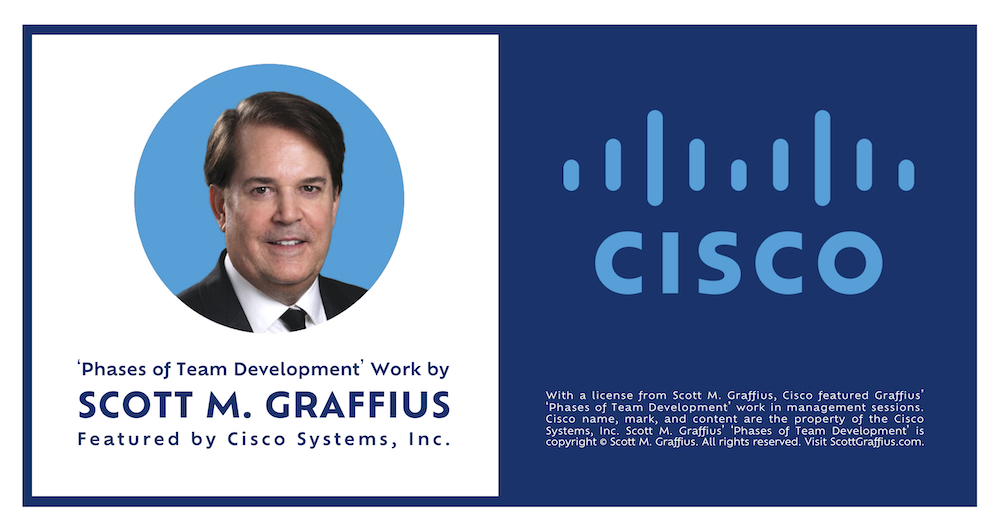










Sign up for Miro—it's free!
(Want more features? You can always upgrade to a paid plan.)




Permission Request Information
This work is copyright © Scott M. Graffius. All rights reserved.
To request permission to use Graffius' 'Phases of Team Development' visual shown at the top of this article, email Scott M. Graffius. If your request is approved, Graffius will give you an authorization/license and, if applicable, high-resolution files (JPG and PNG) of the visual. 

How to Cite This Article
Graffius, Scott M. (2025, January 7). Scott M. Graffius’ Phases of Team Development: 2025 Update. Available at: https://scottgraffius.com/blog/files/phases-of-team-development-update-for-2025.html. DOI: 10.13140/RG.2.2.33705.30564.

Digital Object Identifier (DOI)
DOI: 10.13140/RG.2.2.33705.30564

Short Link for Article
The short link for this article is https://bit.ly/teams-2025

Copyright
Copyright © Scott M. Graffius. All rights reserved.
Content on this site—including text, images, videos, and data—may not be used for training or input into any artificial intelligence, machine learning, or automatized learning systems, or published, broadcast, rewritten, or redistributed without the express written permission of Scott M. Graffius.
Scott M. Graffius' 'Phases of Team Development' was Spotlighted in Journal of Neurosurgery


Scott M. Graffius' Work on Team Tradecraft
Informed by the research of Bruce W. Tuckman and Mary Ann C. Jensen, over 100 subsequent studies, and Scott M. Graffius' first-hand professional experience with, and analysis of, team leadership and performance, Graffius created his ‘Phases of Team Development’ as a unique perspective and visual conveying the five phases of team development — Forming, Storming, Norming, Performing, and Adjourning — inclusive of a graph showing how performance varies by phase, as well as the characteristics and strategies for each phase.
Graffius' intellectual property (IP) is registered with the United States Copyright Office.
Graffius initially developed his ‘Phases of Team Development’ unique material in 2008, and he periodically refreshes it.
For reference, the visual for the current (2024) edition is below and the details are here.

Organizations around the world engage Graffius to deliver compelling talks and workshops. To date, he's presented sessions at 91 conferences and other events across 25 countries:
- Armenia,
- Australia,
- Brazil,
- Canada,
- Czech Republic,
- Finland,
- France,
- Germany,
- Greece,
- Hong Kong,
- Hungary,
- India, Ireland,
- Lithuania,
- Luxembourg,
- Nepal,
- Netherlands,
- New Zealand,
- Norway,
- Romania,
- Sweden,
- Switzerland,
- United Arab Emirates,
- United Kingdom,
- and the United States.

Graffius ‘Phases of Team Development’ IP is central and key to many of those sessions. His rate card and a listing of his engagements are at https://scottgraffius.com/resources/Exceptional-PPM-and-PMO-Solutions-Rate-Card-for-2024-2025-v24071607.pdf and https://scottgraffius.com/publicspeaker.html, respectively.
With an authorization/license from Graffius, his ‘Phases of Team Development’ intellectual property is featured and used by businesses, professional associations, government agencies, and universities around the globe. Examples include:
- Adobe,
- American Management Association,
- Amsterdam Public Health Research Institute,
- Bayer
- Boston University,
- Broadcom,
- Cisco,
- Deimos Aerospace,
- DevOps Institute,
- Erste Group Bank AG (Austria),
- FINAT,
- Ford Motor Company,
- FSU College of Medicine,
- Hasso Plattner Institute,
- IEEE,
- James Madison University,
- Johns Hopkins University,
- LeadingEng,
- London South Bank University,
- Manufacturers Alliance,
- Microsoft,
- New Zealand Government,
- Oracle,
- Royal Australasian College of Physicians,
- TBS Switzerland,
- Torrens University Australia,
- Tufts University,
- U.S. National Park Service,
- U.S. Tennis Association,
- UC San Diego,
- UK Sports Institute,
- University of Galway Ireland,
- Victorian Institute of Technology (Australia),
- Virginia Tech,
- Warsaw University,
- Western Sydney University,
- World Resources Institute,
- Yale University,
- ZHAW Zurich University of Applied Sciences,
- and many others.
The Journal of Neurosurgery (JNS) was added to this list! A JNS article — Muhlestein, W. E., Chang, K. W. C., Justice, D., Johnson, S., Brown, S., & Popadich, M. (2023). Developing interdisciplinary research teams in neurosurgery: key elements to success in brachial plexus and peripheral nerve surgery. Journal of Neurosurgery, 139 (6), 1552-1559. https://doi.org/10.3171/2023.4.JNS222254 — featured Graffius' 'Phases of Team Development' intellectual property on teamwork tradecraft.
The first page of the article is shown below.

Next, citation 40 (a reference to Graffius' work) annotation is shown below.

Team development material, based on Graffius' work, is shown below.

Lastly, citation 40 in the References section is shown below.

Read on to learn:
- About the Journal of Neurosurgery,
- About Scott M. Graffius,
- How to Cite This Article,
- and more.

About the Journal of Neurosurgery
The Journal of Neurosurgery (JNS) is a leading, peer-reviewed medical journal dedicated to advancing the field of neurosurgery. Published by the American Association of Neurological Surgeons (AANS), it serves as a premier platform for original research, clinical studies, and innovative techniques in the diagnosis and treatment of neurological conditions. With a history spanning over 75 years, JNS is widely recognized for its commitment to promoting scientific discovery and clinical excellence. Its global readership includes neurosurgeons, researchers, and healthcare professionals striving to improve patient outcomes.

About Scott M. Graffius

Scott M. Graffius is an agile project management expert practitioner, consultant, award-winning author, and international public speaker.
Graffius has generated more than USD $1.9 billion in business value for organizations served, including Fortune 500 companies. Businesses and industries range from technology (including R&D and AI) to entertainment, financial services, and healthcare, government, social media, and more.
Graffius leads the professional services firm Exceptional PPM and PMO Solutions, along with its subsidiary Exceptional Agility. These consultancies offer strategic and tactical advisory, training, embedded talent, and consulting services to public, private, and government sectors. They help organizations enhance their capabilities and results in agile, project management, program management, portfolio management, and PMO leadership, supporting innovation and driving competitive advantage. The consultancies confidently back services with a Delighted Client Guarantee™. Graffius is a former vice president of project management with a publicly traded provider of diverse consumer products and services over the Internet. Before that, he ran and supervised the delivery of projects and programs in public and private organizations with businesses ranging from e-commerce to advanced technology products and services, retail, manufacturing, entertainment, and more. He has experience with consumer, business, reseller, government, and international markets.
He is the author of two award-winning books.
- His first book, Agile Scrum: Your Quick Start Guide with Step-by-Step Instructions (ISBN-13: 9781533370242), received 17 awards.
- His second book is Agile Transformation: A Brief Story of How an Entertainment Company Developed New Capabilities and Unlocked Business Agility to Thrive in an Era of Rapid Change (ISBN-13: 9781072447962). BookAuthority named it one of the best Scrum books of all time.
Organizations around the world invite Graffius to speak on tech (including AI), agile, project management, program management, portfolio management, and PMO leadership. He has developed and delivered unique and compelling talks and workshops. To date, Graffius has delivered 91 sessions across 25 countries. Select examples of events include Agile Trends Gov, BSides (Newcastle Upon Tyne), Conf42 Quantum Computing, DevDays Europe, DevOps Institute, DevOpsDays (Geneva), Frug’Agile, IEEE, Microsoft, Scottish Summit, Scrum Alliance RSG (Nepal), Techstars, and W Love Games International Video Game Development Conference (Helsinki), and more. With an average rating of 4.81 (on a scale of 1-5), his sessions are highly valued.
Prominent businesses, professional associations, government agencies, and universities have featured Graffius and his work including content from his books, talks, workshops, and more. Select examples include:
- Adobe,
- American Management Association,
- Amsterdam Public Health Research Institute,
- Bayer,
- Boston University,
- Broadcom,
- Cisco,
- Constructor University Germany,
- Deimos Aerospace,
- DevOps Institute,
- EU's European Commission,
- Ford Motor Company,
- Hasso Plattner Institute Germany,
- IEEE,
- Johns Hopkins University,
- London South Bank University,
- Microsoft,
- National Academy of Sciences,
- New Zealand Government,
- Oracle,
- Pinterest Inc.,
- Project Management Institute,
- TBS Switzerland,
- Torrens University Australia,
- Tufts University,
- UC San Diego,
- UK Sports Institute,
- University of Galway Ireland,
- U.S. Department of Energy,
- U.S. National Park Service,
- U.S. Tennis Association,
- Virginia Tech,
- Warsaw University of Technology,
- Yale University,
- and many others.
Graffius has been actively involved with the Project Management Institute (PMI) in the development of professional standards. He was a member of the team which produced the Practice Standard for Work Breakdown Structures—Second Edition. Graffius was a contributor and reviewer of A Guide to the Project Management Body of Knowledge—Sixth Edition, The Standard for Program Management—Fourth Edition, and The Practice Standard for Project Estimating—Second Edition. He was also a subject matter expert reviewer of content for the PMI’s Congress. Beyond the PMI, Graffius also served as a member of the review team for two of the Scrum Alliance’s Global Scrum Gatherings.
Graffius has a bachelor’s degree in psychology with a focus in Human Factors. He holds eight professional certifications:
- Certified SAFe 6 Agilist (SA),
- Certified Scrum Professional - ScrumMaster (CSP-SM),
- Certified Scrum Professional - Product Owner (CSP-PO),
- Certified ScrumMaster (CSM),
- Certified Scrum Product Owner (CSPO),
- Project Management Professional (PMP),
- Lean Six Sigma Green Belt (LSSGB), and
- IT Service Management Foundation (ITIL).
He is an active member of the Scrum Alliance, the Project Management Institute (PMI), and the Institute of Electrical and Electronics Engineers (IEEE).
He divides his time between Los Angeles and Paris, France.









About Agile Scrum: Your Quick Start Guide with Step-by-Step Instructions

Shifting customer needs are common in today's marketplace. Businesses must be adaptive and responsive to change while delivering an exceptional customer experience to be competitive.
There are a variety of frameworks supporting the development of products and services, and most approaches fall into one of two broad categories: traditional or agile. Traditional practices such as waterfall engage sequential development, while agile involves iterative and incremental deliverables. Organizations are increasingly embracing agile to manage projects, and best meet their business needs of rapid response to change, fast delivery speed, and more.
With clear and easy to follow step-by-step instructions, Scott M. Graffius's award-winning Agile Scrum: Your Quick Start Guide with Step-by-Step Instructions helps the reader:
- Implement and use the most popular agile framework―Scrum;
- Deliver products in short cycles with rapid adaptation to change, fast time-to-market, and continuous improvement; and
- Support innovation and drive competitive advantage.
Hailed by Literary Titan as “the book highlights the versatility of Scrum beautifully.”
Winner of 17 first place awards.
Agile Scrum: Your Quick Start Guide with Step-by-Step Instructions is available in paperback and ebook/Kindle in the United States and around the world. Some links by country follow.
- 🇧🇷 Brazil
- 🇨🇦 Canada
- 🇨🇿 Czech Republic
- 🇩🇰 Denmark
- 🇫🇮 Finland
- 🇫🇷 France
- 🇩🇪 Germany
- 🇬🇷 Greece
- 🇭🇺 Hungary
- 🇮🇳 India
- 🇮🇪 Ireland
- 🇮🇱 Israel
- 🇮🇹 Italy
- 🇯🇵 Japan
- 🇱🇺 Luxembourg
- 🇲🇽 Mexico
- 🇳🇱 Netherlands
- 🇳🇿 New Zealand
- 🇳🇴 Norway
- 🇪🇸 Spain
- 🇸🇪 Sweden
- 🇨🇭 Switzerland
- 🇦🇪 UAE
- 🇬🇧 United Kingdom
- 🇺🇸 United States

About Agile Transformation: A Brief Story of How an Entertainment Company Developed New Capabilities and Unlocked Business Agility to Thrive in an Era of Rapid Change

Thriving in today's marketplace frequently depends on making a transformation to become more agile. Those successful in the transition enjoy faster delivery speed and ROI, higher satisfaction, continuous improvement, and additional benefits.
Based on actual events, Agile Transformation: A Brief Story of How an Entertainment Company Developed New Capabilities and Unlocked Business Agility to Thrive in an Era of Rapid Change provides a quick (60-90 minute) read about a successful agile transformation at a multinational entertainment and media company, told from the author's perspective as an agile coach.
The award-winning book by Scott M. Graffius is available in paperback and ebook/Kindle in the United States and around the world. Some links by country follow.
- 🇦🇺 Australia
- 🇦🇹 Austria
- 🇧🇷 Brazil
- 🇨🇦 Canada
- 🇨🇿 Czech Republic
- 🇩🇰 Denmark
- 🇫🇮 Finland
- 🇫🇷 France
- 🇩🇪 Germany
- 🇬🇷 Greece
- 🇮🇳 India
- 🇮🇪 Ireland
- 🇯🇵 Japan
- 🇱🇺 Luxembourg
- 🇲🇽 Mexico
- 🇳🇱 Netherlands
- 🇳🇿 New Zealand
- 🇪🇸 Spain
- 🇸🇪 Sweden
- 🇨🇭 Switzerland
- 🇦🇪 United Arab Emirates
- 🇬🇧 United Kingdom
- 🇺🇸 United States


How to Cite This Article
Graffius, Scott M. (2024, December 20). Scott M. Graffius' 'Phases of Team Development' was Spotlighted in Journal of Neurosurgery. Available at: https://scottgraffius.com/blog/files/jns-2024.html. DOI: 10.13140/RG.2.2.31746.59849.


Post-Publication Notes
If there are any supplements or updates to this article after the date of publication, they will appear here.


Content Acknowledgements
This article includes limited excerpts from the Journal of Neurosurgery, attributed to the Journal of Neurosurgery and used under fair use for news reporting and analysis.
Journal of Neurosurgery name, mark and content are the property of the American Association of Neurological Surgeons.
Graffius’ ‘Phases of Team Development’ is copyright © Scott M. Graffius. All rights reserved. Visit ScottGraffius.com to learn more.


Short Link for Article
The short link for this article is https://bit.ly/the-jns


Copyright
Copyright © Scott M. Graffius. All rights reserved.
Content on this site—including text, images, videos, and data—may not be used for training or input into any artificial intelligence, machine learning, or automatized learning systems, or published, broadcast, rewritten, or redistributed without the express written permission of Scott M. Graffius.

